Fujitsu Client Computing WL0007 LifeBook T Series Tablet PC w/WLAN WM3B2200BG User Manual Appendix O
Fujitsu Limited LifeBook T Series Tablet PC w/WLAN WM3B2200BG Appendix O
Contents
- 1. Host PC User Manual
- 2. WLAN User Manual
Host PC User Manual

FCC ID: EJE-WL0007 (IC: 337J-WL0007) Report No. M040223_Cert_Mace_Calexico2
EMC Technologies Pty Ltd – 57 Assembly Drive, Tullamarine VIC 3043 Australia
www.emctech.com.au
EMC Technologies Report Number: M040223_Cert_Mace_Calexico2
APPENDIX N1 – Host PC - User Manual
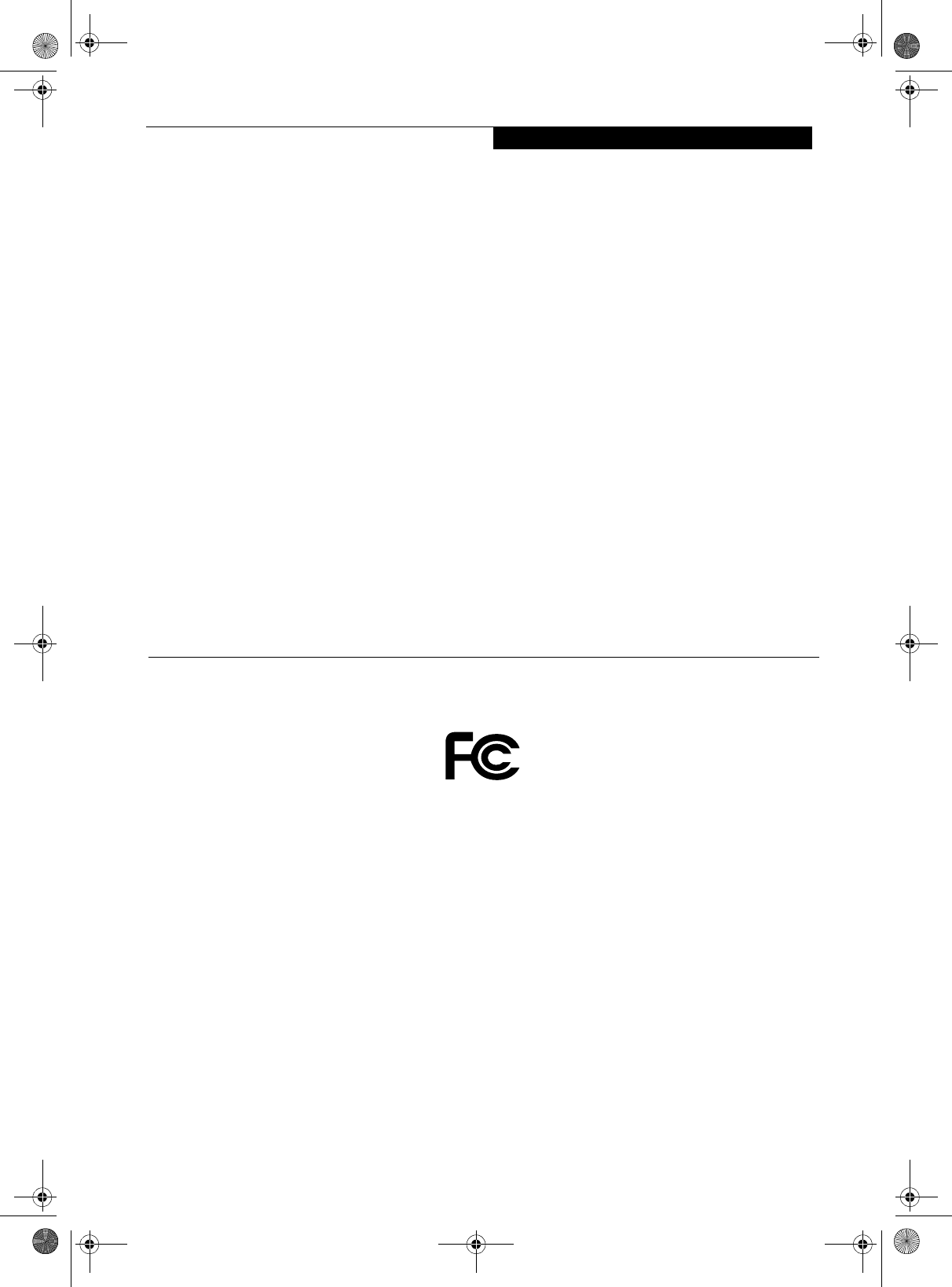
Copyright
Copyright
Fujitsu PC Corporation has made every effort to ensure
the accuracy and completeness of this document.
However, as ongoing development efforts are continually
improving the capabilities of our products, we cannot
guarantee the accuracy of the contents of this document.
We disclaim liability for errors, omissions, or future
changes.
Fujitsu, the Fujitsu logo, and LifeBook are registered
trademarks of Fujitsu Limited.
The following are registered trademarks of Microsoft
Corporation: MS, MS-DOS, Windows.
PCMCIA is a trademark of the Personal Computer
Memory Card International Association.
Intel and Pentium are registered trademarks of Intel
Corporation.
Adobe Acrobat Reader is a registered trademark of
Adobe System Inc.
PowerQuest and Drive Image are registered trademarks
of PowerQuest Corporation.
All other trademarks mentioned herein are the property
of their respective owners.
© Copyright 2003 Fujitsu PC Corporation. All rights
reserved. No part of this publication may be copied,
reproduced, or translated, without prior written consent
of Fujitsu PC Corporation. No part of this publication
may be stored or transmitted in any electronic form
without the written consent of Fujitsu PC Corporation.
B5FH-9011-01EN-00
DECLARATION OF CONFORMITY
according to FCC Part 15
Responsible Party Name: Fujitsu PC Corporation
Address: 5200 Patrick Henry Drive
Santa Clara, CA 95054
Telephone: (408) 982-9500
Declares that product: Model Configuration:
LifeBook T3010 Tablet PC
LifeBook T3010D Tablet PC
Complies with Part 15 of the FCC Rules.
This device complies with Part 15 of the FCC rules. Operations are subject to the following two conditions:
(1) This device must not be allowed to cause harmful interference, (2) This device must accept any interference
received, including interference that may cause undesired operation.
T Series.book Page 1 Thursday, July 31, 2003 10:49 AM
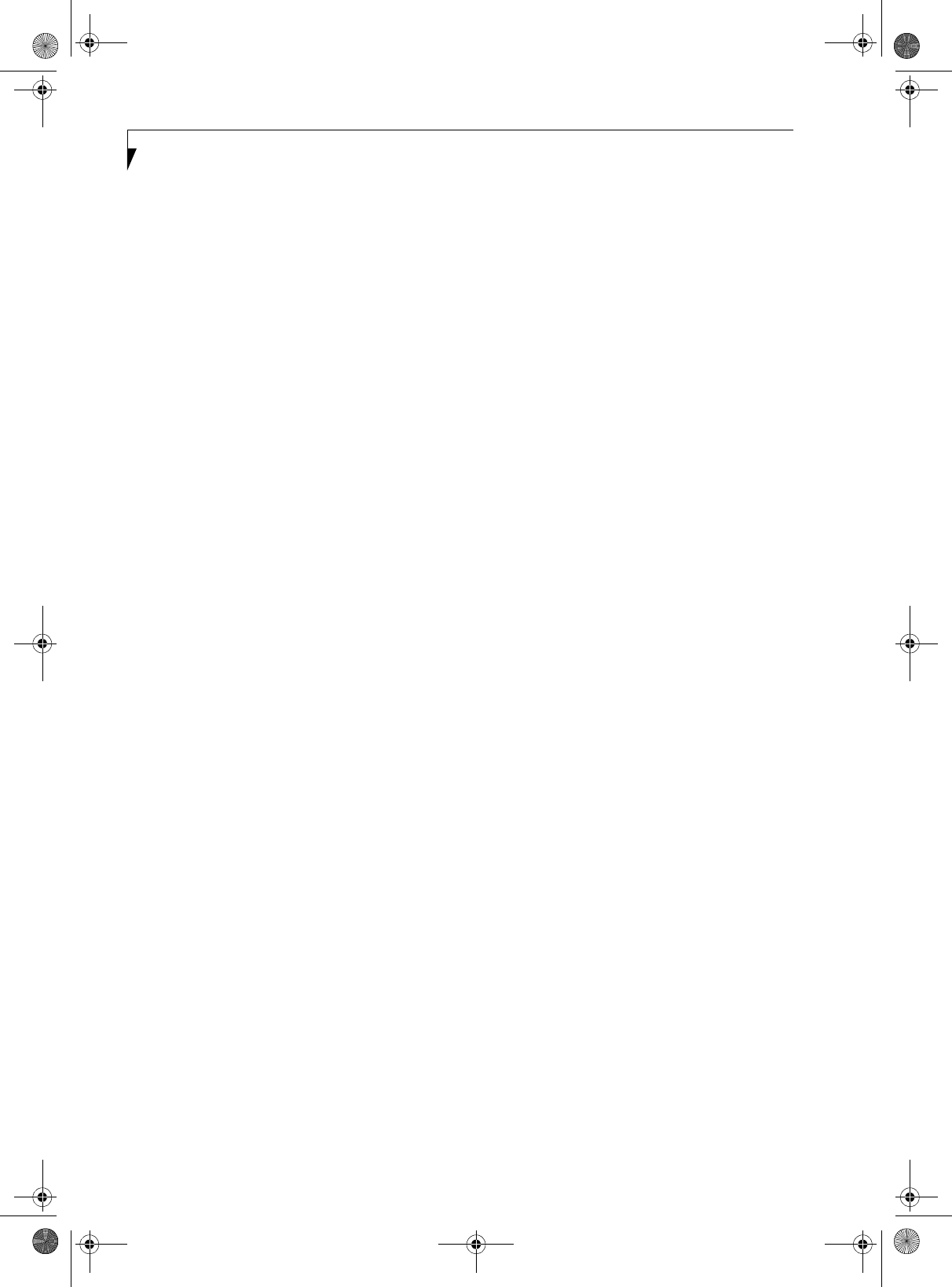
LifeBook T Series Tablet PC
T Series.book Page 2 Thursday, July 31, 2003 10:49 AM
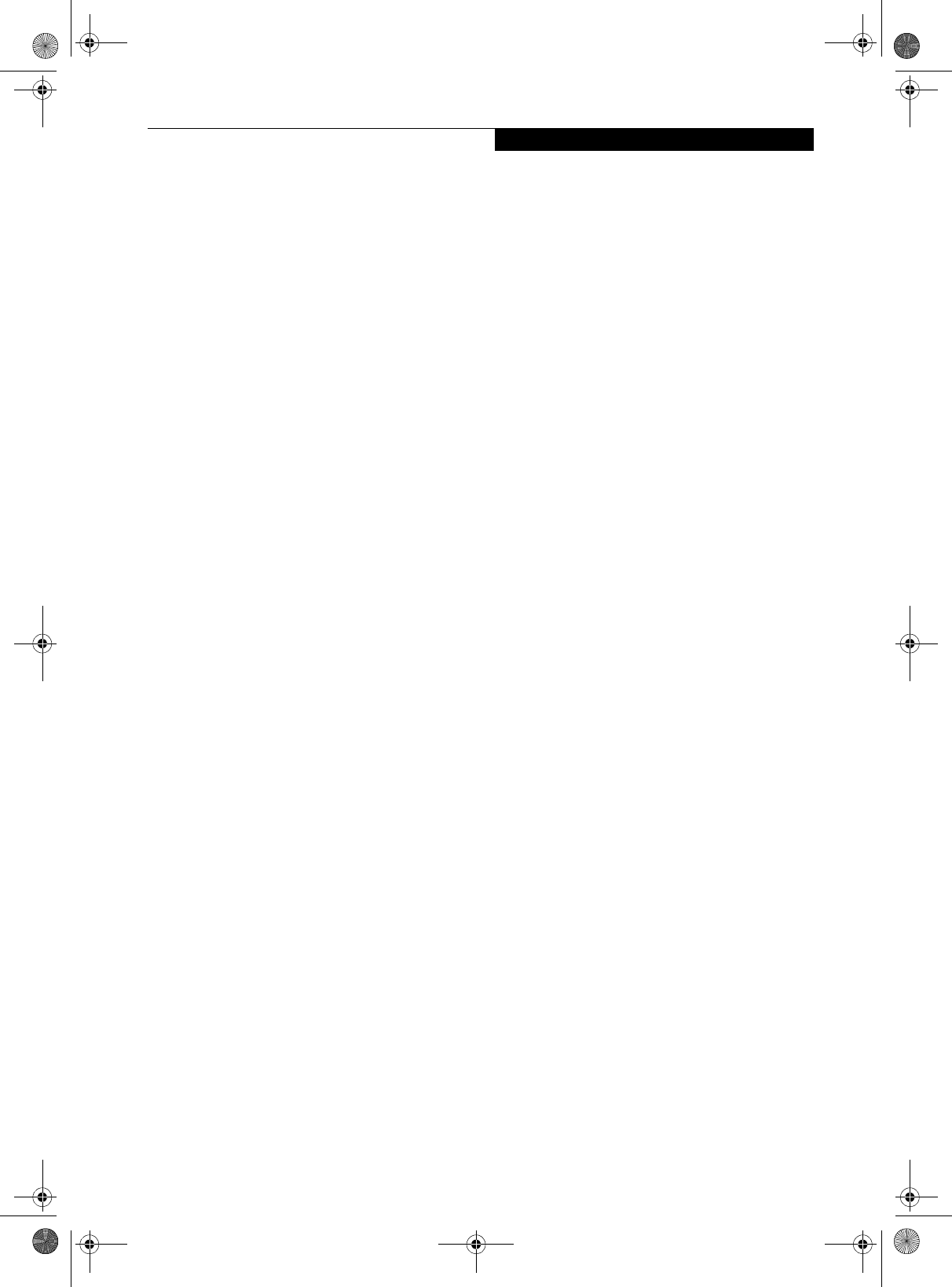
Table of Contents
Fujitsu LifeBook® T Series Tablet PC
Table of Contents
1
PREFACE
Preface
About This Guide . . . . . . . . . . . . . . . . . . . . . . . . .3
FPC Contact Information . . . . . . . . . . . . . . . . . . .3
Warranty . . . . . . . . . . . . . . . . . . . . . . . . . . . . . . .3
2
GETTING TO KNOW
YOUR TABLET PC
Overview
Unpacking . . . . . . . . . . . . . . . . . . . . . . . . . . . . . .7
Optional Accessories . . . . . . . . . . . . . . . . . . . . . .8
Locating the Controls and Connectors
Top and Front Components . . . . . . . . . . . . . . . .10
Left-Side Panel Components . . . . . . . . . . . . . . .11
Right-Side Panel Components . . . . . . . . . . . . . .12
Rear Panel Components . . . . . . . . . . . . . . . . . . .13
Bottom Components . . . . . . . . . . . . . . . . . . . . .14
Status Indicator Panel
Power Indicator . . . . . . . . . . . . . . . . . . . . . . . . .15
AC Adapter Indicator . . . . . . . . . . . . . . . . . . . . .15
Battery Level Indicators . . . . . . . . . . . . . . . . . . .15
Battery Charging Indicator . . . . . . . . . . . . . . . . .16
Hard Drive Access Indicator . . . . . . . . . . . . . . . .16
NumLk Indicator. . . . . . . . . . . . . . . . . . . . . . . . .16
CapsLock Indicator. . . . . . . . . . . . . . . . . . . . . . .16
ScrLk Indicator . . . . . . . . . . . . . . . . . . . . . . . . . .16
Security Indicator . . . . . . . . . . . . . . . . . . . . . . . .16
Display Panel
Opening the Display Panel . . . . . . . . . . . . . . . . .17
Using the System as a Tablet . . . . . . . . . . . . . . .17
Adjusting Display Panel Brightness . . . . . . . . . . .18
Keyboard
Using the Keyboard . . . . . . . . . . . . . . . . . . . . . .19
Numeric Keypad. . . . . . . . . . . . . . . . . . . . . . . . .19
Windows Keys . . . . . . . . . . . . . . . . . . . . . . . . . .19
Cursor Keys . . . . . . . . . . . . . . . . . . . . . . . . . . . .20
Function Keys. . . . . . . . . . . . . . . . . . . . . . . . . . .20
LifeBook Security/Tablet PC Buttons
Changing Tablet PC Button Functions . . . . . . . .22
Setting up LifeBook Security Panel . . . . . . . . . . .22
Passwords . . . . . . . . . . . . . . . . . . . . . . . . . . . . .22
Using Your LifeBook Security Panel . . . . . . . . . .23
Uninstalling the Security Panel Application . . . . . 24
Touchpad Pointing Device
Clicking . . . . . . . . . . . . . . . . . . . . . . . . . . . . . . .25
Double-Clicking . . . . . . . . . . . . . . . . . . . . . . . . .25
Dragging . . . . . . . . . . . . . . . . . . . . . . . . . . . . . .26
Scrolling . . . . . . . . . . . . . . . . . . . . . . . . . . . . . . .26
Touchpad Control Adjustment . . . . . . . . . . . . . .26
Pen and Active Digitizer
Using the Pen. . . . . . . . . . . . . . . . . . . . . . . . . . .27
Calibrating the Pen. . . . . . . . . . . . . . . . . . . . . . .27
Replacing the Pen Tip. . . . . . . . . . . . . . . . . . . . .28
Using the Active Digitizer . . . . . . . . . . . . . . . . . .28
Volume Control
Controlling the Volume . . . . . . . . . . . . . . . . . . .29
3
USING YOUR TABLET PC
Power Sources
Connecting the Power Adapters . . . . . . . . . . . . .33
Starting Your Tablet PC
Power On. . . . . . . . . . . . . . . . . . . . . . . . . . . . . .34
Boot Sequence . . . . . . . . . . . . . . . . . . . . . . . . . .34
BIOS Setup Utility. . . . . . . . . . . . . . . . . . . . . . . .34
Booting the System . . . . . . . . . . . . . . . . . . . . . .34
T Series.book Page 3 Thursday, July 31, 2003 10:49 AM
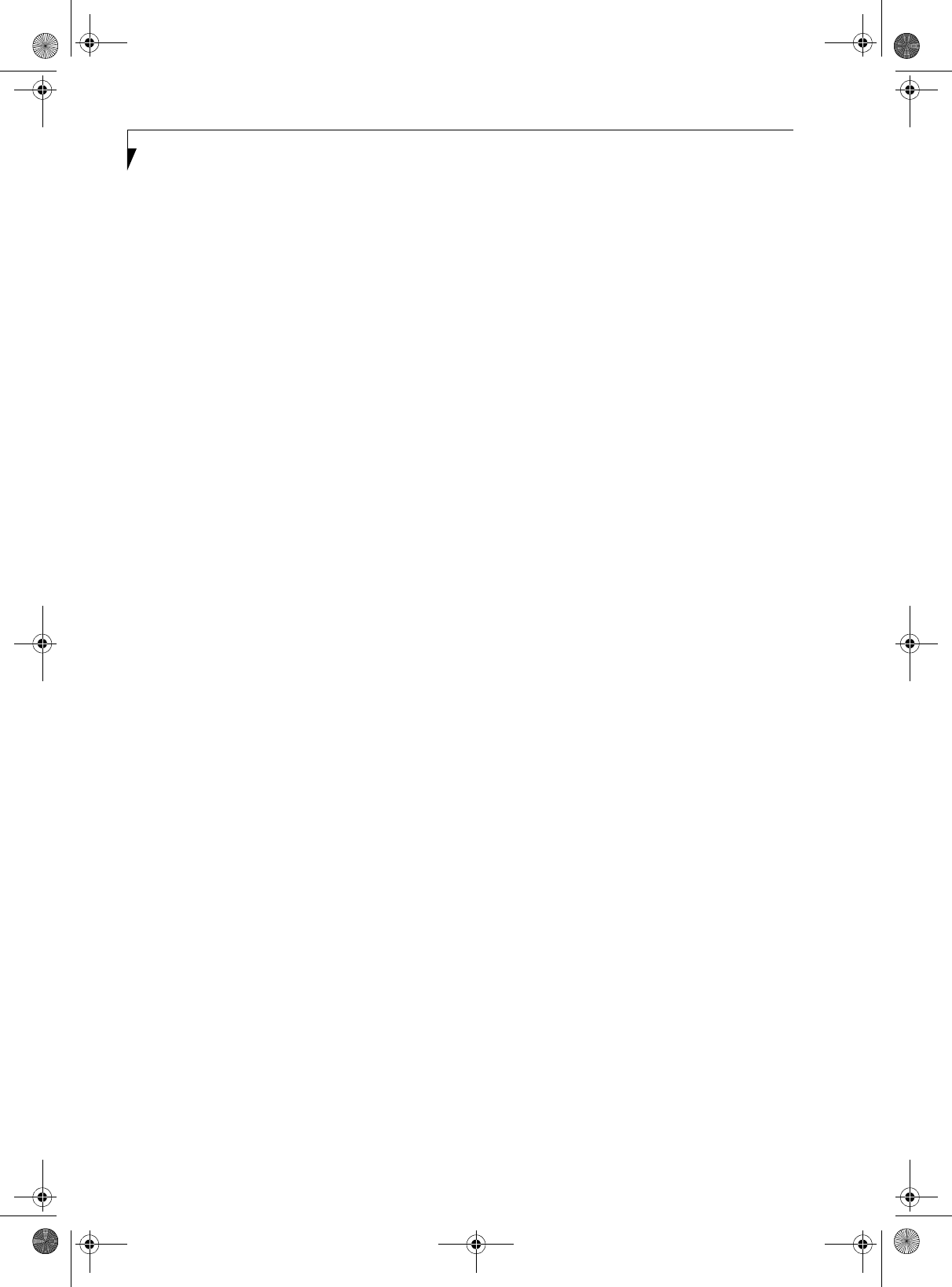
LifeBook T Series Tablet PC
Activating Additional Utilities . . . . . . . . . . . . . . . 35
Registering Your LifeBook T Series Tablet PC . . . 35
Power Management
Suspend/Resume Button . . . . . . . . . . . . . . . . . . 36
Standby Mode . . . . . . . . . . . . . . . . . . . . . . . . . . 36
Hibernate Mode. . . . . . . . . . . . . . . . . . . . . . . . . 37
Display Timeout . . . . . . . . . . . . . . . . . . . . . . . . . 37
Hard Disk Timeout . . . . . . . . . . . . . . . . . . . . . . . 37
Windows Power Management. . . . . . . . . . . . . . 37
Restarting the System. . . . . . . . . . . . . . . . . . . . . 37
Power Off . . . . . . . . . . . . . . . . . . . . . . . . . . . . . 38
4
USER-INSTALLABLE FEATURES
Lithium ion Battery
Recharging the Battery. . . . . . . . . . . . . . . . . . . . 41
Replacing the Battery . . . . . . . . . . . . . . . . . . . . . 42
Memory Upgrade Module
Installing Memory Upgrade Modules . . . . . . . . . 43
To Remove a Memory Upgrade Module . . . . . . 43
Checking the Memory Capacity . . . . . . . . . . . . . 44
PC Cards
Installing PC Cards . . . . . . . . . . . . . . . . . . . . . . . 45
Removing PC Cards . . . . . . . . . . . . . . . . . . . . . . 45
Smart Card Reader. . . . . . . . . . . . . . . . . . . . . . . 45
Port Replicator
Rear Panel Components. . . . . . . . . . . . . . . . . . . 46
Front Panel Components . . . . . . . . . . . . . . . . . . 47
Attaching the Port Replicator . . . . . . . . . . . . . . . 47
Detaching the Port Replicator. . . . . . . . . . . . . . . 47
Device Ports
Modem (RJ-11) Jack . . . . . . . . . . . . . . . . . . . . . 48
Internal LAN (RJ-45) jack . . . . . . . . . . . . . . . . . . 48
Docking Port . . . . . . . . . . . . . . . . . . . . . . . . . . . 48
Universal Serial Bus Ports . . . . . . . . . . . . . . . . . . 48
Infrared Port. . . . . . . . . . . . . . . . . . . . . . . . . . . . 48
Microphone Jack . . . . . . . . . . . . . . . . . . . . . . . . 49
Headphone Jack. . . . . . . . . . . . . . . . . . . . . . . . . 49
External Monitor Port. . . . . . . . . . . . . . . . . . . . . 49
5
TROUBLESHOOTING
Troubleshooting
Identifying the Problem . . . . . . . . . . . . . . . . . . . 53
Specific Problems . . . . . . . . . . . . . . . . . . . . . . . . 53
Troubleshooting Table . . . . . . . . . . . . . . . . . . . . 54
Power On Self Test Messages . . . . . . . . . . . . . . 61
Modem Result Codes. . . . . . . . . . . . . . . . . . . . . 62
Restoring Your Pre-installed Software
Drive Image Special Edition (DISE) . . . . . . . . . . . 63
6
CARE AND MAINTENANCE
Care and Maintenance
LifeBook T Series Tablet PC . . . . . . . . . . . . . . . . 67
Keyboard . . . . . . . . . . . . . . . . . . . . . . . . . . . . . . 68
Batteries. . . . . . . . . . . . . . . . . . . . . . . . . . . . . . . 68
Optional Floppy Disk Drive and Floppy Disks. . . 68
Optional CD Drive and CDs. . . . . . . . . . . . . . . . 68
PC Cards . . . . . . . . . . . . . . . . . . . . . . . . . . . . . . 69
7
SPECIFICATIONS
Specifications
Configuration Label . . . . . . . . . . . . . . . . . . . . . . 73
Physical Specifications . . . . . . . . . . . . . . . . . . . . 73
Processing Specifications . . . . . . . . . . . . . . . . . . 73
Memory/Storage Specifications . . . . . . . . . . . . . 73
Display Specifications. . . . . . . . . . . . . . . . . . . . . 73
Interface Specifications . . . . . . . . . . . . . . . . . . . 73
Power Specifications . . . . . . . . . . . . . . . . . . . . . 74
Environmental Specifications . . . . . . . . . . . . . . . 74
Agency Approval Specifications . . . . . . . . . . . . . 74
Additional Specifications . . . . . . . . . . . . . . . . . . 74
Regulatory Information . . . . . . . . . . . . . . . . . . . 75
T Series.book Page 4 Thursday, July 31, 2003 10:49 AM
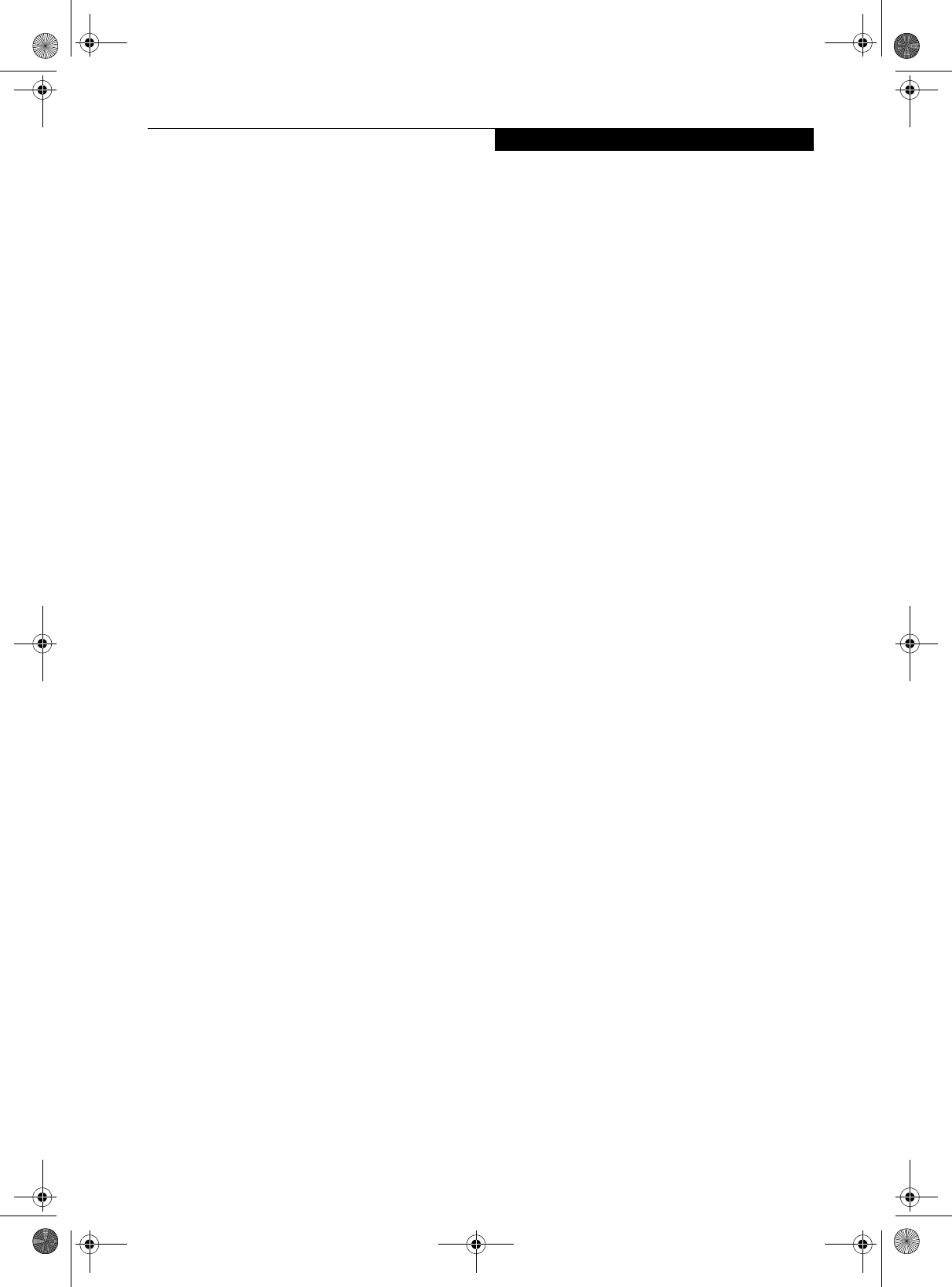
Table of Contents
8
GLOSSARY
Glossary . . . . . . . . . . . . . . . . . . . . . . . . . . . . . . .81
APPENDIX:
INTEGRATED WIRELESS
LAN USER’S GUIDE
FCC Regulatory Information. . . . . . . . . . . . . . . .89
Before Using the Wireless LAN
For Better Communications . . . . . . . . . . . . . . . .91
Stopping Transmission . . . . . . . . . . . . . . . . . . . .92
Starting Transmission . . . . . . . . . . . . . . . . . . . . .92
Connection Using Windows XP
Flow of Operations. . . . . . . . . . . . . . . . . . . . . . .93
Preparation for Wireless LAN Connection. . . . . .93
Connection to the Network . . . . . . . . . . . . . . . .95
Other settings
Setting of Power-saving Function. . . . . . . . . . . .99
Troubleshooting
Troubleshooting the Wireless LAN . . . . . . . . . .100
IP address information
About IP Addresses . . . . . . . . . . . . . . . . . . . . .102
Specifications
Wireless LAN Specifications . . . . . . . . . . . . . . .103
T Series.book Page 5 Thursday, July 31, 2003 10:49 AM
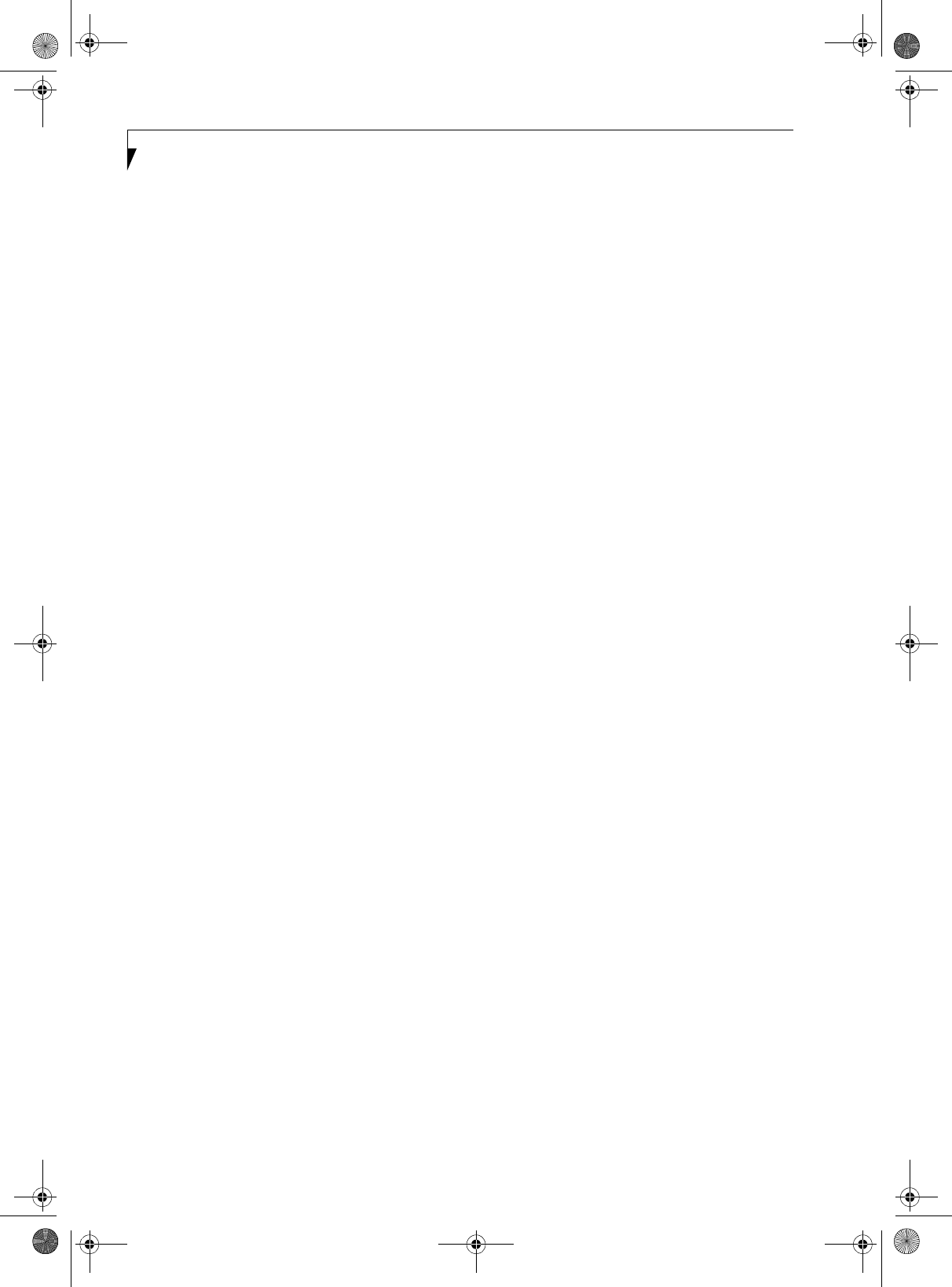
LifeBook T Series Tablet PC
T Series.book Page 6 Thursday, July 31, 2003 10:49 AM

1
1
Preface
T Series.book Page 1 Thursday, July 31, 2003 10:49 AM
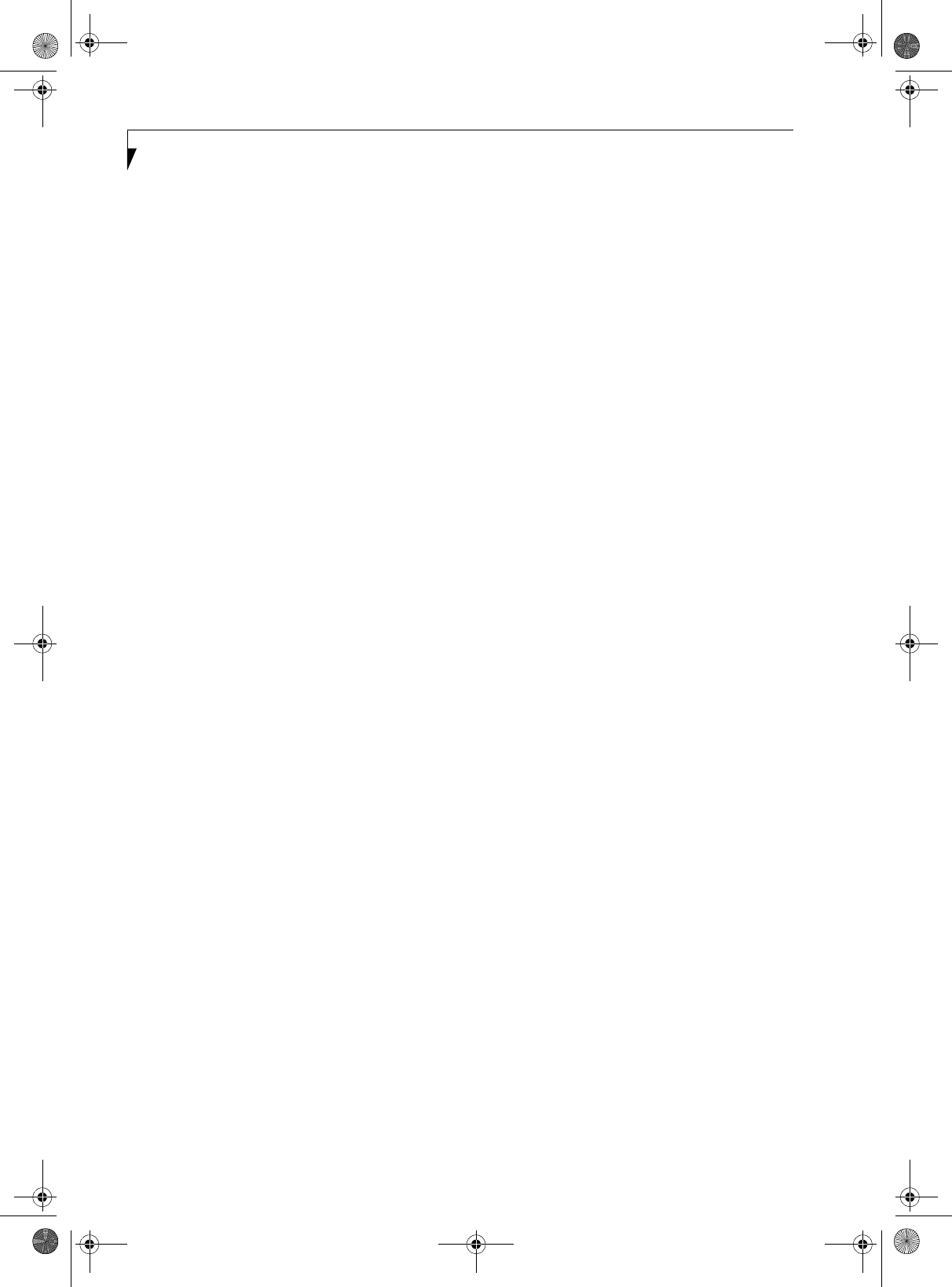
2
LifeBook T Series Tablet PC
T Series.book Page 2 Thursday, July 31, 2003 10:49 AM
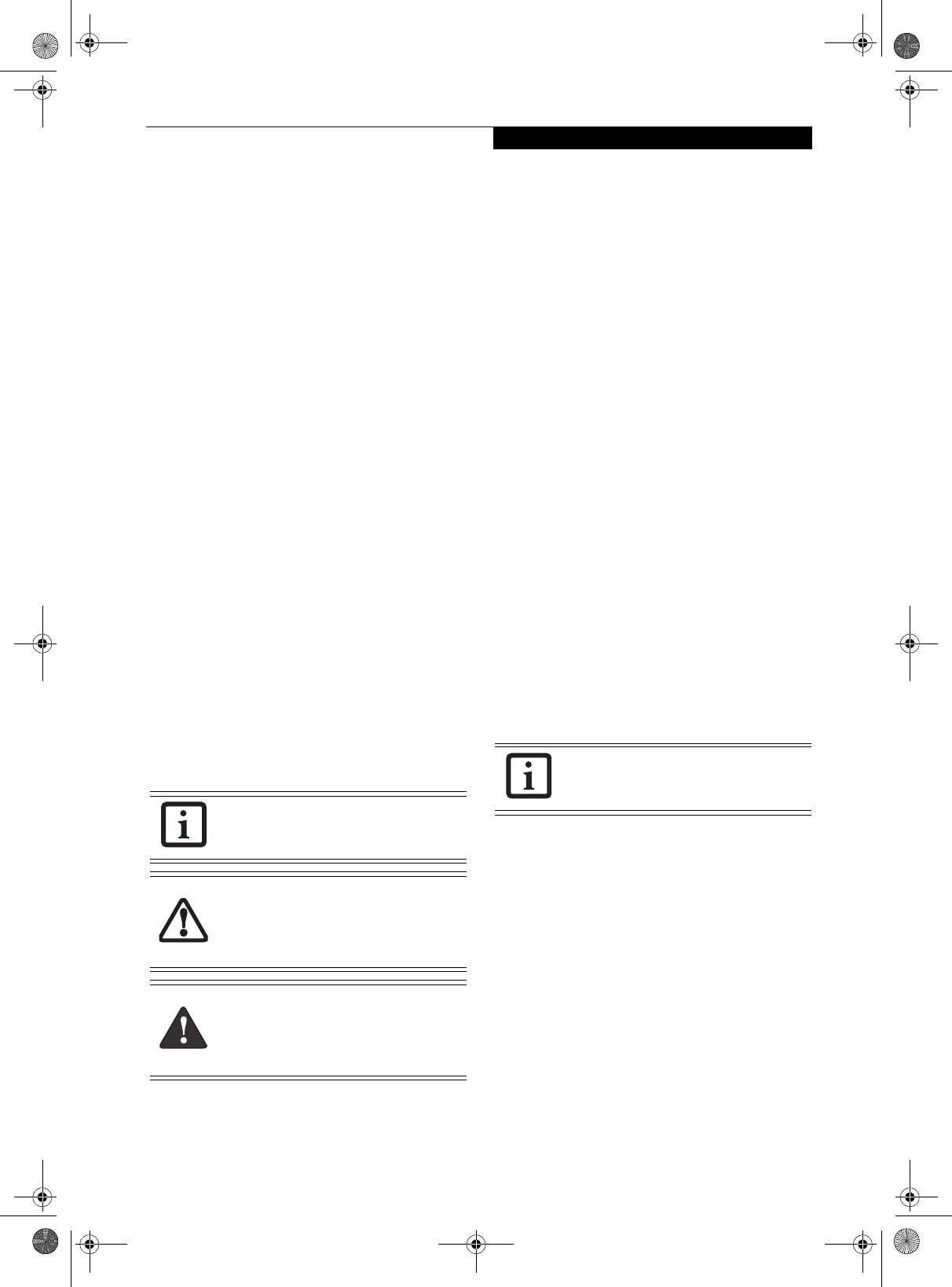
3
Preface
Preface
ABOUT THIS GUIDE
The LifeBook® T Series Tablet PC from Fujitsu PC
Corporation is a powerful convertible computer. It can
be used either as a standard notebook using keyboard
input, or in tablet configuration using pen input. It is
powered by an Intel® microprocessor, has a built-in
color display with an active digitizer, and brings the
computing power of desktop personal computers (PCs)
to a portable and versatile environment.
This manual explains how to operate your LifeBook T
Series Tablet PC’s hardware and built-in system soft-
ware. Your LifeBook T Series Tablet PC is compatible
with the IBM® PC AT, and it comes with Windows® XP
Tablet Edition pre-installed.
Your LifeBook T Series Tablet PC is a completely self-
contained unit with an active-matrix (TFT) color LCD
display. It has a powerful interface that enables it to
support a variety of optional features.
Conventions Used in the Guide
Keyboard keys appear in brackets.
Example: [Fn], [F1], [Esc], [Enter] and [Ctrl].
Pages with additional information about a specific topic
are cross-referenced within the text.
Example: (See page xx.)
On screen buttons or menu items appear in bold.
Example: Click OK to restart your Tablet PC.
DOS commands you enter appear in Courier type.
Example: Shutdown the computer?
FPC CONTACT INFORMATION
Service and Support
You can contact FPC Service and Support the following
ways:
■Toll free: 1-800-8Fujitsu (1-800-838-5487)
■Fax: 1-408-764-2724
■E-mail: 8fujitsu@fujitsupc.com
■Web site: http://www.fujitsupc.com
Before you place the call, you should have the
following information ready so that the customer
support representative can provide you with the
fastest possible solution:
■Product name
■Product configuration number
■Product serial number
■Purchase date
■Conditions under which the problem occurred
■Any error messages that have occurred
■Hardware configuration
■Type of device connected, if any
Fujitsu Online
You can go directly to the online Fujitsu Product catalog
for your Tablet PC. Go to Start -> All Programs ->
Service & Support Software, and click on Pen Accesso-
ries Web site.
You can also reach Fujitsu Service and Support online by
going to Start -> All Programs -> Service & Support
Software, and clicking on Fujitsu Service & Support Web
site.
WARRANTY
Your LifeBook T Series Tablet PC is backed by an Inter-
national Limited Warranty and includes toll-free tech-
nical support. Check the service kit that came with your
Tablet PC for warranty terms and conditions.
The information icon highlights
information that will enhance your
understanding of the subject material.
The caution icon highlights information
that is important to the safe operation of
your computer, or to the integrity of your
files. Please read all caution information
carefully.
The warning icon highlights information
that can be hazardous to either you, your
LifeBook T Series Tablet PC, or your files.
Please read all warning information
carefully.
You must have an active internet
connection to use the online URL links.
T Series.book Page 3 Thursday, July 31, 2003 10:49 AM
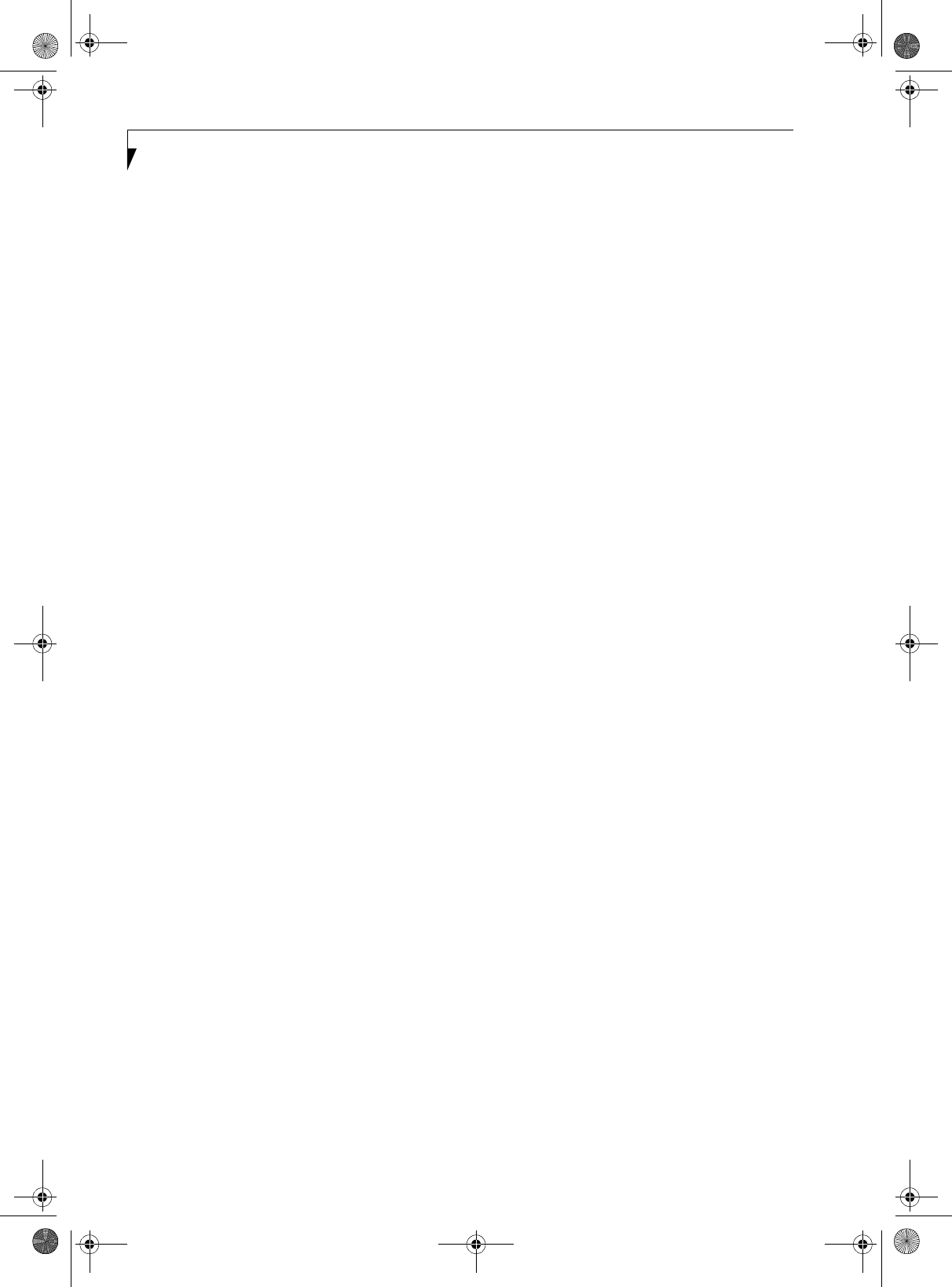
4
LifeBook T Series Tablet PC - Preface
T Series.book Page 4 Thursday, July 31, 2003 10:49 AM

5
2
Getting to Know
Your Tablet PC
T Series.book Page 5 Thursday, July 31, 2003 10:49 AM
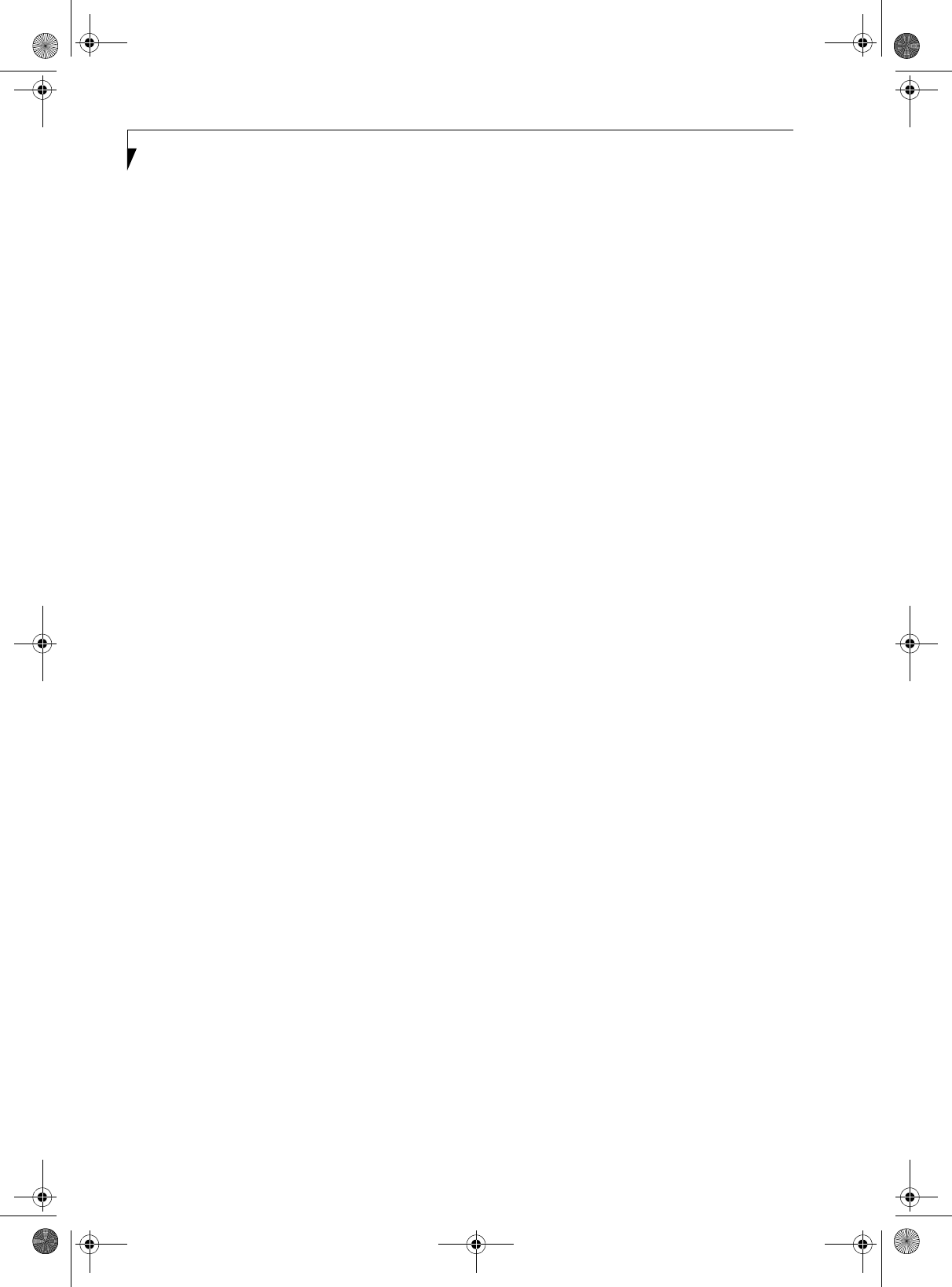
6
LifeBook T Series Tablet PC
T Series.book Page 6 Thursday, July 31, 2003 10:49 AM
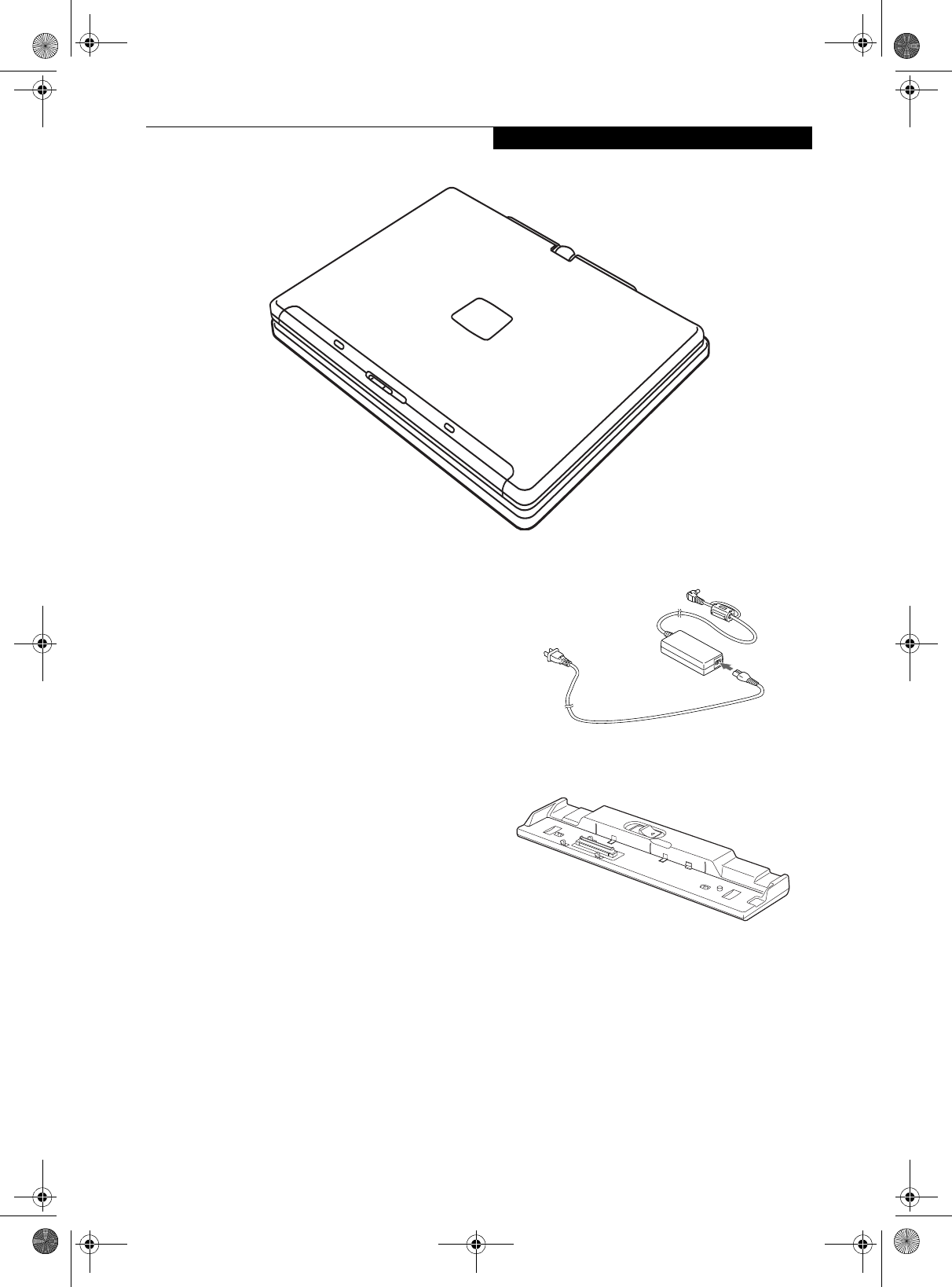
7
Getting to Know Your Tablet PC
Figure 2-1. Fujitsu LifeBook T Series Tablet PC
Overview
This section describes the components of your Fujitsu
LifeBook T Series Tablet PC. We strongly recommend
that you read it before using your Tablet PC, even if you
are already familiar with mobile computers.
UNPACKING
When you receive your LifeBook T Series Tablet PC,
unpack it carefully, and compare the parts you have
received with the items listed below.
For a pre-configured model you should have:
■LifeBook T Series Tablet PC (Figure 2-1)
■AC adapter with AC power cord (Figure 2-2)
■Phone/Modem (RJ-11) telephone cable
■Pen (located in pen holder)
■Driver and Application Restore (DAR) CD
■Getting Started Guide
■User’s Guide (this document)
■International Limited Warranty Booklet
■Microsoft Windows Manual and Certificate of
Authenticity
■Lithium ion battery (pre-installed)
You may also have one or more of the following optional
devices in the box:
■Port Replicator (Figure 2-3)
■External USB Floppy Disk Drive
■External DVD/CD-ROM Combo Drive
■External USB CD-ROM Drive
Figure 2-2. AC Adapter
Figure 2-3. Optional Port Replicator
T Series.book Page 7 Thursday, July 31, 2003 10:49 AM
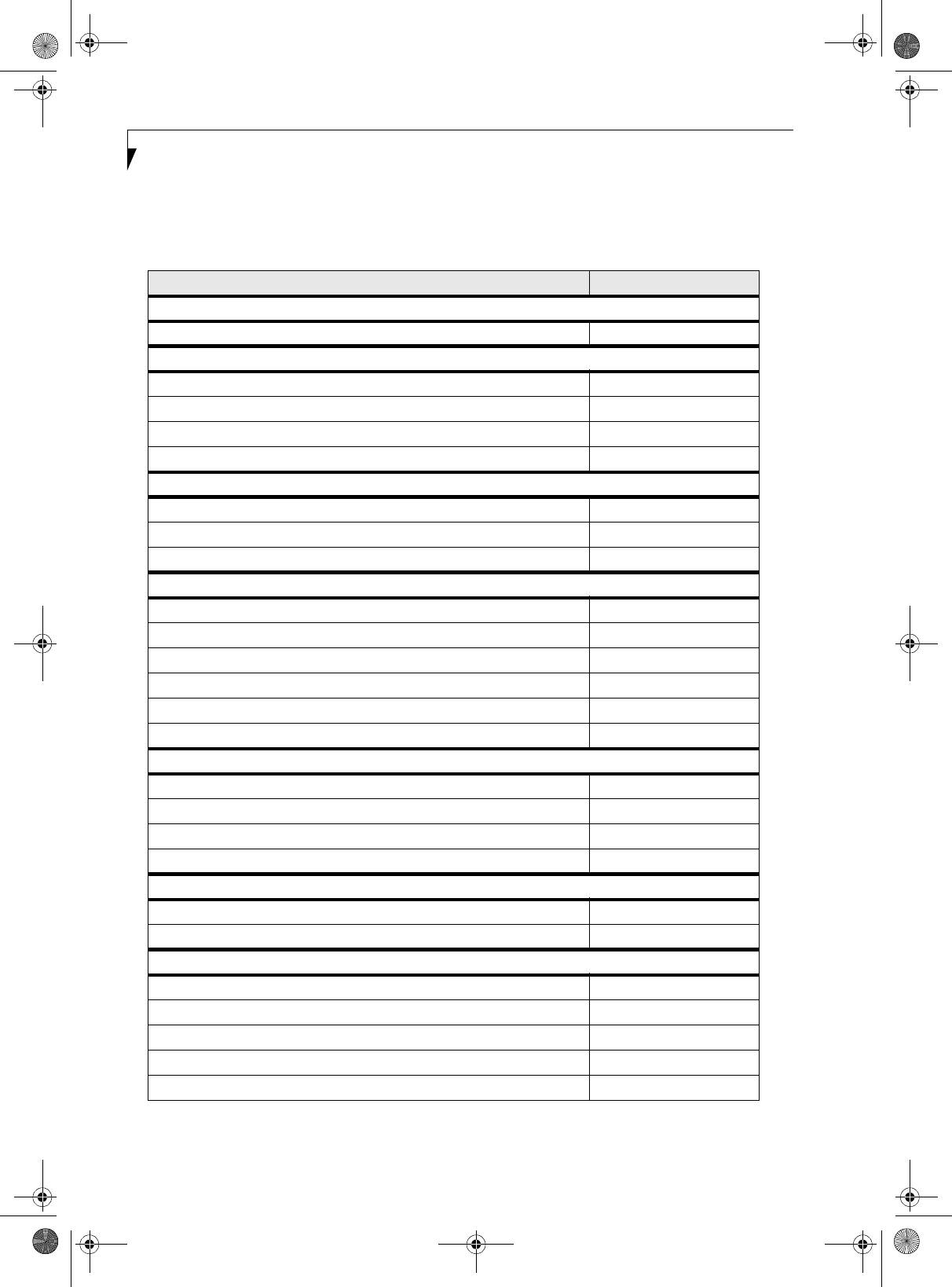
8
LifeBook T Series Tablet PC - Section 2
OPTIONAL ACCESSORIES
The following optional accessories can be used with the LifeBook T Series Tablet PC. Refer to the instructions provided
with these accessories for details on their use. For the latest list of accessories available for your LifeBook T Series Tablet
PC, be sure to frequently check the Fujitsu Web site at: www.fujitsupc.com
Table 2-1. Optional Accessories for LifeBook T Series Tablet PC
Peripheral/Accessory Fujitsu Part Number
Docking Options
LifeBook T Series Tablet PC port replicator FPCPR39AP
Carrying Cases
Duo Travel Bag FPCCC16
Director leather carrying case FPCCC22
Diplomat carrying case FPCCC02
Propak backpack FPCCC07
Storage Options
External USB floppy disk drive FPCFDD12
External DVD/CD-RW combo drive FPCDVR26
External CD-ROM drive FPCCD33AP
Memory
256 MB SDRAM, DDR266 FPCEM51AP
512 MB SDRAM, DDR 266 FPCEM55AP
1.0 GB SDRAM, DDR 266 FPCEM87AP
128 MB Compact Flash card FPCEMC02
256 MB Compact Flash card FPCEMC03
128 MB Secure Digital memory card FPCEMC01
Power Options
AC Adapter with US cord FPCAC23
Main battery FPCBP73AP
Auto/airline adapter FPCAA02
Battery charger FPCBC06
Input Accessories
Replacement pen set (2-pack) FPCPN11AP
USB optical mouse FPCMO08AP
Additional Accessories
Smart Card holder FPCSCH01
Wireless LAN card, 802.11b FPCWL08
Compact Flash card adapter FPCCFA01
Notebook Guardian Lock FPCLCK02
Logitech wireless keyboard and mouse FPCKB04
T Series.book Page 8 Thursday, July 31, 2003 10:49 AM
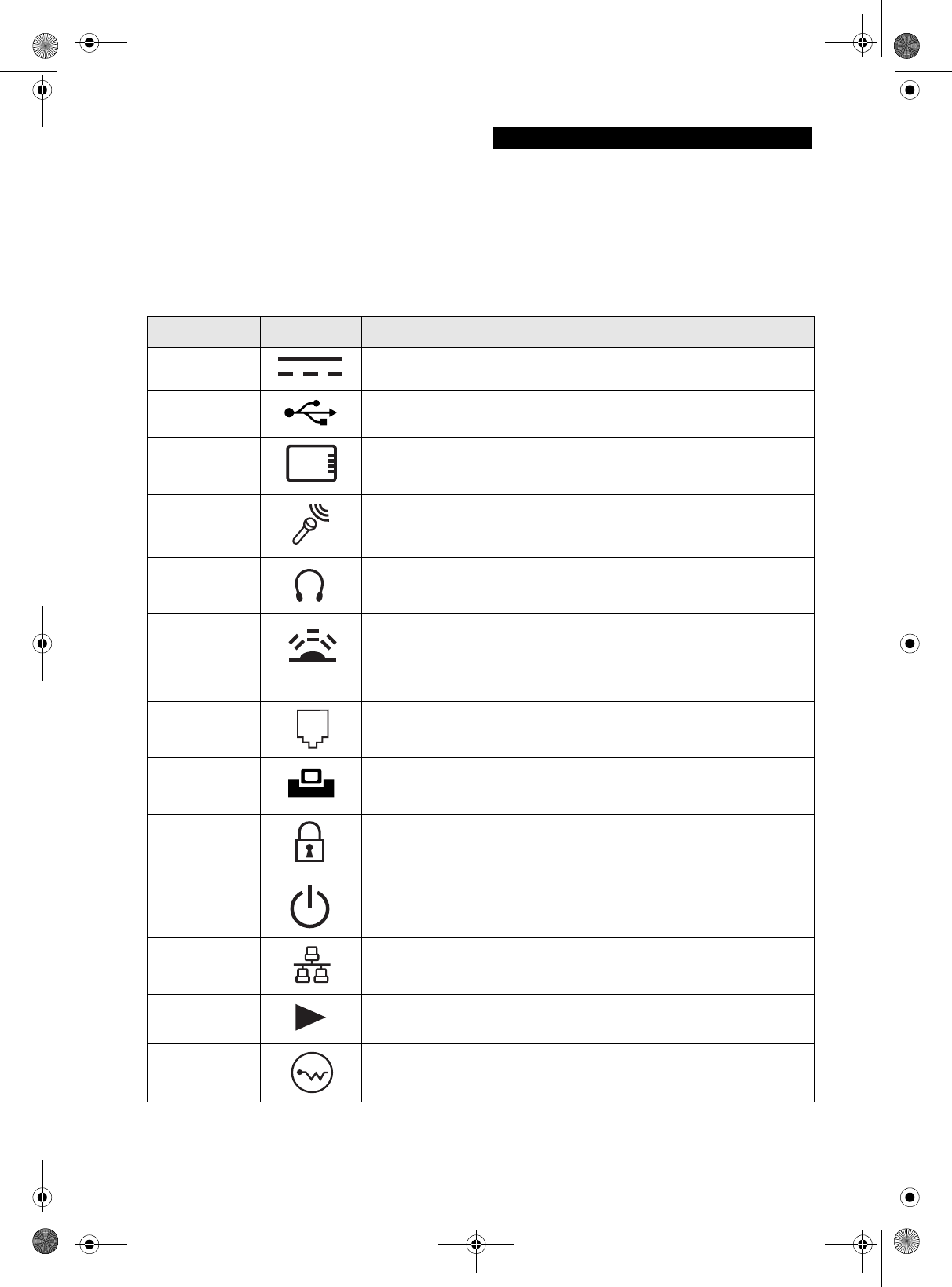
9
Getting to Know Your Tablet PC
Locating the Controls and Connectors
Connectors and peripheral interfaces on the LifeBook T
Series Tablet PC and the optional port replicator allow
you to connect a variety of devices. Specific locations are
illustrated in Figures 2-4 through 2-8. The table below
provides a short description of each icon on the Life-
Book T Series Tablet PC. Each of the icons is either
molded into or printed on the Tablet PC chassis.
Table 2-2. System icons
Connection Tablet PC Icon Purpose
DC in connector Connect an external power source such as the AC adapter or auto/airline adapter.
USB Port Connect Universal Serial Bus 2.0 or 1.1 compliant devices to the Tablet PC.
PCMCIA
Card slot
Install Type I, Type II, or Type III PC Cards.
Microphone jack Connect an external microphone. The internal microphone is disabled when you
plug in an external microphone.
Headphone jack Connect stereo headphones or powered external speakers. The internal speaker is
disabled when you plug in external headphones or powered speakers.
IrDA/FIR port An infrared transceiver built into the Tablet PC allows you to communicate with
other devices that are compliant with IrDA Standard Rev. 1.1. Effective range for
infrared communication is about 3 feet, and within 15 degrees off center. A clear
line-of-sight path must exist between the IrDA port on the computer and the
IrDA transceiver on the other device.
Modem Connect a telephone line to the internal modem using a standard RJ-11
telephone plug.
Tablet Dock port Connect the LifeBook T Series Tablet PC port replicator or other approved
docking device. Refer to documentation accompanying the docking device for
more information.
Security lock slot The security slot allows you to secure the Tablet PC using Kensington-compatible
locking devices.
Suspend/Resume
button
The Suspend/Resume button allows you to suspend Tablet PC activity without
powering off, resume your Tablet PC from suspend mode, and power on the
system when it has been shut down from Windows.
Local Area
Network (LAN)
The LAN (RJ-45) jack is used to connect the internal Fast Ethernet (10/100 Base-T/
TX) to a Local Area Network (LAN) in your office or home, or broadband devices
such as a cable modem, DSL, or satellite Internet.
Battery Release
Latch
The battery release latch allows you to remove the battery from your system for
storage or replacement.
Wireless LAN
On-Off Switch
The wireless LAN switch allows you to turn power to the optional wireless LAN
device on and off.
T Series.book Page 9 Thursday, July 31, 2003 10:49 AM
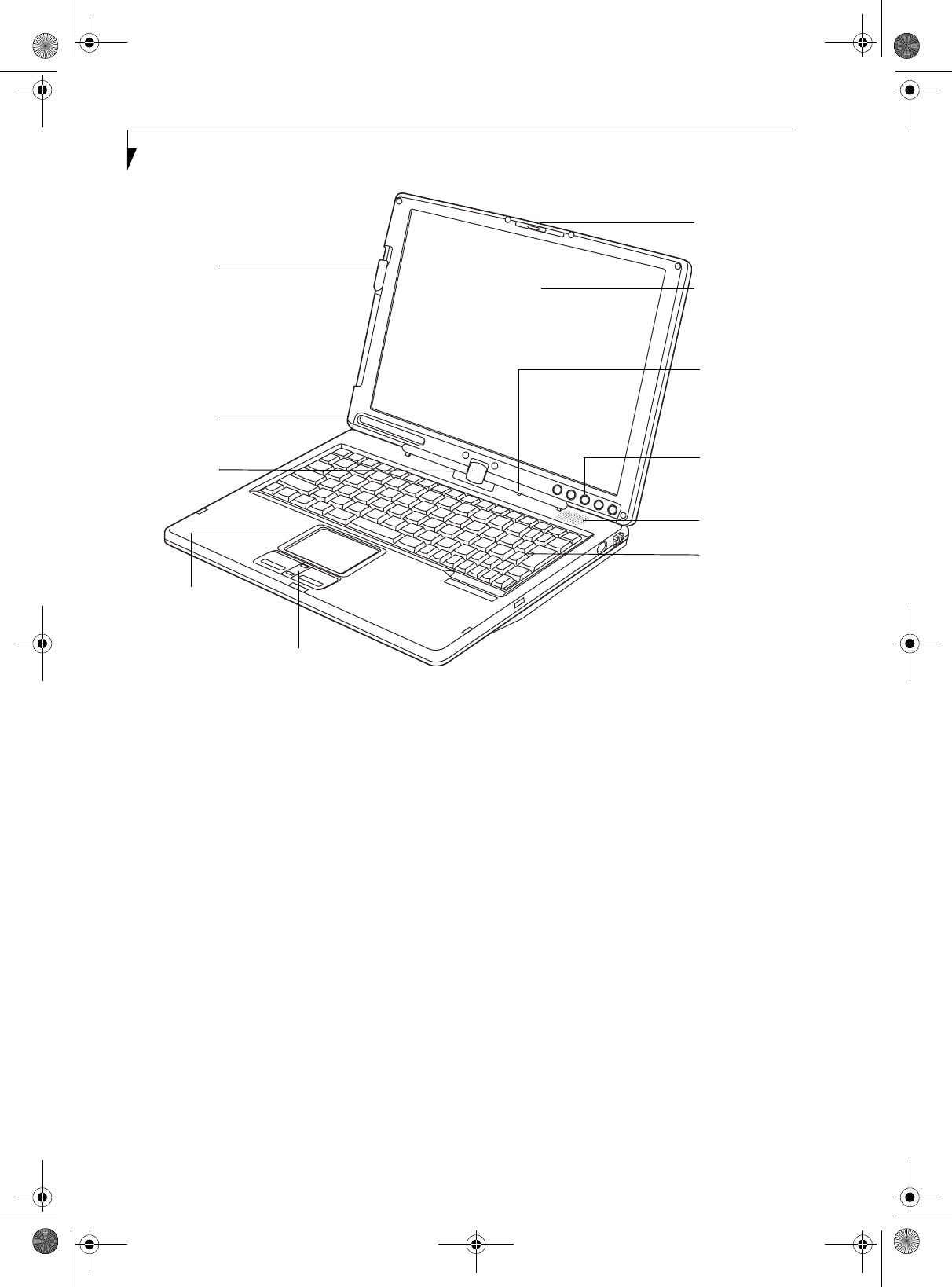
10
LifeBook T Series Tablet PC - Section 2
Figure 2-4. LifeBook T Series Tablet PC with display open
TOP AND FRONT COMPONENTS
The following is a brief description of the top and front
features of the LifeBook T Series Tablet PC. (Figure 2-4)
Pen/Pen Holder
The pen is used as the interface with the active digitizer
display.
Closed Cover Switch
The closed cover switch turns off the LCD back
lighting when the display panel is closed.
Display Panel Latch
The display panel latch locks and releases the display
panel.
Status Indicator Panel
The Status Indicator Panel displays symbols that corre-
spond to specific components of your LifeBook T Series
Tablet PC. See “Status Indicator Panel” on page 15.
LifeBook Security/Tablet PC Buttons
The LifeBook T Series Tablet PC Security/Tablet PC
Buttons provide hardware security and application
launch capabilities. See “LifeBook Security/ Tablet PC
Buttons” on page 21.
Touchpad Pointing Device
The Touchpad pointing device consists of two mouse-
like buttons and one scroll button. See “Touchpad
Pointing Device” on page 25.
Keyboard
A full-function keyboard with dedicated Windows keys.
See “Keyboard” on page 19.
Display Panel
The display panel is a color LCD panel with back
lighting for the display of text and graphics and active
digitizer functionality.
Rotation Hinge
The rotation hinge allows you to transform your Tablet
PC from a notebook configuration into a tablet configu-
ration. For more information, see See “Using the System
as a Tablet” on page 17.
Display
Status
Keyboard
LifeBook
Touchpad
Scroll Button
Indicator
Panel
Panel
Display
Panel
Latch
Rotation
Hinge
Closed
Cover
Switch
Security/
Pointing
Device
Speaker
Pen/
Pen Holder
Tablet PC
Buttons
T Series.book Page 10 Thursday, July 31, 2003 10:49 AM
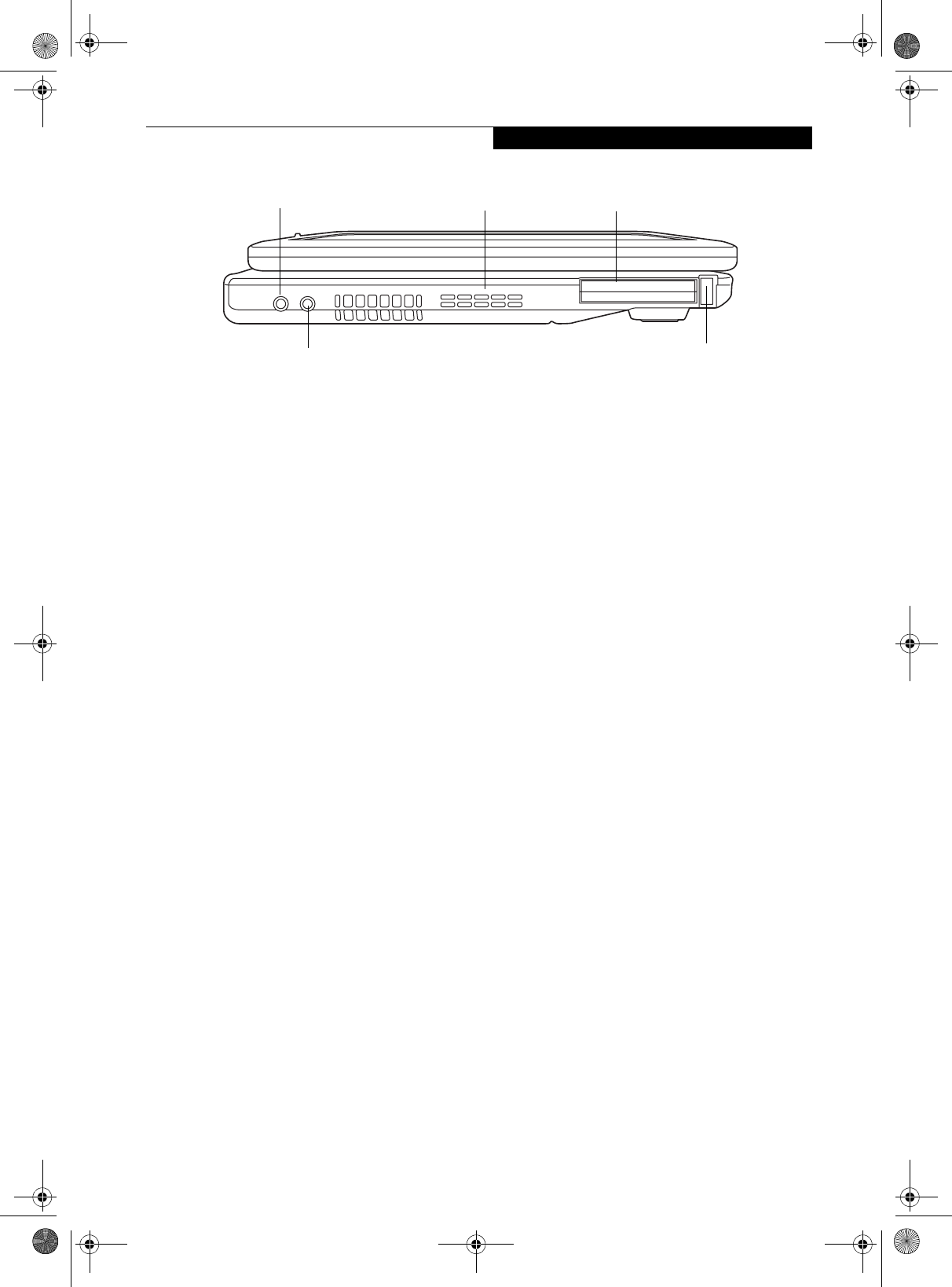
11
Getting to Know Your Tablet PC
Figure 2-5. LifeBook T Series Tablet PC left-side panel
LEFT-SIDE PANEL COMPONENTS
Following is a brief description of your Tablet PC’s left-
side components. (Figure 2-5)
PC Card Slots
The PC Card Slots allow you to install two Type II or
one Type III PC Card. The PC Card Eject Button is used
when ejecting a PC Card from the slot. See “PC Cards”
on page 45.
Headphone Jack
The headphone jack allows you to connect headphones
or powered external speakers. See “Headphone Jack” on
page 49.
Microphone Jack
The microphone jack allows you to connect an external
mono microphone. See “Microphone Jack” on page 49.
PC Card Slots
PC Card Eject/Lock Button
Air Vents
Headphone Jack
Microphone Jack
T Series.book Page 11 Thursday, July 31, 2003 10:49 AM
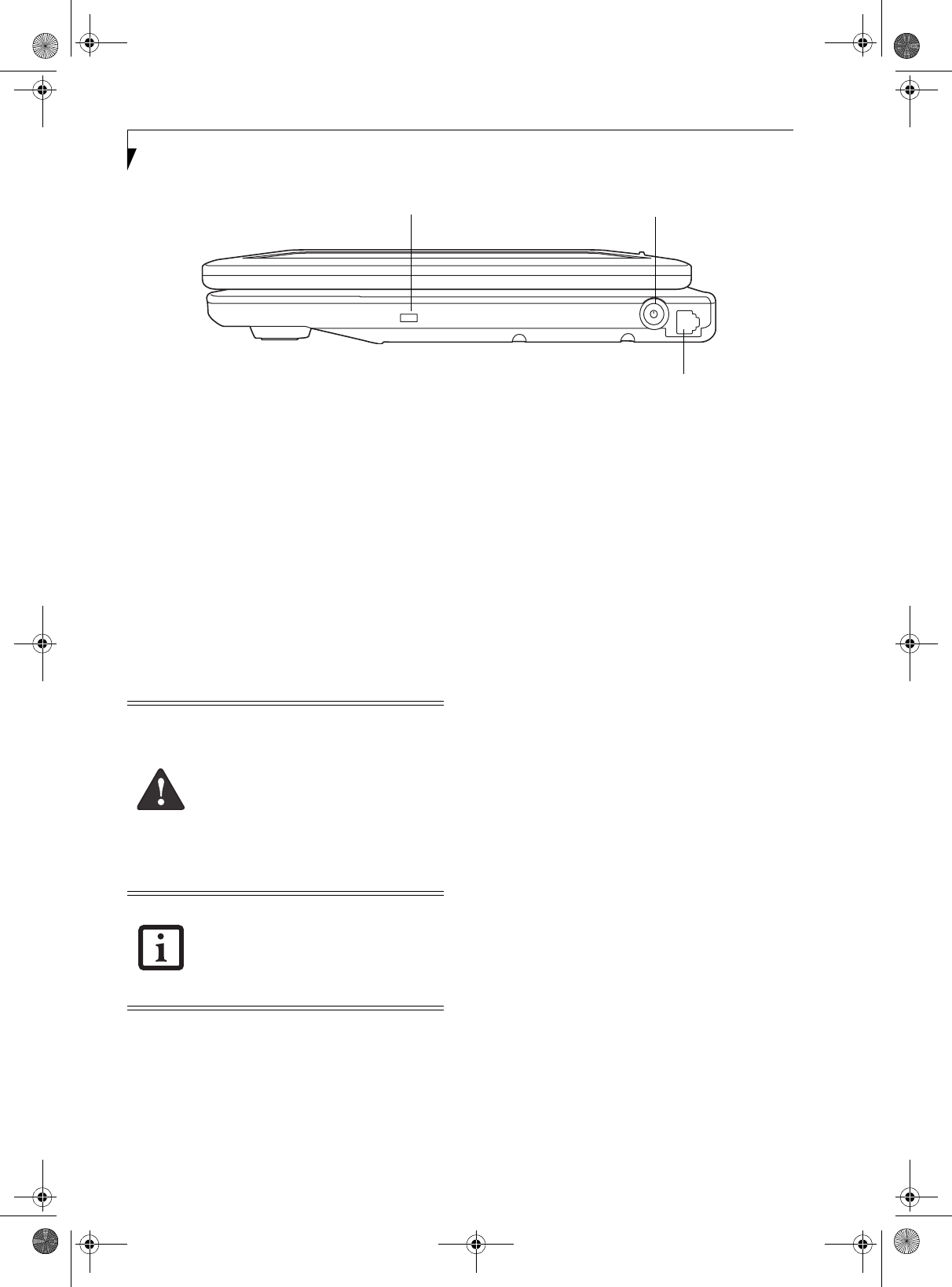
12
LifeBook T Series Tablet PC - Section 2
Figure 2-6. LifeBook T Series Tablet PC right-side panel
RIGHT-SIDE PANEL COMPONENTS
Following is a brief description of your Tablet PC’s right-
side components.
Suspend/Resume Button
The Suspend/Resume button allows you to suspend
Tablet PC activity without powering off, resume your
Tablet PC from standby mode, and power on your
system when it has been shut down from the Windows
operating system. See “Power On” on page 34.
Modem (RJ-11) Telephone Port
The Modem (RJ-11) telephone port is for attaching
a telephone line to the internal multinational 56K
modem.
Anti-theft Lock Slot
The anti-theft lock slot allows you to attach a optional
physical lock-down device.
Modem (RJ-11) Port
Suspend/Resume Button
Anti-theft Lock Slot
The internal multinational modem is not
intended for use with Digital PBX systems.
Do not connect the internal modem to a
Digital PBX as it may cause serious damage
to the internal modem or your entire
LifeBook T Series Tablet PC. Consult your
PBX manufacturer’s documentation for
details. Some hotels have Digital PBX
systems. Be sure to find out BEFORE you
connect your modem.
The internal modem is designed to the
ITU-T V.90 standard. Its maximum speed
of 53000 bps is the highest allowed by
FCC, and its actual connection rate
depends on the line conditions. The
maximum speed is 33600 bps at upload.
T Series.book Page 12 Thursday, July 31, 2003 10:49 AM
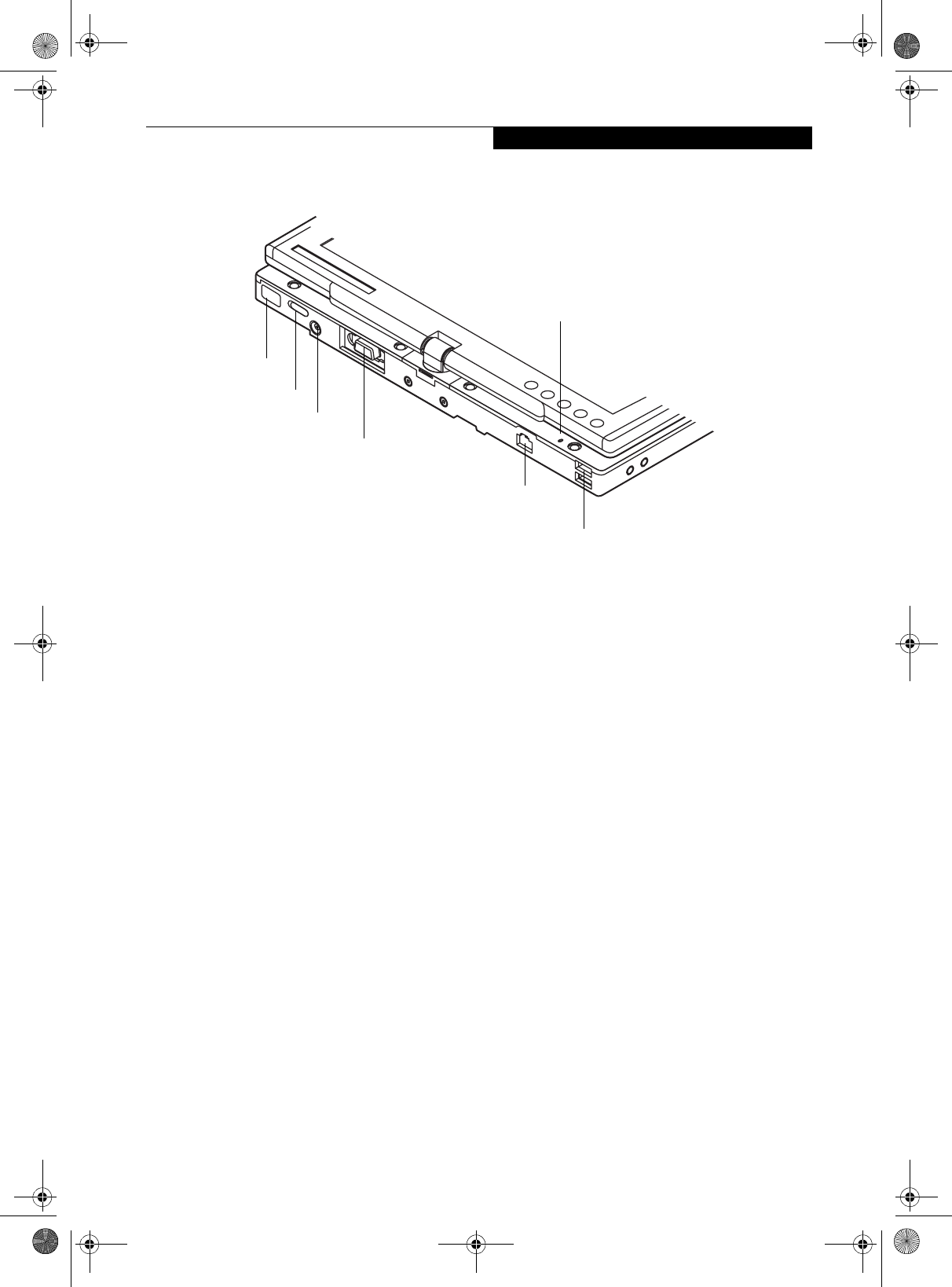
13
Getting to Know Your Tablet PC
Figure 2-7. LifeBook T Series Tablet PC rear panel
REAR PANEL COMPONENTS
DC Power Jack
The DC power jack allows you to plug in the AC adapter
or the optional Auto/Airline adapter to power your
Tablet PC and charge the internal Lithium ion Battery.
External Monitor Port
The external monitor port allows you to connect an
external VGA or SVGA CRT monitor. Note that when
the optional Port Replicator is attached to the system,
you must use the external monitor port on the Port
Replicator rather than the port on the system. See
“External Monitor Port” on page 49.
USB 2.0 Ports
The two USB 2.0 ports allow you to connect Universal
Serial Bus devices. See “Universal Serial Bus Ports” on
page 48.
Infrared Port
The fast IrDA compatible port allows you to communi-
cate with another IrDA compatible infrared device
without a cable.
LAN (RJ-45) Jack
The internal LAN (RJ-45) port is used for an internal
Fast Ethernet (10/100 Base-T/TX) connection. See
“Internal LAN (RJ-45) jack” on page 48.
Built-in Microphone
The built-in microphone allows mono audio input.
WLAN On/Off Switch
The wireless LAN On/Off Switch is used to power off the
wireless antenna when not in use.
Infrared Port
WLAN On/Off Switch
DC Power Jack
External Monitor Port
LAN (RJ-45) Jack
USB 2.0 Ports
Built-in Microphone
(cover removed)
T Series.book Page 13 Thursday, July 31, 2003 10:49 AM
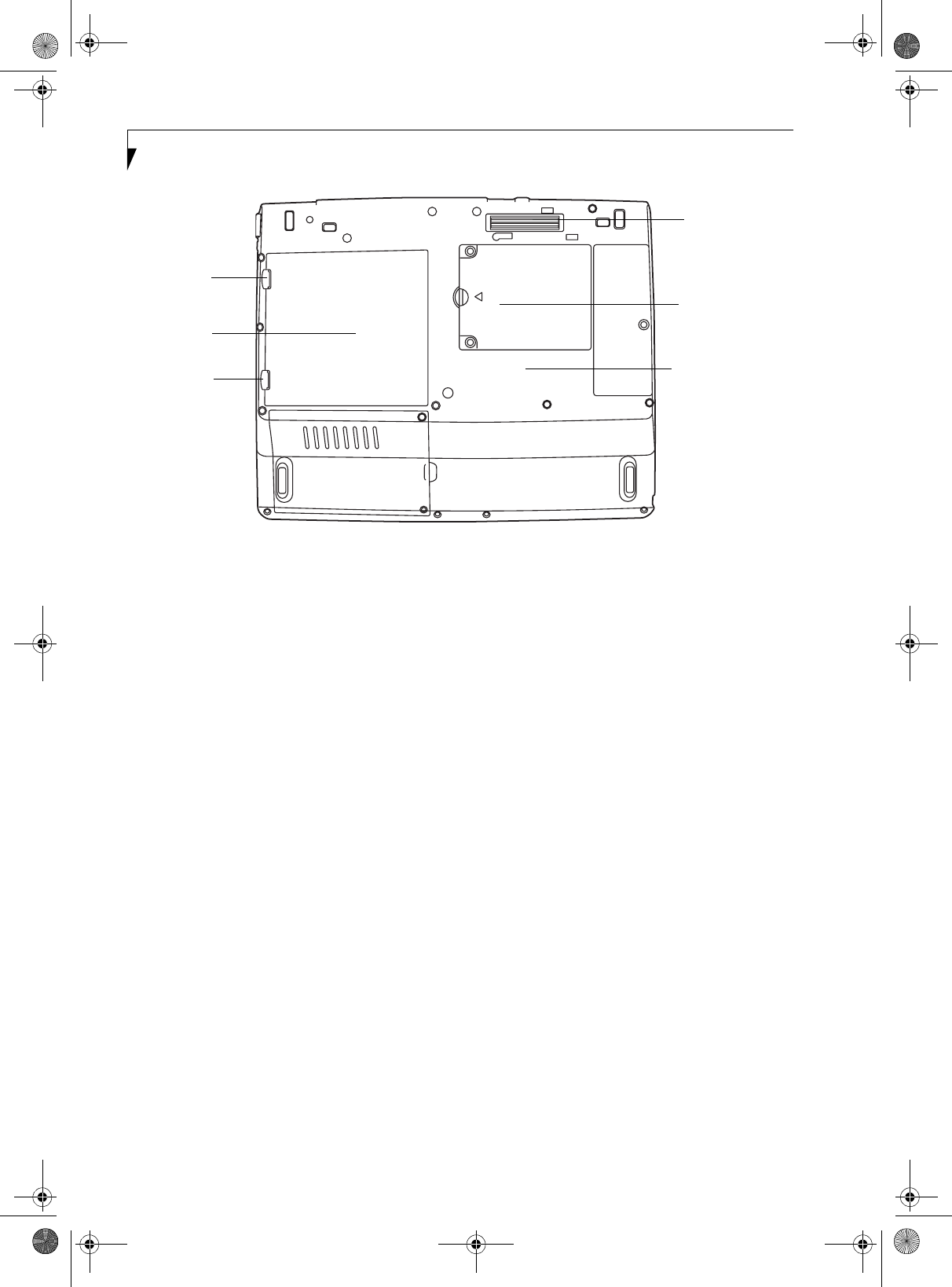
14
LifeBook T Series Tablet PC - Section 2
Figure 2-8. LifeBook T Series Tablet PC bottom panel
BOTTOM COMPONENTS
Following is a brief description of your Tablet PC’s
bottom panel components. (Figure 2-8)
Lithium ion Battery Compartment
The battery compartment contains the internal Lithium
ion battery. The battery should be removed when the
computer is stored over a long period of time or for
swapping a discharged battery with a charged Lithium
ion battery. See “Lithium ion Battery” on page 41.
Port Replicator Connector
This connector allows you to connect the optional port
replicator.
Main Unit and Configuration Label
The configuration label shows the model number and
other information about your LifeBook T Series Tablet
PC. In addition, the configuration portion of the label
has the serial number and manufacturer information
that you will need to give your support representative. It
identifies the exact version of various components of
your Tablet PC.
Memory Upgrade Compartment
Your Tablet PC comes with high speed Synchronous
Dynamic RAM (SDRAM). The memory upgrade
compartment allows you to expand the system memory
capacity of your Tablet PC, hence improving overall
performance. See “Memory Upgrade Module” on
page 43.
Memory Upgrade
Compartment
Lithium ion
Battery
Main Unit and
Configuration
Label (approximate
Battery
Port Replicator
Connector
location)
Pack
Latch
Battery
Pack
Latch
Compartment
T Series.book Page 14 Thursday, July 31, 2003 10:49 AM
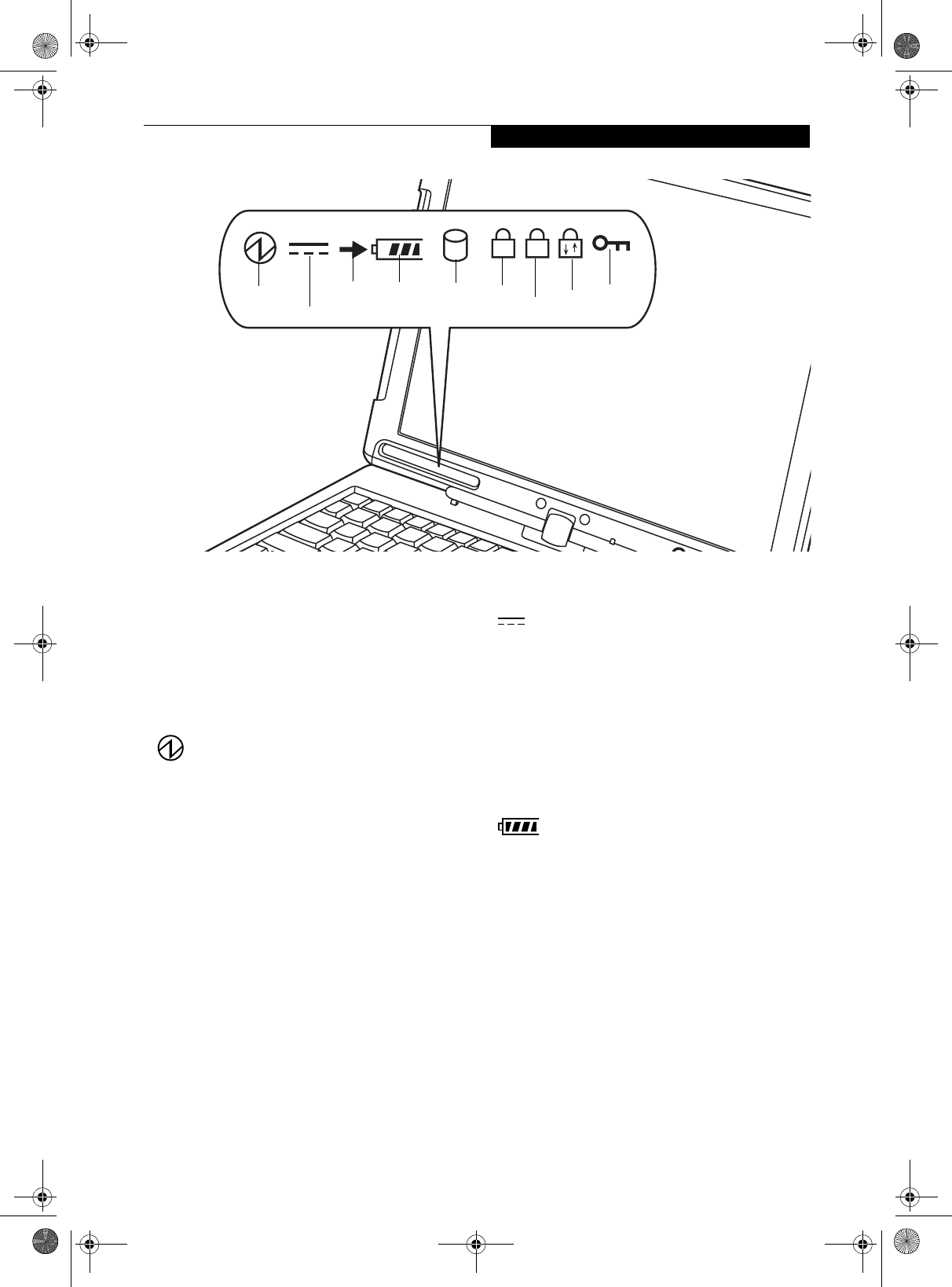
15
Getting to Know Your Tablet PC
Figure 2-9. Status Indicator Panel
Status Indicator Panel
The Status Indicator Panel displays symbols that corre-
spond to specific components of your LifeBook T Series
Tablet PC. These symbols tell you how each of those
components is operating. (Figure 2-9)
POWER INDICATOR
The Power indicator symbol states whether your system
is operational. It has several different states, each of
which tells you what mode your Tablet PC is in at that
time.
■Steady On: This means that there is power to your
Tablet PC and that it is ready for use.
■Flashing: This means that your Tablet PC is in Standby
mode.
■Steady Off: This means that your system is either in
Hibernate mode, or that your Tablet PC has been
turned off.
If you are charging your battery, the Power indicator
symbol will remain on even if your LifeBook T Series
Tablet PC is shut off. The Power indicator symbol will
also remain on if you have either adapter connected and
are shut down from Windows.
AC ADAPTER INDICATOR
The AC adapter indicator states whether your notebook
is operating from the AC adapter, the auto/airline
adapter or the batteries. This icon has two different
states that can tell you what power source your LifeBook
notebook is using.
■On: This means that either of the adapters are
currently in use.
■Off: Power is only coming from the batteries, and
you do not have an adapter connected.
BATTERY LEVEL INDICATORS
The Battery Level indicators state whether or not the
Lithium ion battery is installed and how much charge is
available within the battery. (Figure 2-10)
Additionally, this indicator displays when an overcur-
rent is detected. If an overcurrent is detected, the battery
stops charging and the Battery Level indicator blinks at
the rate of once per second. To stop the indicator from
blinking, you must disconnect the power adapter.
A1
Battery
Level Hard Drive
Access
Battery
Charging NumLk
ScrLk
Security
Indicator
CapsLk
Power
AC Adapter
T Series.book Page 15 Thursday, July 31, 2003 10:49 AM
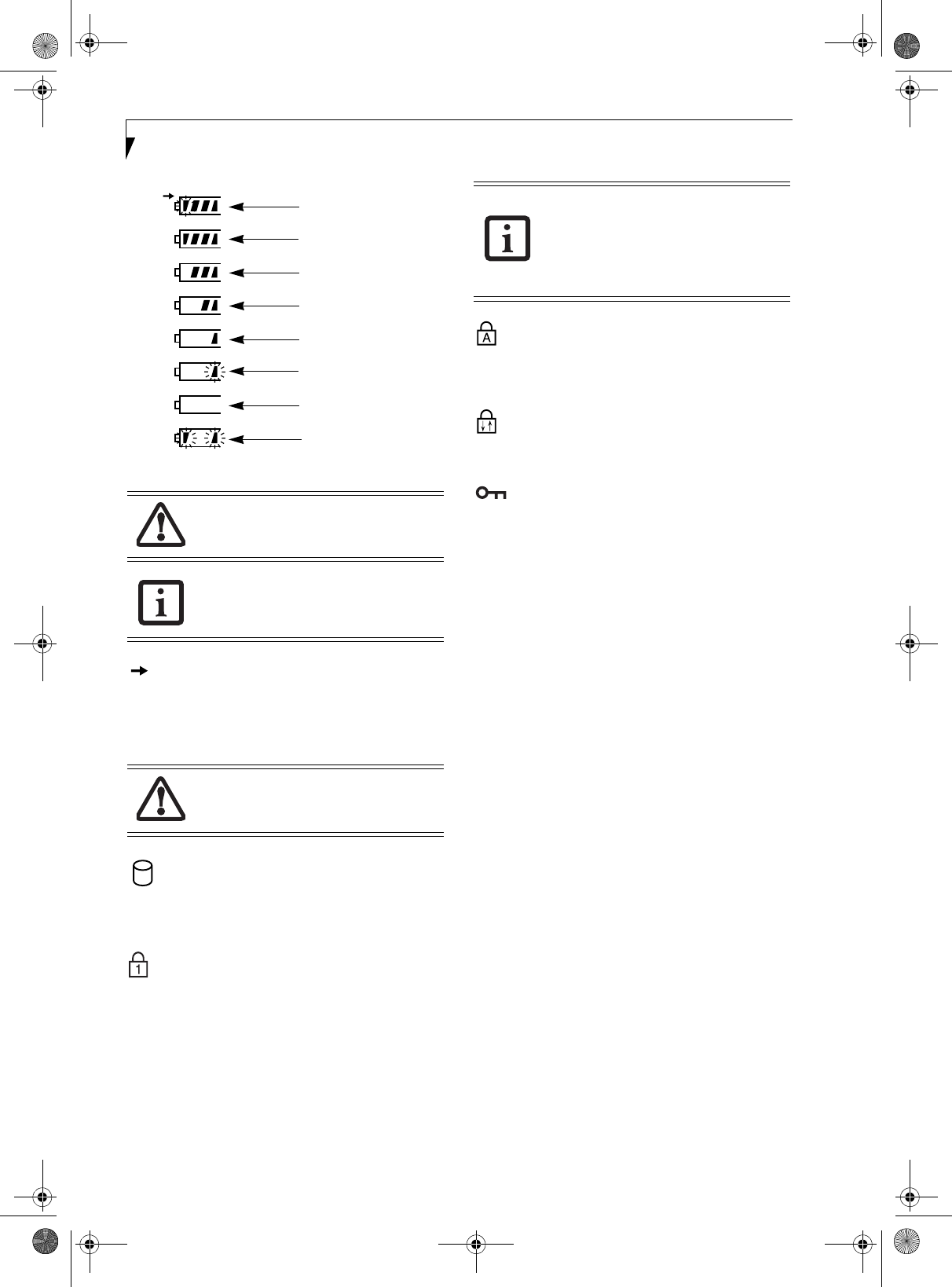
16
LifeBook T Series Tablet PC - Section Two
Figure 2-10. Battery Level Indicator
BATTERY CHARGING INDICATOR
Located to the left of the Battery Level indicator is a
small arrow symbol. This symbol states whether the
battery is charging. This indicator will flash if the battery
is too hot or cold to charge.
HARD DRIVE ACCESS INDICATOR
The Hard Drive Access indicator states whether your
internal hard drive is being accessed.
NUMLK INDICATOR
The NumLk indicator states that the integral keyboard is
set in ten-key numeric keypad mode.
If there is no battery activity and the power adapters are
not connected, the Battery Level indicators will also be
off.
CAPSLOCK INDICATOR
The CapsLock indicator states that your keyboard is set
to type in all capital letters.
SCRLK INDICATOR
The ScrLk indicator states that your scroll lock is active.
SECURITY INDICATOR
The Security Indicator flashes (if a password was set)
when the system resumes from Off or Standby modes.
You must enter the password that was set in the Security
Panel before your system will resume operation.
A shorted battery is damaged and must be
replaced. (Figure 2-10)
If there is no battery activity and the
power adapters are not connected, the
Battery Level indicators will also be off.
Batteries subjected to shocks, vibration or
extreme temperatures can be permanently
damaged.
76%–100% Charging
76%–100%
51%–75%
26%–50%
11%–25%
Low Warning <11%
Critical Low or
Dead Battery
Shorted Battery
If you are using the optional external
numerical keypad, pressing the [NumLk]
key will activate the external keypad. The
indicator will come on, however it will not
change any of the functionality of your
keyboard keys.
T Series.book Page 16 Thursday, July 31, 2003 10:49 AM
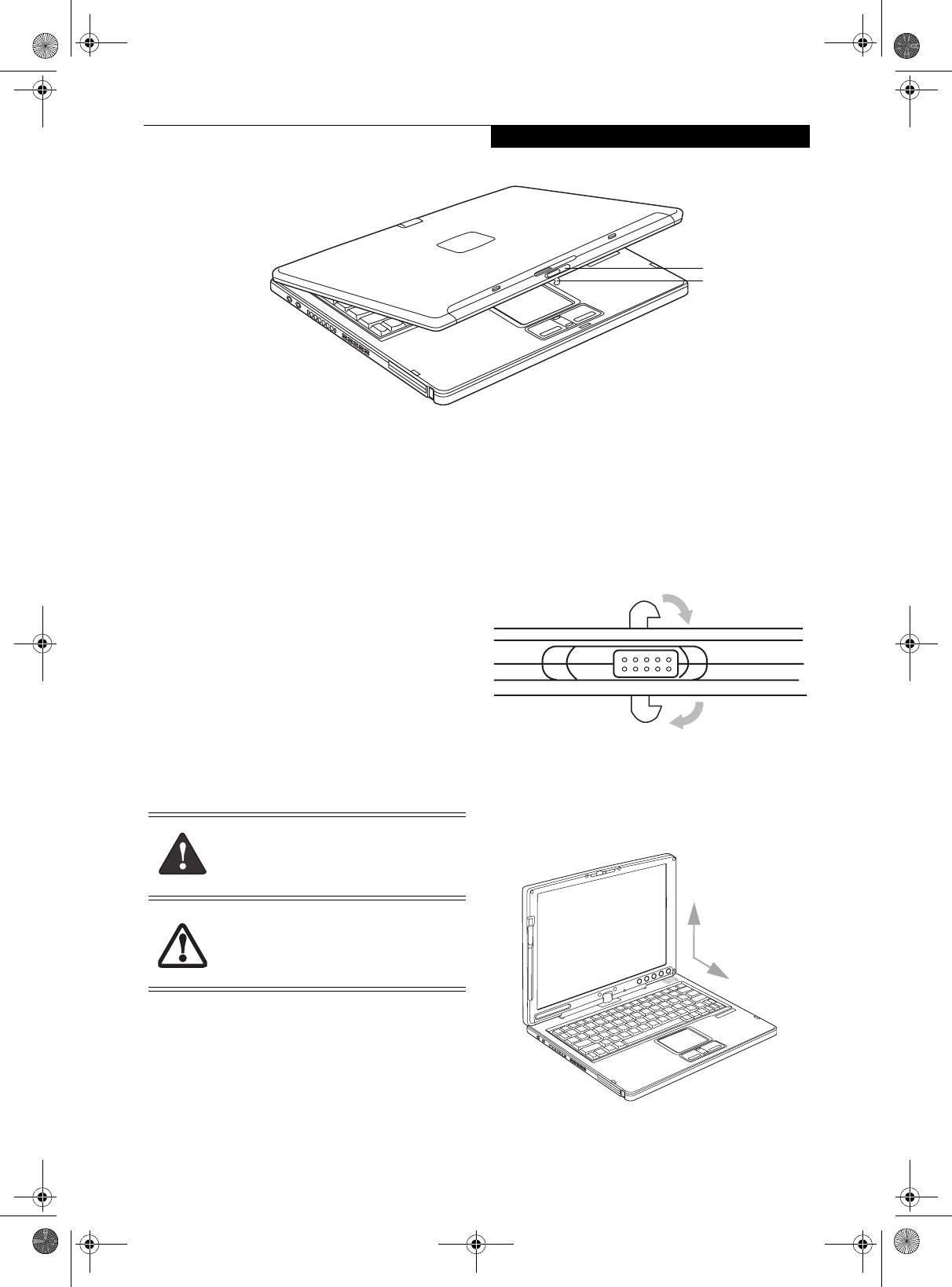
17
Getting to Know Your Tablet PC
Figure 2-11. Opening the display
Display Panel
Your LifeBook T Series Tablet PC contains a display
panel that is backlit for easier viewing in bright environ-
ments. The convertible design of your Tablet PC allows
you to open the display fully, rotate it 180 degrees, and
lay it face up on the keyboard. This allows you to use the
system as a tablet, much as you would a pad of paper.
OPENING THE DISPLAY PANEL
1. Slide the latch release to the right. This releases the
locking mechanism. While holding the latch release,
lift display cover.
2. Lift the display backwards, being careful not to
touch the screen, until it is at a comfortable viewing
angle. (Figure 2-11)
USING THE SYSTEM AS A TABLET
If you would like to use the system as a tablet, perform
the following steps.
1. Lift the display until it is perpendicular to the
keyboard. (Figure 2-13).
2. When the display is perpendicular to the keyboard,
rotate it clockwise (when viewed from the top). Be
very careful to rotate it in the direction indicated.
(Figure 2-14). Turn the display 180 degrees so that it
is facing backwards. (Figure 2-15)
3. Holding the top edge of the display panel, pull it
forward until it is lying nearly atop the keyboard.
4. Push the latch towards the display (See "A" in
Figure 2-12). The latch will pivot so the top latch
disappears, and the bottom latch appears (See "B" in
Figure 2-12). Holding the latch down, lay the display
flush against the system so that the latch engages.
You can now use your system as a tablet. (Figure 2-
16)
Figure 2-12. Latching/Unlatching
5. To return the system to notebook configuration,
repeat step 3 and 2. Be sure to turn the display in the
opposite direction when performing step 2.
Figure 2-13. Fully open display
Display
Panel
Latch
Latch
Release
Rotate the system display only in the
direction indicated in the procedure.
Turning the display in the incorrect
direction could cause hinge damage.
In the following step, be sure to position
the display perpendicular to the keyboard,
otherwise the keyboard or display cover
could get scratched.
A
B
Top latch
Bottom latch
Display Side
90
o
T Series.book Page 17 Thursday, July 31, 2003 10:49 AM
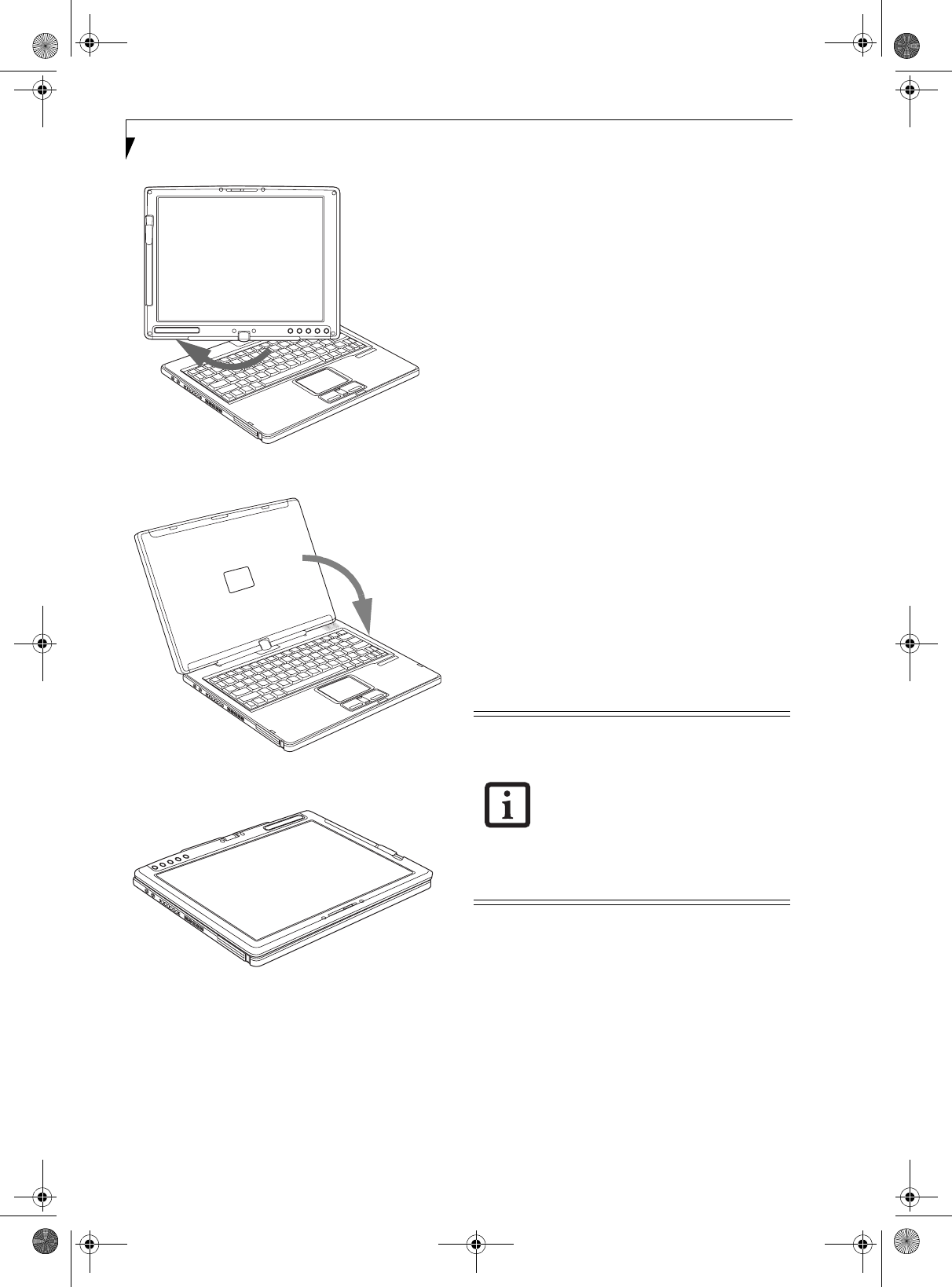
18
LifeBook T Series Tablet PC - Section Two
Figure 2-14. Rotating the display
Figure 2-15. Display rotated completely
Figure 2-16. System in tablet configuration
ADJUSTING DISPLAY PANEL BRIGHTNESS
Once you have turned on your Tablet PC, you may want
to adjust the brightness level of the screen to a more
comfortable viewing level. There are two ways to adjust
the brightness, keyboard and power management utility.
Using Keyboard to Adjust Brightness
Adjusting the brightness using the keyboard changes the
system setting (i.e., the settings you make via the func-
tion keys automatically changes the brightness settings
in the system’s Pen and Tablet Settings).
■[Fn+F6]: Pressing repeatedly will lower the brightness
of your display.
■[Fn+F7]: Pressing repeatedly will increase the
brightness of the display.
Using Power Management to Adjust Brightness
To adjust brightness with the power management utility,
click Start -> Control Panel -> Tablet and Pen Settings.
Select the Display tab and set the screen brightness slider
for battery and AC power scenarios.
Using the Fujitsu Menu to Adjust Brightness
To adjust brightness using the Fujitsu menu, click on the
Fujitsu Menu icon in the system tray in the lower right
corner of the screen. From the menu that appears, select
Brightness Control. The Tablet and Pen Settings window
will open. Select the Display tab and set the screen
brightness slider for battery and AC power scenarios.
If using AC power your brightness setting
is set to its highest level by default. If using
battery power your brightness settings is
set to approximately mid-level by default.
The higher the brightness level, the more
power the LifeBook T Series Tablet PC will
consume and the faster your batteries will
discharge. For maximum battery life, make
sure that the brightness is set as low as
possible.
T Series.book Page 18 Thursday, July 31, 2003 10:49 AM
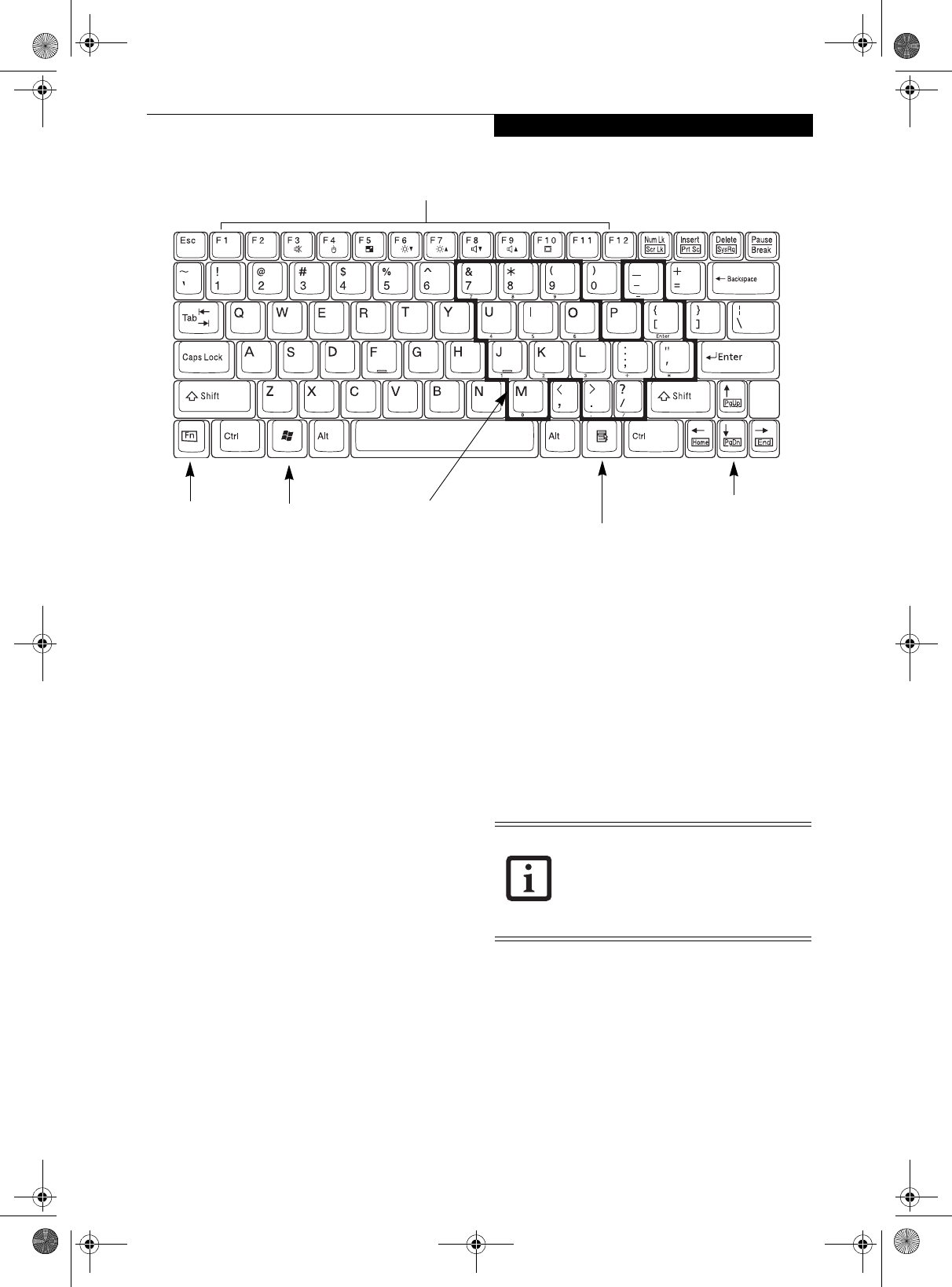
19
Getting to Know Your Tablet PC
Figure 2-17. Keyboard
Keyboard
USING THE KEYBOARD
Your LifeBook T Series Tablet PC has an integral 83-key
keyboard. The keys perform all the standard functions
of a 101-key keyboard, including the Windows keys and
other special function keys. This section describes the
following keys. (Figure 2-17)
■Numeric keypad: Your Tablet PC allows certain keys to
serve dual purposes, both as standard characters and
as numeric and mathematical keys. The ability to tog-
gle between the standard character and numerical keys
is controlled through the [NumLk] key.
■Cursor keys: Your keyboard contains four arrow
keys for moving the cursor or insertion point to the
right, left, up, or down within windows, applications
and documents.
■Function keys: The keys labeled [F1] through [F12],
are used in conjunction with the [Fn] key to produce
special actions that vary depending on what program
is running.
■Windows keys: These keys work with your Windows
operating system and function the same as the
onscreen Start menu button, or the right button on
your pointing device.
NUMERIC KEYPAD
Certain keys on the keyboard perform dual functions as
both standard character keys and numeric keypad keys.
NumLk can be activated by pressing the [NumLk] key.
Turning off the NumLk feature is done the same way.
Once this feature is activated you can enter numerals 0
through 9, perform addition ( + ), subtraction ( - ),
multiplication ( * ), or division ( / ), and enter decimal
points ( . ) using the keys designated as ten-key function
keys. The keys in the numeric keypad are marked on the
front edge of the key to indicate their secondary func-
tions. (Figure 2-17)
WINDOWS KEYS
Your LifeBook T Series Tablet PC has two Windows
keys: a Start key and an Application key. The Start key
displays the Start menu. This button functions the same
as your onscreen Start menu button. The Application
key functions the same as your right mouse button and
displays shortcut menus for the selected item. (Please
refer to your Windows documentation for additional
information regarding the Windows keys.) (Figure 2-17)
Fn Key Start Key
Function Keys
Numeric Keypad
Application Key
Cursor Keys
(outlined with thick
black line)
If you are using the optional external
numerical keypad, pressing the [NumLk]
key will activate the external keypad. The
indicator will come on, however it will not
change any of the functionality of your
keyboard keys.
T Series.book Page 19 Thursday, July 31, 2003 10:49 AM
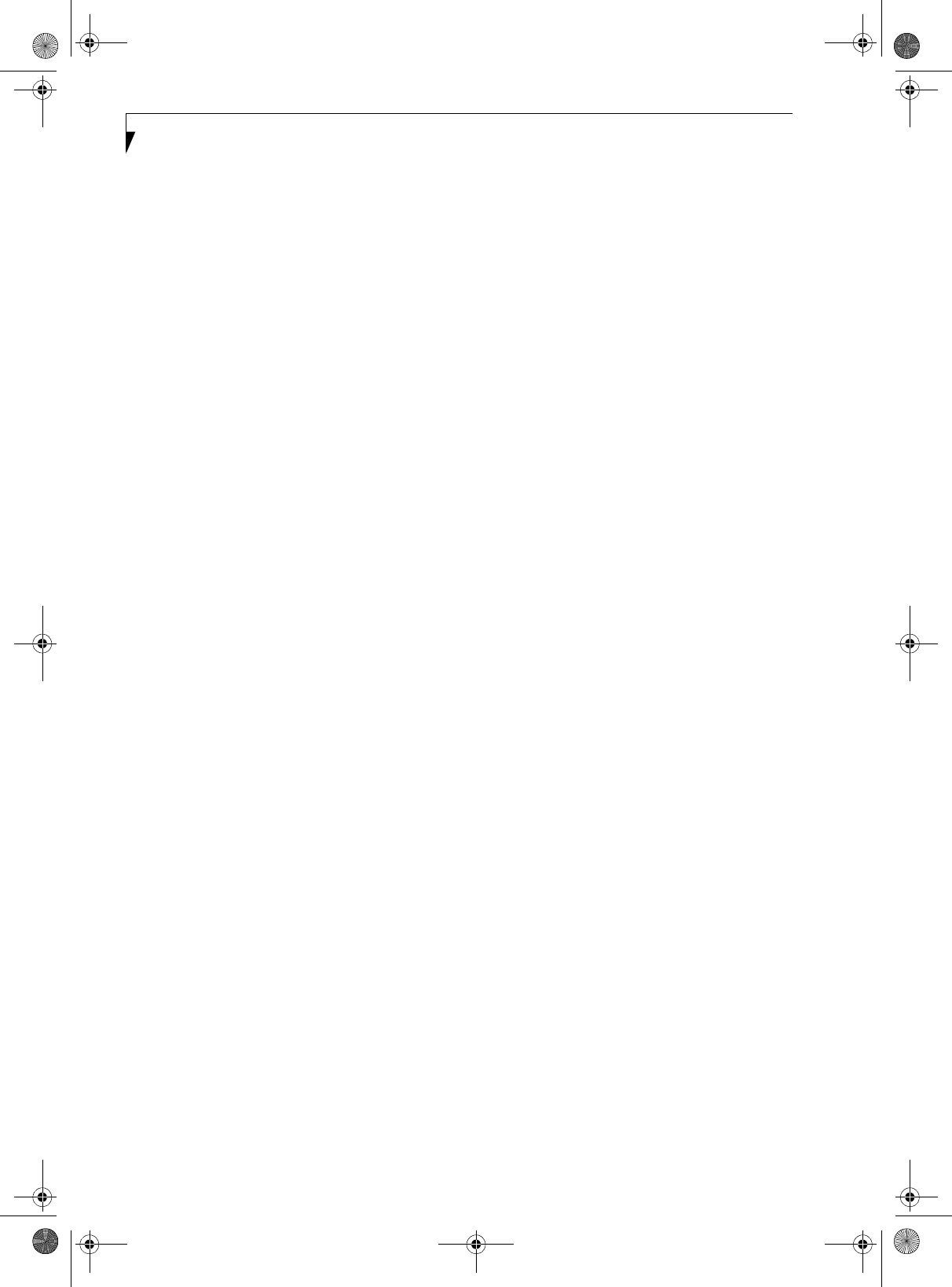
20
LifeBook T Series Tablet PC - Section Two
CURSOR KEYS
The cursor keys are the four arrow keys on the keyboard
which allow you to move the cursor up, down, left, and
right in applications. In programs such as Windows
Explorer, it moves the “focus” (selects the next item up,
down, left, or right). (Figure 2-17)
FUNCTION KEYS
Your Tablet PC has 12 function keys, F1 through F12.
The functions assigned to these keys differ for each
application. You should refer to your software documen-
tation to find out how these keys are used.
(Figure 2-17)
[Fn] Key
The [Fn] key provides extended functions for the
Tablet PC and is always used in conjunction with
another key.
■[Fn+F3]: Pressing [F3] while holding [Fn] will toggle
the Audio Mute on and off.
■[Fn+F4]: Pressing [F4] while holding [Fn] will toggle
the built-in pointing device on and off. Note that the
[Fn+F4] combination only works if Manual Setting is
selected in the BIOS. (See “Entering the BIOS Setup
Utility” on page 34)
■[Fn +F5]: Pressing [F5] while holding [Fn] allows
you to toggle between video compensation and no
compensation. (Video compensation controls spacing
on the display. When it is enabled, displays with less
than 1024 x 768 or 800 x 600 pixel resolution will still
cover the entire screen.)
■[Fn+F6]: Pressing [F6] repeatedly while holding [Fn]
will lower the brightness of your display. Note that
adjusting the brightness using the keyboard changes
the system setting.
■[Fn+F7]: Pressing [F7] repeatedly while holding [Fn]
will increase the brightness of the display.
■[Fn+F8]: Pressing [F8] repeatedly while holding [Fn]
will decrease the volume of your Tablet PC.
■[Fn+F9]: Pressing [F9] repeatedly while holding [Fn]
will increase the volume of your Tablet PC.
■[Fn+F10]: Pressing [F10] while holding [Fn] allows
you to change your selection of where to send your
display video. Each time you press the combination
of keys you will step to the next choice. The choices,
in order, are: built-in display panel only, both built-in
display panel, and external monitor or external moni-
tor only.
T Series.book Page 20 Thursday, July 31, 2003 10:49 AM
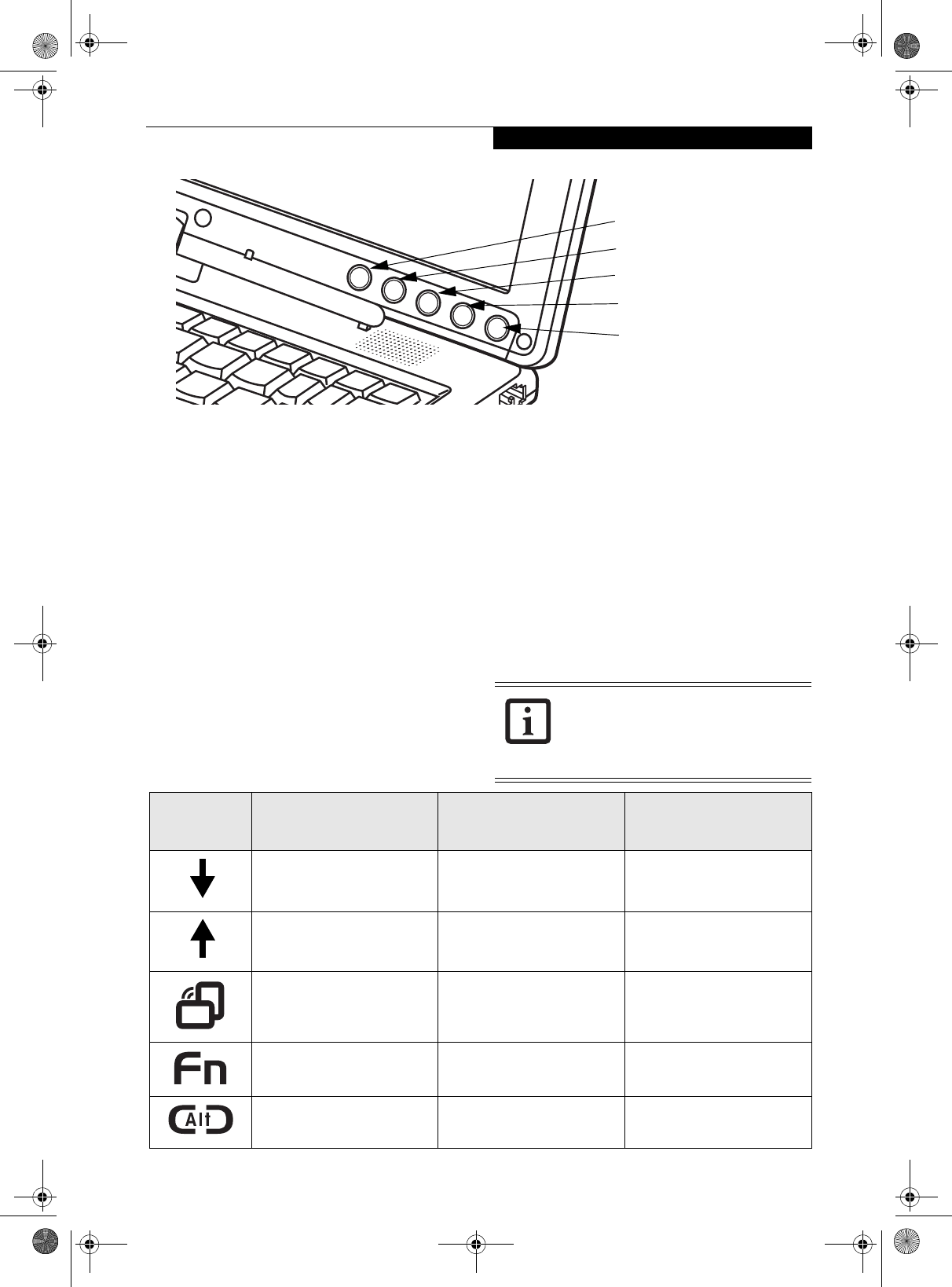
21
Getting to Know Your Tablet PC
Figure 2-18. LifeBook T Series Tablet PC Security/Tablet PC Buttons
LifeBook Security/
Tablet PC Buttons
A unique feature of your LifeBook T Series Tablet PC is
the array of Security and Tablet PC buttons. These
buttons allow you to secure your Tablet PC from
unauthorized use and to launch specific applications
with the touch of a button.
If the security system is activated, upon starting your
Tablet PC or resuming from Standby, Hibernate, or shut-
down mode the security system will require you to enter
a password code using the security buttons. After you
enter the correct password, your Tablet PC will resume
operation.
The five security/Tablet PC buttons are located on the
bottom right-hand side of the display when it is config-
ured to be used as a notebook. (Figure 2-18)
Security functions: All five buttons are used when
implementing security functions. Four of the buttons
are used to enter the password, and the fifth is used as an
Enter button. See the right-hand column of Table 2-3.
Tablet PC funct io n s : All five of the buttons have
primary functions. Four of the buttons have secondary
functions when used as application buttons. The
secondary functions are activated by pressing the Func-
tion (Fn) button while pressing the application button.
See Table 2-3 for specific functions. The secondary func-
tions of the Application A and B buttons can be changed
to launch any application. See “Changing Tablet PC
Button Functions” on page 22
Table 2-3. Security/Tablet PC Button Functions
(1) Application A Button
(3) Button 3
(2) Application B Button
(4) Button 4
Enter Button
When the system is logging on or when it is
locked (i.e., when you have the Logon or
Computer Locked window showing on your
desktop), the A and B buttons act as [Tab]
and [Enter] keys, respectively.
Button Icon Primary Function Secondary Function
(Fn + Button)
Security Panel Function
(Pre-boot and resuming
from suspend)
Page Down User-defined Application A
(Default = Calculator) Security Button 1
Page Up User-Defined Application B
(Default = MS Journal) Security Button 2
Screen Rotation VGA-Out Security Button 3
Secondary Function
Selection Fujitsu Menu Utility Security Button 4
Ctl+Alt+Del Button None Security Enter Button
T Series.book Page 21 Thursday, July 31, 2003 10:49 AM
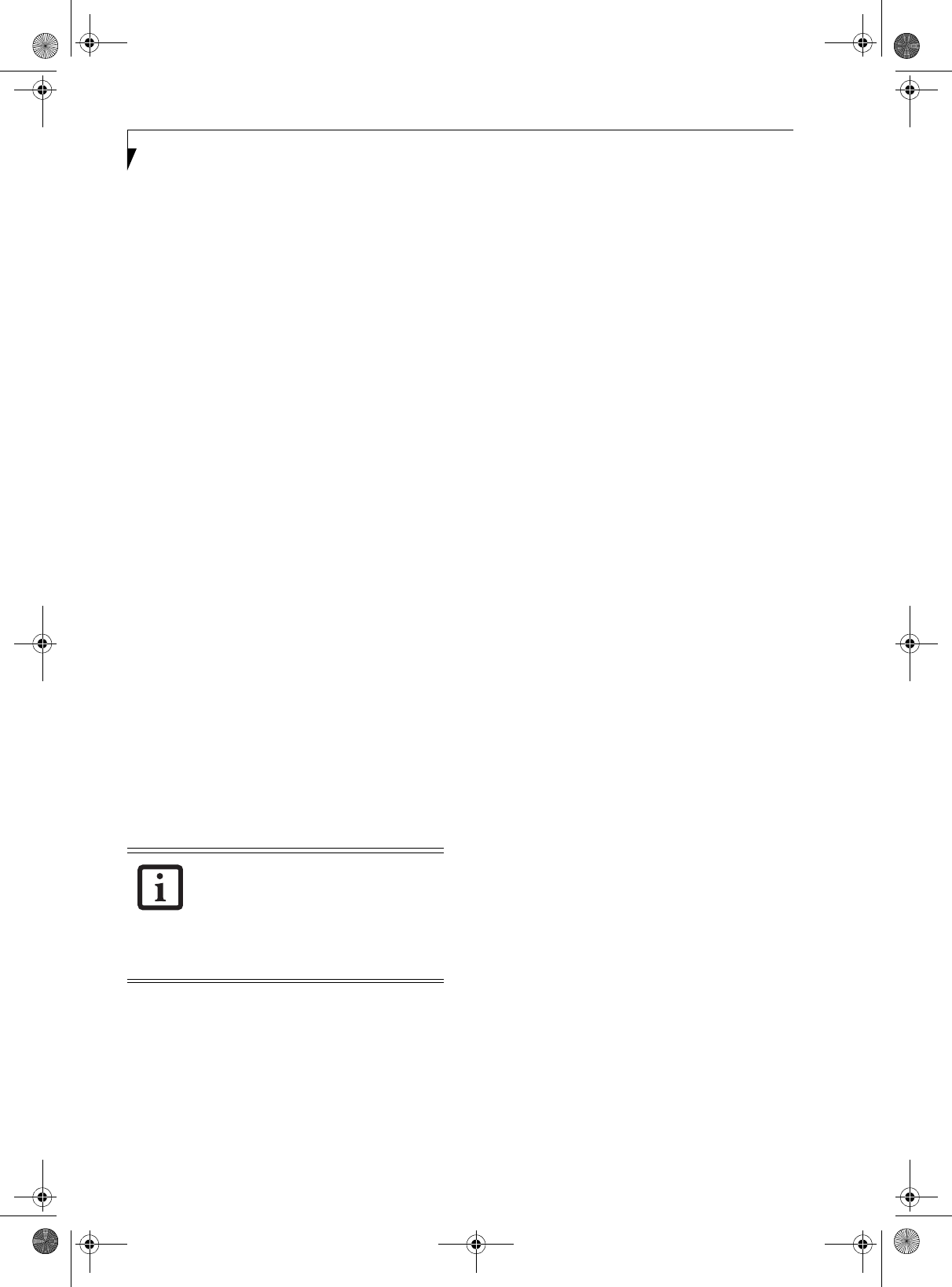
22
LifeBook T Series Tablet PC - Section Two
Page Down / Application A Button
When you press the Page Down button when the system
is running, each press of the button will scroll the screen
down one frame. This allows you to navigate quickly
through large documents.
When you press the Fn button while you press then
release the Page Down/Application A button, you will
automatically start whichever program is assigned to the
button. The default application for this button is Calcu-
lator.
See “Changing Tablet PC Button Functions” on page 22
to select a different application for this button.
Page Up / Application B Button
When you press the Page Up button when the system is
running, each press of the button will scroll the screen
up one frame. This allows you to navigate quickly
through large documents.
When you press the Fn button while you press then
release the Page Up/Application A button, you will auto-
matically start whichever program is assigned to the
button. The default application for this button is
Microsoft Journal.
See “Changing Tablet PC Button Functions” on page 22
to select a different application for this button.
Screen Rotation / VGA-Out Button
The screen rotation feature would normally be used only
when the system is configured as a tablet. When you
would like to use the tablet as an eBook, for example,
you would use the portrait orientation; when accessing
spreadsheets or using the system as a notebook, you
would more typically use landscape orientation.
When the system is changed to tablet configuration, the
orientation automatically changes to portrait mode by
default.
When you press the Screen Rotation / VGA-Out button,
the system screen orientation changes from portrait
(vertical) to landscape (horizontal) or from landscape to
portrait.
Function / Fujitsu Menu Utility Button
The Function button works in conjunction with the
other application buttons to provide additional func-
tionality for the buttons. Refer to specific details above.
Pressing the Fn button twice in succession causes the
Fujitsu Menu Utility to appear on your screen, allowing
you to modify certain system settings.
Ctl+Alt+Del Button
Pressing and holding the Ctl-Alt-Del button for up to
750 msecs launches the Logon screen or the Windows
Task Manager (if the system hasn’t yet been configured).
CHANGING TABLET PC BUTTON FUNCTIONS
The Application A and B buttons can be changed to
launch a program or perform an action you select. By
default, the Application A button launches the Calcu-
lator, and the Application B button launches MS
Journal.
To launch different applications or cause the Application
A or B buttons to perform a specific action:
1. Double-click on the Tablet and Pen Settings icon in
the Control Panel.
2. Select the Tablet Buttons tab and select the button
you would like to change from the list.
3. Click [Change] and open the drop down list in the
Action: field.
4. Select the action you would like the button to
perform. If you want to launch a program, click on
Launch an Application then browse to the location
of the program.
5. Click [OK], then click [OK] again. The buttons will
now perform the actions you have assigned to them.
SETTING UP LIFEBOOK SECURITY PANEL
When you receive your Tablet PC, the security panel
application is pre-installed without any passwords. The
following sections provide detailed information on your
security panel, how to set, change or remove passwords.
Numbered Buttons
Use these buttons to enter your password.(Figure 2-18)
Enter Button
After entering the button strokes, push this button to
enter the password into the Tablet PC. (Figure 2-18)
PASSWORDS
The user and supervisor password may be set on this
Tablet PC. A supervisor password is typically the same
for all Tablet PC’s and notebooks in a work group, office,
or company to allow for system management. Individual
computers in a group environment should not use a
common password. A password consists of one to five
button strokes plus the enter button. A valid stroke
consists of pushing one or up to four buttons simulta-
neously.
The screen orientation default can be
changed by going to the Control Panel and
double-clicking on the Fujitsu Display
Control icon and selecting the desired
defaults from the Display Orientation
section. After changing the defaults, click
[OK].
T Series.book Page 22 Thursday, July 31, 2003 10:49 AM
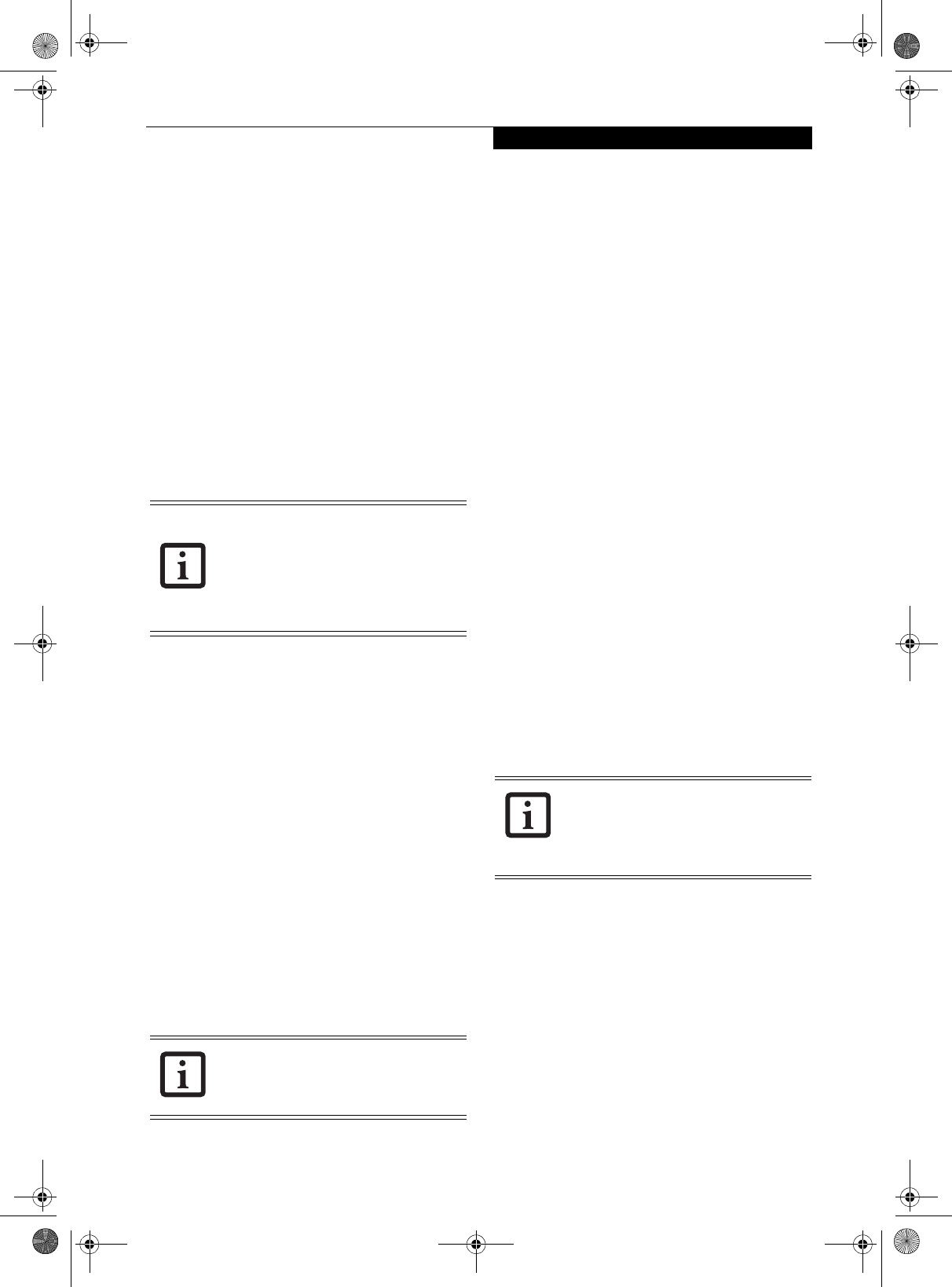
23
Getting to Know Your Tablet PC
The following are valid button strokes:
■Pushing [4] by itself
■Pushing [2] and [3] at the same time
■Pushing [1], [2], and [4] at the same time
■Pushing [1], [2], [3], and [4] at the same time
The following are valid passwords. The numbers within
braces ({ }) are button strokes using more than one
button.
■{[2]+[3]}, [1], [Enter]
■[4], [enter]
■{[1]+[3]}, {[2]+[3]+[4]}, [1], [4], [2], [Enter]
Setting Passwords
When shipped from the factory, no passwords are set.
You have a choice of having no password or setting a
supervisor and user password. You must set the super-
visor password before the user password.
Setting Supervisor Password
You must have set a supervisor password before setting
any user passwords. The supervisor password can bypass
the user password.
1. Go to the Start menu.
2. Click on Run.
3. Type in:
C:\Program Files\Fujitsu\Security
Panel Application\Supervisor\
FJSECS.EXE, then press [Enter]
4. Follow the on-screen instructions to set the
Supervisor password.
Setting User Password
1 Go to the Start menu.
2. Click on All Programs.
3. Click on Security Panel Application -> Security
Panel Application.
4. Follow the on-screen instructions to set the
user password.
USING YOUR LIFEBOOK SECURITY PANEL
The security lock feature is in effect both when the system
resumes from Off, Standby, or Hibernation state. You
always need to push the Security Panel buttons to input
the user password. Your system will not begin the boot
sequence until you enter your supervisor/user password.
From Off State
1. Turn on your system.
2. When the Security Indicator flashes, enter the pass-
word and press Enter button.
For example, if the password is 22222, first press
Button 2 five times and press the Enter button. The
Tablet PC will boot to normal operation.
From Standby/Hibernation State
1. Press your Suspend/Resume button.
2. When the Security Indicator flashes, enter the pass-
word and press Enter button.
The Tablet PC should resume normal operation.
Incorrect Password Entry
If an invalid supervisor or user password is entered three
times in succession, the system will “beep” for about one
minute. If a valid password is entered within a minute
(while system beeps), the beeping will stop and the
Tablet PC will resume normal operation. If no password
is entered or an invalid password is entered while the
system beeps, the system will return to its previous
locked state (standby or off) and the Security Indicator
will go off. To reactivate the Tablet PC after a password
failure, you must press the Suspend/Resume button,
then enter a correct password.
PRECAUTIONS
Opening and Closing the Cover
By default, closing the cover automatically places your
system into Standby mode. (You can change the action
the system takes when the cover is closed by opening the
Power Options Properties icon in the Control Panel, and
selecting the Advanced tab. Make a choice from the drop
down menu for “When I close the lid of my portable
computer:” and click the [OK] button.) Opening the
cover does not automatically place the Tablet PC into
normal operation. Instead, you must enter the proper
security password after pushing the Suspend/Resume
button.
■The purpose of supervisor password is to
be able to bypass the user password in
case the user password is forgotten. The
supervisor password alone will not lock
the system.
■You must set the supervisor and user
passwords for the security panel to work.
You may change or remove the supervisor
or user password by repeating the steps
defined above.
Remember the user password you specified
on the Security Panel Application. If you
forget the password you will not be able to
use your computer. The supervisor pass-
word can override the user password.
T Series.book Page 23 Thursday, July 31, 2003 10:49 AM
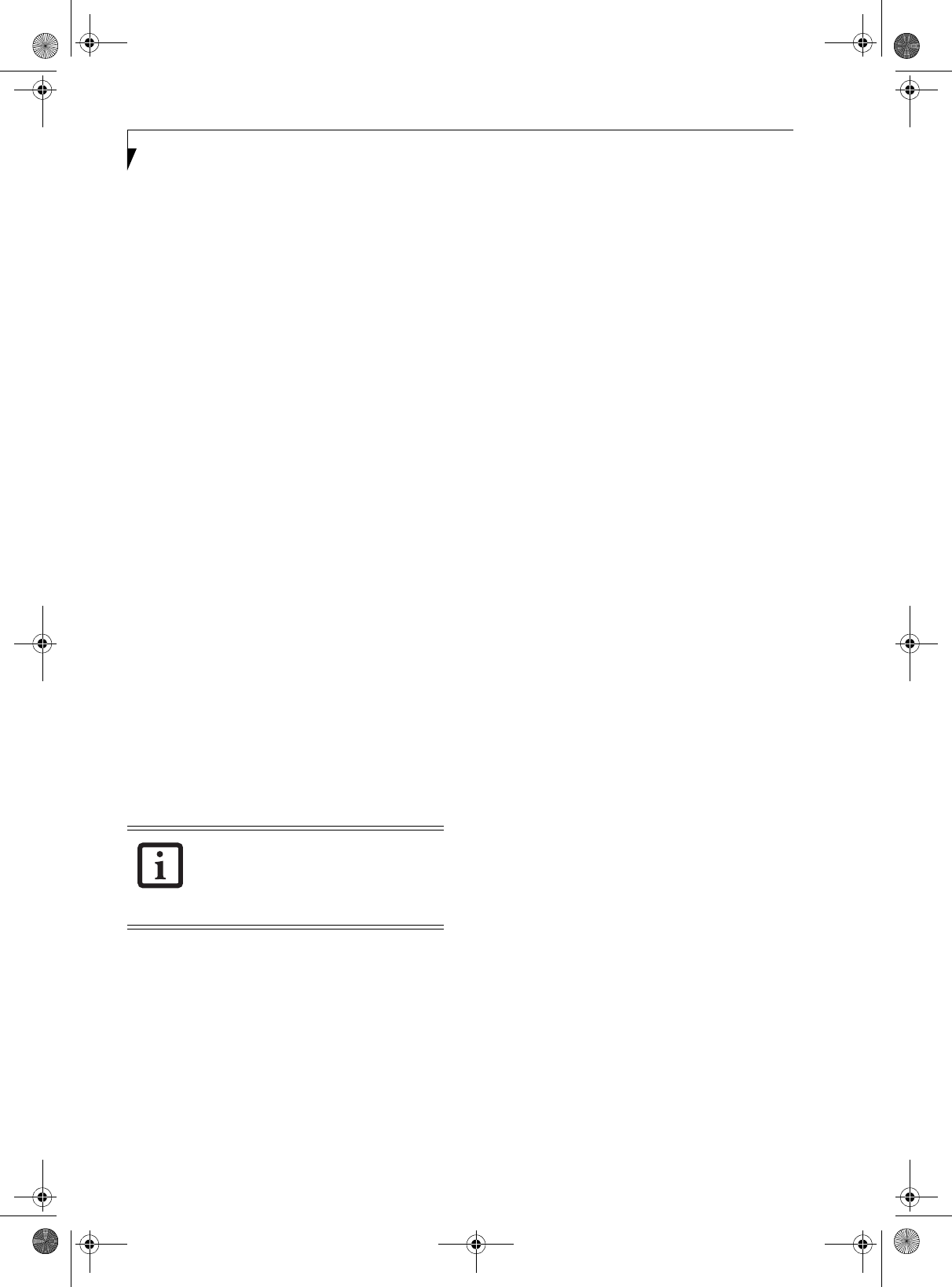
24
LifeBook T Series Tablet PC - Section Two
Low Battery Operations
If your Tablet PC has a low battery, pushing the suspend/
resume button only turns on the Security
Indicator. Your Tablet PC does not unlock, the Security
Indicator turns off after one minute. To resume normal
operation, first attach a power supply to the Tablet PC.
Then you may unlock the Tablet PC.
UNINSTALLING THE SECURITY
PANEL APPLICATION
You have two options when uninstalling the security
panel application:
■Remove passwords and uninstall the security panel
application software. This will disable all security
features.
■Uninstall the security panel application with password
still active. This will not allow any changes to the
password.
Uninstalling the Security Panel
Application Software
Remove passwords when User wants no password
protection whatsoever and doesn’t want to give anybody
the utility to set a password on their computer. In this
case, if passwords (supervisor, user, or both) are set, the
passwords must first be cleared BEFORE removing the
application. To clear passwords, follow same procedure
in SETTING PASSWORD CODES except this time,
select REMOVE, enter current password then click Next.
When asked to confirm select Ye s .
Removing Security Panel Application with
Passwords Still Active
Using this feature will not allow any changes to
the password.
User:
1. Go to Start -> Control Panel.
2. Open Add or Remove Programs Properties in the
Control Panel.
3. Select the Security Panel Application in the list, and
click Change/Remove.
4. When the Confirm File Deletion box appears,
click Ye s .
Supervisor:
1. Go to Start -> Control Panel.
2. Open Add or Remove Programs Properties in the
Control Panel.
3. Select the Security Panel Application for
Supervisor in the list, and click Change/Remove.
4. When the Confirm File Deletion box appears,
click Ye s .
Reinstalling the Security Panel Application
To reinstall supervisor or user security application, you
will need your Drivers and Applications CD. The
Utilities\Security Panel Application folder contains two
separate folders: Supervisor and User. The setup files for
supervisor and user security applications are contained
in those folders.
1. Go to the Utilities\Security Panel Applica-
tion\Supervisor folder on the CD and double-click
the setup.exe file. The Installing Security Panel
Application window will appear. Follow the instruc-
tions on the screen.
2. Go to the Utilities\Security Panel Application\User
folder on the CD and double-click the setup.exe file.
The Installing Security Panel Application window
will appear. Follow the instructions on the screen.
Supervisor and user passwords can be set via Windows
software using the FJSECS.exe and FJSECU.exe files,
respectively. FJSECU.exe for the user password cannot
run without first setting a supervisor password. You
need to run FJSECS.exe first to set the supervisor pass-
word. Follow instructions under Setting Passwords on
page 23.
If you forget both passwords, please contact Fujitsu PC
Corporation Service and Support at 1-800-8FUJITSU
(1-800-838-5487). Fujitsu PC Corporation charges a
service fee for unlocking a password-restricted Tablet
PC. When calling please have a valid credit card and
provide proof of ownership. You will then be given
instructions on where to ship your Tablet PC.
Removing the applications does not remove
the password. It simply removes the utility
to change/add/remove passwords. To
change your password you must reinstall
the application.
T Series.book Page 24 Thursday, July 31, 2003 10:49 AM
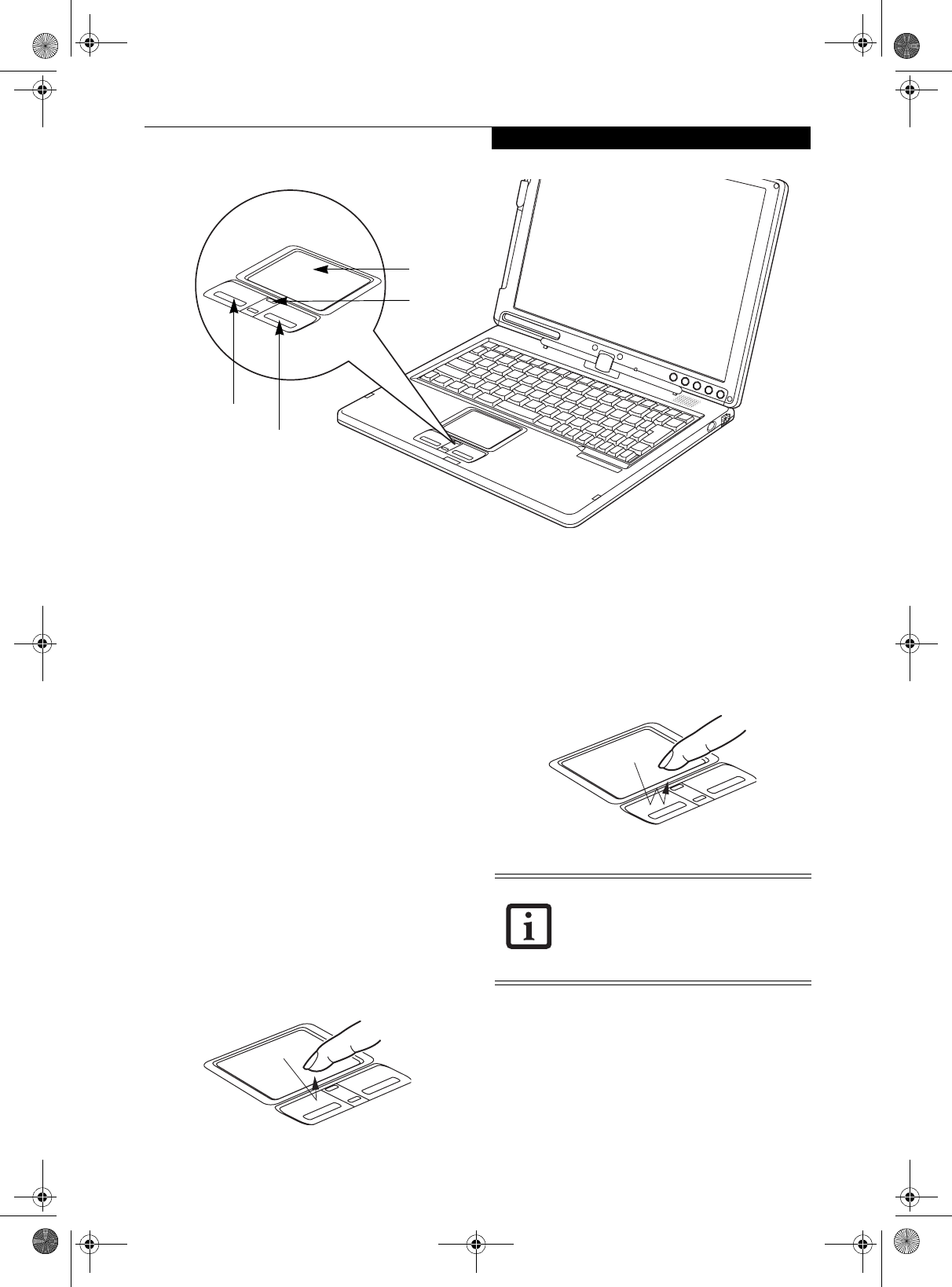
25
Getting to Know Your Tablet PC
Figure 2-19. Touchpad pointing device
Touchpad Pointing
Device
The Touchpad pointing device built into your Tablet PC
is used to control the movement of the cursor to select
items on your display panel. The Touchpad is composed
of a cursor control, left and right buttons, and a scroll
button. The cursor control works the same way a mouse
does, and moves the cursor around the display. It only
requires light pressure with the tip of your finger. The
left and right buttons function the same as left and right
mouse buttons. The scroll button allows you to navigate
through pages quickly without using the scroll bars. The
actual functionality of the buttons may vary depending
on the application that is being used. (Figure 2-19)
CLICKING
Clicking means pushing and releasing a button. To left-
click, move the cursor to the item you wish to select,
press the left button once, and then immediately release
it. To right-click, move the cursor to the item you wish
to select, press the right button once, and then immedi-
ately release it. (Figure 2-20)
Figure 2-20. Clicking
DOUBLE-CLICKING
Double-clicking means pushing and releasing the left
button twice in rapid succession. This procedure does
not function with the right button. To double-click,
move the cursor to the item you wish to select, press
and release the left button twice. (Figure 2-21)
Figure 2-21. Double-clicking
Left Button
Right Button
Scroll Button
Cursor Control
■If the interval between clicks is too long,
the double-click will not be executed.
■Parameters for the Touchpad can be
adjusted from the Mouse dialog box
located in the Windows Control Panel.
T Series.book Page 25 Thursday, July 31, 2003 10:49 AM
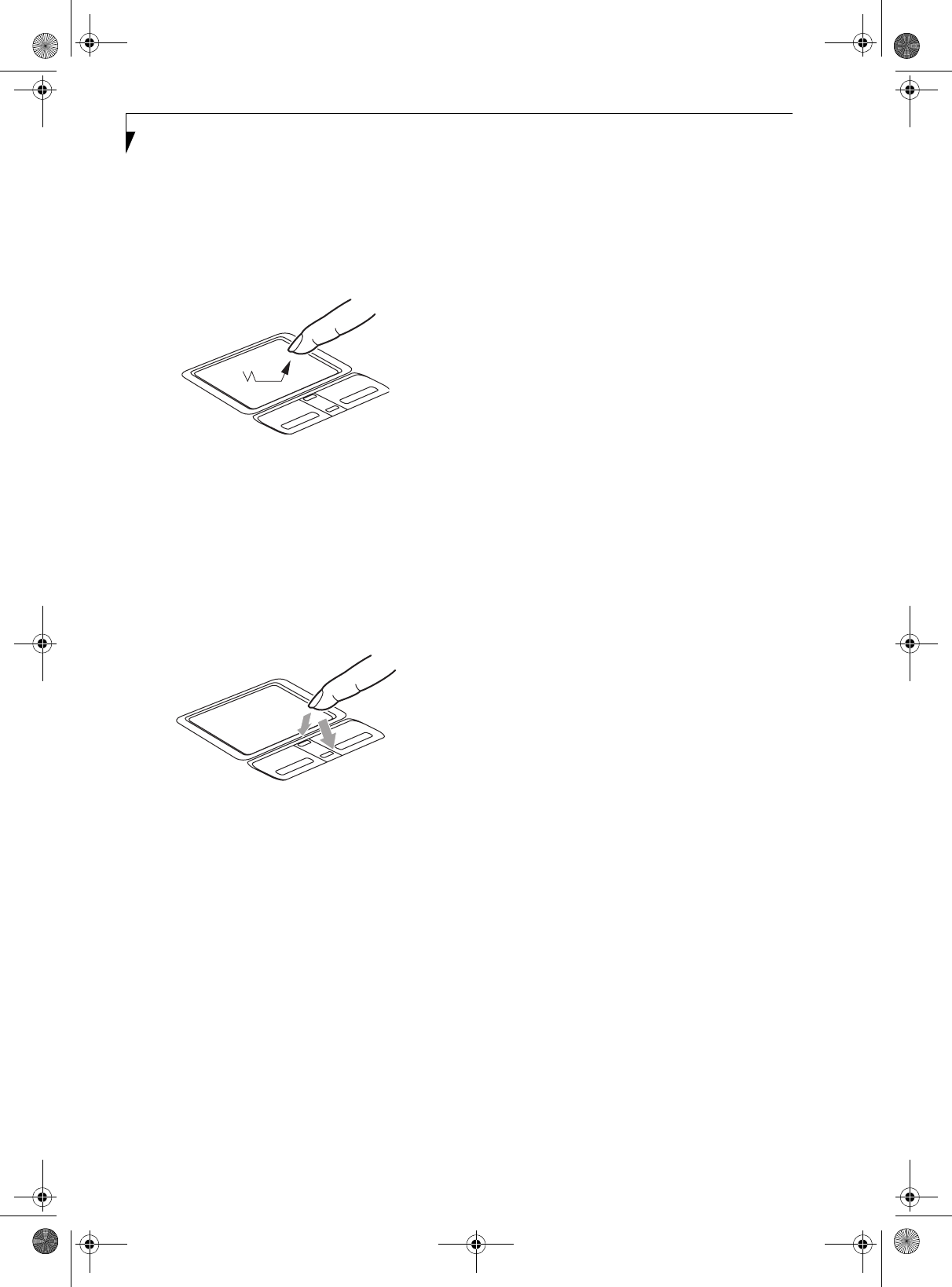
26
LifeBook T Series Tablet PC - Section Two
DRAGGING
Dragging means pressing and holding the left button
while moving the cursor. To drag, move the cursor to
the item you wish to move. Press and hold the left
button while moving the item to its new location
and then release it. (Figure 2-22)
Figure 2-22. Dragging
SCROLLING
Using the scroll button allows you to navigate through a
document quickly without having to use the scroll bars.
This is particularly useful when you are navigating
through online pages. To use the scroll button, press the
raised horizontal line at the top or bottom of the button
to scroll up or down a page. When you have reached the
desired section of the page, release the button.
(Figure 2-23)
Figure 2-23. Scrolling
TOUCHPAD CONTROL ADJUSTMENT
The Windows Control Panel allows you to customize
your Touchpad with selections made from within the
Mouse Properties dialog box. There are several aspects of
Touchpad operation, which you can adjust.
To access the Mouse Properties window, open the
Control Panel and double-click the Mouse icon. In the
window that appears, you will see a variety of different
mouse functions that you can change.
T Series.book Page 26 Thursday, July 31, 2003 10:49 AM
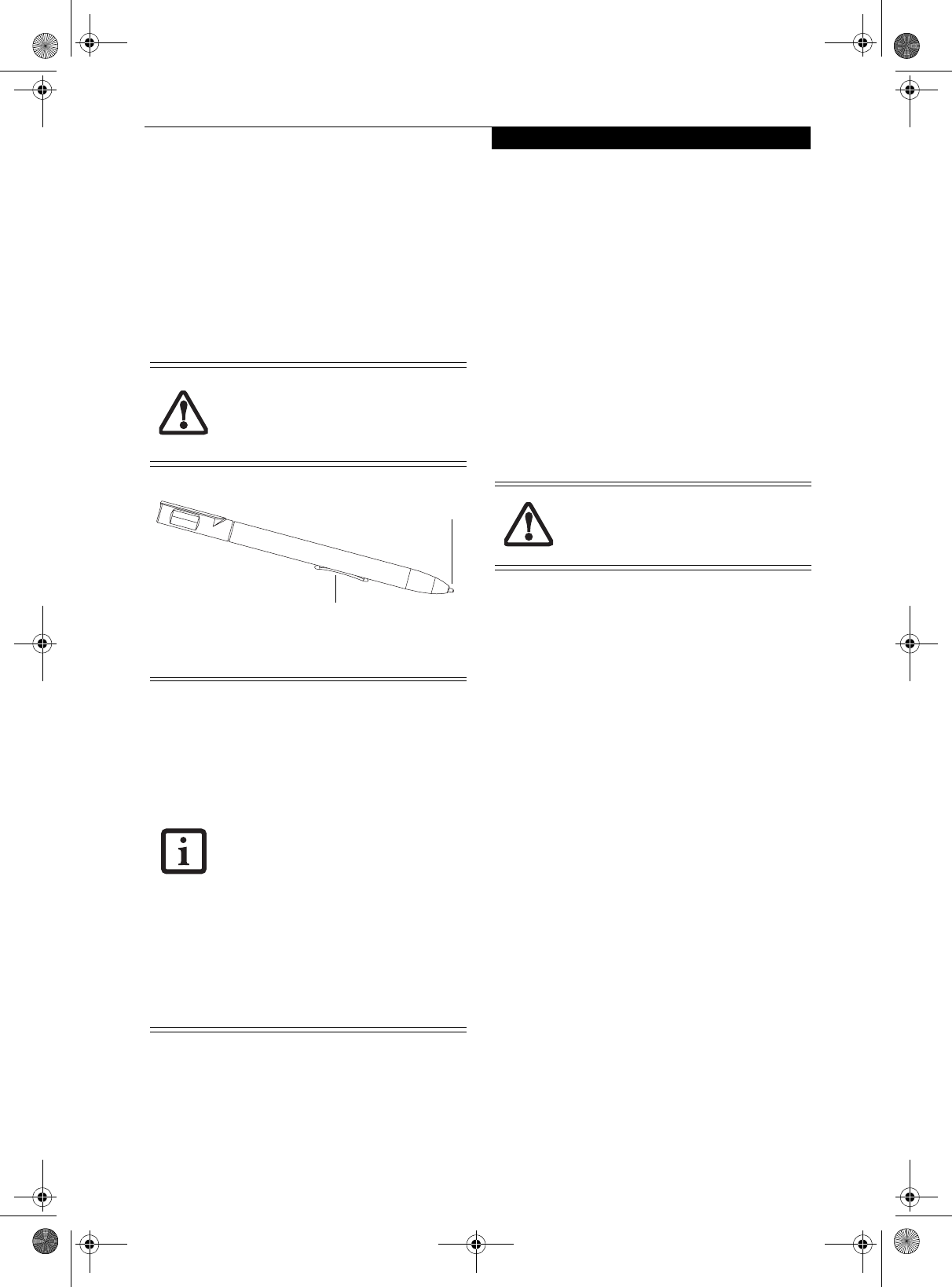
27
Getting to Know Your Tablet PC
Pen and Active Digitizer
USING THE PEN
You can use the LifeBook T Series Tablet PC pen to
generate and create electronic “ink”, to select items, and
to navigate through programs on the Tablet PC.
Programs that support handwriting recognition also
allow you to write characters directly on the screen with
the pen. You can also use the pen as a drawing tool.
Figure 2-24. LifeBook T Series Pen
The screen reacts when the pen tip is approximately 1/8
inch (3-5 mm) from the screen. The pen has three
switches: a tip switch and a barrel button toggle switch
with switches at both ends. By default, the tip switch
corresponds to the left mouse button, and the front
toggle (closest to the pen tip) barrel button switch corre-
sponds to the right mouse button (when used in combi-
nation with the tip switch). The rear toggle of the barrel
button switch acts as an electronic ink "eraser".
The functions of the rear toggle and the tip click pres-
sure can be changed by clicking [Start] -> Control Pane,
and double-clicking the Fujitsu Pen Settings icon.
To change the rear toggle function, select the drop-down
list to select a new function, then click [Apply]. If you
don’t want the rear toggle to have any function, select
Ignore from the list.
Adjusting the click pressure determines how much pres-
sure must be put on the pen tip in order for the screen to
react. The softer it is set, less pressure is required; the
harder it is set, more pressure is required. To change the
click pressure, use the slider bar to make the click pres-
sure harder or softer, then click [Apply].
Here are some hints that may help you use the pen more
effectively:
• To activate the tip switch, tap or hold the pen tip
against the screen.
• To activate the barrel button switch, press and hold
the end of the button you wish to use (front toggle is
the right mouse button switch; the rear toggle acts as
an electronic “eraser”).
• To move the cursor, hold the pen tip within 1/8 inch
(3 - 5 mm) from the screen and move the pen.
• To start a program, double-tap the pen tip (tap the
pen tip twice rapidly) on the program icon as you
would double-click a mouse.
•To select an object, tap the pen tip on the object
once.
•To double-click an object, quickly tap the object
twice.
CALIBRATING THE PEN
In order to ensure accurate tracking between the pen
and cursor, you must run the Touch Screen Calibration
Utility before you use the active digitizer for the first
time, or after you change the display resolution.
To run the calibration utility:
1. Go to Start -> Control Panel and double-click on
the Tabl et and Pen S ettin gs icon.
2. Click Calibrate.
3. Adjust the display of your Tablet PC to a comfort-
able angle.
You are advised to use a screen protector
on your system display to minimize the
chance of its being scratched. Screen
protectors are available from the Fujitsu
Web site at www.fujitsupc.com.
The LifeBook T Series Tablet PC pen is a
high-quality electronic instrument that can
be damaged if used improperly. Treat the
pen as you would any precision device.
Observe the following guidelines:
• Do not gesture with the pen, use it as a
pointer, or tap it on surfaces other than
the Tablet PC screen.
• Do not try to turn the thumb grip on
the pen; it is designed for inserting and
removing the pen from the pen holder.
• Never store the pen with the tip bearing
the weight of the pen (e.g., sitting tip
down in a pencil cup). Storing the pen
tip down could distort the internal
mechanism over a period of time
(especially in higher temperatures),
causing the tip to act as if it is always
depressed. The pen should be stored in
the pen holder when not in use.
Tip Switch
Barrel Switch
Use only the pen provided with your
Tablet PC. Do not use substitutes that
were not designed for the LifeBook T
Series Tablet PC.
T Series.book Page 27 Thursday, July 31, 2003 10:49 AM
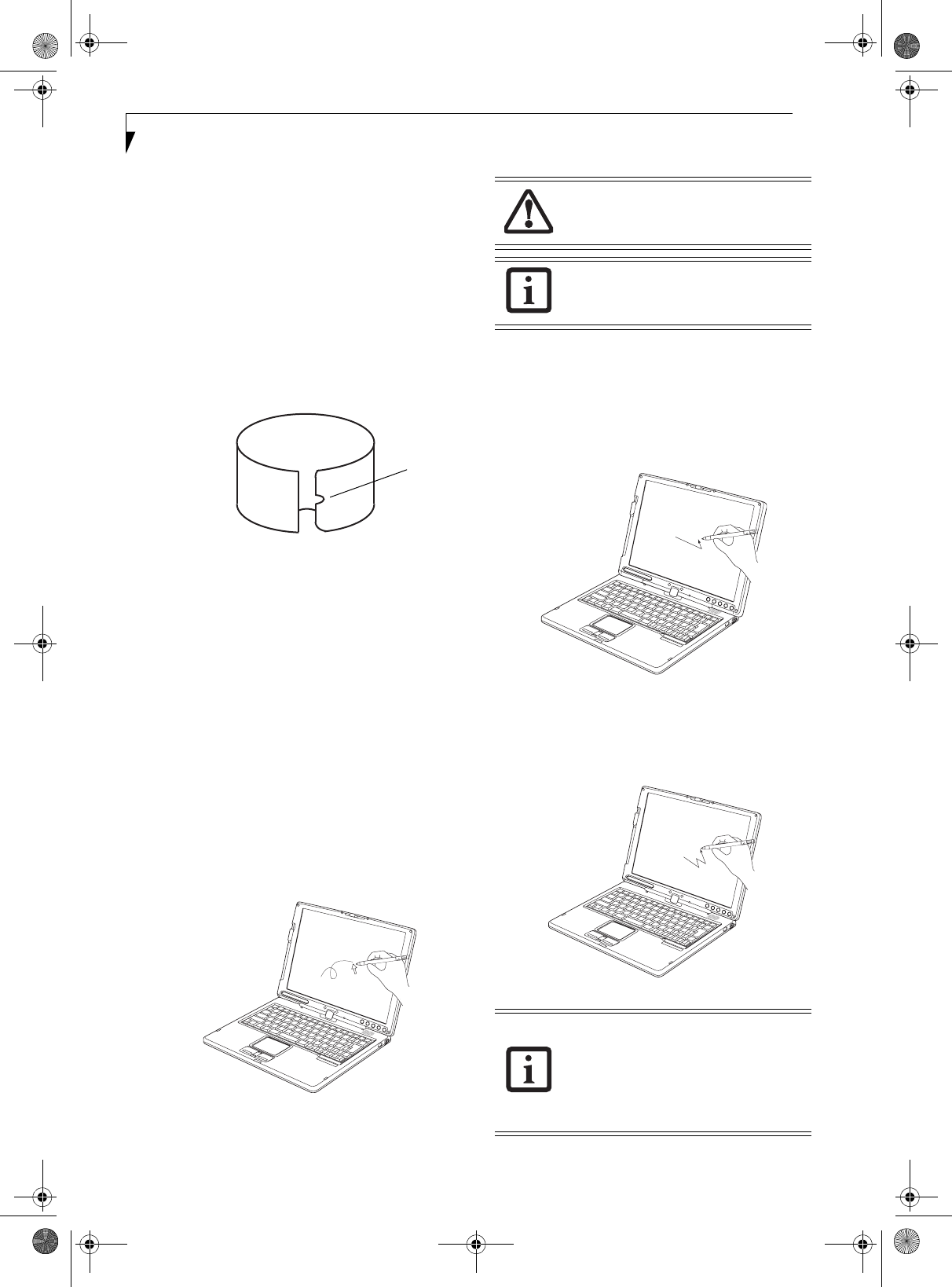
28
LifeBook T Series Tablet PC - Section Two
4. Using the pen, firmly touch the screen directly on
the (+) symbol; the (+) symbol will move to the
next location.
5. Repeat step 4 in the four corners, then click OK.
REPLACING THE PEN TIP
With use, the pen tip may become worn or may pick up
foreign particles that can scratch the screen. A damaged
or worn tip may not move freely, causing unpredictable
results when using the pen. If your pen exhibits these
problems, you should replace the pen tip. To do so, use
the pen tip removal tool included with your pen.
Figure 2-25. Tip Removal Tool
To remove the tip, position the tip in the gap between
the two ends of the tool (Figure 2-25). Pinch the tool
together so the tip is firmly clasped, then pull it from the
barrel. If the tip is worn or damaged, discard it.
To replace the tip, retrieve one of the new tips that
accompanied your pen. Insert the flat end of the tip into
the barrel and push it in firmly until it is seated.
If you need more tips, they can be ordered from the
Fujitsu Web site at: www.fujitsupc.com.
USING THE ACTIVE DIGITIZER
The integrated active digitizer allows you to use the
included pen as a pointing device. You can use the pen
to click, double-click, drag items and icons, or to draw
like a pen or pencil in applications that support this
behavior, such as drawing or painting programs. See the
documentation that came with your application for
details. (Figure 2-26)
Figure 2-26. Using the pen with the screen
Clicking
To left-click, touch the object you wish to select and then
lift the pen tip immediately. (Figure 2-27)
To right-click, press the front button on the barrel
switch or touch the pen to the screen for a couple of
seconds until the right mouse icon appears at the tip.
Figure 2-27. Clicking the screen
Double-Clicking
To double-click, touch the item twice, and then immedi-
ately remove the pen tip. (Figure 2-28)
Figure 2-28. Double-clicking the screen
Gap
To avoid potential scratching and damage,
never use anything but the included pen
with the display.
To purchase additional or replacement
pens, visit the Fujitsu accessories Web site
at: http://www.fujitsupc.com.
■If the interval between taps is too long,
the double-click will not be executed.
■Parameters for the screen can be
adjusted from the Mouse Properties dia-
log box located in the Windows Control
Panel.
T Series.book Page 28 Thursday, July 31, 2003 10:49 AM
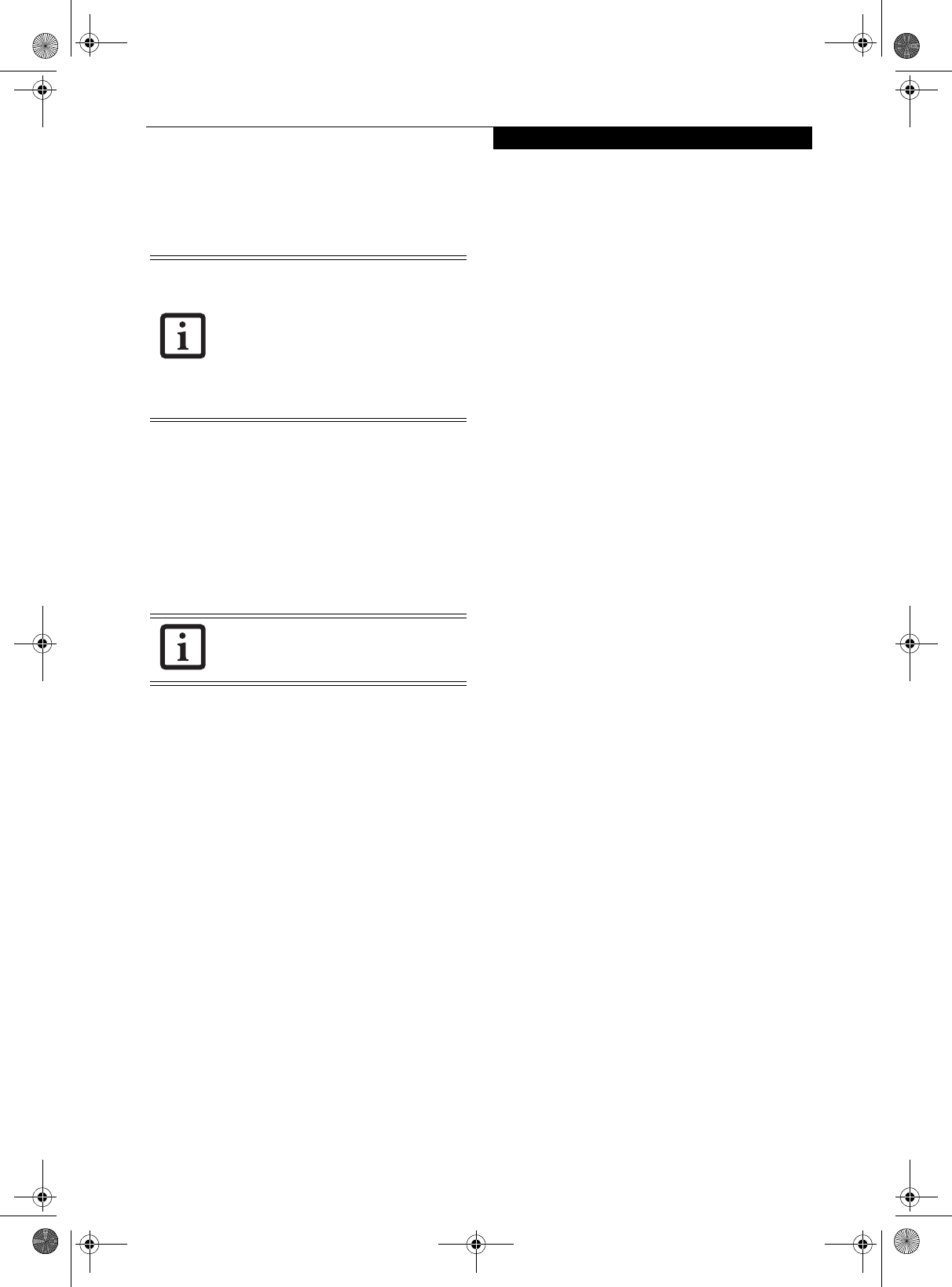
29
Getting to Know Your Tablet PC
Volume Control
Your Fujitsu Tablet PC has multiple volume controls
which interact with each other.
CONTROLLING THE VOLUME
The volume can be controlled in several different ways:
■Volume can be set from within the Volume Control on
the Taskbar.
■Volume can be controlled with the [F8] and [F9] func-
tions keys. Pressing [F8] repeatedly while holding [Fn]
will decrease the volume of your Tablet PC. Pressing
[F9] repeatedly while holding [Fn] will increase the
volume of your Tablet PC.
■Volume can be controlled by many volume controls
that are set within individual applications.
■Certain external audio devices you might connect to
your system may have hardware volume controls.
■Each source discussed above puts an upper limit on
the volume level that must then be followed by the
other sources.
We recommend that you experiment with the various
volume controls to discover the optimal sound level.
Any software that contains audio files will
also contain a volume control of its own. If
you install an external audio device that has
an independent volume control, the
hardware volume control and the software
volume control will interact with each other.
It should be noted that if you set your
software volume to Off, you will override
the external volume control setting.
There are twenty-six levels through which
the function keys cycle.
T Series.book Page 29 Thursday, July 31, 2003 10:49 AM
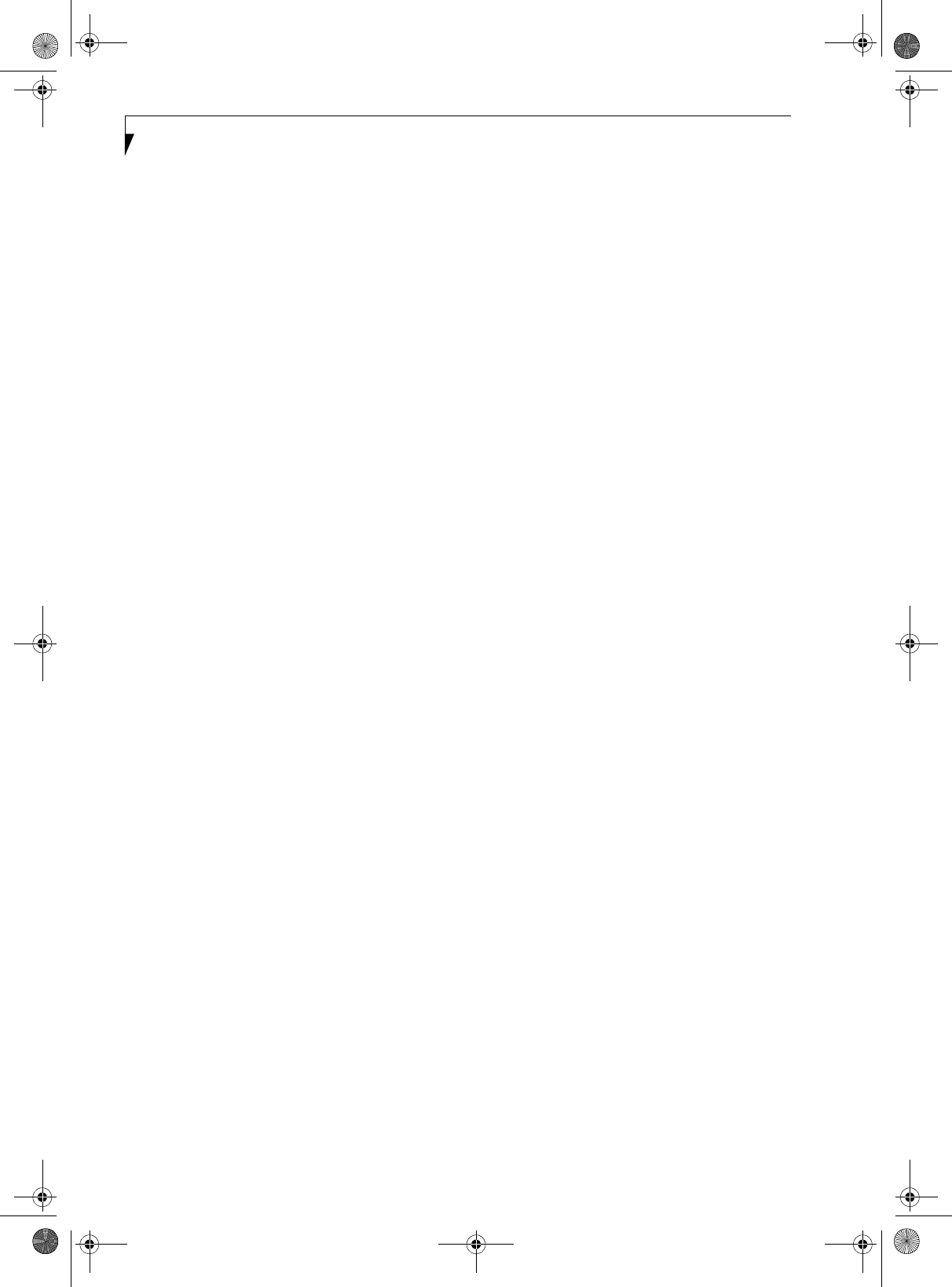
30
LifeBook T Series Tablet PC - Section Two
T Series.book Page 30 Thursday, July 31, 2003 10:49 AM

31
3
Using Your Tablet PC
T Series.book Page 31 Thursday, July 31, 2003 10:49 AM
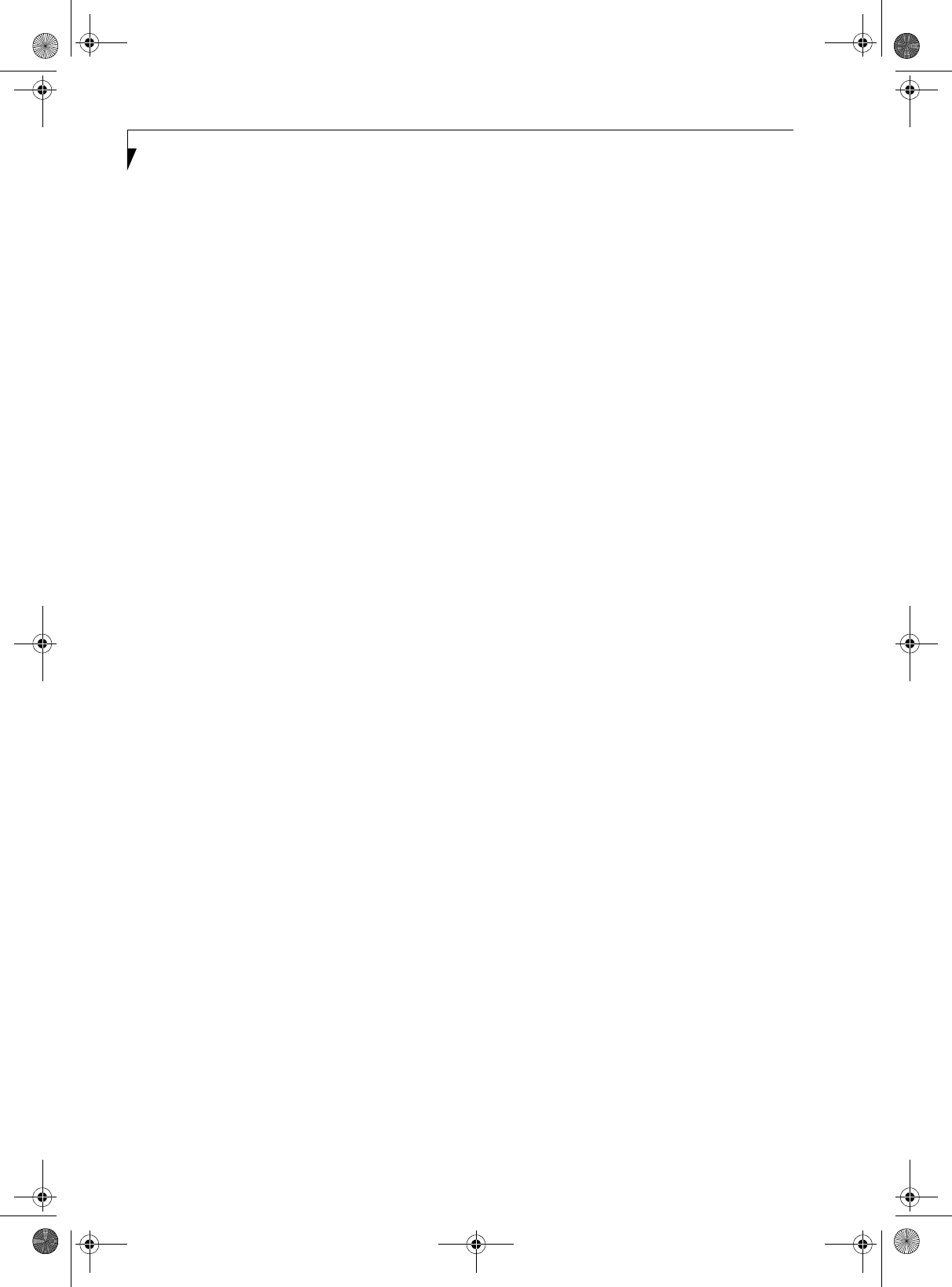
32
LifeBook T Series Tablet PC - Section Three
T Series.book Page 32 Thursday, July 31, 2003 10:49 AM
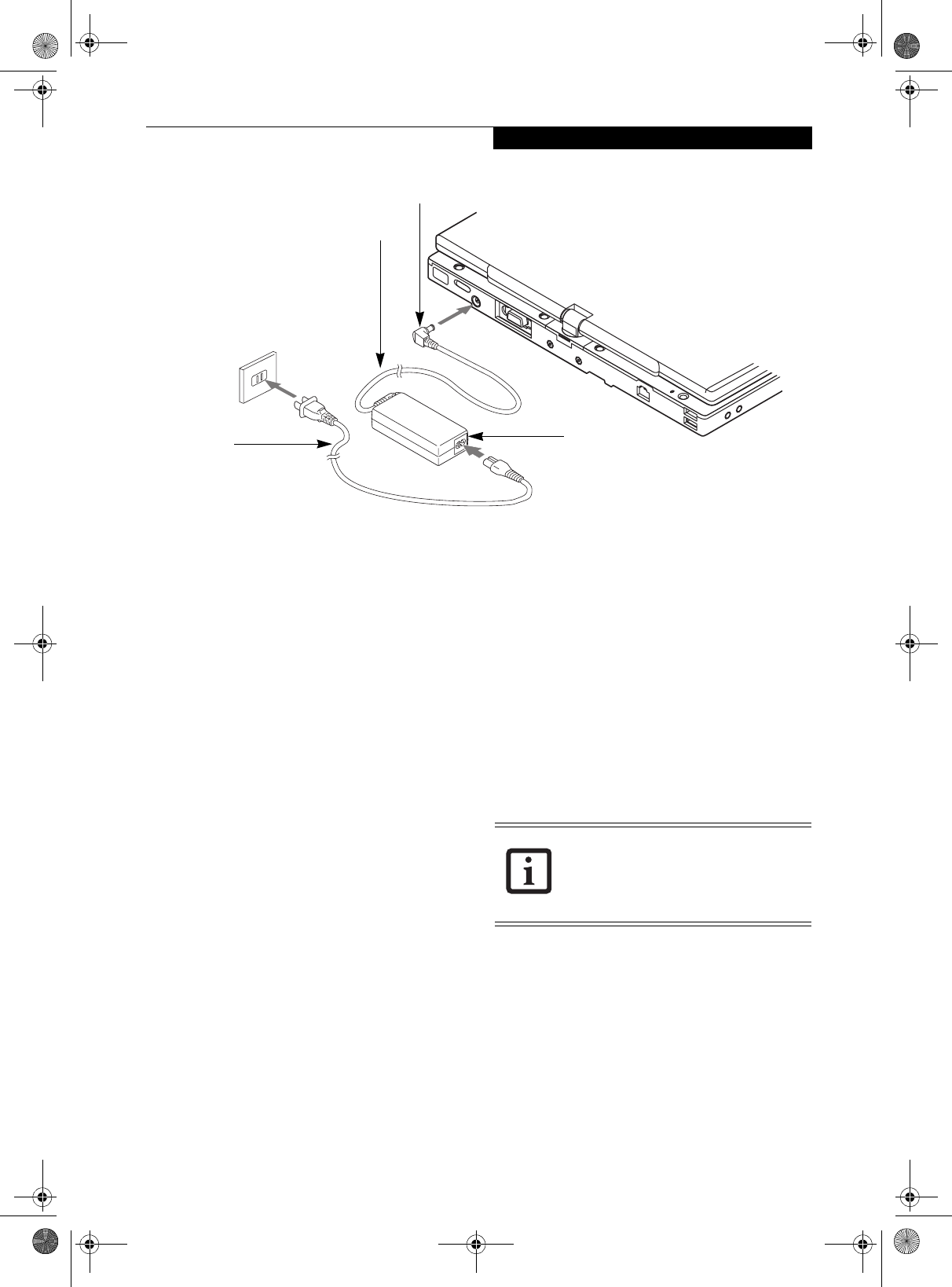
33
Getting Started
Figure 3-1. Connecting the AC Adapter
Power Sources
Your LifeBook T Series Tablet PC has three possible
power sources: a primary Lithium ion battery, an AC
adapter or an optional Auto/Airline adapter.
CONNECTING THE POWER ADAPTERS
The AC adapter or optional Auto/Airline adapter
provides power for operating your Tablet PC and
charging the battery.
Connecting the AC Adapter
1. Plug the DC output cable into the DC power jack
of your Tablet PC.
2. Plug the AC adapter into an AC electrical outlet.
(Figure 3-1)
Connecting the Optional Auto/Airline Adapter
1. Plug the DC output cable into the DC power jack
on your Tablet PC.
2. Plug the Auto/Airline adapter into the cigarette
lighter of an automobile with the ignition key in
the On or Accessories position.
OR
3. Plug the Auto/Airline adapter into the DC power
jack on an airplane seat.
Switching from AC Adapter Power or the
Auto/Airline Adapter to Battery Power
1. Be sure that you have a charged battery installed.
2. Remove the AC adapter or the Auto/Airline adapter.
DC Power Plug
DC Output Cable
AC Adapter
AC Cable
The Lithium ion battery is not charged
upon purchase. Initially, you will need to
connect either the AC adapter or the
Auto/Airline adapter to use your Tablet
PC.
T Series.book Page 33 Thursday, July 31, 2003 10:49 AM
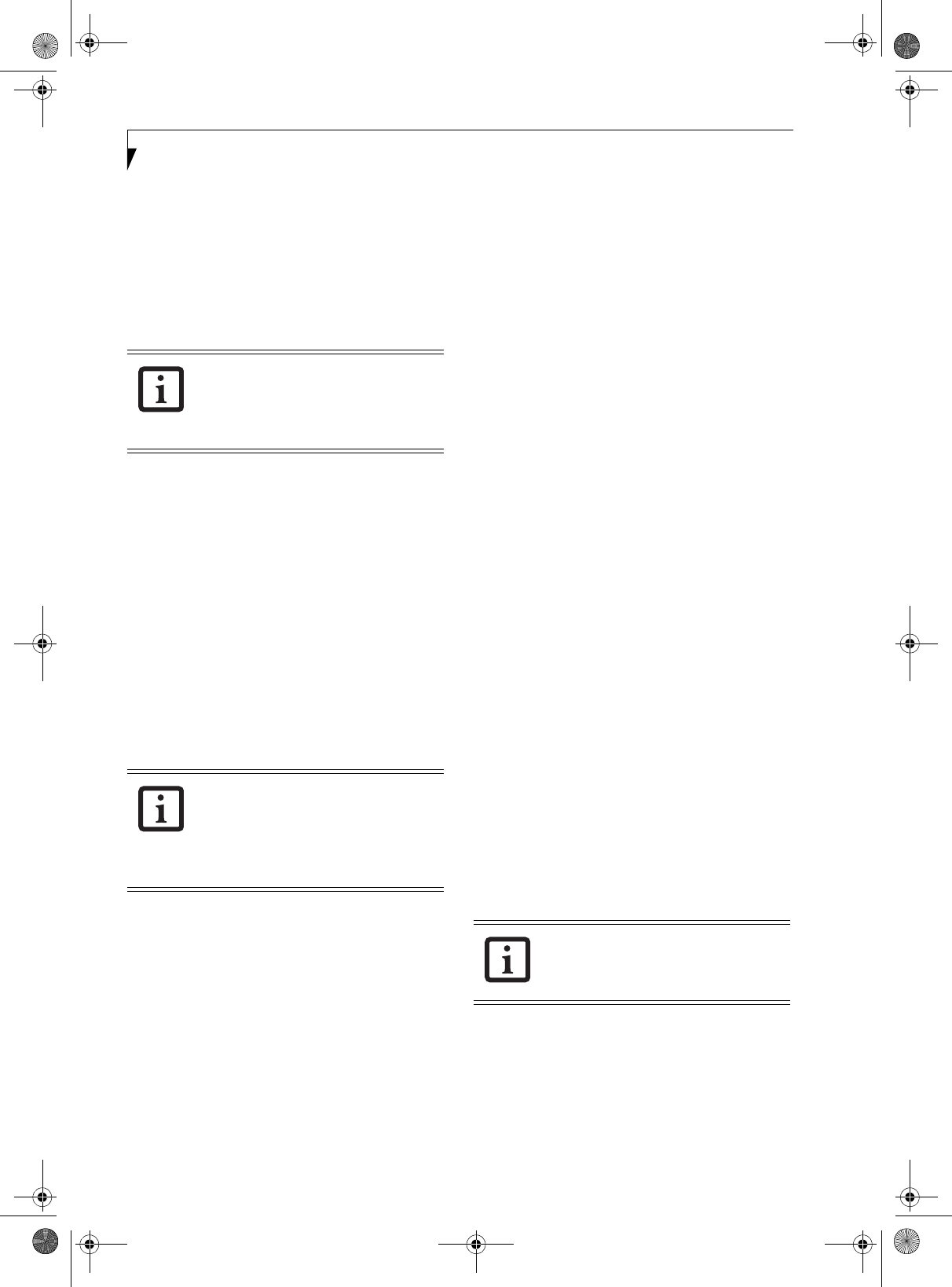
34
LifeBook T Series Tablet PC - Section Three
Starting Your Tablet PC
POWER ON
The Suspend/Resume button is used to turn on your
LifeBook T Series Tablet PC from its off state. Once you
have connected your AC adapter or charged the internal
Lithium ion battery, you can power on your Tablet PC.
(See figure 2-6 on page 12 for location)
Press the Suspend/Resume button to start your system.
When you are done working you can either leave your
Tablet PC in Standby mode, See “Standby Mode” on
page 36, or you can turn it off. See “Power Off” on
page 38
When you Power On your Tablet PC, it will perform a
Power On Self Test (POST) to check the internal parts
and configuration for correct functionality. If a fault is
found, your Tablet PC will emit an audio warning and/
or an error message will be displayed. See “Power On
Self Test Messages” on page 61 Depending on the nature
of the problem, you may be able to continue by starting
the operating system or by entering the BIOS setup
utility and revising the settings.
After satisfactory completion of the Power On Self Test
(POST), your Tablet PC will load your operating system.
BOOT SEQUENCE
The procedure for starting-up your Tablet PC is termed
the Bootup sequence and involves your Tablet PC’s
BIOS. When your Tablet PC is first turned on, the main
system memory is empty, and it needs to find instruc-
tions to start up your Tablet PC. This information is in
the BIOS program. Each time you power up or restart
your Tablet PC, it goes through a boot sequence which
displays a Fujitsu logo until your operating system is
loaded. During booting, your Tablet PC is performing a
standard boot sequence including a Power On Self Test
(POST). When the boot sequence is completed without
a failure and without a request for the BIOS Setup
Utility, the system displays the operating system’s
opening screen.
The boot sequence is executed when:
■You turn on the power to your Tablet PC.
■You restart your Tablet PC from the Windows
Shut Down dialog box.
■The software initiates a system restart. Example:
When you install a new application.
BIOS SETUP UTILITY
The BIOS Setup Utility is a program that sets up the
operating environment for your Tablet PC. Your BIOS
is set at the factory for normal operating conditions,
therefore there is no need to set or change the BIOS’
environment to operate your Tablet PC.
The BIOS Setup Utility configures:
■Device control feature parameters, such as changing
I/O addresses and boot devices.
■System Data Security feature parameters, such
as passwords.
Entering the BIOS Setup Utility
To enter the BIOS Setup Utility do the following:
1. Turn on or restart your Tablet PC.
2. Press the [F2] key once the Fujitsu logo appears
on the screen. This will open the main menu
of the BIOS Setup Utility with the current
settings displayed.
3. Press the [RIGHT ARROW] or [LEFT ARROW] key
to scroll through the other setup menus to review or
alter the current settings.
BIOS Guide
A guide to your Tablet PC’s BIOS is available online.
Please visit our service and support Web site at
www.fujitsupc.com. Once there, select Support, then
select Tablet PCs under User’s Guides. Select LifeBook
Tablet PC BIOS Guides from the pull-down menu for
your Tablet PC series. If you are unsure of your Tablet
PC’s BIOS number, refer to your packing slip.
BOOTING THE SYSTEM
We strongly recommend that you not attach any external
devices until you have gone through the initial power-on
sequence.
When you turn on your LifeBook T Series Tablet PC for
the first time, it will display a Fujitsu logo on the screen.
When you turn on your Tablet PC be sure
you have a power source. This means that
a battery is installed and charged, or that
the AC or Auto/Airline adapter is
connected and has power.
Never turn off your Tablet PC during the
Power On Self Test (POST) or it will cause
an error message to be displayed when
you turn your Tablet PC on the next time.
See “Power On Self Test Messages” on
page 61
If your data security settings require it, you
may be asked for a password before the
BIOS main menu will appear.
T Series.book Page 34 Thursday, July 31, 2003 10:49 AM
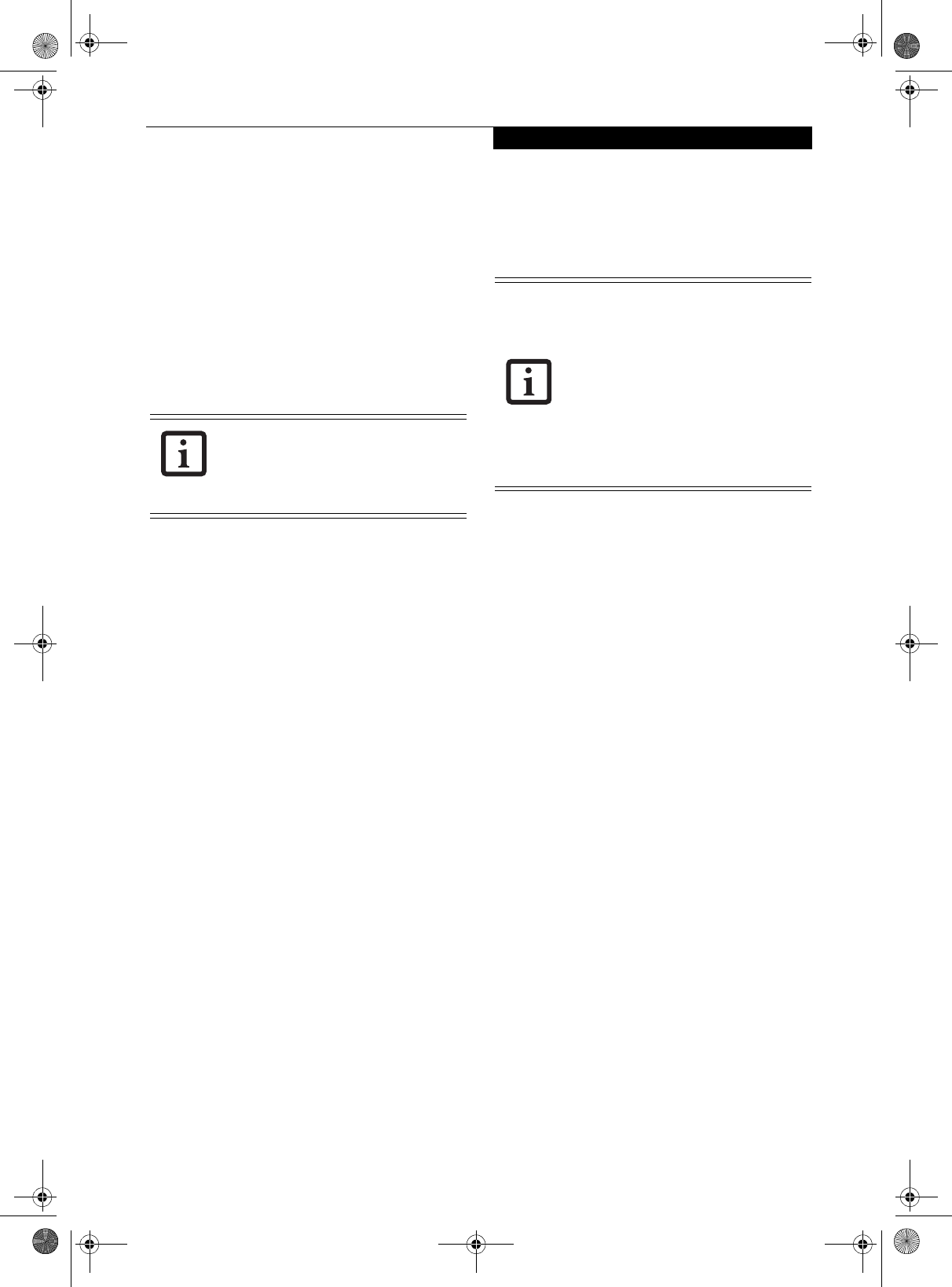
35
Getting Started
If you do nothing the system will load the operating
system, and then the Windows Welcome will begin.
Designed to accommodate the needs of many users, in
many different countries, Windows needs to be config-
ured the first time you use them. Windows has two
parts:
■Getting Started: You have the opportunity to set up
your modem so that your Tablet PC will be prepared
to dial out.
■Windows License Agreement and Final Settings:
You have the opportunity to review the Windows
License Agreement.
Getting Started
Read the instructions on the screens carefully and fill in
the information as directed. You will be asked for such
items as the language you wish to use, the country in
which you live, your first and last name, and about how
you dial out from where you will be using your Tablet
PC. For the modem settings, enter your current location
information where you will be using your Tablet PC. If
you are not connected to a phone line and plan to
register at a later time, you may click the Skip button,
and you will go directly to the condition of use page.
Once you have set up your Tablet PC to dial out,
Windows will make a free telephone call to test the
settings. If the call is unsuccessful, you will be returned
to the phone settings page where you may try to fix
them. If you are unable to fix the settings please contact
Fujitsu Service and Support. See “FPC Contact Informa-
tion” on page 3 If you would simply like to move on, and
register at a later time, you may click the Skip button,
and you will go directly to the Condition of Use page.
Registration
If your connection is successful, you will go to the
Registration Confirmation page. On this page simply
enter the requested information, and then check the box
at the bottom to register your copy of Windows with
Microsoft. Once you have finished, click the Next button
to continue.
Final Settings
The first part of your final settings is the Windows End
User License Agreement. Read the agreement carefully.
When you finish reading you must accept or reject the
terms of the agreement and then click on the Next button.
ACTIVATING ADDITIONAL UTILITIES
The first time you boot up your system, you will see a
Click Me! icon on the system desktop.
When you double-click the Click Me! icon, your system
will automatically add appropriate utilities based on
your system’s configuration.
The ClickMe! icon disappears after it has been run the
first time.
REGISTERING YOUR LIFEBOOK T SERIES
TABLET PC
What are the benefits of registering?
You will receive an identification label for your Tablet
PC, which, if your Tablet PC is ever lost, may help in
getting it returned to you. You will also receive technical
support access and useful product mailings.
How do I register?
To register your system, visit our Web site at:
www.fujitsupc.com/support.
You may click Cancel at any time within
this process to shut down Windows. You
may restart this process at any time in the
future, but you must complete it in order
to use your computer.
■If you reject the terms of the license
agreement you will be asked to review
the license agreement for information
on returning Windows or to shut down
your Tablet PC.
■You cannot use your Tablet PC until you
have accepted the License Agreement.
If you stop the process, your Tablet PC
will return to the beginning of the
Windows Welcome Process, even if you
power down your system and start it up
again.
T Series.book Page 35 Thursday, July 31, 2003 10:49 AM
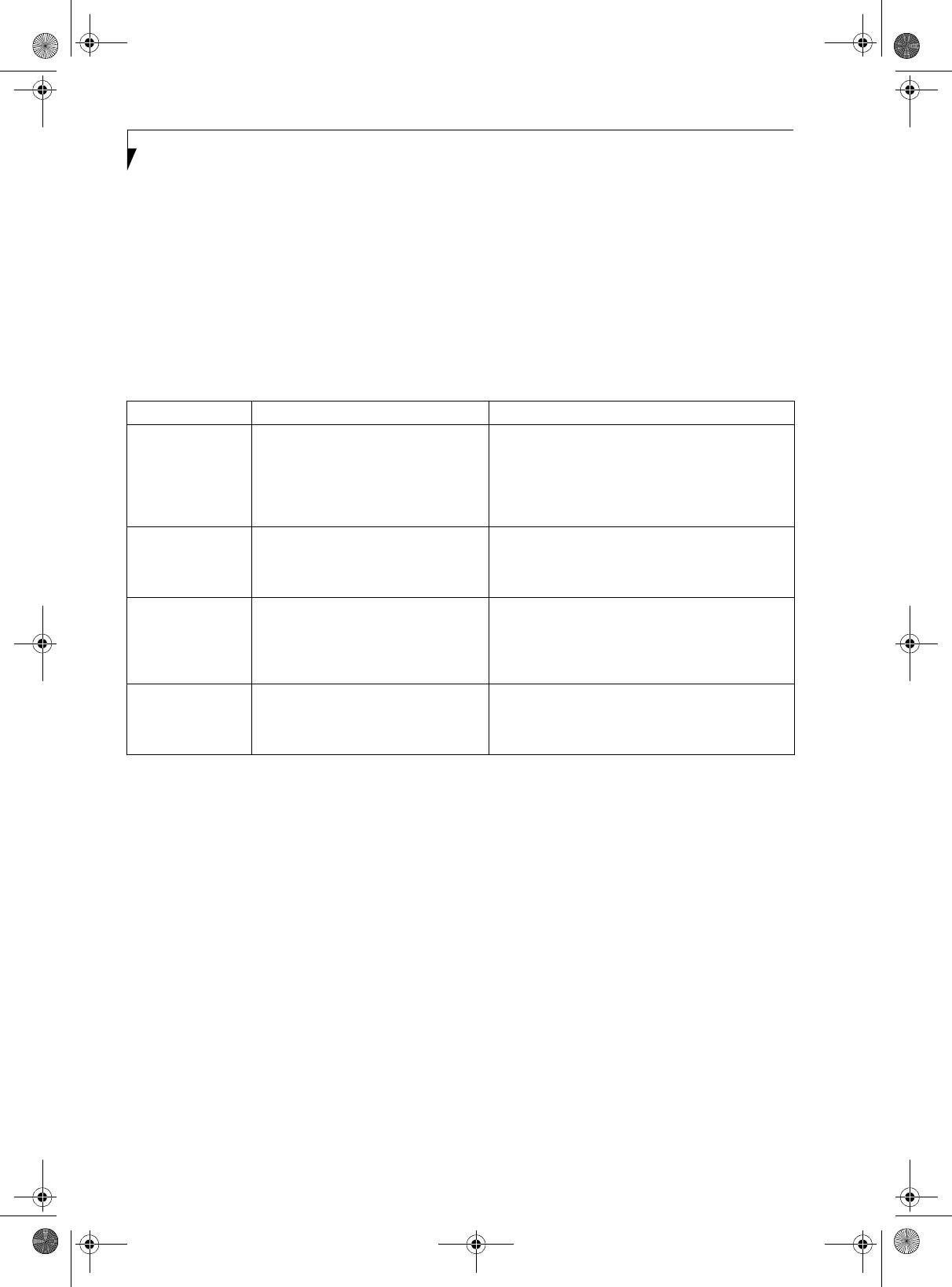
36
LifeBook T Series Tablet PC - Section Three
Power Management
Your LifeBook T Series Tablet PC has many options and
features for conserving battery power. Some of these
features are automatic and need no user intervention,
such as those for the internal modem. However, others
depend on the parameters you set to best suit your oper-
ating conditions, such as those for the display bright-
ness. Internal power management for your Tablet PC
may be controlled from settings made in your operating
system, pre-bundled power management application, or
from settings made in BIOS setup utility.
Besides the options available for conserving battery
power, there are also some things that you can do to
prevent your Tablet PC battery from running down as
quickly. For example, you can create an appropriate
power saving profile, put your Tablet PC into Standby
mode when it is not performing an operation, and you
can limit the use of high power devices. As with all
mobile, battery powered computers, there is a trade-off
between performance and power savings.
Table 3-1. System Power States
SUSPEND/RESUME BUTTON
When your Tablet PC is active, the Suspend/Resume
button can be used to manually put your Tablet PC into
Standby mode. Push the Suspend/Resume button when
your Tablet PC is active, but not actively accessing
anything, and immediately release the button. You will
hear two short beeps and your system will enter Standby
mode. (See figure 2-6 on page 12 for location).
If your Tablet PC is suspended, pushing the Suspend/
Resume button will return your Tablet PC to active
operation. You can tell whether or not your system is in
Standby mode by looking at the Power indicator. See
“Power Indicator” on page 15. If the indicator is visible
and not flashing, your Tablet PC is fully operational. If
the indicator is both visible and flashing, your Tablet PC
is in Standby mode. If the indicator is not visible at all,
the power is off or your Tablet PC is in Hibernate mode
(See Hibernate Mode)
STANDBY MODE
Standby mode in Windows saves the contents of your
Tablet PC’s system memory during periods of inactivity
by maintaining power to critical parts. This mode will
turn off the CPU, the display, the hard drive, and all of
the other internal components except those necessary to
maintain system memory and allow for restarting. Your
Tablet PC can be put in Standby mode by:
■Pressing the Suspend/Resume button when your
system is turned on.
■Selecting Standby from the Windows Shut Down
menu.
■Timing out from lack of activity.
■Allowing the battery to reach the Dead Battery
Warning condition.
■Closing the system cover.
Your Tablet PC’s system memory typically stores the
file(s) on which you are working, open application(s)
information, and any other data required to support the
operation(s) in progress. When you resume operation
Power Mode System Activity Events causing system to enter mode state
Fully On Mode System is running. CPU, system bus, and
all other interfaces operate at full speed.
■From Standby mode: System operation resumed
(Suspend/Resume button pressed, resume on
modem ring, resume on time).
■From Hibernation mode: Suspend/Resume button
pressed.
■From Off mode: Suspend/Resume button pressed.
Standby Mode
(Suspend-to-RAM)
Resume system logic remains powered
and RAM remains powered to maintain
active data. All other devices are turned
off.
■Standby timeout occurs.
■Suspend request issued by software or by pressing
the Suspend/Resume button.
■Low battery.
Hibernation Mode
(Suspend-to-Disk)
Windows saves desktop state (including
open files and documents) to hard disk.
CPU stops. All other devices are turned
off.
■Suspend timeout occurs.
■Clicking Start -> Shut Down -> Hibernate
(It may be necessary to Enable Hibernate Support
from Windows Power Options.)
■Low battery condition
Power Off System is fully powered off except for
logic components required for Suspend/
Resume button and real-time clock
operation.
■System shutdown.
■Low battery condition
T Series.book Page 36 Thursday, July 31, 2003 10:49 AM
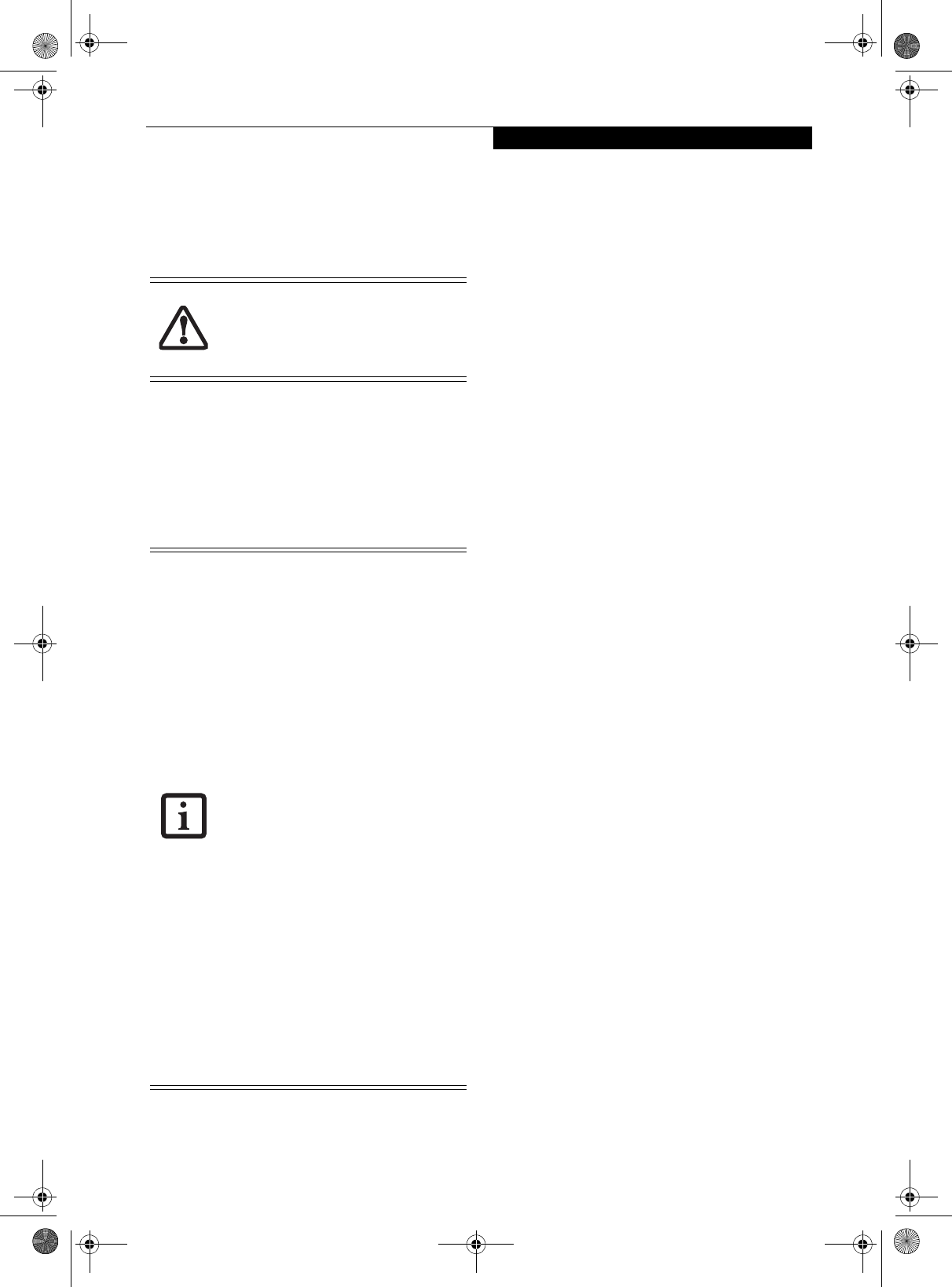
37
Getting Started
from Standby mode, your Tablet PC will return to the
point where it left off. To resume operation, you must
use the Suspend/Resume button to resume operation,
and there must be an adequate power source available,
or your Tablet PC will not resume.
HIBERNATE MODE
The Hibernate mode saves the contents of your
Tablet PC’s system memory to the hard drive as a part of
the Suspend/Resume mode. Your Tablet PC is pre-
configured to perform this function. The Hibernate
mode can also be configured through the system BIOS
to run in other ways depending on what you need to
accomplish. See “BIOS Setup Utility” on page 34.
Using Hibernate Mode
Hibernate default setting is enabled for Windows XP.
To enable or disable the Hibernation feature follow
these easy steps:
1. From the Start menu, select Settings, and then select
Control Panel -> Power Options.
2. Select Hibernation, and then select the box to
enable or disable this feature.
To use Hibernate mode with Windows XP systems:
1. Click on the Start button, click Shut Down.
2. Select Hibernate option from the “What do you
want the computer to do” list.
DISPLAY TIMEOUT
The Video Timeout is one of the power management
parameters. This feature saves power by turning off the
display if there is no keyboard or pointer activity for the
user selected timeout period. Any keyboard or pointer
activity will cause the display to restart automatically.
This feature is independent of the Suspend/Resume
button and can be enabled and disabled in Windows
Power Management.
HARD DISK TIMEOUT
The Hard Disk Timeout is another one of the power
management parameters. This feature saves power by
turning off the hard drive if there is no hard drive
activity for the user selected timeout period. Any
attempt to access the hard drive will cause it to restart
automatically. This feature is independent of the
Suspend/Resume button and can be enabled and
disabled in Windows.
WINDOWS POWER MANAGEMENT
The Power Options icon located in the Windows
Control Panel allows you to configure some of the power
management settings. For example, you can use the
Power Options to set the timeout values for turning off
the display and hard disks whether you are running the
Tablet PC on battery power or one of the adapters.
RESTARTING THE SYSTEM
If your system is on and you need to restart it, be sure
that you use the following procedure.
1. Click the Start button, and then click Shut Down.
2. Select the Restart option from within the Windows
Shut Down dialog box.
3. Click OK. Your Tablet PC will shut down and
reboot.
If you are running your Tablet PC on
battery power, be aware that the battery
continues to discharge while your Tablet
PC is in Standby mode, though not as fast
as when fully operational.
■Standby or Hibernate modes should not
be used with certain PC Cards. Check
your PC Card documentation for more
information.
■Disabling the Suspend/Resume button
prevents it from being used to put your
Tablet PC in Standby or Hibernate
mode. The resume function of the
button cannot be disabled.
■If your Tablet PC is actively accessing
information when you enter Standby or
Hibernate mode, changes to open files
are not lost. The files are left open and
memory is kept active during Standby
mode or the memory is transferred to
the hard drive during Hibernate mode.
■When PC Cards or external devices are
in use, Save-to-Disk mode cannot return
to the exact state prior to suspension,
because all peripheral devices will be re-
initialized when the system restarts.
■The main advantage of using Hibernate
mode is that power is not required to
maintain your data. This is very impor-
tant if you will be leaving your Tablet PC
in a suspended state for a prolonged
period of time. The drawback of using
Hibernate mode is that it lengthens the
power down and power up sequences
and resets peripheral devices.
T Series.book Page 37 Thursday, July 31, 2003 10:49 AM
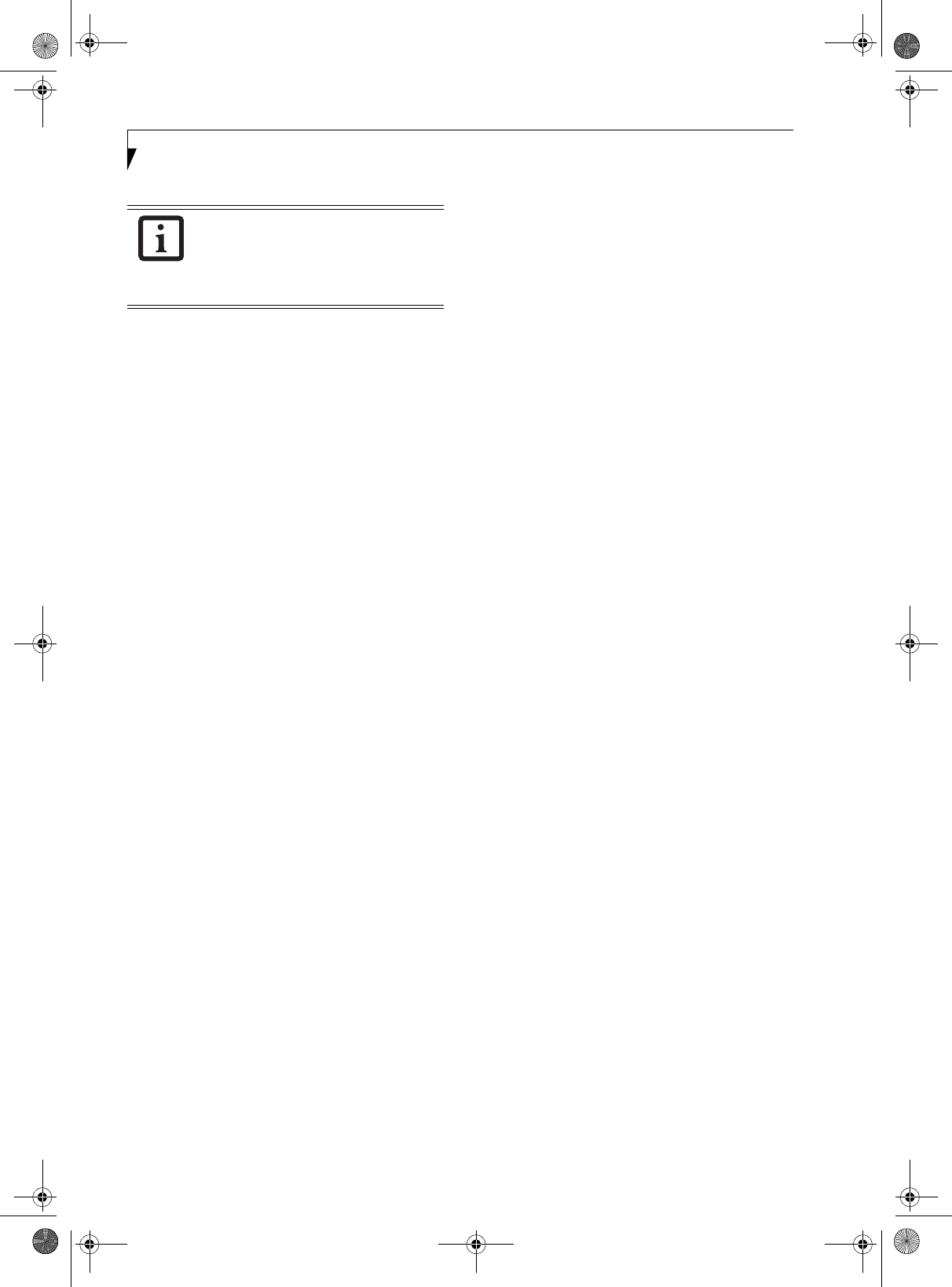
38
LifeBook T Series Tablet PC - Section Three
POWER OFF
Before turning off the power by choosing Shut Down
from the Windows Start menu, check that the Hard
Drive, CD-ROM, PC Card and the Floppy Disk Drive
Access indicators are all Off. (See Figure 2-9 on page 15)
If you turn off the power while accessing a disk or PC
Card there is a risk of data loss. To assure that your
Tablet PC shuts down without error, use the Windows
shut down procedure.
Using the correct procedure to shut down from
Windows, allows your Tablet PC to complete its opera-
tions and turn off power in the proper sequence to avoid
errors. The proper sequence is:
1. Click the Start button, and then click Shut Down.
2. Select the Shut Down option from within the
Windows Shut Down dialog box.
3. Click OK.
If you are going to store your Tablet PC for a month or
more see the Care and Maintenance section.
Turning off your Tablet PC without exiting
Windows or turning on your Tablet PC
within 10 seconds of the Tablet PC being
shut off may cause an error when you start
the next time.
T Series.book Page 38 Thursday, July 31, 2003 10:49 AM

39
4
User-Installable
Features
T Series.book Page 39 Thursday, July 31, 2003 10:49 AM
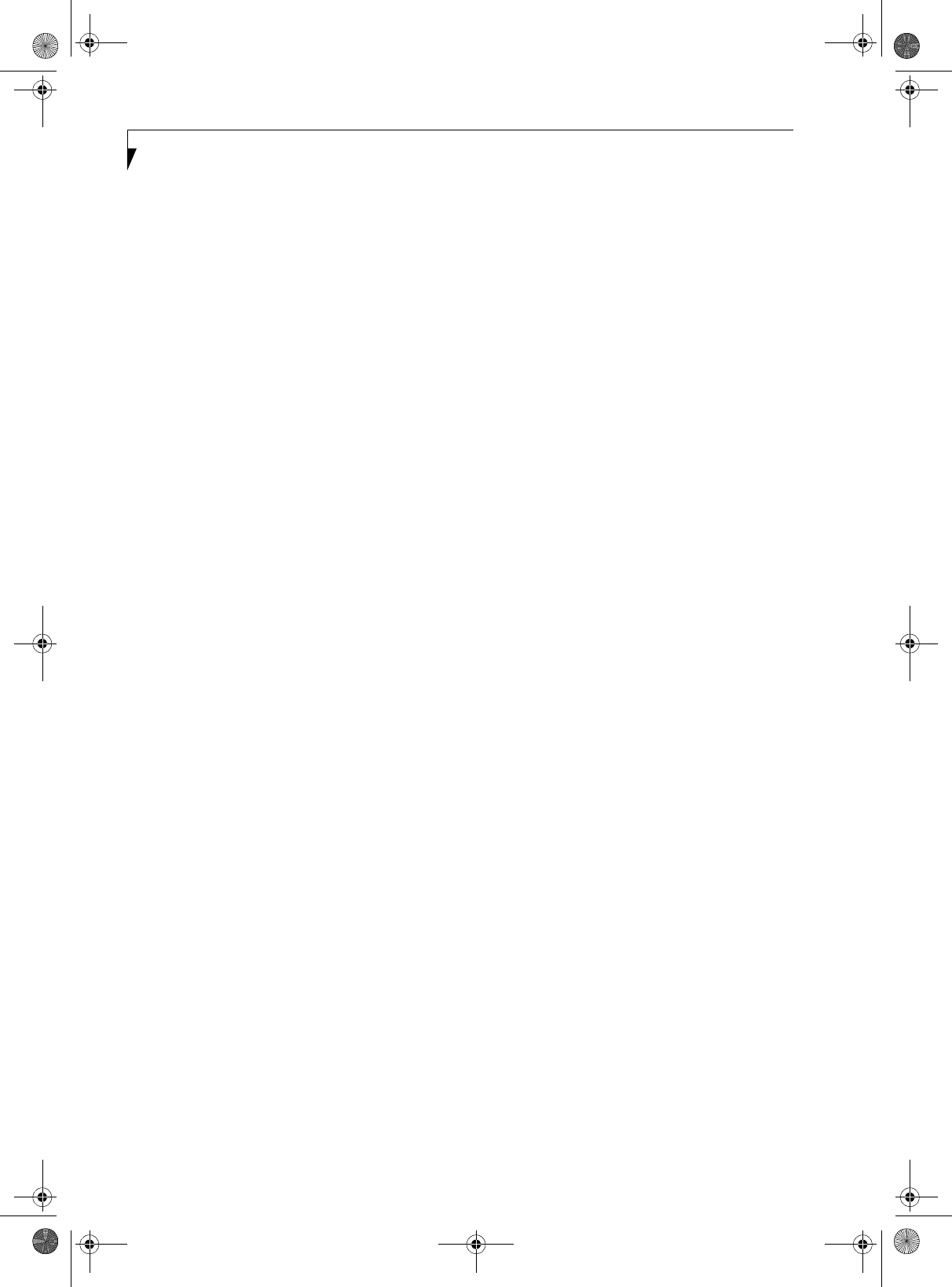
40
LifeBook T Series Tablet PC - Section Four
T Series.book Page 40 Thursday, July 31, 2003 10:49 AM
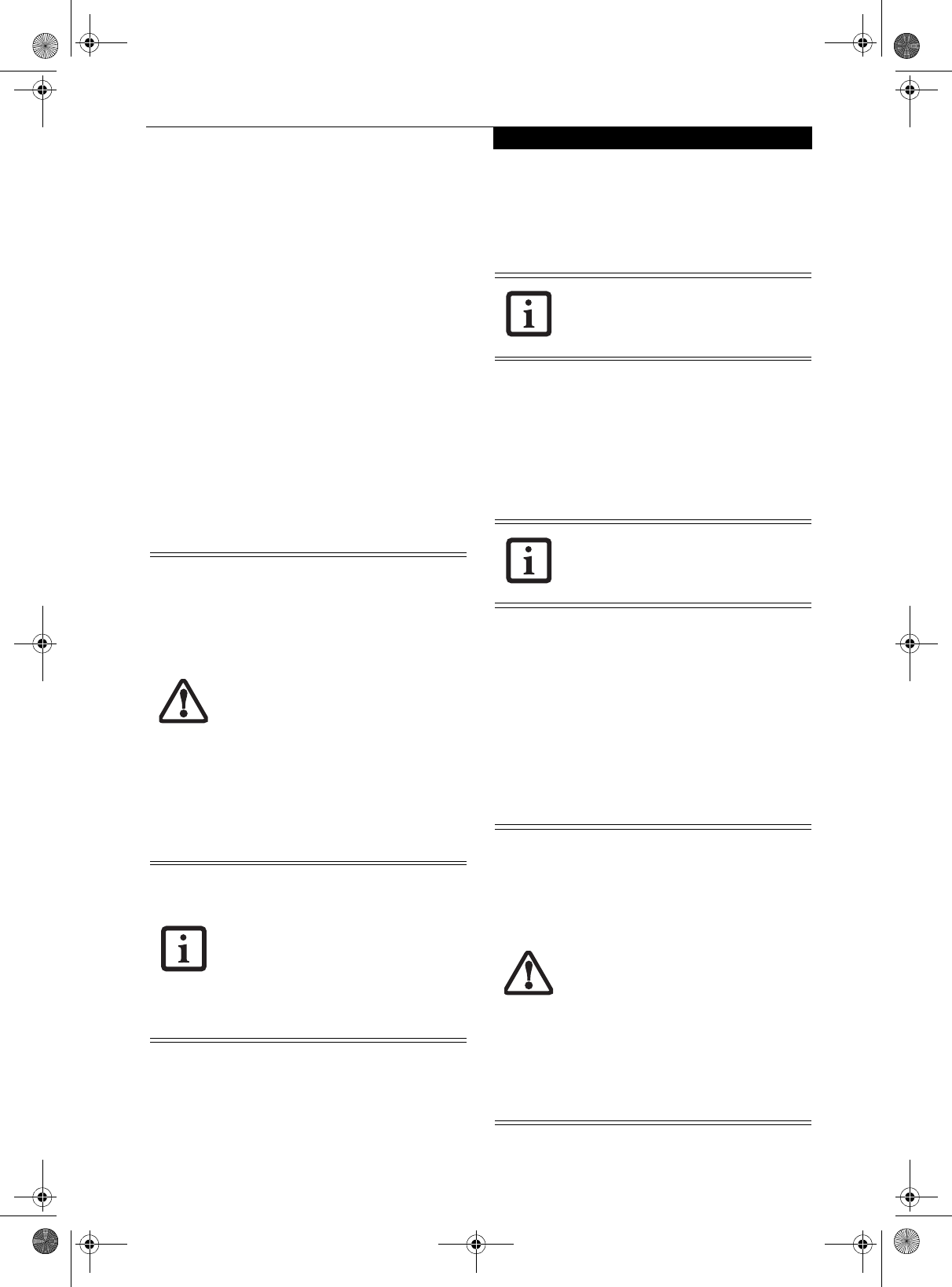
41
User-Installable Features
Lithium ion Battery
Your LifeBook T Series Tablet PC has a Lithium ion
battery that provides power for operating your Tablet
PC when no external power source is available. The
battery is durable and long lasting, but should not be
exposed to extreme temperatures, high voltages, chemi-
cals or other hazards.
The Lithium ion battery operating time may become
shorter if it is used under the following conditions:
■When used at temperatures lower than 41° F (5° C) or
higher than 95° F (35° C). Extreme temperatures not
only reduce charging efficiency, but can also cause
battery deterioration. The Charging icon on the Status
Indicator panel will flash when you try to charge a
battery that is outside its operating temperature range.
See “Battery Charging Indicator” on page 16.
■When using a high current device such as a modem,
CD-ROM drive, or hard drive, using the AC adapter
will conserve your battery life.
RECHARGING THE BATTERY
If you want to know the condition of the Lithium ion
battery, check the Battery Level indicator located on the
Status Indicator panel. The indicator changes as the
battery level changes.
The Lithium ion battery is recharged internally using
the AC adapter or Auto/Airline adapter. To recharge the
battery make sure the battery that needs to be charged
is installed in your Tablet PC and connect the AC or
Auto/Airline adapter.
There is no memory effect on the Lithium ion battery,
therefore you do not need to discharge the battery
completely before recharging. The charge times will be
longer if your Tablet PC is in use while the battery is
charging. If you want to charge the battery more quickly,
put your Tablet PC into Standby mode, or turn it off
while the adapter is charging the battery. See “Power
Management” on page 36.
Low Battery State
When the battery is running low, your Tablet PC will
beep every 15 seconds and the Battery Level indicator
will flash. If you do not respond to the low battery
alarm, the batteries will continue to discharge until they
are too low to operate. When this happens there will be a
multiple beep alarm and the Battery Level indicator will
show a dead battery. Your Tablet PC will then go into
Standby mode to try and protect your data for as long as
possible. There is no guarantee that your data will not be
lost once the Tablet PC reaches this point.
■Do not leave a faulty battery in your
Tablet PC. It may damage your AC
adapter, optional Auto/Airline adapter,
another battery or your Tablet PC itself.
It may also prevent operation of your
Tablet PC by draining all available cur-
rent into the bad battery.
■Under federal, state, or local law it may
be illegal to dispose of batteries by
putting them in the trash. Please take
care of our environment and dispose of
batteries properly. Check with your local
government authority for details
regarding recycling or disposing of old
batteries. If you cannot find this infor-
mation elsewhere, contact your support
representative at 1-800-8Fujitsu.
Actual battery life will vary based on
screen brightness, applications, features,
power management settings, battery
condition and other customer preferences.
CD-ROM drive or hard drive usage may
also have a significant impact on battery
life. The battery charging capacity is
reduced as the battery ages. If your
battery is running low quickly, you should
replace it with a new one.
Make sure that the Battery Charging
indicator and the percentage charge is
shown inside the Battery Level icon on the
Status Indicator Panel.
Using heavy current devices such as a
modem or frequent CD-ROM and
PCMCIA powered external device accesses
may prevent charging completely.
■You may not be able to hear the alarm if
the volume control is set too low or is
turned off by the hardware or software.
However, you will be able to see the
Battery Level indicator flash. Once the
low battery alarm occurs you must save
all your data and put your Tablet PC into
Standby mode until you can provide a
new power source. You should provide a
charged battery or AC or Auto/Airline
Adapter as soon as possible.
■When you are in Standby mode there
must always be at least one power
source active. If you remove all power
sources while your Tablet PC is in
Standby mode, any data that has not
been saved to the hard drive will be lost.
T Series.book Page 41 Thursday, July 31, 2003 10:49 AM
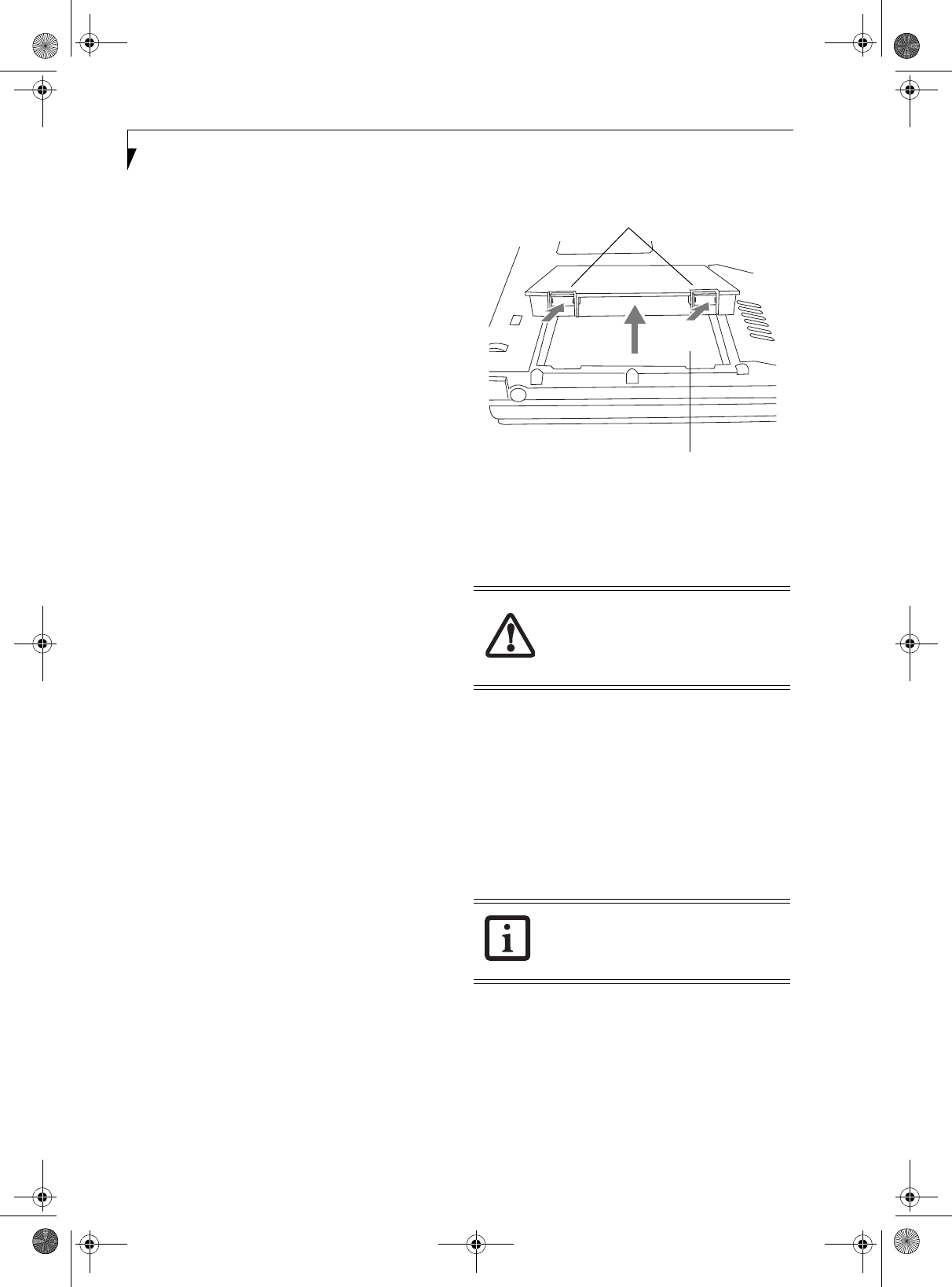
42
LifeBook T Series Tablet PC - Section Four
Dead Battery Suspend mode shows on the Status indi-
cator just like the normal Standby mode. Once your
Tablet PC goes into Dead Battery Suspend mode you
will be unable to resume operation until you provide
a source of power either from an adapter, or a charged
battery. Once you have provided power, you will need to
press the Suspend/Resume button to resume operation.
In the Dead Battery Suspend mode, your data can be
maintained for some time, but if a power source is not
provided promptly, the Power indicator will stop
flashing and go out, meaning that you have lost the data
that was not stored. Once you provide power, you can
continue to use your Tablet PC while an adapter is
charging the battery.
Shorted Batteries
The Status Indicator panel uses a symbol inside the
battery outline of the Battery Level indicator to display
the operating level available in that battery.
(See figure on page 15) If this display shows a Shorted
Battery, it means that the battery is damaged and must
be replaced so it does not damage any other parts of your
Tabl e t PC .
REPLACING THE BATTERY
Your LifeBook T Series Tablet PC comes with one
battery pack; you might want to consider purchasing a
spare. By keeping a spare battery fully charged, you can
immediately swap with one that is not charged.
There are two ways to swap batteries: cold-swapping and
warm-swapping. Cold-swapping means swapping
batteries when the system has been powered down;
warm-swapping is performed when the system is in
Standby mode.
Cold-swapping batteries
To cold-swap batteries in your battery compartment,
follow these easy steps: (Figure 4-1)
1. Have a charged battery ready to install.
2. Shut down your notebook and disconnect
the AC adapter.
3. Press the battery release latches to open the
compartment.
4. Remove the battery from the compartment.
5. Slide the new battery into the compartment.
6. Close the compartment and the battery release
latches will click into place.
7. Plug in the AC adapter and turn the power on.
Figure 4-1. Removing the Battery
Warm-swapping Batteries
To warm-swap batteries in your battery compartment
follow these easy steps: (Figure 4-1)
1. Close any open files and put your Tablet PC into
Standby mode.
2. Press the battery release latches to open the
compartment.
3. Remove the battery from the compartment.
4. Slide the new battery into the compartment.
5. Close the compartment and the battery release
latches will click into place.
6. Press the Suspend/Resume button to return your
Tablet PC to normal operation.
You have only a few minutes to perform a
warm-swapping before the internal
bridge battery runs out of power. Have
the charged battery nearby when
performing a warm battery swap.
If the Lithium ion battery connector is not
fully seated, you may not be able to use
your Tablet PC or charge your battery.
Battery Release Latches
Battery Compartment
T Series.book Page 42 Thursday, July 31, 2003 10:49 AM
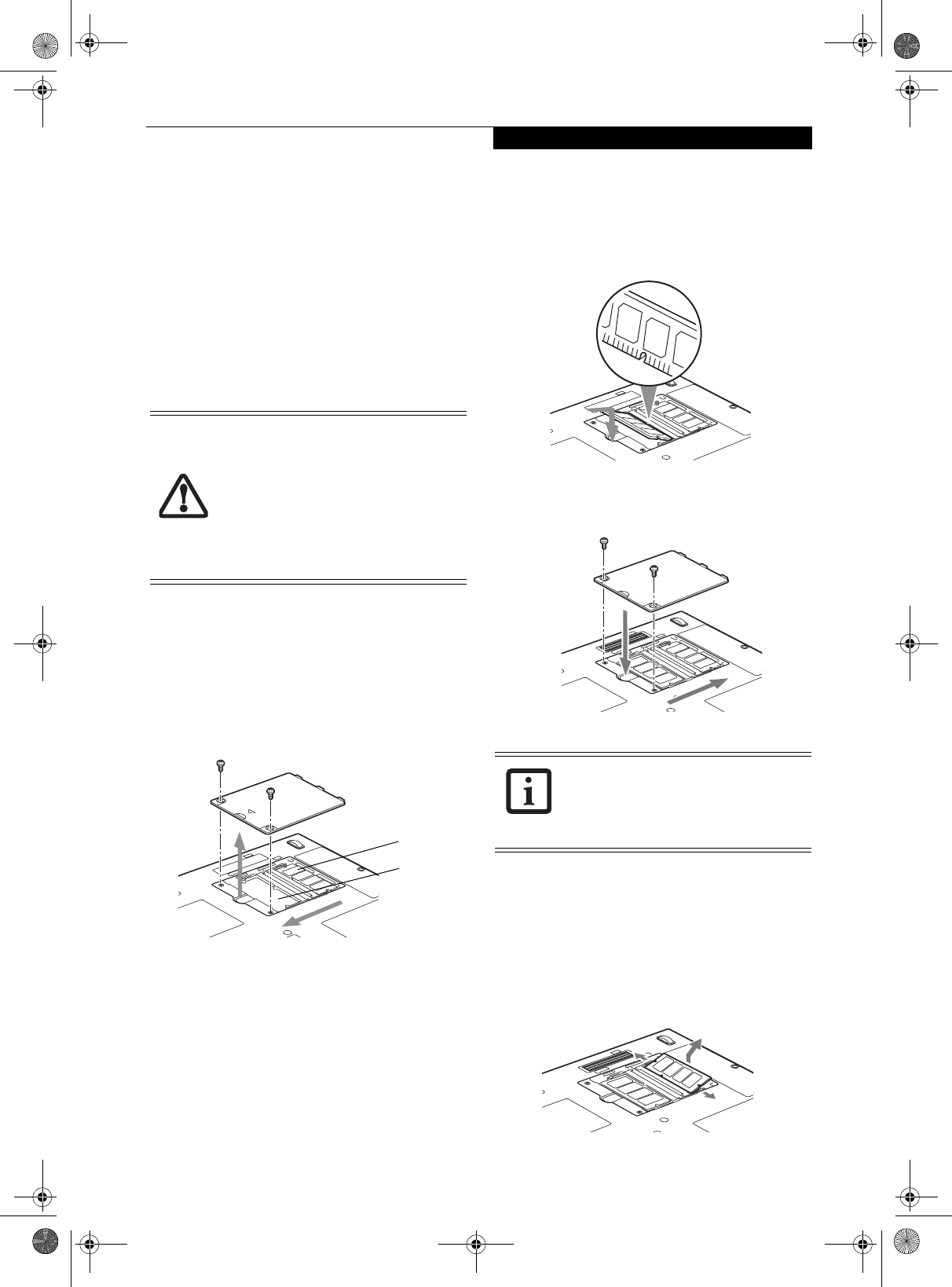
43
User-Installable Features
Memory Upgrade
Module
Your Fujitsu LifeBook T Series Tablet PC comes with a
minimum of 256 MB of high speed Double Data Rate
Synchronous Dynamic RAM (DDR SDRAM), 266 MHz
factory installed. To increase your system’s memory
capacity, you may install an additional memory upgrade
module. The memory upgrade must be a dual-in-line
(DIMM) SDRAM module. To ensure 100% compati-
bility, purchase the SDRAM module only from the
Fujitsu web store at www.fujitsupc.com.
INSTALLING MEMORY UPGRADE MODULES
1. Turn off power to your LifeBook Tablet PC and
remove any power adapter (AC or auto/airline).
2. Make sure that all the connector covers are closed.
3. Turn the Tablet PC bottom side up, and remove the
screws of the memory upgrade module compart-
ment. (Figure 4-2)
4. Remove the cover.
Figure 4-2. Opening the Memory Upgrade Compartment
5. Remove the memory upgrade module from the
static guarded sleeve. As noted above, if you are
installing a 1 GB memory module by itself or with a
smaller module, it must be installed in slot 1.
6. Align the memory upgrade module with the
component side up. Align the connector edge of the
memory upgrade module with the connector slot in
the compartment. (Figure 4-3)
7. Insert the memory upgrade module at a 45° angle.
Press the connector edge of the module firmly down
and into the connector until it lodges under the
retaining clip. You will hear a click when it is prop-
erly in place.
Figure 4-3. Installing a Second Memory Module
8. Replace the cover. (Figure 4-4)
9. Replace the screws.
Figure 4-4. Replacing the Memory Compartment Cover
TO REMOVE A MEMORY UPGRADE MODULE
1. Perform steps 1 through 4 of Installing a Memory
Upgrade Module.
2. Pull the clips sideways away from each side of the
memory upgrade module at the same time.
3. While holding the clips out, remove the module
from the slot by lifting it up and pulling towards the
rear of your notebook. (Figure 4-5)
Figure 4-5. Removing a Memory Upgrade Module
■If you are installing a 1 GB memory
upgrade module by itself or with a
smaller module, it must be installed in
slot 1 (Figure 4-2).
■Do not remove any screws from the
memory upgrade module compart-
ment except those specifically shown
in the directions for installing and
removing the module.
Slot 1
Slot 2
The memory upgrade module is not
something you routinely remove from
your notebook. Once it is installed, you
should leave it in place unless you want to
change system memory capacity.
T Series.book Page 43 Thursday, July 31, 2003 10:49 AM
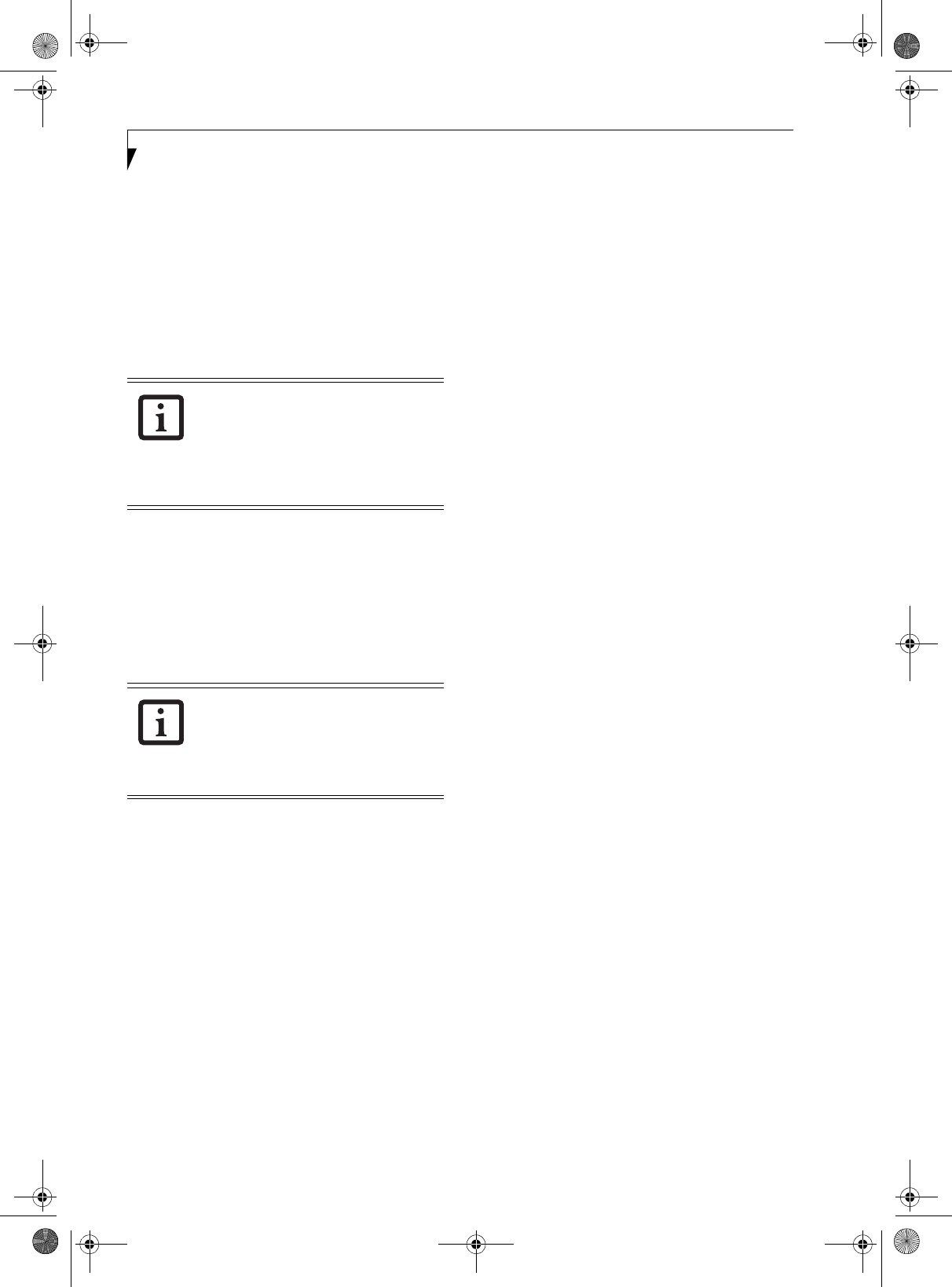
44
LifeBook T Series Tablet PC - Section Four
4. Store the memory upgrade module in a static
guarded sleeve.
5. Replace the cover. (Figure 4-4)
6. Replace the screws.
CHECKING THE MEMORY CAPACITY
Once you have changed the system memory capacity by
either adding or removing a memory upgrade module,
be sure to check that your notebook has recognized the
change.
You can check the memory capacity by clicking [Start]
-> Control Panel, then double-clicking the System icon.
Select the General tab and check the amount of memory
under “Computer.”
The amount of memory displayed should be approxi-
mately the total of all memory modules installed. There
may be a discrepancy of 8 MB which is allocated for
fixed video memory.
Your Tablet PC uses Dynamic Video
Memory Technology (DVMT), which
allows the video driver to dynamically
determine the amount of memory that is
used. Your Tablet PC can use a maximum
of 64 MB of system memory for video
functions.
If the total memory displayed is incorrect,
check that your memory upgrade module
is properly installed. (If the module is
properly installed and the capacity is still
not correctly recognized, see
Troubleshooting on page 54.
T Series.book Page 44 Thursday, July 31, 2003 10:49 AM
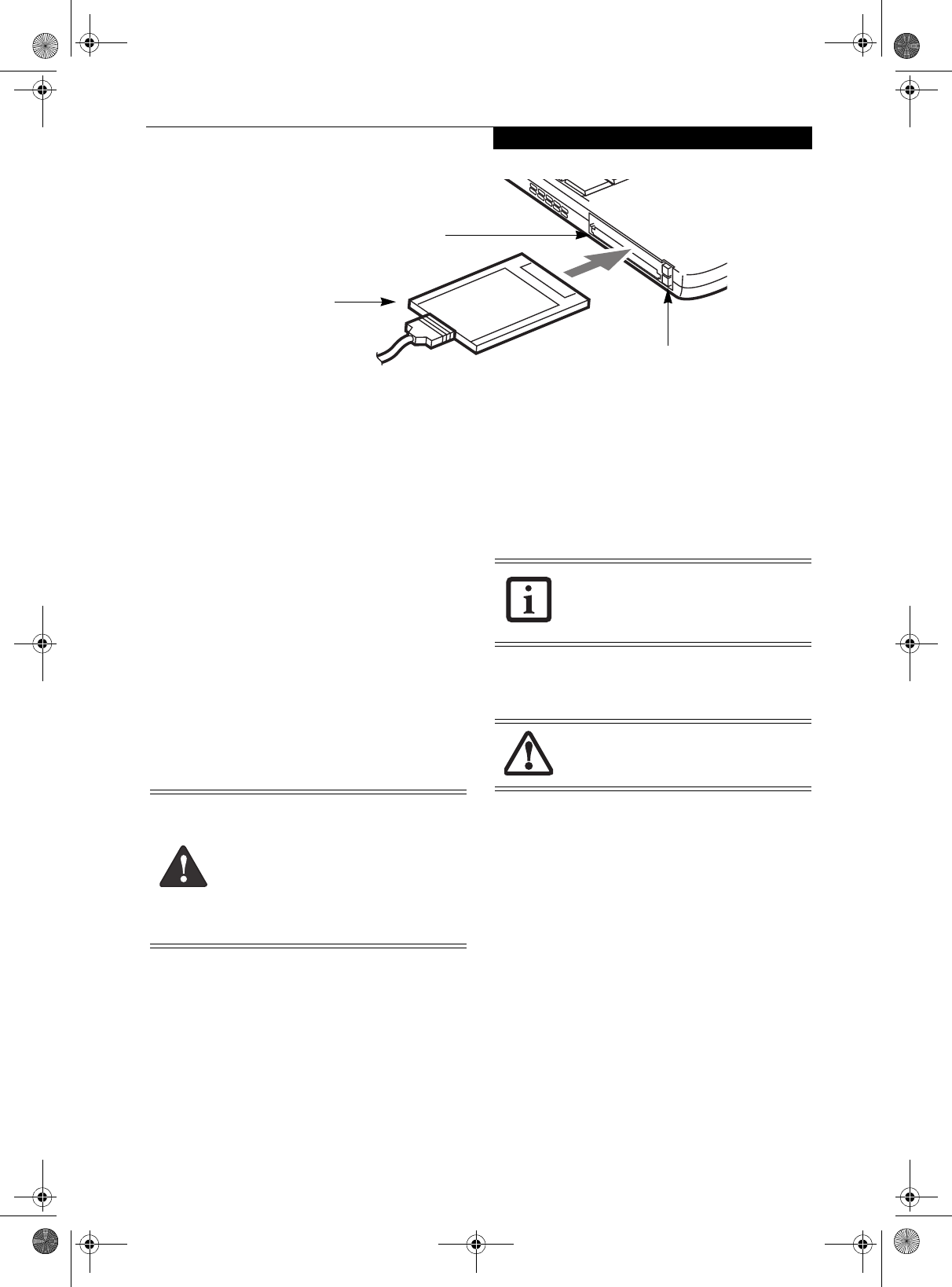
45
User-Installable Features
Figure 4-6. Installing/Removing PC Cards
PC Cards
Your LifeBook T Series Tablet PC supports Type I, II,
and Type III PC Cards, which can perform a variety of
functions.
Some available PC Cards include:
■Fax/data modem cards.
■Local area network (LAN) cards.
■IDE solid-state disk cards.
■SCSI cards.
■Other PC Cards that conform to PCMCIA 2.1 or
CardBus standards.
■Optional SmartCard adapter
For further information, refer to the instructions
supplied with your PC Card.
INSTALLING PC CARDS
PC Cards are installed in the PC Card slot. To install a
PC Card, follow these easy steps: (Figure 4-6)
1. See your PC Card manual for specific instructions
on the installation of your card. Some PC Cards
may require your Tablet PC to be Off while
installing them.
2. Make sure there is no PC Card currently in the slot.
If there is, see Removing PC Cards.
3. Insert your PC Card into the slot, with the product
label facing up.
4. Push the card into the slot firmly until it is seated in
the opening.
REMOVING PC CARDS
To remove a PC Card, follow these easy steps:
1. See your PC Card manual for specific instructions
on removing your card. Some PC Cards may require
your Tablet PC to be in Standby Mode or Off while
removing them.
2. Push the Eject button until it pops out, and then
push it in to eject the card. This will allow you to
remove the card.
SMART CARD READER
An embedded Smart Card Reader is provided on your
Tablet PC. Smart Cards are the same size and shape as
credit cards, but they contain an integrated micropro-
cessor chip. The chip can hold a variety of information,
and provides the user with many possible options, such
as allowing them to make secure purchases, pay for
phone calls, store security information, and provide
identification and information.
In order to use the embedded Smart Card Reader, you
must purchase an optional Smart Card holder for instal-
lation into an available Type II PC Card slot.
Eject Buttons
PC Card Slots
PC Card
■Installing or removing a PC Card during
your Tablet PC’s shutdown or bootup
process may damage the card and/or
your Tablet PC.
■Do not insert a PC Card into a slot if
there is water or any other substance on
the card as you may permanently dam-
age the card, your Tablet PC, or both.
If the dialog box states that the device
can’t be removed, you must save all open
files, close any open applications and shut
down your Tablet PC.
If the PC Card has an external connector
and cable, do not pull the cable when
removing the card.
T Series.book Page 45 Thursday, July 31, 2003 10:49 AM
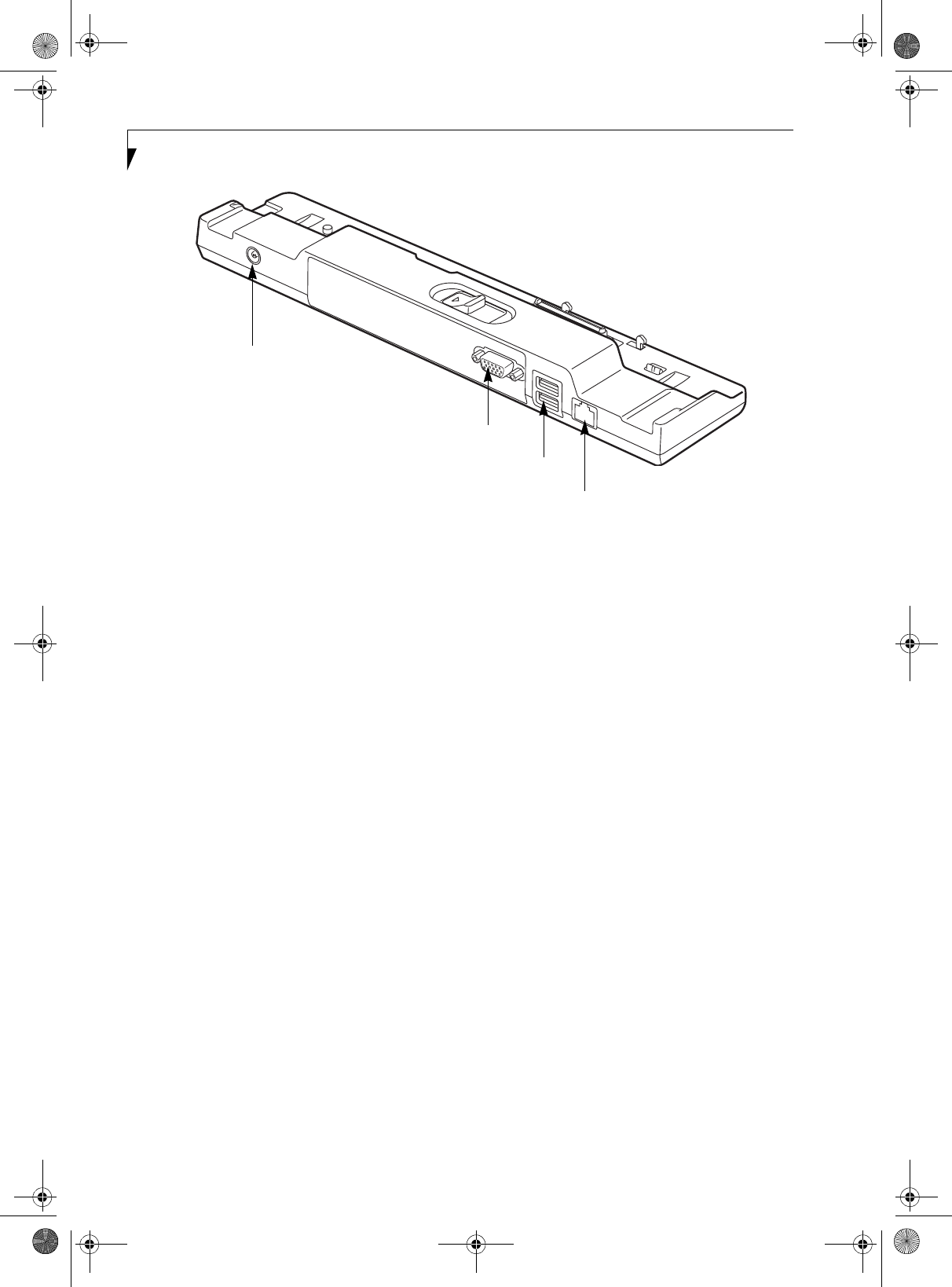
46
LifeBook T Series Tablet PC - Section Four
Figure 4-7. Port Replicator rear panel
Port Replicator
An optional Port Replicator is available from Fujitsu to
support your LifeBook T Series Tablet PC. The Port
Replicator extends the functionality of your Tablet PC
by providing ports to connect USB devices, an external
monitor, or a LAN device. The Port Replicator connects
to the bottom of your Tablet PC. See “Device Ports” on
page 48.
REAR PANEL COMPONENTS
Following is a brief description of the optional Port
Replicator’s rear panel components.
External Monitor Port
The external monitor port allows you to connect an
external VGA or SVGA monitor. Note that if a Port
Replicator is attached, you must use the external
monitor port on the Port Replicator. (Figure 4-7)
LAN (RJ-45) Jack
The LAN jack allows you to connect a LAN to the Port
Replicator. Note that when the system is attached to the
Port Replicator, the LAN Jack on the Port Replicator
should be used, not the one on the system.
DC Power Jack
The DC power jack allows you to plug in the AC adapter
to power your Tablet PC and charge the internal
Lithium ion battery.
USB 2.0 Ports
The two USB 2.0 ports allow you to connect USB
devices such as game pads, pointing devices, and
keyboards. USB 2.0 is downward-compatible with USB
1.1 devices, so older USB devices will work with these
ports. USB 2.0 is a much faster design, running 40 times
faster than USB 1.1.
External Monitor Port
LAN (RJ-45) Jack
DC Power Jack
USB Ports
T Series.book Page 46 Thursday, July 31, 2003 10:49 AM
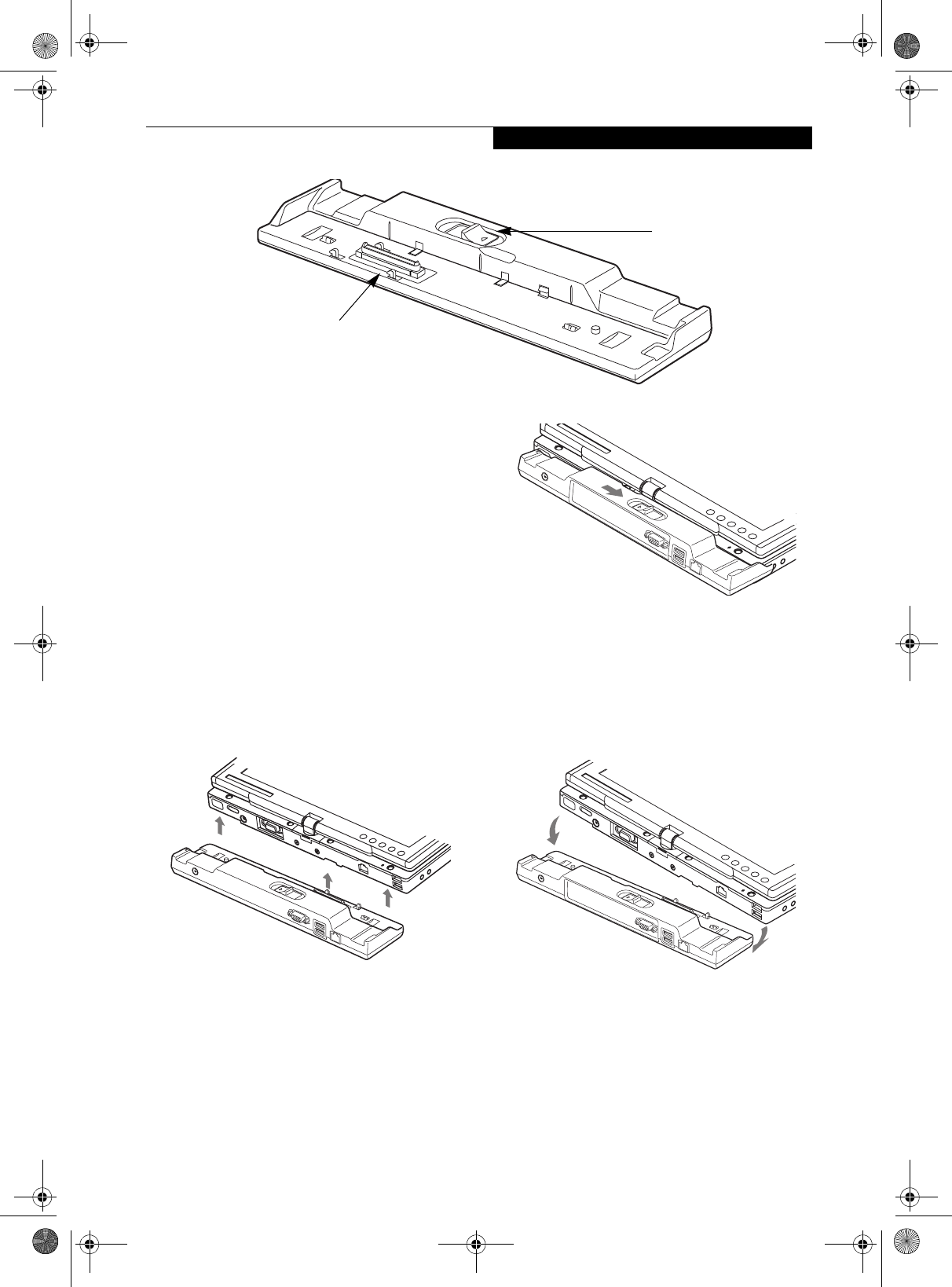
47
User-Installable Features
Figure 4-8. Port Replicator front panel
FRONT PANEL COMPONENTS
Following is a brief description of the optional Port
Replicator’s front panel components
Docking Port
The docking port connects the Port Replicator to your
Tabl e t PC . (Figure 4-8)
Port Replicator Release Latch
Slide the Port Replicator Release Latch sideways to
remove the Port Replicator from your Tablet PC.
(Figure 4-8)
ATTACHING THE PORT REPLICATOR
To attach the Port Replicator, align the Port Replicator
connector on the bottom of your Tablet PC with the
connector on the Port Replicator and push together at
the two corners. (Figure 4-9)
Figure 4-9. Attaching the Port Replicator
Figure 4-10. Unlatching the Port Replicator
DETACHING THE PORT REPLICATOR
To detach the Port Replicator:
1. Slide the Port Replicator release latch to release the
Port Replicator from your Tablet PC. (Figure 4-10)
2. Pull away the Port Replicator to detach it from
your Tablet PC. (Figure 4-11)
Figure 4-11. Removing the Port Replicator
Docking Port
Port Replicator
Release Latch
T Series.book Page 47 Thursday, July 31, 2003 10:49 AM
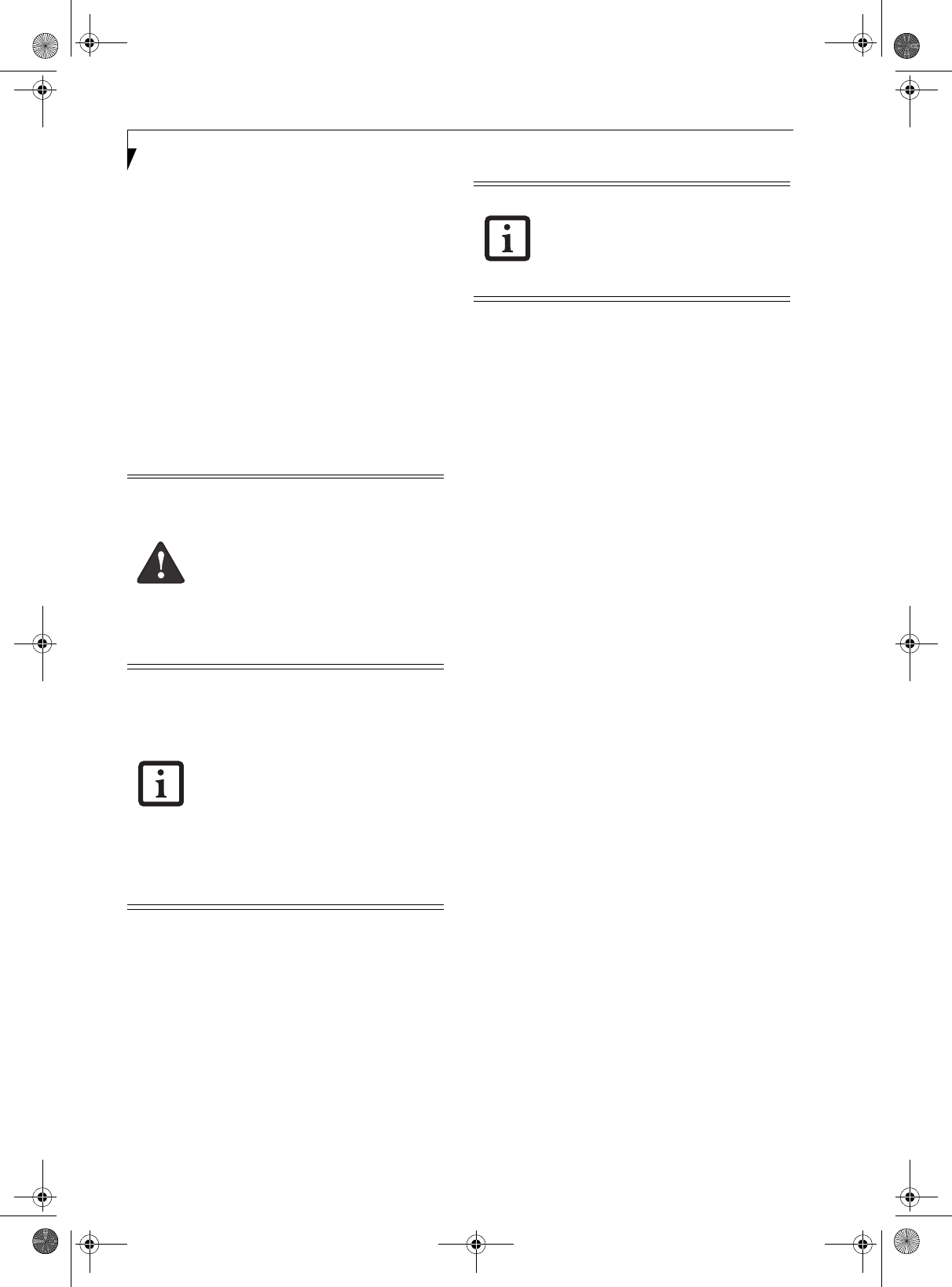
48
LifeBook T Series Tablet PC - Section Four
Device Ports
Your LifeBook T Series Tablet PC and the optional Port
Replicator come equipped with multiple Device Ports to
which you can connect an external device including: disk
drives, keyboards, modems, printers, etc.
MODEM (RJ-11) JACK
The modem (RJ-11) jack is used for an internal modem.
To connect the telephone cable follow these easy steps:
(See Figure 2-6 on page 12 for location)
1. Align the connector with the jack opening.
2. Push the connector into the jack until it is seated.
3. Plug the other end of the telephone cable into a
telephone outlet.
INTERNAL LAN (RJ-45) JACK
The internal LAN (RJ-45) jack is used for an internal
Fast Ethernet (10/100 Base-T/Tx) connection. You will
need to configure your Tablet PC to work with your
particular network. (Please refer to your network
administrator for information on your network configu-
ration.) To connect the LAN cable follow these easy
steps: (See Figure 2-7 on page 13 for location)
1. Align the connector with the jack opening.
2. Push the connector into the jack until it is seated.
3. Plug the other end of the cable into a LAN outlet.
DOCKING PORT
The docking port is used for the connection of your
Tablet PC to an optional port replicator. In order to
connect your Tablet PC to one of these devices follow the
instructions that came with your docking port. (See
Figure 2-8 on page 14 for location)
UNIVERSAL SERIAL BUS PORTS
The two Universal Serial Bus 2.0 ports (USB) allow you
to connect USB devices such as external floppy disk
drives, external CD and DVD drives, game pads,
pointing devices, keyboards and/or speakers. USB 2.0 is
downward-compatible with USB 1.1 devices, so older
USB devices will work with these ports. USB 2.0 is a
much faster design, running forty times faster than
USB 1.1.
In order to connect a USB device, follow these easy steps:
(See Figure 2-7 on page 13 for location)
1. Align the connector with the port opening.
2. Push the connector into the port until it is seated.
INFRARED PORT
The Infrared IrDA 1.1 (4 Mbps) port allows for wireless
data transfer between your Tablet PC and other IrDA-
compatible devices, such as another computer or a
printer, without the use of a cable. (See Figure 2-7 on
page 13 for location)
It is important to keep in mind that while carrying out
this form of communication, both devices must be
placed so their infrared ports are directly facing each
other without obstruction. The devices must also be
separated by at least 6" but no more than 36" for
maximum performance.
The following conditions may interfere with infrared
communications:
■A television, radio remote control unit, or a wireless
headphone is being used nearby.
■Direct sunlight, fluorescent light, or incandescent light
shines directly on the port.
The internal modem is not intended for
use with Digital PBX systems. Do not
connect the internal modem to a Digital
PBX as it may cause serious damage to the
internal modem or your entire LifeBook T
Series Tablet PC. Consult your PBX
manufacturer’s documentation for details.
Some hotels have Digital PBX systems. Be
sure to find out BEFORE you connect your
modem.
■The internal modem is designed to the
ITU V.90 standard. Its maximum speed
of 53000 bps is the highest allowed by
FCC, and its actual connection rate
depends on the line conditions. The
maximum speed is 33600 bps at upload.
■The internal modem on all LifeBook T
Series Tablet PC’s from Fujitsu PC
Corporation are certified for use in the
United States and Canada.
■Depending upon the configuration of
your system, your LifeBook Tablet PC
may have either a LAN jack or an IEEE
1394 jack.
Note that the optional Port Replicator is
designed to cover the LAN jack located on
the system. This design ensures that the
LAN jack on the Port Replicator is the only
one used when the Port Replicator is
installed.
T Series.book Page 48 Thursday, July 31, 2003 10:49 AM
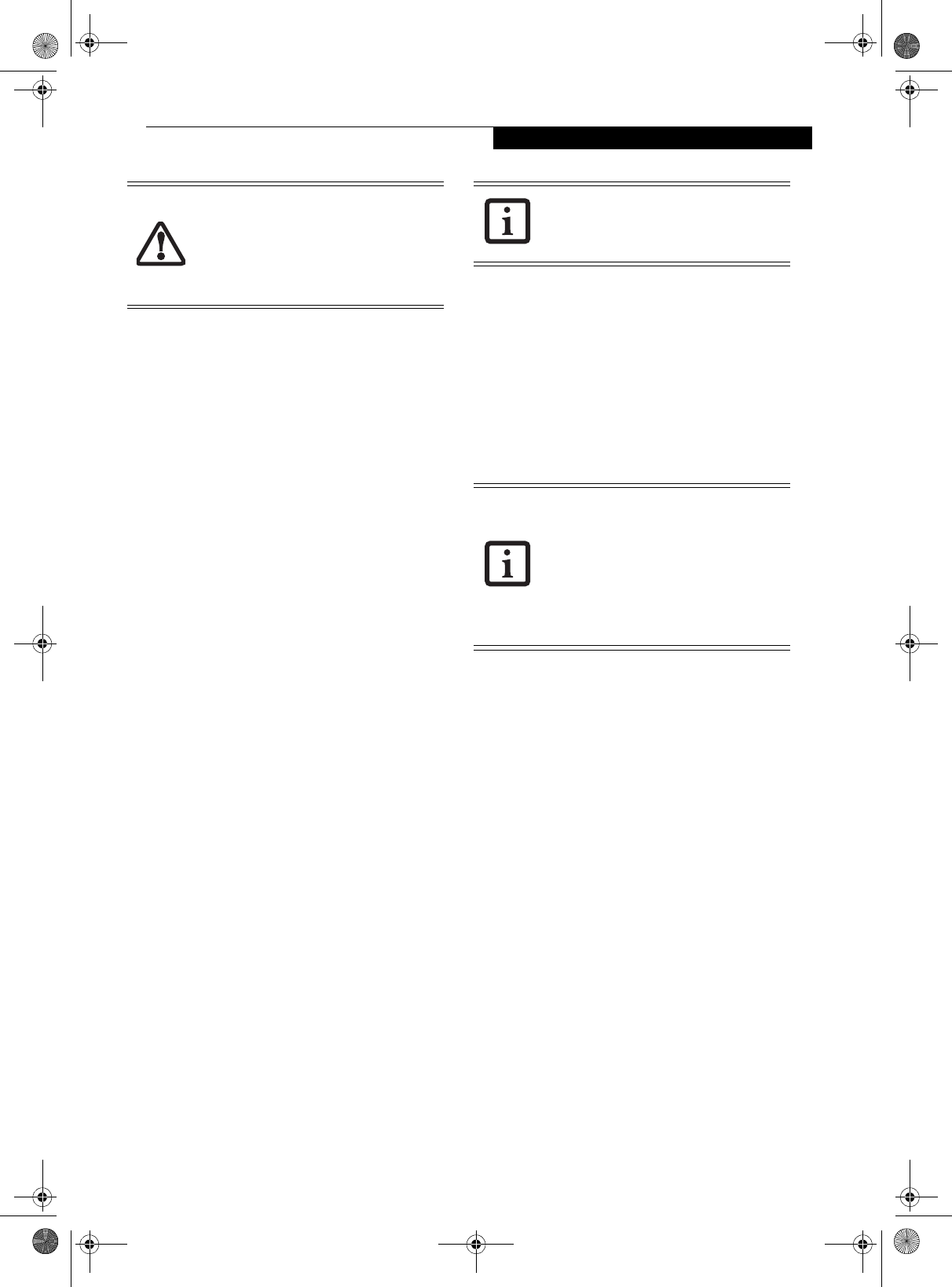
49
User-Installable Features
MICROPHONE JACK
The microphone jack allows you to connect an external
mono microphone. Your microphone must be equipped
with a 1/8"(3.5 mm) mono mini-plug in order to fit into
the microphone jack of your Tablet PC. In order to
connect a microphone follow these easy steps: (See
Figure 2-5 on page 11 for location)
1. Align the connector with the port opening.
2. Push the connector into the port until it is seated.
HEADPHONE JACK
The headphone jack allows you to connect headphones
or powered external speakers to your Tablet PC. Your
headphones or speakers must be equipped with a 1/8"
(3.5 mm) stereo mini-plug. In order to connect head-
phones or speakers follow these easy steps: (See Figure 2-
5 on page 11 for location)
1. Align the connector with the port opening.
2. Push the connector into the port until it is seated.
EXTERNAL MONITOR PORT
The external monitor port allows you to connect an
external monitor. In order to connect an external
monitor follow these easy steps: (See Figure 2-7 on
page 13 for location)
1. Remove the cover from the port opening, if present.
2. Align the connector with the port opening.
3. Push the connector into the port until it is seated.
4. Tighten the two hold-down screws, located on
each end of the connector.
■Do not move either device while com-
munication is active as it may interrupt
data transmission.
■Be careful not to scratch the infrared
port lens. Scratches, dirt, or other sur-
face marks can degrade operation.
If you plug headphones into the
headphone jack, the built-in stereo
speakers will be disabled.
When an external monitor is plugged in,
pressing the [Fn] + [F10] keys allows you
to change your selection of where to send
your display video. Each time you press the
key combination, you will step to the next
choice, starting with the built-in display
panel only, moving to the external monitor
only, finally moving to both the built-in
display panel and an external monitor.
T Series.book Page 49 Thursday, July 31, 2003 10:49 AM
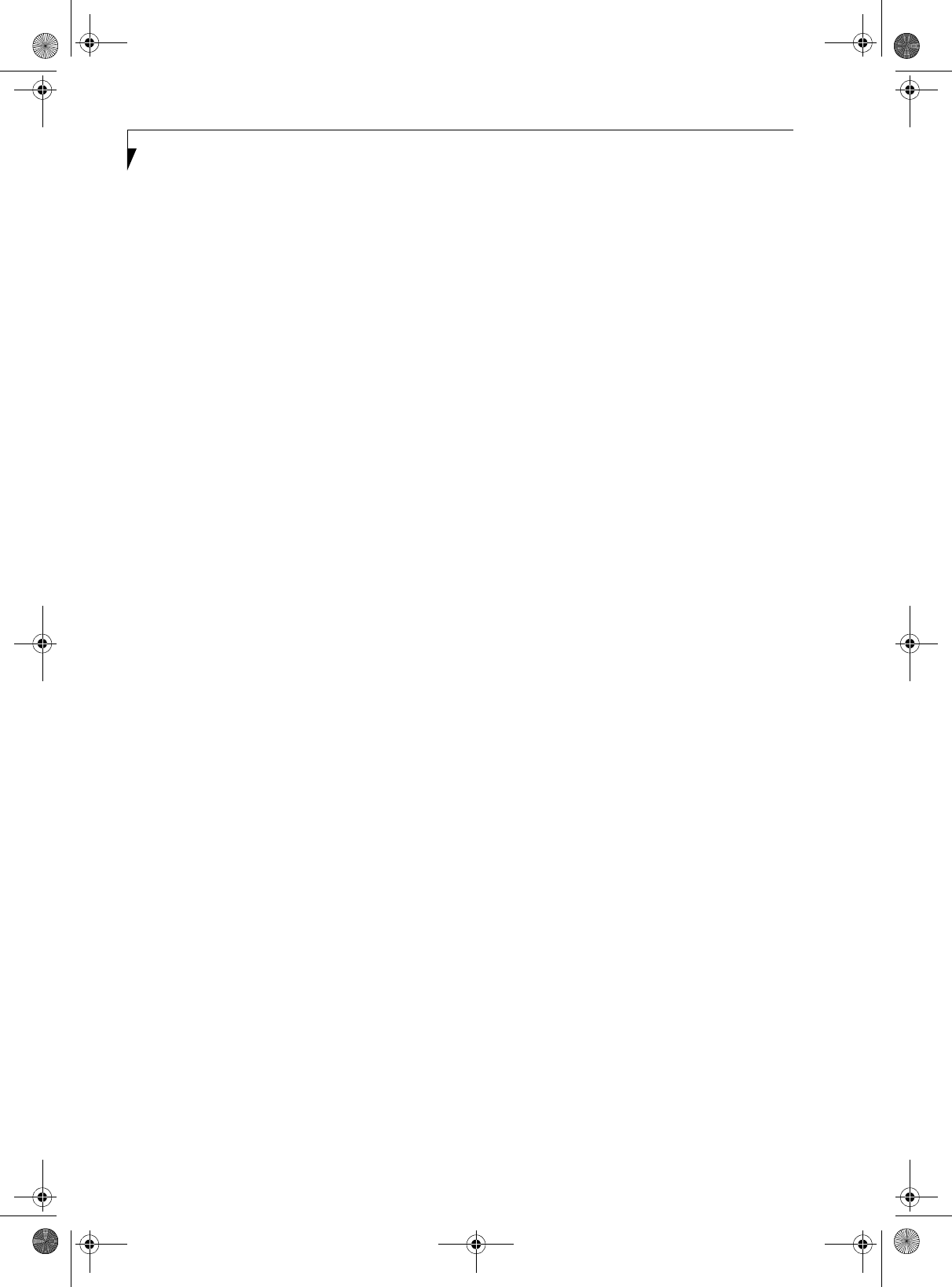
50
LifeBook T Series Tablet PC - Section Four
T Series.book Page 50 Thursday, July 31, 2003 10:49 AM

51
5
Troubleshooting
T Series.book Page 51 Thursday, July 31, 2003 10:49 AM
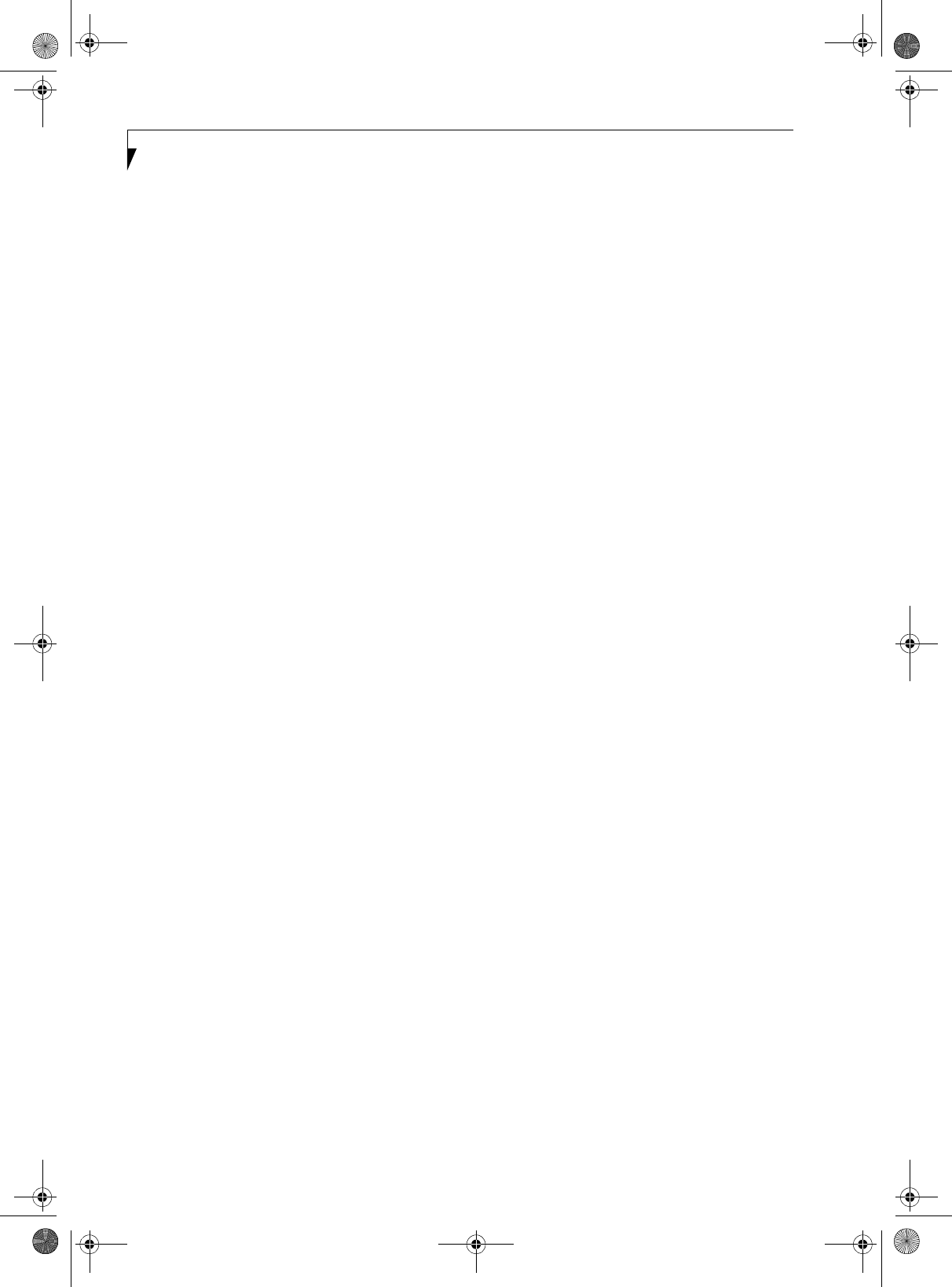
52
LifeBook T Series Tablet PC - Section Five
T Series.book Page 52 Thursday, July 31, 2003 10:49 AM
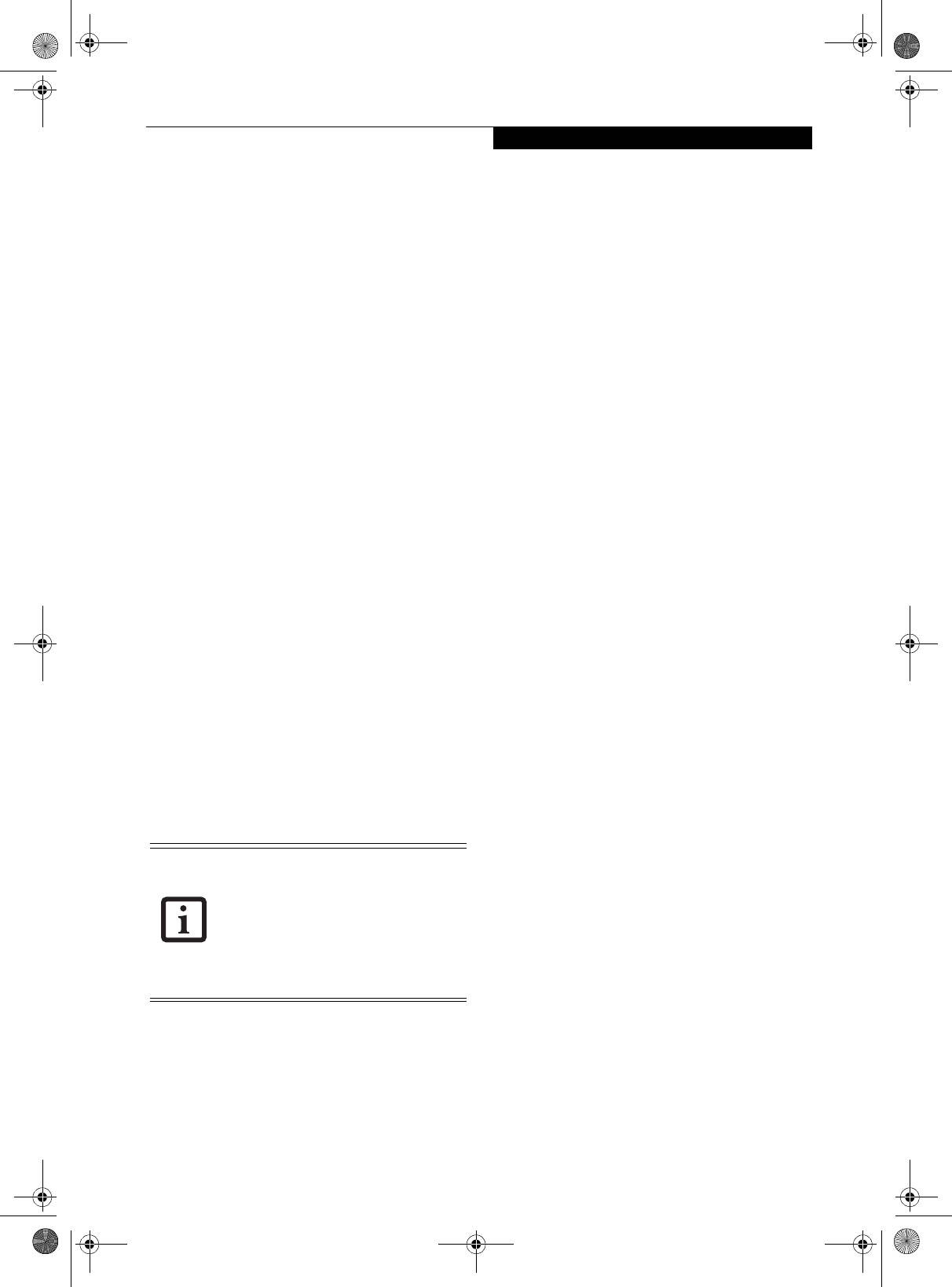
53
Troubleshooting
Troubleshooting
Your LifeBook T Series Tablet PC is sturdy and subject
to few problems in the field. However, you may
encounter simple setup or operating problems that you
can solve on the spot, or problems with peripheral
devices, that you can solve by replacing the device. The
information in this section helps you isolate and resolve
some of these straightforward problems and identify
failures that require service.
IDENTIFYING THE PROBLEM
If you encounter a problem that you are having diffi-
culty in solving, go through the following procedure
before pursuing further troubleshooting:
1. Tur n off your Tabl e t PC.
2. Make sure the AC adapter is plugged into your
Tablet PC and to an active AC power source.
3. Make sure that any card installed in the PC Card slot
is seated properly. You can also remove the card
from the slot, thus eliminating it as a possible cause
of failure.
4. Make sure that any devices connected to the external
connectors are plugged in properly. You can also
disconnect such devices, thus eliminating them as
possible causes of failure.
5. Turn on your Tablet PC. Make sure it has been off at
least 10 seconds before you turn it on.
6. Go through the boot sequence.
7. If the problem has not been resolved, refer to the
Troubleshooting Table, that follows, for more
detailed troubleshooting information.
8. If you still have the problem after taking all of the
above approaches, please check our Web site at
www.fujitsupc.com for possible known support
issues.
8. If you have tried the solutions suggested in the
Troubleshooting Table and checked our Web site for
possible solutions without success, contact your
support representative:
Toll free: 1-800-8Fujitsu
Fax: 1-901-259-5700
E-mail: 8fujitsu@fujitsupc.com
Web site: http://www.fujitsupc.com.
Before you place the call, you should have the following
information ready so that the customer support repre-
sentative can provide you with the fastest possible solu-
tion:
■Product name
■Product configuration number
■Product serial number
■Purchase date
■Conditions under which the problem occurred
■Any error messages that have occurred
■Hardware configuration
■Type of device connected, if any
See the Configuration Label on the bottom of your
Tablet PC for configuration and serial numbers. (See
figure 2-8 on page 14 for location)
SPECIFIC PROBLEMS
Using the Troubleshooting Table
When you have problems with your Tablet PC, try to
find the symptoms under the Problem column of the
troubleshooting table for the feature giving you diffi-
culty.
You will find a description of common causes for that
symptom under the column Possible Cause and what, if
anything, you can do to correct the condition under
Possible Solutions. All possible causes or solutions may
not apply to your Tablet PC.
■If you keep notes about what you have
tried, your support representative may
be able to help you more quickly by giv-
ing additional suggestions over the
phone.
■Do not return a failed Tablet PC to your
supplier until you have talked to a sup-
port representative.
T Series.book Page 53 Thursday, July 31, 2003 10:49 AM
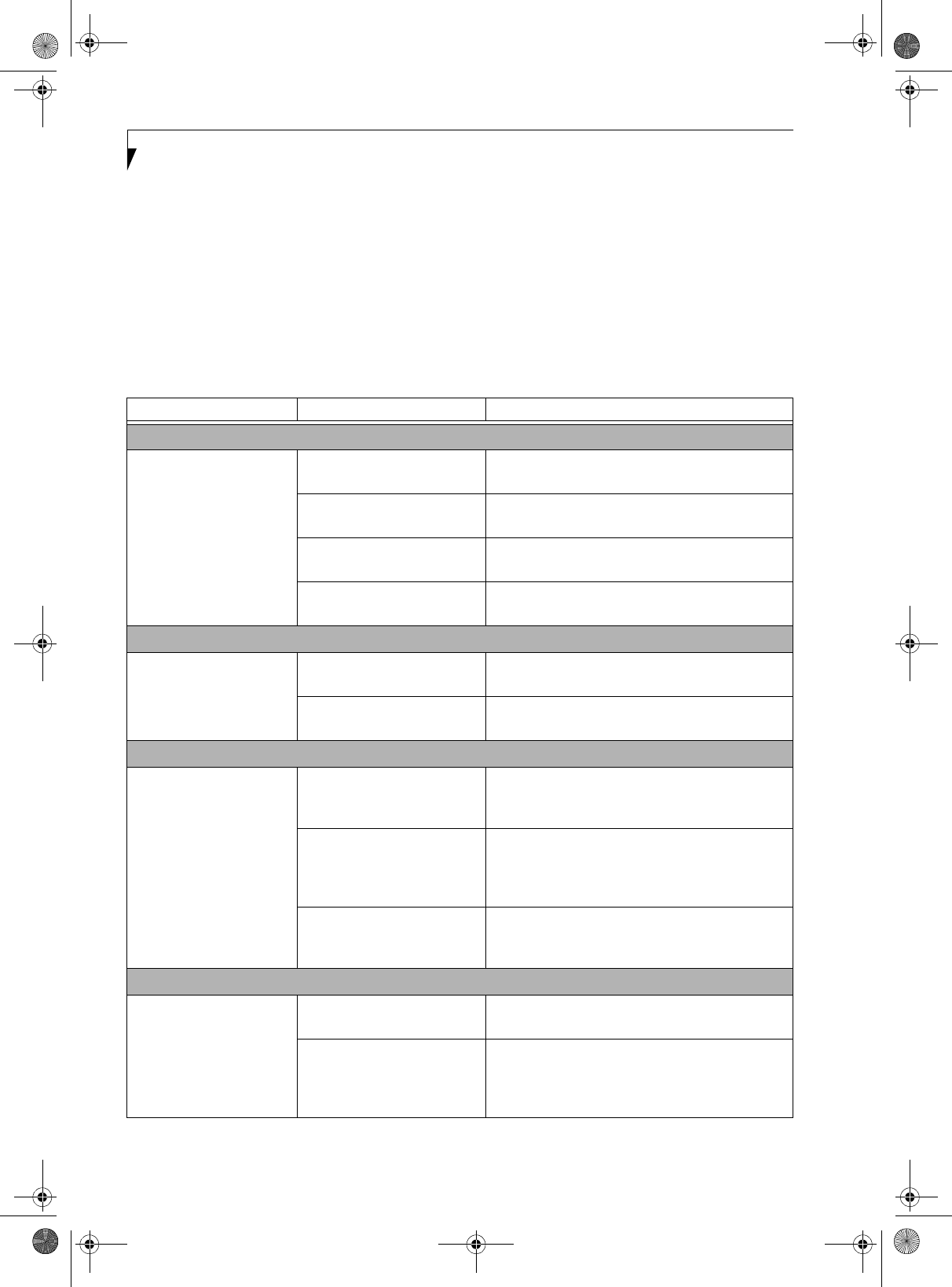
54
LifeBook T Series Tablet PC - Section Five
TROUBLESHOOTING TABLE
Problem Page
Audio Problems . . . . . . . . . . . . . . . . . . . . . . . . . . page 54
Docking Problems . . . . . . . . . . . . . . . . . . . . . . . . page 54
Hard Drive Problems . . . . . . . . . . . . . . . . . . . . . . page 54
Keyboard or Mouse Problems. . . . . . . . . . . . . . . page 54
Pen Input Problems . . . . . . . . . . . . . . . . . . . . . . . page 55
Infrared Problems . . . . . . . . . . . . . . . . . . . . . . . . page 55
Memory Problems . . . . . . . . . . . . . . . . . . . . . . . . page 55
Problem Page
Modem Problems. . . . . . . . . . . . . . . . . . . . . . . . . page 55
USB Device Problems . . . . . . . . . . . . . . . . . . . . . page 56
PC Card Problems . . . . . . . . . . . . . . . . . . . . . . . . page 56
Power Failures . . . . . . . . . . . . . . . . . . . . . . . . . . . page 56
Shutdown and Startup Problems . . . . . . . . . . . . page 58
Video Problems . . . . . . . . . . . . . . . . . . . . . . . . . . page 59
Miscellaneous Problems . . . . . . . . . . . . . . . . . . . page 60
Problem Possible Cause Possible Solutions
Audio Problems
There is no sound coming
from the built-in speakers.
The software volume control is
set too low.
Adjust the sound volume control settings in your
software, operating system and applications.
Headphones are plugged into
your Tablet PC.
Plugging in headphones disables the built-in
speakers, remove the headphones.
Software driver is not config-
ured correctly.
Refer to your application and operating system
documentation for help.
Sound could have been muted
with function keys.
Press [F3] while holding the [Fn] key to toggle the
sound on and off.
Port Replicator Problems
Tablet PC does not turn on
when installed in optional
Port Replicator
Port Replicator AC adapter is
not plugged in.
Provide power to the Port Replicator.
Tablet PC is not properly
seated in the Port Replicator.
Remove and re-dock your Tablet PC.
Hard Drive Problems
You cannot access your
hard drive.
The setup utility is incorrectly
set for your internal (Primary
Master) hard drive.
Revise BIOS settings to set the Primary Master
correctly. See “BIOS Setup Utility” on page 34.
The wrong drive designator
was used by an application
when a bootable CD-ROM was
used to start the Tablet PC.
Verify drive designator used by application is in
use by the operating system. When the operating
system is booted from a CD, drive designations
are automatically adjusted.
Security is set so your oper-
ating system cannot be started
without a password.
Verify your password and security settings.
Keyboard or Mouse Problems
The built-in keyboard does
not seem to work.
The Tablet PC has gone into
Standby mode.
Push the Suspend/Resume button.
Your application has locked
out your keyboard.
Try to use your integrated pointing device to restart
your system. If this fails, turn your Tablet PC off by
pressing the suspend/resume button for 10 seconds
or more, and then turn it back on.
T Series.book Page 54 Thursday, July 31, 2003 10:49 AM
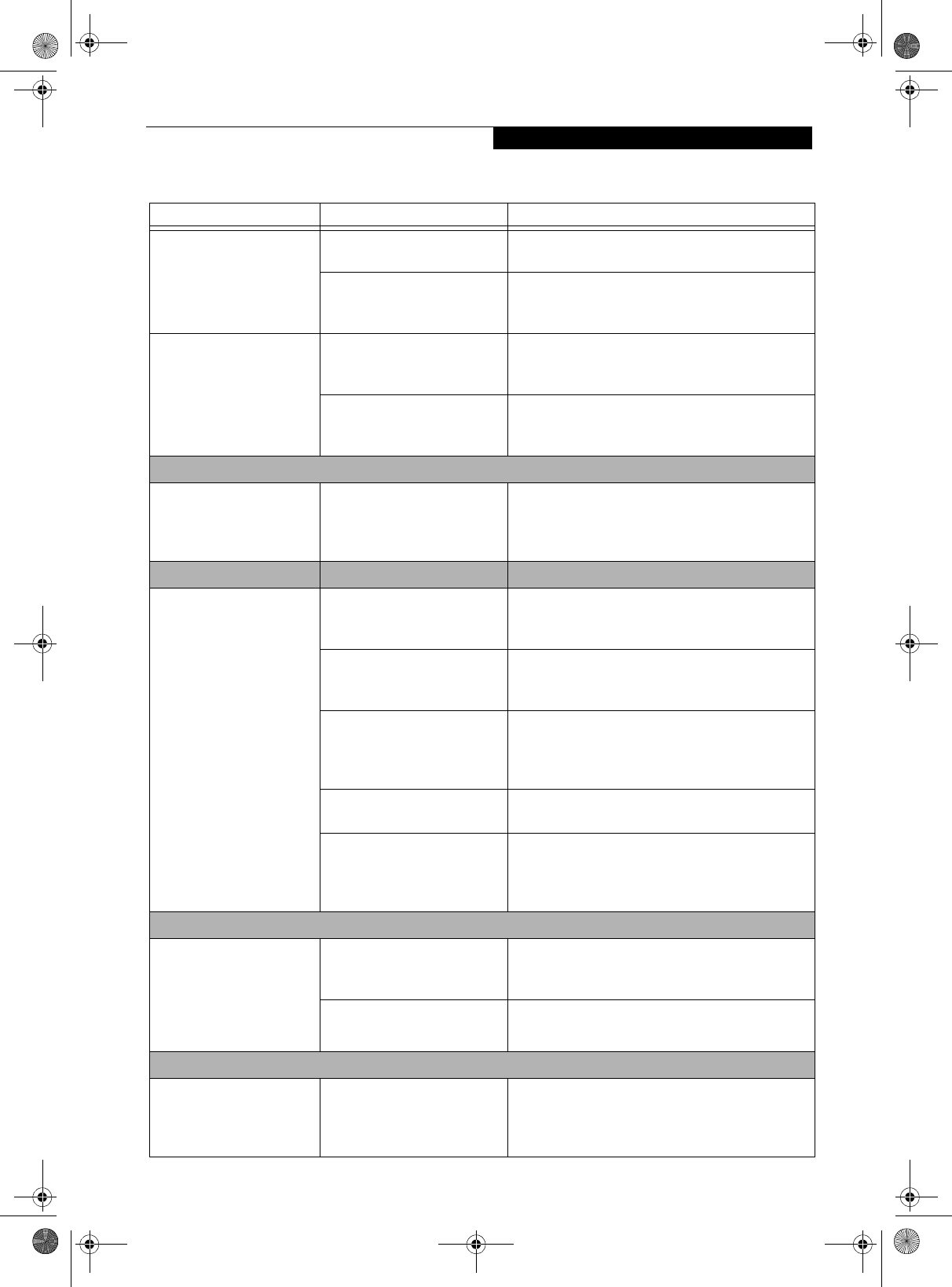
55
Troubleshooting
You have installed an
external keyboard or
mouse, and it does not
seem to work.
Your external device is not
properly installed.
Re-install your device. See “Device Ports” on page 48.
Your operating system soft-
ware is not set up with the
correct driver for that device.
Check your device and operating system docu-
mentation and activate the proper driver.
You have connected an
external keyboard or a
mouse and it seems to be
locking up the system.
Your operating system soft-
ware is not set up with the
correct driver for that device.
Check your device and operating system
documentation and activate the proper driver.
Your system has crashed. Try to restart your Tablet PC. If that fails, turn off
the power by pressing the suspend/resume button
for at least 10 seconds, and then power back on.
Pen Input Problems
Cursor is not tracking the
pen
The system may be
uncalibrated
If the cursor on the screen appears to be misaligned
with the pen or is not accurately tracking the pen,
calibrate the pen. See “Calibrating the Pen” on
page 27.
Infrared Problems
Infrared data transfer is not
working
The IrDA port on the system
can’t “see” the IrDA port on
the other device.
Move the system so that there is a direct line-of-sight
path between the two ports.
The system and the other
device are too far from each
other.
Move the system and the device so that they are
three feet or less from each other.
The viewing angle between the
devices is too great.
The viewing angle between the system port and the
device port cannot be more than 15 degrees from a
center line between the IrDA port on the Tablet PC
and the IrDA port on the other device.
You are using an old version of
IrDA.
The device with which you are trying to communi-
cate must be compliant with IrDA standard 1.1.
There are possibly problems in
one or both devices.
Go to Start -> (All) Programs -> Accessories ->
Communications -> New Connection Wizard.
Verify that "Set up an advanced connection" is
checked and follow the on-screen instructions.
Memory Problems
Your Power On screen, or
Info menu of the BIOS
setup utility information,
does not show the correct
amount of installed
memory.
Your memory upgrade module
is not properly installed.
Turn off your Tablet PC. Remove and re-install your
memory upgrade module. See “Memory Upgrade
Module” on page 43.
You have a memory failure. Check for Power On Self Test (POST) messages.
See “Power On Self Test Messages” on page 61.
Modem Problems
Messages about modem
operation.
Messages about modem
operation are generated by
whichever modem application
is in use.
See your application software documentation for
additional information.
Problem Possible Cause Possible Solutions
T Series.book Page 55 Thursday, July 31, 2003 10:49 AM
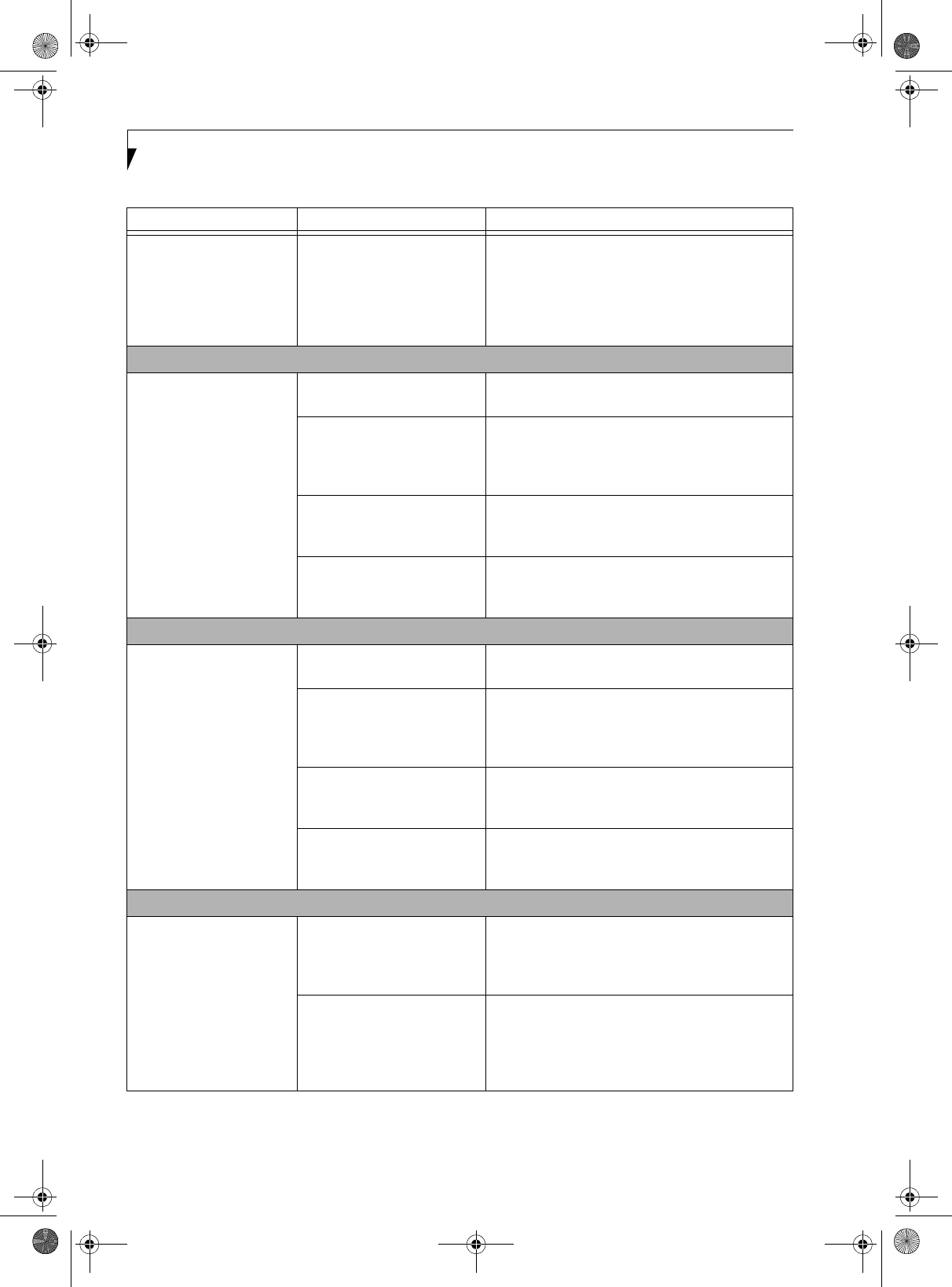
56
LifeBook T Series Tablet PC - Section Five
Modem does not appear to
work.
Modem may not have been
intialized.
Verify that the modem has been initialized by the
operating system. TO do so, right-click on My
Computer and select the Hardware tab. Click
[Device Manager] and click on the "+" symbol that
appears next to Modems. Verify that your device is
listed as installed.
USB Device Problems
You have installed a USB
device, but your Tablet PC
does not recognize the
device, or the device does
not seem to work properly.
The device is not properly
installed.
Remove and re-install the device. See “Device Ports”
on page 48.
The device may have been
installed while an application
was running, so your Tablet PC
is not aware of its installation.
Close the application and restart your Tablet PC.
Yo u r s of tw are m a y n o t h ave
the correct software driver
active.
See your software documentation and activate the
correct driver.
Your device and another device
are assigned the same
I/O address.
Check all I/O addresses located within the BIOS
setup utility and any other installed hardware or
software to make sure there are no duplications.
PC Card Problems
A card inserted in the PC
Card slot does not work or
is locking up the system.
The card is not properly
installed.
Remove and re-install the card. See “PC Cards” on
page 45.
The card may have been
installed while an application
was running, so your Tablet PC
is not aware of its installation.
Close the application and restart your Tablet PC.
Yo u r s of tw are m a y n o t h ave
the correct software driver
active.
See your software documentation and activate the
correct driver.
Your PC Card device and
another device are assigned the
same I/O address.
Check all I/O addresses located within the BIOS
setup utility and any other installed hardware or
software to make sure there are no duplications.
Power Failures
You turn on your Tablet PC
and nothing seems to
happen.
The installed battery is
completely discharged or there
is no power adapter (AC or
Auto/Airline) installed.
Check the Status Indicator Panel to determine the
presence and condition of the battery. See “Status
Indicator Panel” on page 15. Install a charged
battery or a Power adapter.
The battery is installed but is
faulty.
Use the Status Indicator Panel to verify the presence
and condition of the battery. See “Status Indicator
Panel” on page 15. If a battery is indicating a short,
remove that battery and operate from another
power source or replace that battery.
Problem Possible Cause Possible Solutions
T Series.book Page 56 Thursday, July 31, 2003 10:49 AM
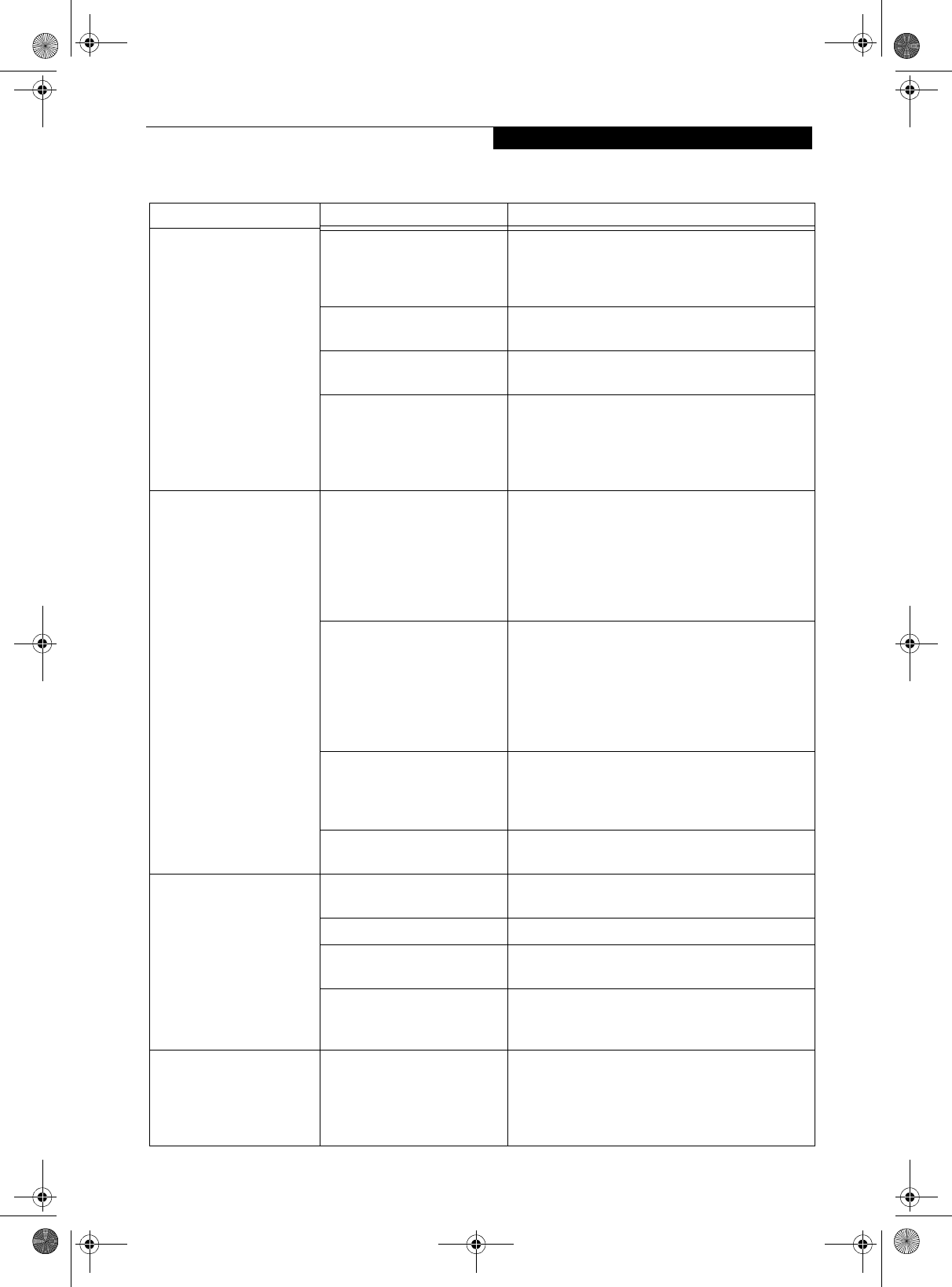
57
Troubleshooting
You turn on your Tablet PC
and nothing seems to
happen.
(continued)
The battery is low. Check the Status Indicator Panel to determine the
presence and condition of the battery. See “Status
Indicator Panel” on page 15. Use a Power adapter
until the battery is charged.
The AC or auto/airline adapter
is not plugged in properly.
Verify that your adapter is connected correctly. See
“Power Sources” on page 33.
The Power adapter (AC or
auto/airline) is faulty.
Try a different Power adapter or install a charged
optional second battery.
The Power adapter (AC or
auto/airline) has no power
from the AC outlet, airplane
seat jack, or the car’s cigarette
lighter.
Move the AC cord to a different outlet, check for a
line switch or tripped circuit breaker for the AC
outlet. If you are using an auto/airline adapter in a
car make sure the ignition switch is in the On or
Accessories position.
Your Tablet PC turns off all
by itself.
The power management
parameters are set for auto
timeouts which are too short
for your operating needs.
Press any button on the keyboard, or move the
mouse to restore operation. If that fails, push the
Suspend/Resume button. Check your power
management settings, or close your applications
and go to the Power Savings menu of the setup
utility to adjust the timeout values to better suit
your operation needs.
You are operating on battery
power only and have ignored a
low battery alarm until the
battery is at the dead battery
state and your machine has
gone into Dead Battery
Suspend mode.
Install a power adapter and then push the Suspend/
Resume button. See “Power Sources” on page 33.
You have a battery failure. Verify the condition of the battery using the
Status Indicator panel, and replace or remove
any battery that is shorted. See “Status Indicator
Panel” on page 15.
Your power adapter has failed
or lost its power source.
Make sure the adapter is plugged in and the outlet
has power.
Your Tablet PC will not
work on battery alone.
The battery is dead. Replace the battery with a charged one or install
a Power adapter.
No battery is installed. Install a charged battery.
The battery is improperly
installed.
Verify that the battery is properly connected
by re-installing them.
Your battery is faulty. Verify the battery condition using the Status Indi-
cator panel and replace or remove any battery that is
shorted. See “Status Indicator Panel” on page 15.
The battery seems to
discharge too quickly.
You are running an application
that uses a great deal of power
due to frequent hard drive or
CD-ROM access, or use of a
modem or LAN PC card.
Use a power adapter for this application when at all
possible.
Problem Possible Cause Possible Solutions
T Series.book Page 57 Thursday, July 31, 2003 10:49 AM
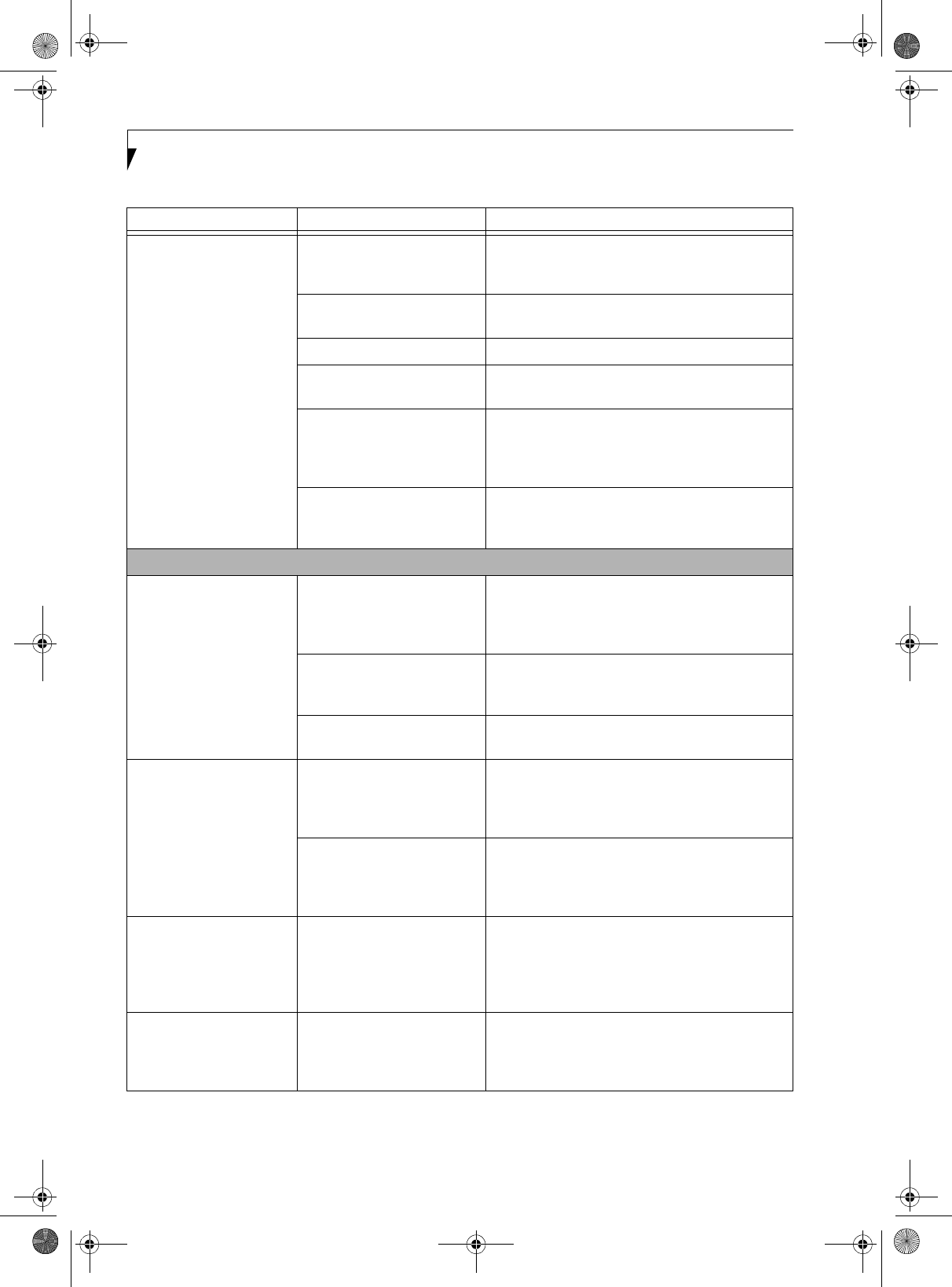
58
LifeBook T Series Tablet PC - Section Five
The battery seems to
discharge too quickly.
(continued)
The power savings features
may be disabled.
Check the power management and/or setup utility
settings in the Power Savings menu and adjust
according to your operating needs.
The brightness is turned all
the way up.
Turn down the brightness adjustment. The higher
the brightness the more power your display uses.
The battery is very old. Replace the battery.
The battery has been exposed
to high temperatures.
Replace the battery.
The battery is too hot or too
cold.
Restore the Tablet PC to normal operating tempera-
ture. The Charging icon on the Status Indicator
panel will flash when the battery is outside its
operating range.
The AC Adapter is defective. Replace with another AC Adapter to see if the
problem persists. Replace any defective AC
Adapters.
Shutdown and Startup Problems
The Suspend/Resume
button does not work.
The Suspend/Resume button
is disabled from the Advanced
submenu of the Power menu
of the setup utility.
Enable the button from the setup utility.
You did not hold the button
in long enough.
Hold the button longer. This may need to be a few
seconds if your application is preventing the CPU
from checking for button pushes.
There may be a conflict with
the application software.
Close all applications and try the button again.
The system powers up, and
displays power-on informa-
tion, but fails to load the
operating system.
The boot sequence settings of
the setup utility are not
compatible with your
configuration.
Set the operating source by pressing the [F2] key
while the Fujitsu logo is on screen, entering the
setup utility and adjusting the source settings from
the Boot menu. See “BIOS Setup Utility” on page 34.
You have a secured system
requiring a password to load
your operating system.
Make sure you have the right password. Enter the
setup utility and verify the Security settings and
modify them as accordingly. See “BIOS Setup
Utility” on page 34.
An error message is
displayed on the screen
during the Tablet PC boot
sequence.
Power On Self Test (POST) has
detected a problem.
See the Power On Self Test (POST) messages to
determine the meaning and severity of the problem.
Not all messages are errors; some are simply status
indicators. See “Power On Self Test Messages” on
page 61.
Your system display won’t
turn on when the system is
turned on or when the
system has resumed.
The system may be password-
protected.
Check the status indicator panel to verify that the
Security icon is blinking. If it is blinking, enter your
password.
Problem Possible Cause Possible Solutions
T Series.book Page 58 Thursday, July 31, 2003 10:49 AM
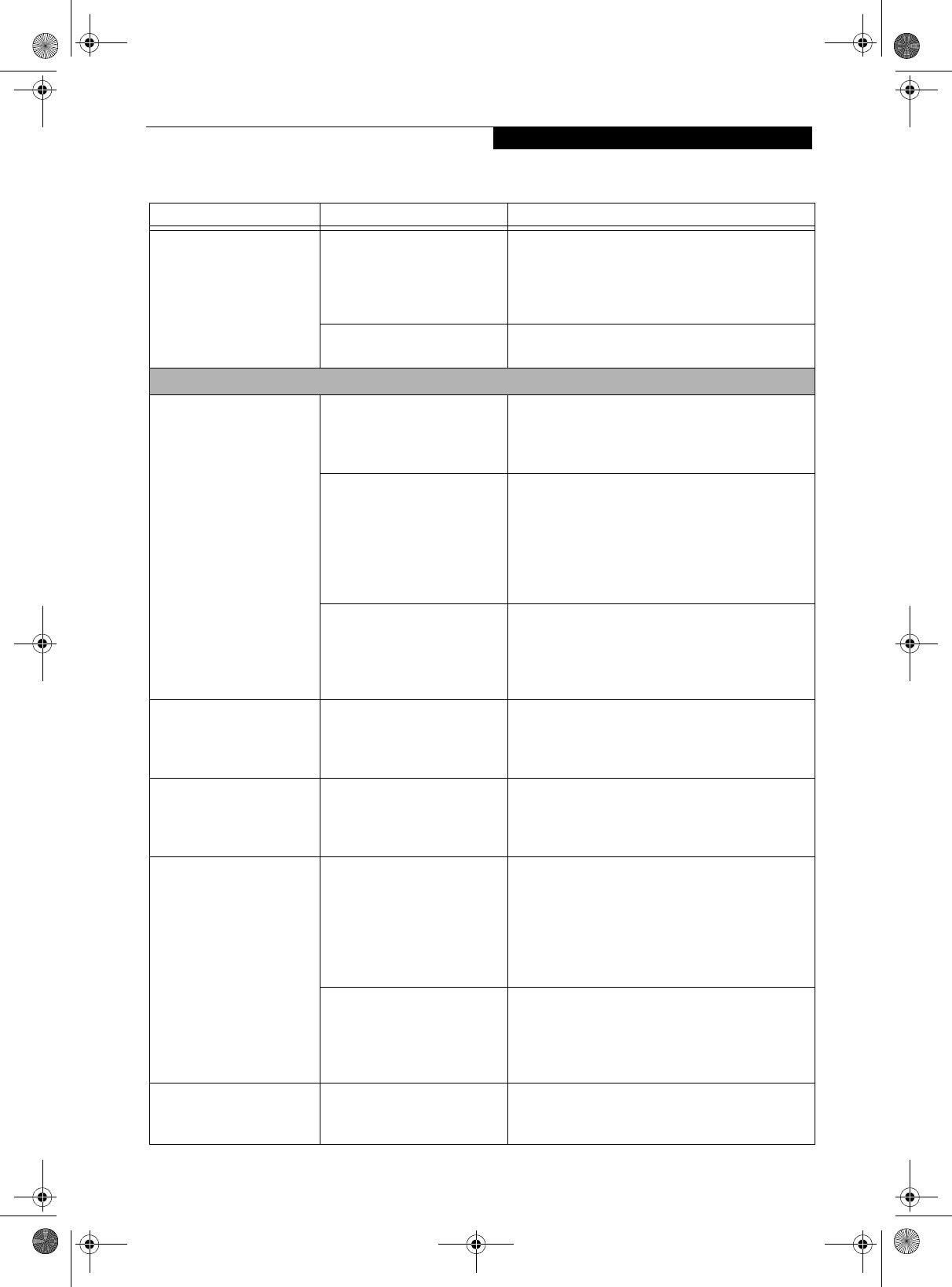
59
Troubleshooting
Your Tablet PC appears to
change setup parameters
when you start it.
BIOS setup changes were not
saved when you made them
and exited the BIOS setup
utility returning it to
previous settings.
Make sure you select Save Changes And Exit when
exiting the BIOS setup utility.
The BIOS CMOS back-up
battery has failed.
Contact your support representative for repairs.
This is not a user-serviceable part.
Video Problems
The built-in display is
blank when you turn on
your Tablet PC.
The angle of the display and
the brightness settings are not
adequate for your lighting
conditions.
Move the display and the brightness control until
you have adequate visibility.
The optional Port Replicator is
attached, an external monitor
is plugged in, and the Tablet
PC is set for an external
monitor only.
Pressing [F10] while holding down the [Fn] key
allows you to change your selection of where to
send your display video. Each time you press the
combination of keys you will step to the next
choice. The choices, in order are: built-in display
only, external monitor only, both built-in display
and external monitor.
The power management
timeouts may be set for very
short intervals and you failed
to notice the display come on
and go off again.
Press any button the keyboard, or move the mouse
to restore operation. If that fails, push the Suspend/
Resume button. (The display may be shut off by
Standy mode, Auto Suspend or Video Timeout)
The Tablet PC turned on
with a series of beeps and
your built-in display is
blank.
Power On Self Test (POST)
has detected a failure which
does not allow the display
to operate.
Contact your support representative.
Your system display won’t
turn on when the system is
turned on or when the
system has resumed.
The system may be password-
protected.
Check the status indicator panel to verify that the
Security icon is blinking. If it is blinking, enter your
password.
The display goes blank by
itself after you have been
using it.
The Tablet PC has gone into
Video Timeout, Standby
Mode, or Hibernate Mode
because you have not used it
for a period of time.
Press a button on the keyboard, or move the mouse
to restore operation. If that fails, push the Suspend/
Resume button. Check your power management
settings, or close your applications and go to the
Power Savings menu of the setup utility to adjust the
timeout values to better suit your operation needs.
See “BIOS Setup Utility” on page 34.
The power management time-
outs may be set for very short
intervals and you failed to
notice the display come on
and go off again.
Press any button on the keyboard, or move the mouse
to restore operation. If that fails, push the Suspend/
Resume button. (The display may be shut off by
Standby Mode, Auto Suspend or Video Timeout)
The display does not close. A foreign object, such as a
paper clip, is stuck between the
display and the keyboard.
Remove all foreign objects from the keyboard.
Problem Possible Cause Possible Solutions
T Series.book Page 59 Thursday, July 31, 2003 10:49 AM
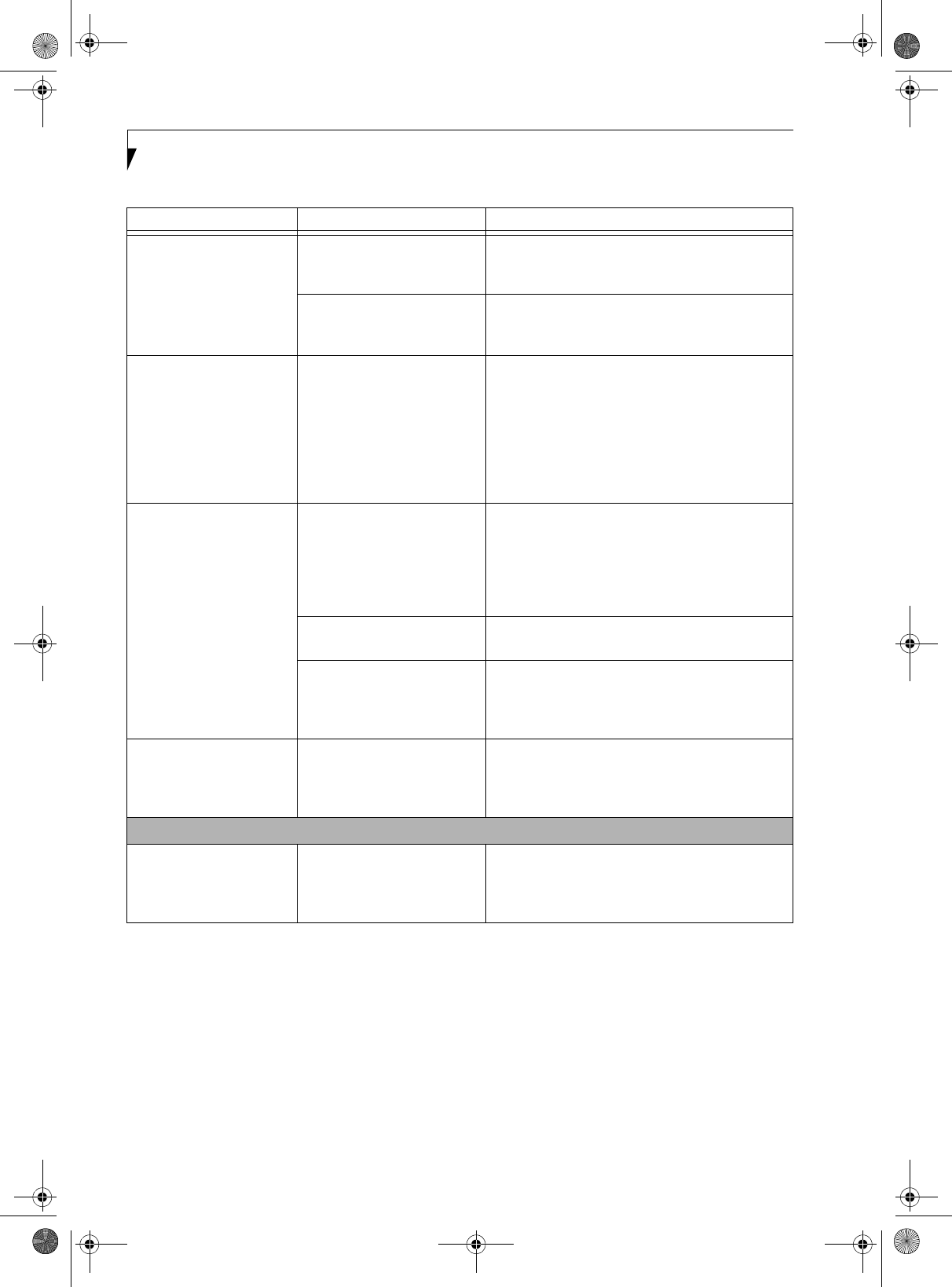
60
LifeBook T Series Tablet PC - Section Five
The display has bright or
dark spots.
If the spots are very tiny and
few in number, this is normal
for a large LCD display.
This is normal; do nothing.
If the spots are numerous or
large enough to interfere with
your operation needs.
The display needs technical diagnosis; contact your
support representative.
The application display
uses only a portion of your
screen and is surrounded
by a dark frame.
You are running an application
that does not support 800 x
600/1024 x 768 pixel resolution
display and display compres-
sion is enabled.
When compensation is disabled, a clearer but
smaller display for applications that do not support
800 x 600/1024 x 768 pixel resolution will result. You
can fill the screen but have less resolution by
changing your compensation setting. (See the Video
Features submenu, located within the Advanced
menu of the BIOS. See “BIOS Setup Utility” on
page 34.
You have connected an
external monitor and it
does not display any
information.
Your BIOS setup is not set to
enable your external monitor.
Try toggling the video destination by pressing [Fn]
and [F10] together, or check your BIOS setup and
enable your external monitor. (See the Video
Features submenu, located within the Advanced
Menu of the BIOS. See “BIOS Setup Utility” on
page 34.
Your external monitor is not
properly installed.
Reinstall your device. See “External Monitor Port” on
page 49.
Your operating system soft-
ware is not set up with the
correct software driver for
that device.
Check your device and operating system
documentation and activate the proper driver.
You have connected an
external monitor and it
does not come on.
Your external monitor may not
be compatible with your Tablet
PC.
See your monitor documentation and the
External Monitor Support portions of the
Specifications section. See “Specifications” on
page 73.
Miscellaneous Problems
An error message is
displayed on the screen
during the operation of
an application.
Application software often
has its own set of error
message displays.
See your application manual and help displays
screens for more information. Not all messages are
errors some may simply be status.
Problem Possible Cause Possible Solutions
T Series.book Page 60 Thursday, July 31, 2003 10:49 AM

61
Troubleshooting
POWER ON SELF TEST MESSAGES
The following is an alphabetic list of error-and-status
messages that Phoenix BIOS and/or your operating
system can generate and an explanation of each message.
Error messages are marked with an *. If an error
message is displayed that is not in this list, write it down
and check your operating system documentation both
on screen and in the manual. If you can find no
reference to the message and its meaning is not clear,
contact your support representative for assistance.
nnnn Cache SRAM Passed
Where nnnn is the amount of system cache in kilobytes
successfully tested by the Power On Self Test. (This can
only appear if you have an SRAM PC Card installed.)
*Extended RAM Failed at offset: nnnn
Extended memory not working or not configured prop-
erly. If you have an installed memory upgrade module,
verify that the module is properly installed. If it is prop-
erly installed, you may want to check your Windows
Setup to be sure it is not using unavailable memory
until you can contact your support representative.
nnnn Extended RAM Passed
Where nnnn is the amount of memory in kilobytes
successfully tested.
*Failing Bits: nnnn The hex number nnnn
This is a map of the bits at the memory address (in
System, Extended, or Shadow memory) which failed the
memory test. Each 1 (one) in the map indicates a failed
bit. This is a serious fault that may cause you to lose data
if you continue. Contact your support representative.
*Fixed Disk x Failure or Fixed Disk Controller
Failure (where x = 1-4)
The fixed disk is not working or not configured prop-
erly. This may mean that the hard drive type identified
in your setup utility does not agree with the type
detected by the Power On Self Test. Run the setup utility
to check for the hard drive type settings and correct
them if necessary. If the settings are OK and the message
appears when you restart the system, there may be a
serious fault which might cause you to lose data if you
continue. Contact your support representative.
*Invalid NVRAM media type
Problem with NVRAM access. In the unlikely case that
you see this message you may have some display prob-
lems. You can continue operating but should contact
your support representative for more information.
*Keyboard controller error
The keyboard controller test failed. You may have to
replace your keyboard or keyboard controller but may
be able to use an external keyboard until then. Contact
your support representative.
*Keyboard error
Keyboard not working. You may have to replace your
keyboard or keyboard controller but may be able to
use an external keyboard until then. Contact your
support representative.
*Keyboard error nn
BIOS discovered a stuck key and displays the scan code
for the stuck key. You may have to replace your keyboard
but may be able to use an external keyboard until then.
Contact your support representative.
*Operating system not found
Operating system cannot be located on either drive A: or
drive C: Enter the setup utility and see if both the fixed
disk, and drive A: are properly identified and that the
boot sequence is set correctly. Unless you have changed
your installation greatly, the operating system should be
on drive C:. If the setup utility is correctly set, your hard
drive may be corrupted and your system may have to be
re-installed from your back up media.
*Parity Check 1 nnnn
Parity error found in the system bus. BIOS attempts to
locate the address and display it on the screen. If it
cannot locate the address, it displays "????". This is a
potentially data destroying failure. Contact your
support representative.
*Parity Check 2 nnnn
Parity error found in the I/O bus. BIOS attempts to
locate the address and display it on the screen. If it
cannot locate the address, it displays "????". This is a
potentially data destroying failure. Contact your
support representative.
*Press <F1> to resume, <F2> to SETUP
Displayed after any recoverable error message. Press
the [F1] key to continue the boot process or the [F2]
key to enter Setup and change any settings.
*Previous boot incomplete –
Default configuration used
Previous Power On Self Test did not complete success-
fully. The Power On Self Test will load default values and
offer to run Setup. If the previous failure was caused by
incorrect values and they are not corrected, the next
boot will likely fail also. If using the default settings does
not allow you to complete a successful boot sequence,
you should turn off the power and contact your support
representative.
T Series.book Page 61 Thursday, July 31, 2003 10:49 AM
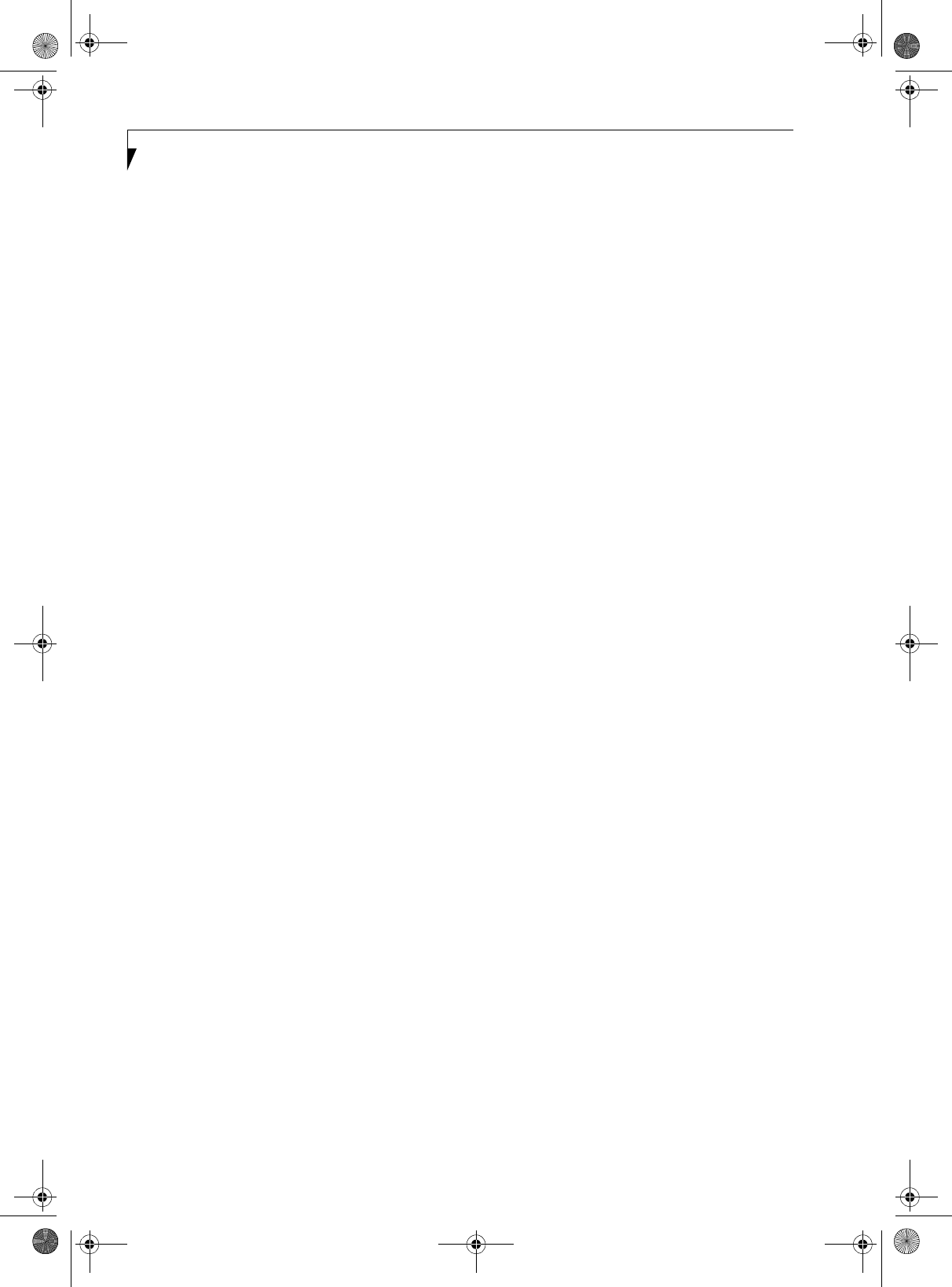
62
LifeBook T Series Tablet PC - Section Five
*Real time clock error
Real-time clock fails BIOS test. May require board repair.
Contact your support representative.
*Shadow RAM Failed at offset: nnnn
Shadow RAM failed at offset nnnn of the 64k block at
which the error was detected. You are risking data
corruption if you continue. Contact your support repre-
sentative.
nnnn Shadow RAM Passed
Where nnnn is the amount of shadow RAM in kilobytes
successfully tested.
*System battery is dead – Replace and run SETUP
The BIOS CMOS RAM memory hold up battery is dead.
This is part of your BIOS and is a board mounted
battery which requires a support representative to
change. You can continue operating but you will have to
use setup utility default values or reconfigure your setup
utility every time you turn off your Tablet PC.
System BIOS shadowed
System BIOS copied to shadow RAM.
*System CMOS checksum bad – run SETUP
BIOS CMOS RAM has been corrupted or modified
incorrectly, perhaps by an application program that
changes data stored in BIOS memory. Run Setup and
reconfigure the system.
*System RAM Failed at offset: nnnn
System memory failed at offset nnnn of in the 64k block
at which the error was detected. This means that there is
a fault in your built-in memory. If you continue to
operate, you risk corrupting your data. Contact your
support representative for repairs.
nnnn System RAM Passed
Where nnnn is the amount of system memory in
kilobytes successfully tested.
*System timer error
The timer test failed. The main clock that operates the
computer is faulty. Requires repair of system board.
Contact your support representative for repairs.
UMB upper limit segment address: nnnn
Displays the address of the upper limit of Upper
Memory Blocks, indicating released segments of the
BIOS memory which may be reclaimed by a virtual
memory manager.
Video BIOS shadowed
Video BIOS successfully copied to shadow RAM.
MODEM RESULT CODES
The operating system and application software that is
factory installed detects the modem characteristics and
provides the necessary command strings to operate the
modem. The internal modem operation is controlled by
generic AT commands from the operating system and
application software. The standard long form result
codes may, in some cases, be displayed on your screen to
keep you informed of the actions of your modem. The
operating system and application software may suppress
display of the result codes.
Examples of result codes are:
■OK
■NO CARRIER
■NO DIALTONE
■CONNECT 53000 (Connection complete
at 53,000 bps.)
■ERROR
■FAX
■RING (This means an incoming call.)
■BUSY
■NO ANSWER
When using the internal modem with applications that
are not factory installed refer to the application
documentation.
T Series.book Page 62 Thursday, July 31, 2003 10:49 AM
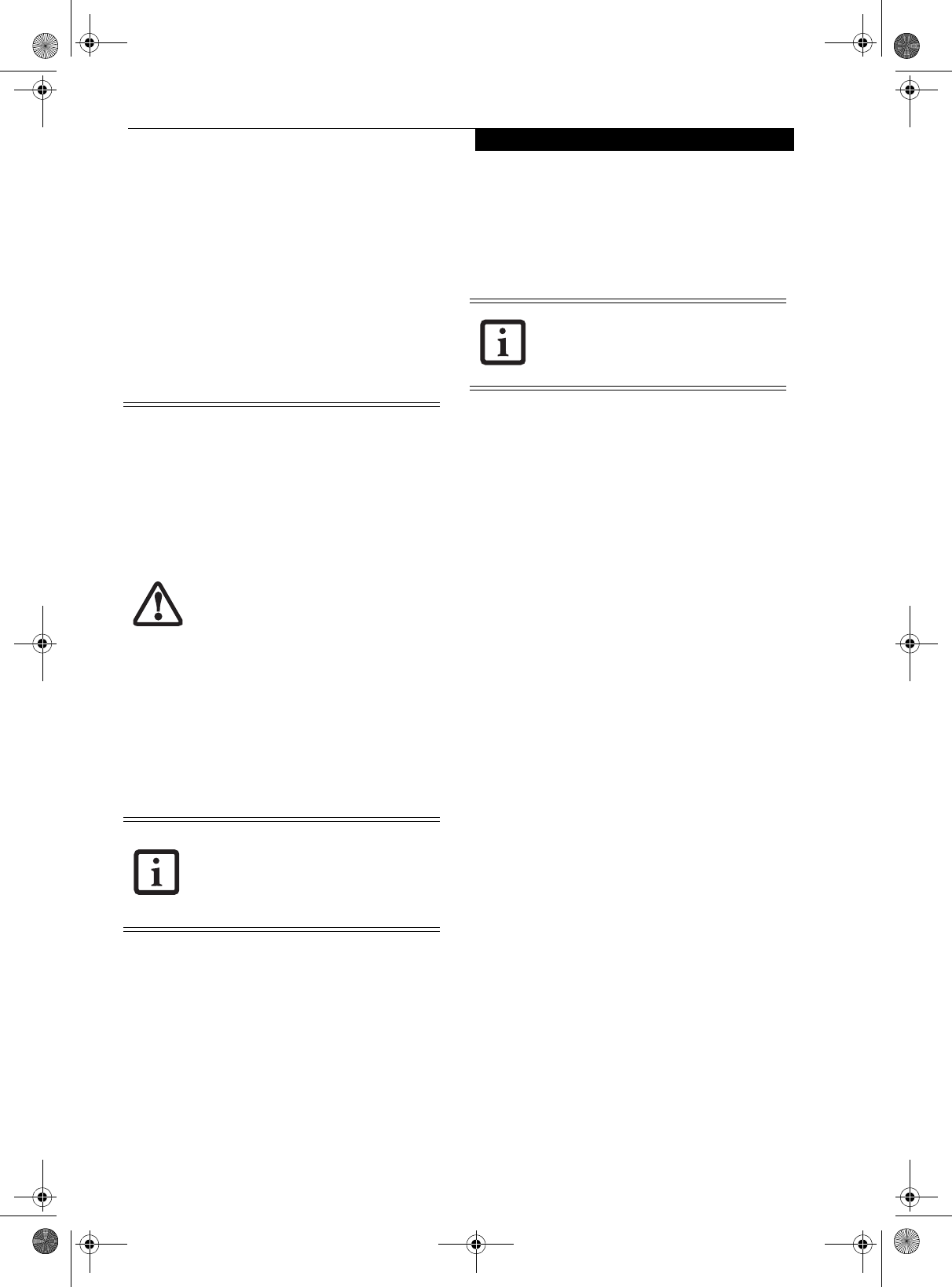
63
Troubleshooting
Restoring Your
Pre-installed Software
The Drivers and Applications Restore (DAR) CD
contains:
■Sets of device drivers and Fujitsu utilities (in specific
directories) that are unique to your LifeBook note-
book configuration for use as documented below.
■A link to the Drive Image Special Edition (DISE)
utility on your hard disk drive.
■Read-me files that provide additional use information
for items on this CD-ROM.
DRIVE IMAGE SPECIAL EDITION (DISE)
PowerQuest Drive Image Special Edition (DISE)
provides a way to restore your computer if you experi-
ence a hard disk crash or other system failure. Fujitsu has
used DISE to create an image of everything installed on
the computer at the time you purchased it. The image is
saved on a separate partition on the hard disk. You can
use DISE to restore the factory image and return your
computer to the state in which it was shipped from
Fujitsu.
Although it is not necessary, you can use DISE to store
additional image files you create. For example, if you
install several applications and save data files on your
hard disk, you can create a new image that includes them
and then save that image file on the hard disk. Then, in
the event of a hard disk failure, you can restore the image
that includes the applications and data files you use.
Creating a Backup Image
You can create a system backup image of your C:\ drive
at any time. The C:\ partition must be a FAT, FAT32, or
NTFS partition, and it must be directly before the
backup partition on your hard disk.
There are two ways to implement the DISE utility: when
booting up the system, or from the desktop.
Creating a backup image when booting up
Before creating an image at boot-up, you must first
change the boot-up priority in the BIOS so that the
system will go to the media drive first, rather than trying
to boot-up from the hard drive or an external floppy
disk drive.
To c ha ng e th e b oo t - u p p r i or i t y :
1. Start your system and press the [F2] key when the
Fujitsu logo appears. You will enter the BIOS Setup
Utility.
2. Using the arrow keys, go to the Boot menu.
3. Arrow down to the Boot Device Priority submenu
and press [Enter].
4. Arrow down to the CD-ROM drive in the list, and
press the space bar (or the + key) to move the CD-
ROM drive to the top of the list. (The system
attempts to boot from the devices in the order in
which they are listed.)
5. Press [F10], then click on [Yes] to exit the BIOS
Setup Utility and return to the boot process.
After you have changed the boot priority, you can create
a backup image when you are booting up:
1. Install the DAR CD in the drive prior to booting up.
When bootup begins, a message appears informing
you that if you proceed, you will be able to:
■Create a new backup of drive C
■Restore a previous backup, or,
■Restore the original factory image.
Note that creating a new backup will overwrite any
previous backups, and restoring a backup or factory
image will overwrite all information on the hard drive,
including saved files.
■In order to install applications and/or
drivers from the DAR CD, you will need
to connect an external CD drive to your
system.
■If the DAR CD is in the drive when you
boot up the system, and the Boot
Sequence is set in the BIOS to boot from
the CD drive first (see “Creating a backup
image when booting up” on page 63), a
message will appear informing you that if
you proceed, you will have a choice of:
creating a new backup of drive C:, restor-
ing a previous backup, or restoring the
original factory image.
Note that creating a new backup will
overwrite any previous backups, and
restoring a backup or factory image will
overwrite all information on the hard
drive, including saved files. If you wish to
install drivers or applications only from
the CD, remove the disk from the drive,
reboot the system, and insert the CD
after Windows has started.
If you have access to the internet, visit the
Fujitsu Support web site at
www.fujitsupc.com to check for the most
current information, drivers and hints on
how to perform recovery and system
updates.
Using the DISE feature will reduce the
amount of usable disk space on your hard
disk drive.
T Series.book Page 63 Thursday, July 31, 2003 10:49 AM
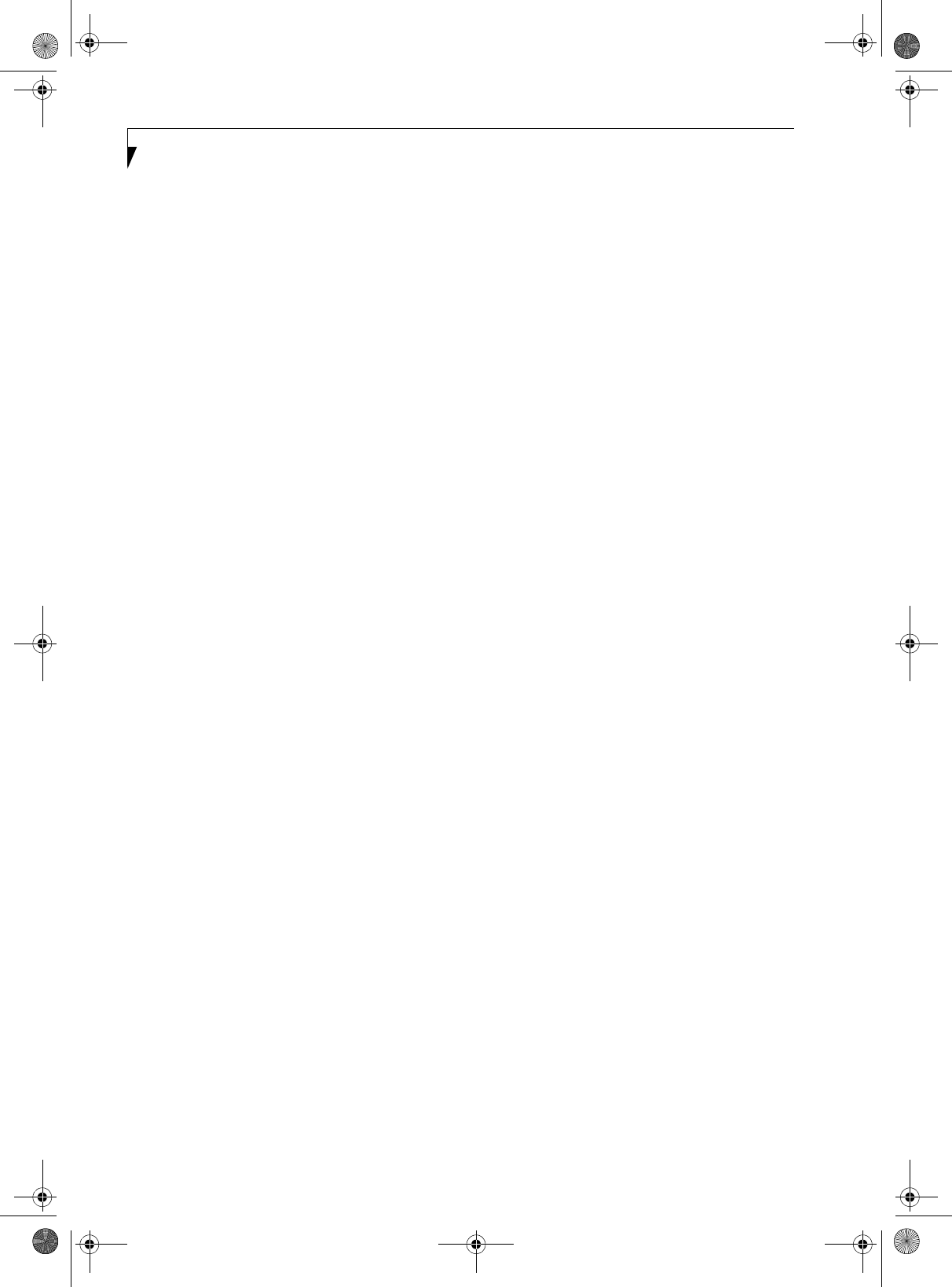
64
LifeBook T Series Tablet PC - Section Four
2. After you click [Y]es. You will be presented with two
options: [Create New Backup] and [Restore
Backup].
After you click [Create New Backup], follow the on-
screen instructions. By selecting [Create New
Backup], a new image will be written to your backup
partition. This will overwrite any previously created
image.
Creating a backup image from the desktop
To create a backup image from the desktop, select Drive
Image SE from the Program list. You will initially be
prompted to create a backup diskette. It is not necessary
to create the backup diskette, since the DAR CD
performs the same function.
1. At the Drive Image Special Edition main screen,
click Options> Create New Backup. DISE displays a
warning that it must go to DOS to create the image.
2. Click Ye s .
DISE creates an image file in the backup partition. If
you created a backup image previously, the new
image overwrites the old one.
Enlarging the Backup Partition
If there is not enough unused space in the backup parti-
tion on your hard disk, DISE will resize the partition.
DISE will display the minimum, maximum, and recom-
mended sizes for the backup partition. You choose the
size you want.
DISE takes the space from the FAT, FAT32, or NTFS
partition that you are backing up. If there is not enough
unused space in that partition to take, you will not be
able to resize the backup partition and create an image
file. You can delete files from the FAT, FAT32, or NTFS
partition to create more unused space on the hard disk.
Restoring a Backup Image
You can restore either a factory image or a backup image
you created. Be aware that restoring a backup image will
replace the contents of the C:\ partition with the image
you restore.
1. Disable virus protection software. If virus protection
software is enabled, DISE will lock up.
2. From the DISE main window, click Options >
Restore Backup to restore an image you created, or
click Options > Restore Factory Backup to restore
the factory image.
DISE shuts down to DOS and restores the image file.
Re-Installing Individual Drivers and Applications
The Drivers and Application CD can be used to selec-
tively re-install drivers and/or applications that may have
been un-installed or corrupted.
To re-install drivers and/or applications:
1. Boot up the system and insert the DAR CD after
Windows has started. A Fujitsu Welcome screen is
displayed after the CD is inserted.
2. From the left frame of the Welcome screen, “System
Components” and “3rd Party Applications” can be
selected. System Components are those drivers and
utilities that have been developed by Fujitsu; 3rd
Party Applications are applications developed by
other vendors.
Installing System Components
1. To install system components, click on “System
Components” in the left frame of the Welcome
screen. A list of utilities and drivers will be displayed.
Select one or more items from the list, or click
[Select All] to select all items in the list. (To de-select
your choices, click the [Clear All] button.
2. Click [Install Selected Subsystems] to install the
selected items.
Installing 3rd Party Applications
1. To install 3rd party applications, click on “3rd Party
Applications” in the left frame of the Welcome
screen. A list of applications will be displayed.
2. Select one of the items from the list, and follow the
instructions that appear on the screen. Note that
only one application may be installed at a time.
3. Repeat step 2 to install additional applications.
T Series.book Page 64 Thursday, July 31, 2003 10:49 AM

65
6
Care and Maintenance
T Series.book Page 65 Thursday, July 31, 2003 10:49 AM
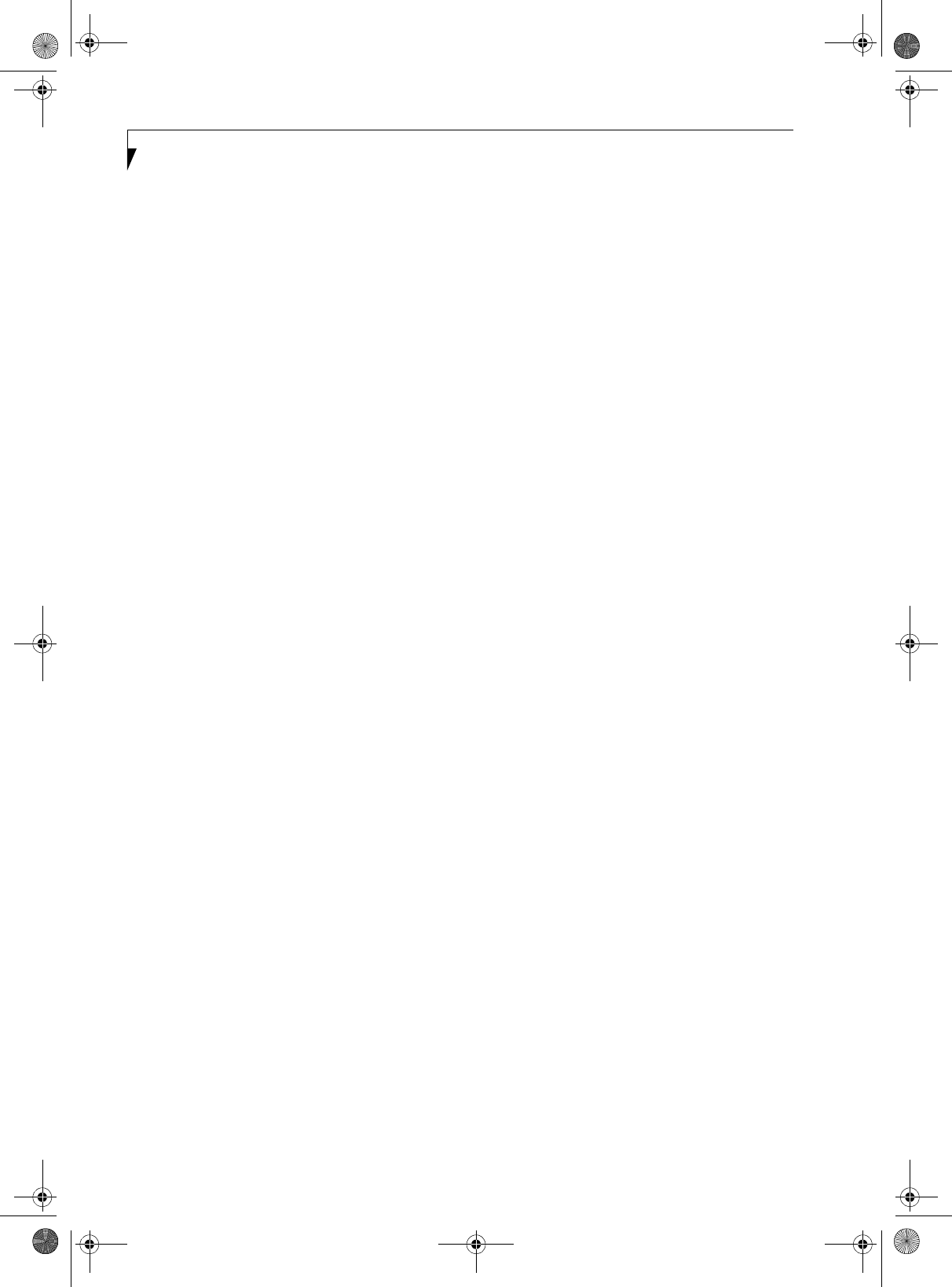
66
LifeBook T Series Tablet PC - Section Six
T Series.book Page 66 Thursday, July 31, 2003 10:49 AM
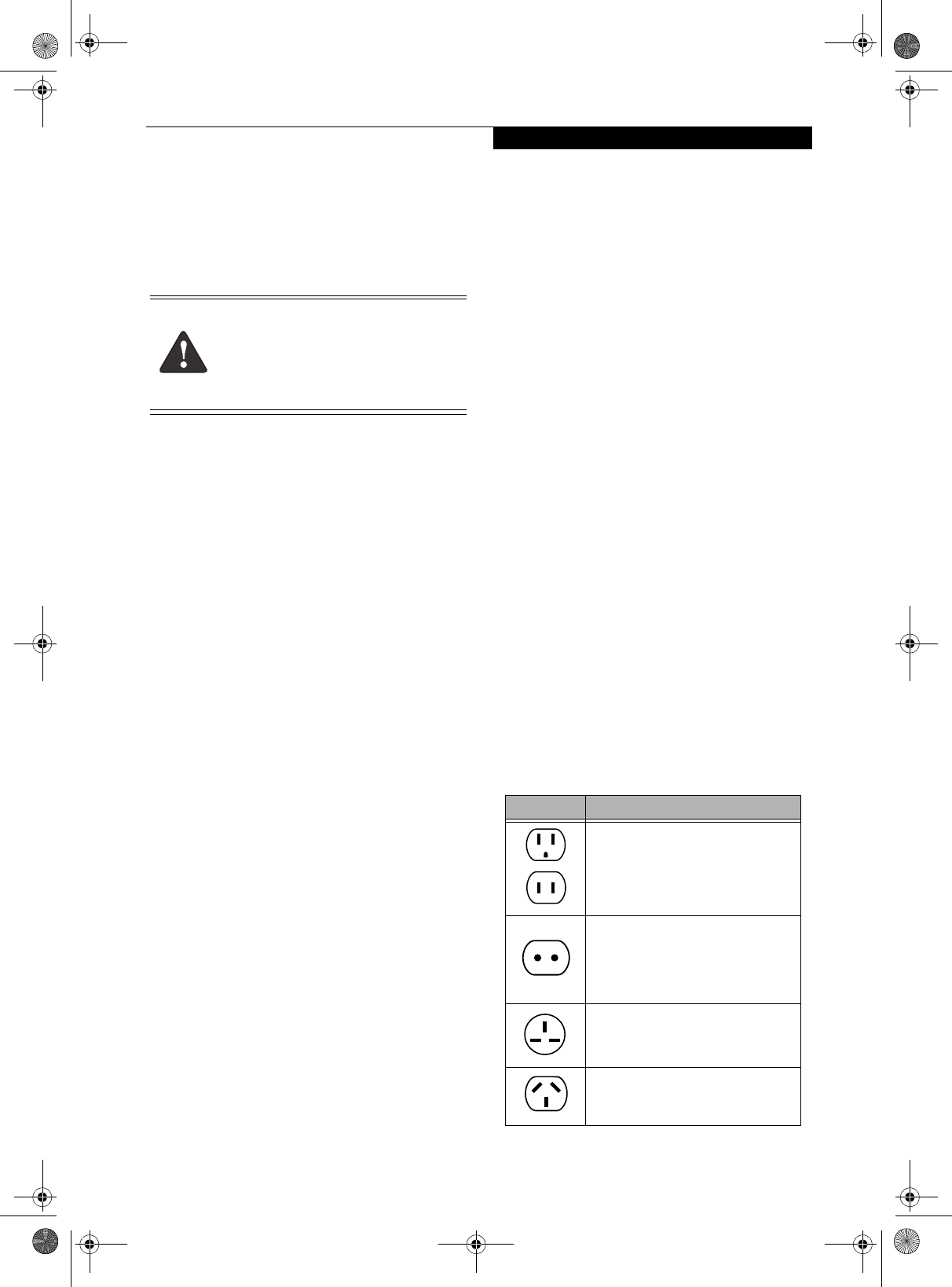
67
Care and Maintenance
Care and Maintenance
If you use your LifeBook T Series Tablet PC carefully,
you will increase its life and reliability. This section
provides some tips for looking after the Tablet PC and
its devices.
LIFEBOOK T SERIES TABLET PC
Caring for your Tablet PC
■Your Tablet PC is a durable but sensitive electronic
device. Treat it with care.
■Make a habit of transporting it in a suitable
carrying case.
■Do not attempt to service the computer yourself. Any
unauthorized service performed on the computer will
void the warranty.
■ Always follow installation instructions closely.
■Keep it away from food and beverages.
■If you accidentally spill liquid on your Tablet PC:
1. Turn it off.
2. Position it so that the liquid can run out.
3. Let it dry out for 24 hours, or longer if needed.
4. If your Tablet PC will not boot after it has dried
out, call your support representative.
■Do not use your Tablet PC in a wet environment (near
a bathtub, swimming pool).
■Always use the AC adapter and batteries that are
approved for your Tablet PC.
■Avoid exposure to sand, dust and other
environmental hazards.
■Do not expose your Tablet PC to direct sunlight for
long periods of time as temperatures above
140° F (60° C) may damage your Tablet PC.
■Keep the covers closed on the connectors and slots
when they are not in use.
■Do not put heavy or sharp objects on the computer.
■If you are carrying your Tablet PC in a briefcase, or
any other carrying case, make sure that there are no
objects in the case pressing on the lid.
■Do not drop your Tablet PC.
■Do not touch the screen with any sharp objects.
Cleaning your Tablet PC
■Always disconnect the power plug. (Pull the plug,
not the cord.)
■Clean your Tablet PC with a damp, lint-free cloth. Do
not use abrasives or solvents.
■Use a soft cloth to remove dust from the screen.
Never use glass cleaners.
Storing your Tablet PC
■If storing your Tablet PC for a month or longer, turn
the Tablet PC off, fully charge the battery, then remove
and store all Lithium ion batteries.
■Store your Tablet PC and batteries separately. If you
store your Tablet PC with a battery installed, the bat-
tery will discharge, and battery life will be reduced. In
addition, a faulty battery might damage the Tablet PC.
■Store your Tablet PC in a cool, dry location.
Temperatures should remain between 13º F (-25º C)
and 140º F (60º C).
Traveling with your Tablet PC
■Do not transport your Tablet PC while it is turned on.
■Do not check your Tablet PC as baggage. Carry it with
you.
■When traveling with the hard drive removed, wrap the
drive in a non-conducting materials (cloth or paper).
If you have the drive checked by hand, be ready to
install the drive if needed. Never put your hard drive
through a metal detector. Have your hard drive hand-
inspected by security personnel. You can however, put
your hard drive through a properly tuned X-ray
machine.
■Take the necessary plug adapters if you're traveling
overseas. Check the following diagram to determine
which adapter you'll need or ask your travel agent.
Figure 6-1.
Electrical equipment may be hazardous if
misused. Operations of this product or
similar products, must always be supervised
by an adult. Do not allow children access to
the interior of any electrical products and
do not permit them to handle any cables.
Outlet Type Location
United States, Canada, Mexico, parts
of Latin America, Japan, Korea, the
Philippines, Taiwan
Russia and the Commonwealth of
Independent States (CIS), most of
Europe, parts of Latin America, the
Middle East, parts of Africa, Hong
Kong, India, most of South Asia
United Kingdom, Ireland, Malaysia,
Singapore, parts of Africa
China, Australia, New Zealand
T Series.book Page 67 Thursday, July 31, 2003 10:49 AM
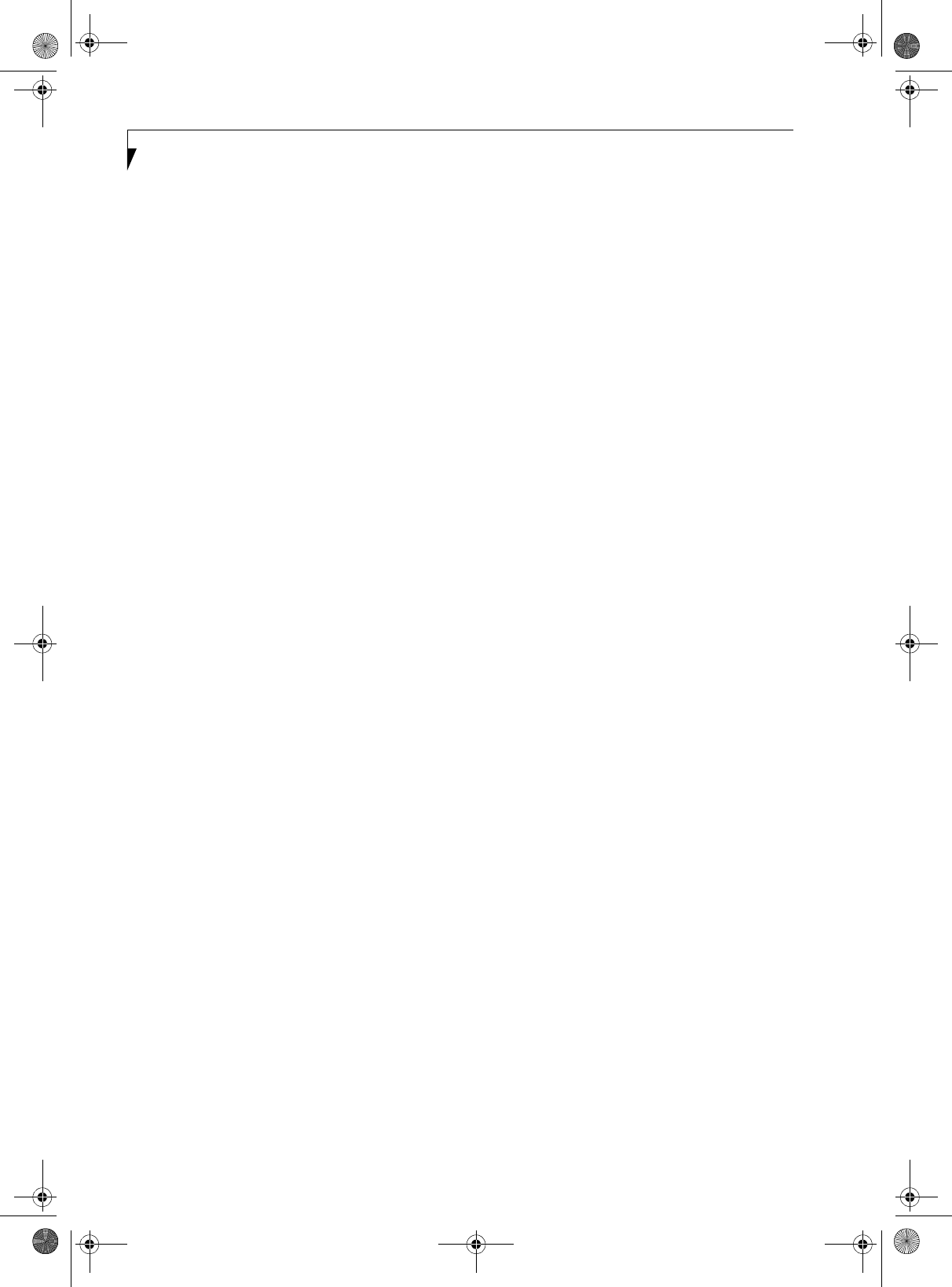
68
LifeBook T Series Tablet PC - Section SIx
KEYBOARD
Caring for your Keyboard
The keyboard of your computer is a very sensitive
instrument. It is made up of many switches that are
activated when you press on the keys. The keyboard is a
major component of the heat dissipation system in a
Tablet PC. Due to heat and size considerations the
keyboard is not sealed. Because the keys are so close
together, it is not easy for the user to see when liquids
have fallen onto the circuitry below the keys.
Attempting to clean the keyboard with a spray on
cleaner or rag soaked with cleaner the liquid can drip
onto the circuitry sight unseen. Once the liquid seeps
between the layers of circuitry, it can cause corrosion or
other damage to the circuits. This can result in keys
which no longer operate, or which, when pressed, record
the wrong characters and other similar failures.
There is no repair for this problem other than replace-
ment. The solution is to become aware of the issue and
take appropriate steps to protect your keyboard.
To clean the keyboard, use a rag dampened slightly with
cleaning solution. Use extreme care to prevent liquid
from dripping between the keys. Spraying directly on the
keys should be avoided. The spray should be applied first
to the cloth, and then the cloth wiped over the keys.
BATTERIES
Caring for your Batteries
■Always handle batteries carefully.
■Do not short-circuit the battery terminals (that is, do
not touch both terminals with a metal object). Do not
carry lose batteries in a pocket or purse where they
may mix with coins, keys, or other metal objects.
Doing so may cause an explosion or fire.
■Do not drop, puncture, disassemble, mutilate or incin-
erate the battery.
■Recharge batteries only as described in this manual
and only in ventilated areas.
■Do not leave batteries in hot locations for more than a
day or two. Intense heat can shorten battery life.
■Do not leave a battery in storage for longer than 6
months without recharging it.
Increasing Battery Life
■Keep brightness to the lowest comfortable level.
■Set the power management for maximum battery life.
■Put your Tablet PC in Standby mode when it is turned
on and you are not actually using it.
■Limit your CD-ROM access.
■Disable the Windows CD auto insert function.
■Always use fully charged batteries.
■Eject PCMCIA cards when not in use.
OPTIONAL FLOPPY DISK DRIVE AND
FLOPPY DISKS
Caring for your Floppy Disks
■Avoid using the floppy disks in damp and
dusty locations.
■Never store a floppy disk near a magnet or
magnetic field.
■Do not use a pencil or an eraser on a disk or
disk label.
■Avoid storing the floppy disks in extremely hot or cold
locations, or in locations subject to severe temperature
changes. Store at temperatures between 50º F (10º C)
and 125º F (52º C).
■Do not touch the exposed part of the disk
behind the metal shutter.
Caring for your optional Optional Floppy Disk
Drive
■To clean, wipe the floppy disk drive clean with a dry
soft cloth, or with a soft cloth dampened with water or
a solution of neutral detergent. Never use benzene,
paint thinner or other volatile material.
■Avoid storing the floppy disk drive in extremely hot or
cold locations, or in locations subject to severe tem-
perature changes. Store at temperatures between
50º F (10º C) and 125º F (52º C).
■Keep the floppy disk drive out of direct sunlight and
away from heating equipment.
■Avoid storing the floppy disk drive in locations subject
to shock and vibration.
■Never use the floppy disk drive with any liquid, metal,
or other foreign matter inside the floppy disk
drive or disk.
■Never disassemble or dismantle your floppy disk drive.
OPTIONAL CD DRIVE AND CDs
Caring for your CDs
CDs are precision devices and will function reliably if
given reasonable care.
■Always store your CDs in its case when it is not in use.
■Always handle CDs by the edges and avoid touching
the surface.
■Avoid storing any CDs in extreme temperatures.
■Do not bend CDs or set heavy objects on them.
■Do not spill liquids on CDs.
■Do not scratch CDs.
■Do not put a label on CDs.
■Do not get dust on CDs.
■Never write on the label surface with a ballpoint pen
or pencil. Always use a felt pen.
■If a CD is subjected to a sudden change in tempera-
ture, cold to warm condensation may form on the sur-
T Series.book Page 68 Thursday, July 31, 2003 10:49 AM

69
Care and Maintenance
face. Wipe the moisture off with a clean, soft, lint free
cloth and let it dry at room temperature. DO NOT use
a hair dryer or heater to dry CDs.
■If a CD is dirty, use only a CD cleaner or wipe it with a
clean, soft, lint free cloth starting from the inner edge
and wiping to the outer edge.
Caring for your Optional CD-ROM Drive
Your CD-ROM drive is durable but you
must treat it with care. Please pay attention to the
following points:
■The drive rotates the compact disk at a very high
speed. Do not carry it around or subject it to shock
or vibration with the power on.
■Avoid using or storing the drive where it will be
exposed to extreme temperatures.
■Avoid using or storing the drive where it is damp or
dusty.
■Use of a commercially-available lens cleaner kit is
recommended to maintain the drive lens.
■Avoid using or storing the drive near magnets or
devices that generate strong magnetic fields.
■Avoid using or storing the drive where it will be
subjected to shock or vibration.
■Do not disassemble or dismantle the CD-ROM drive.
PC CARDS
Caring for your PC Card Slots
PC Cards are durable, but you must treat them with
care. The documentation supplied with your PC Cards
provides specific information for caring for the cards.
When you don’t have a PC Card installed in your
system, you should be sure to install the PC Card slot
inserts that came with your system. These will help to
keep dust and dirt out of your system.
T Series.book Page 69 Thursday, July 31, 2003 10:49 AM
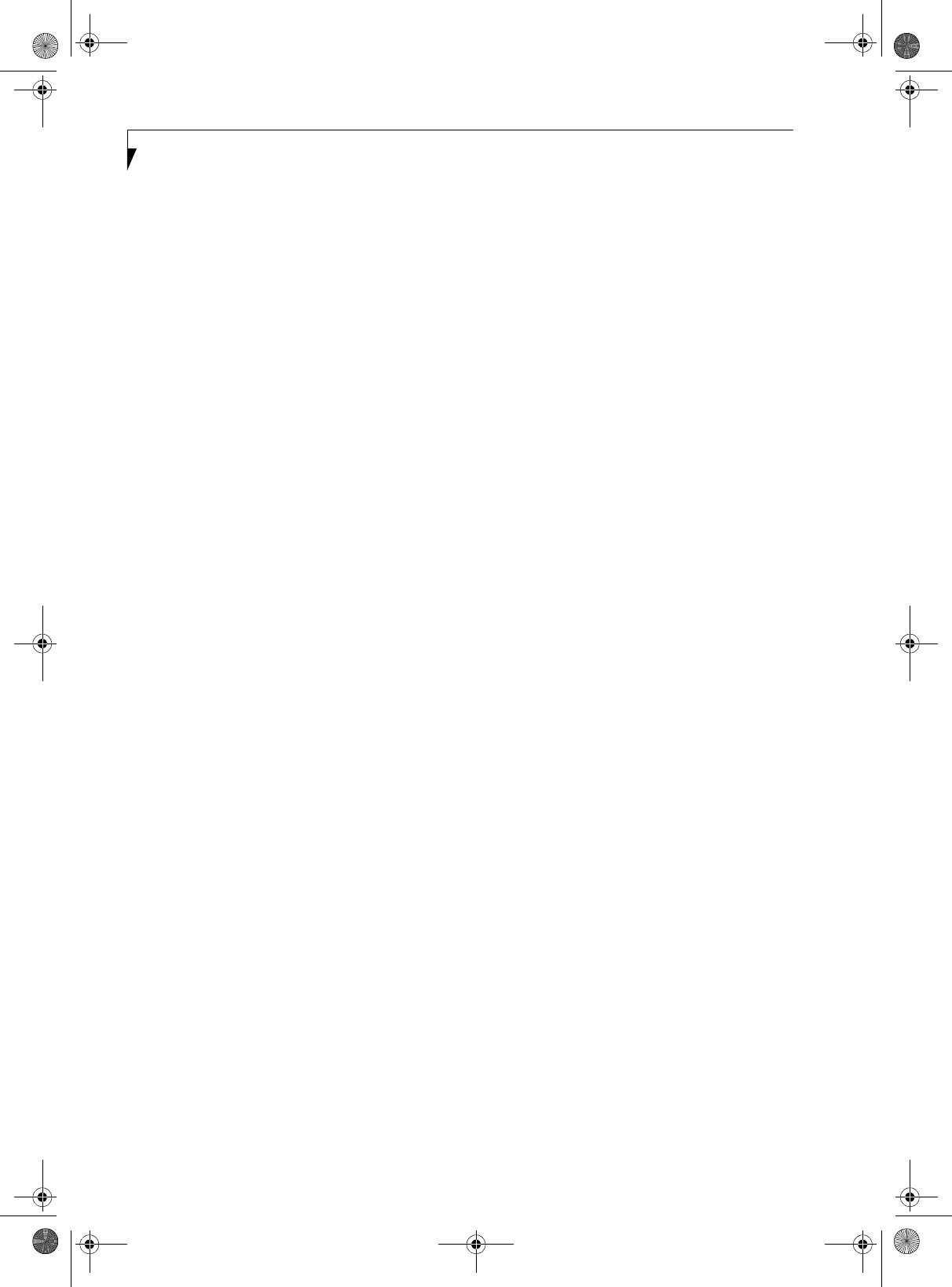
70
LifeBook T Series Tablet PC - Section SIx
T Series.book Page 70 Thursday, July 31, 2003 10:49 AM

71
7
Specifications
T Series.book Page 71 Thursday, July 31, 2003 10:49 AM
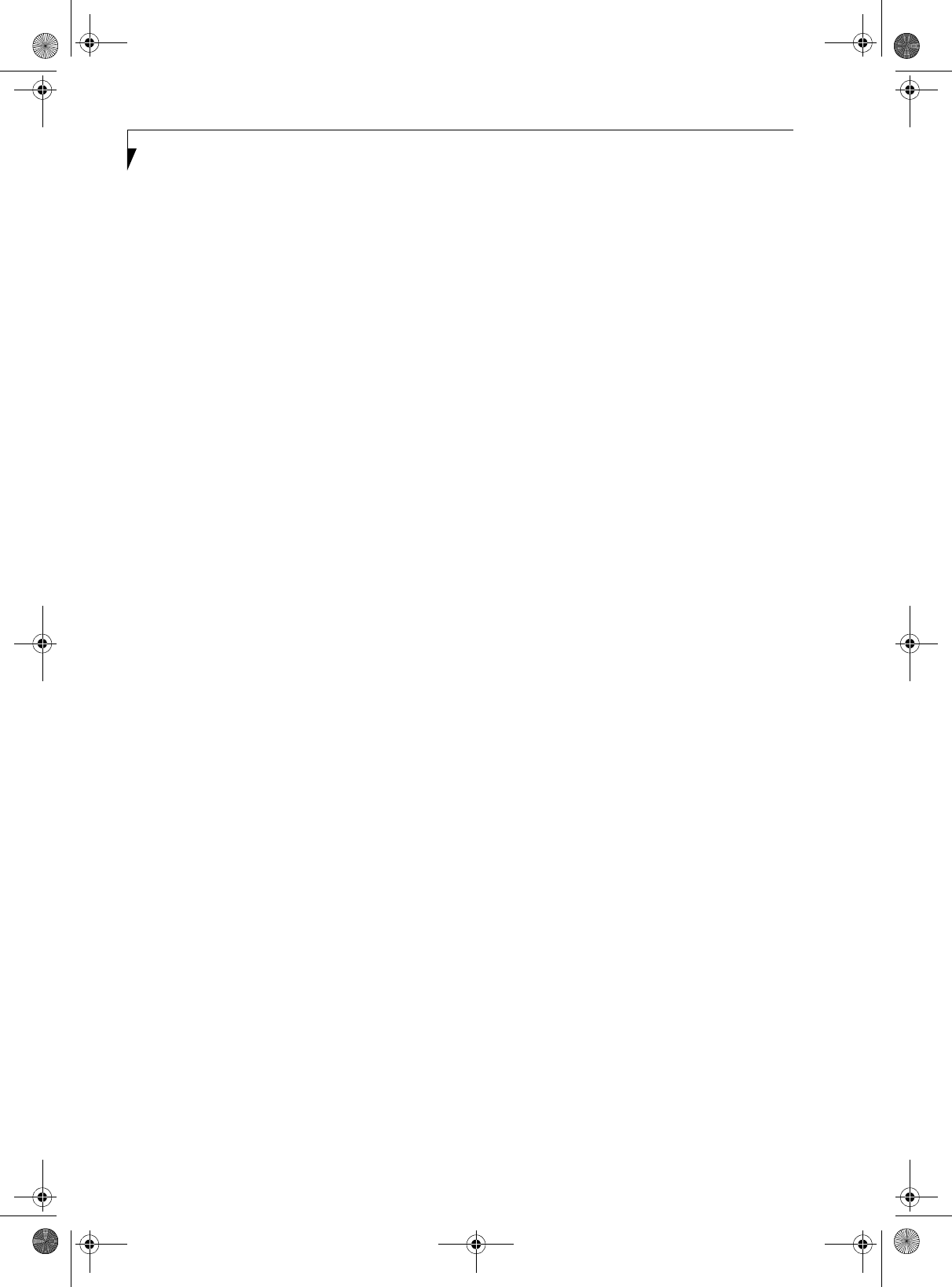
72
LifeBook T Series Tablet PC - Section Seven
T Series.book Page 72 Thursday, July 31, 2003 10:49 AM
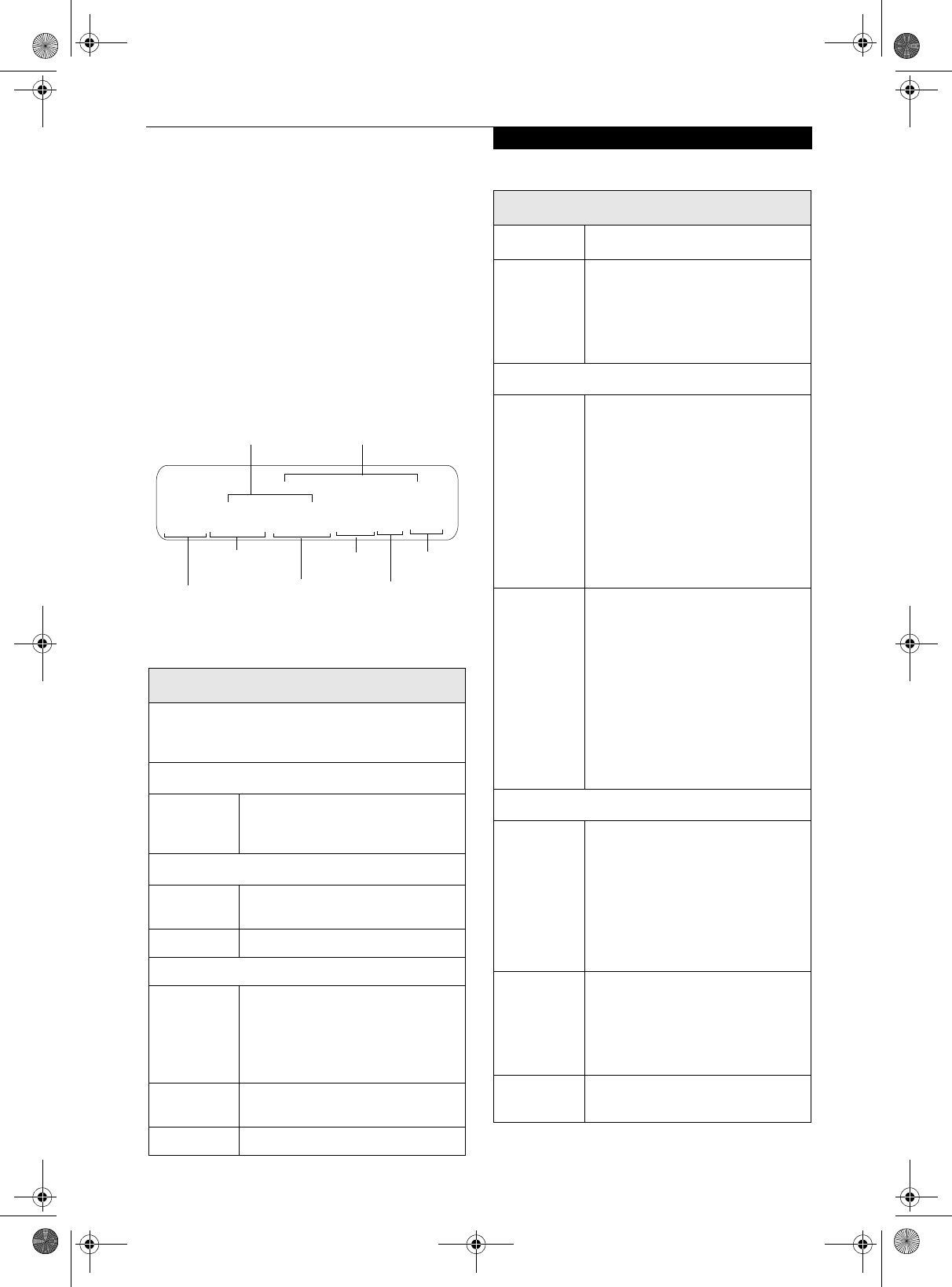
73
Specifications
Specifications
This section provides the hardware and environmental
specifications for your LifeBook T Series Tablet PC.
Specifications of particular configurations will vary.
CONFIGURATION LABEL
Your LifeBook T Series Tablet PC has a configuration
label located on the bottom. (See figure 2-8 on page 14
for location). This label contains specific information
regarding the options you’ve chosen for your Tablet PC.
Following is an example label and information on how
to read your own configuration label.
Figure 7-1. Configuration Label
LifeBook T Series Tablet PC Specifications
The specifications for your particular model may vary.
To determine the specifications for your system, please
visit our Web site at: www.fujitsupc.com.
Physical Specifications
Dimensions 11.5” w x 9.3” d x 1.1 / 1.4
(293 mm x 236 mm x 27.4 / 36.4
mm)
Processing Specifications
CPU/Speed Intel® Pentium® M processor
1.4 GHz @ 1.48V
Chip set Intel 855GM - 400 MHz
Memory/Storage Specifications
Main RAM • 256 MB SDRAM (DDR 266 MHz)
• 144-pin SO DIMM slots x 2
256 MB, 512 MB, and 1.0 GB
modules available, with a system
maximum of 2.0 GB.
L1 cache
(CPU)
64 KB on-die
L2 cache 1 MB on-die
T3010, PM 1.4G, 12.1 XGA, XPTE, 40G, 256M
Configuration P/N: ATEXXXXXXXXXXXX
FPC P/N: FPCXXXXXX
Model
Processor
Screen
Size
Operating
System
Hard Drive
Memory
Part Number Configuration ID
BIOS ROM 1 MB (Boot Block Type Flash ROM)
Hard disk
drive
• 2.5” HDD
• Minimum 40 GB IDE HDD
• ATA 100
• Shock-mounted
• SMART Support
Display Specifications
Display • Color LCD
• Active Digitizer
• 32-bit color
• 12.1” TFT XGA (1024 x 768),
16M colors
External monitor support: VGA
(1600 x 1200 maximum)
• Brightness: 8 levels
• Viewing Angle:
Horizontal: 30 degrees (min.)
Vertical: 10 degrees (min.)
VRAM Intel 855MG chipset with 8 MB shared
memory using Dynamic Video
Memory Technology (DVMT) delivers
low-power, high-performance 3D/2D
graphics, video, and display
capabilities. Dynamic Video Memory
Technology (DVMT) dynamically
responds to application requirements
and efficiently allocates the proper
amount of memory (maximum is 64
MB) for optimal graphics and system
performance.
Interface Specifications
Integrated
Interfaces
• Modem (RJ-11)
LAN (RJ-45)
• USB 2.0 x 2
•DC-In
•IrDA
• 15-pin D-SUB connector for
external VGA monitor
• Docking connector
Interfaces
on Optional
Port
Replicator
• DC Power
• Pass-through LAN Port
• External Monitor
• USB 2.0 x 2
• Docking Port
PC Card
Slots
• Two Type I/Type II or one Type III
• PCMCIA CardBus version 3.0
LifeBook T Series Tablet PC Specifications (Continued)
T Series.book Page 73 Thursday, July 31, 2003 10:49 AM
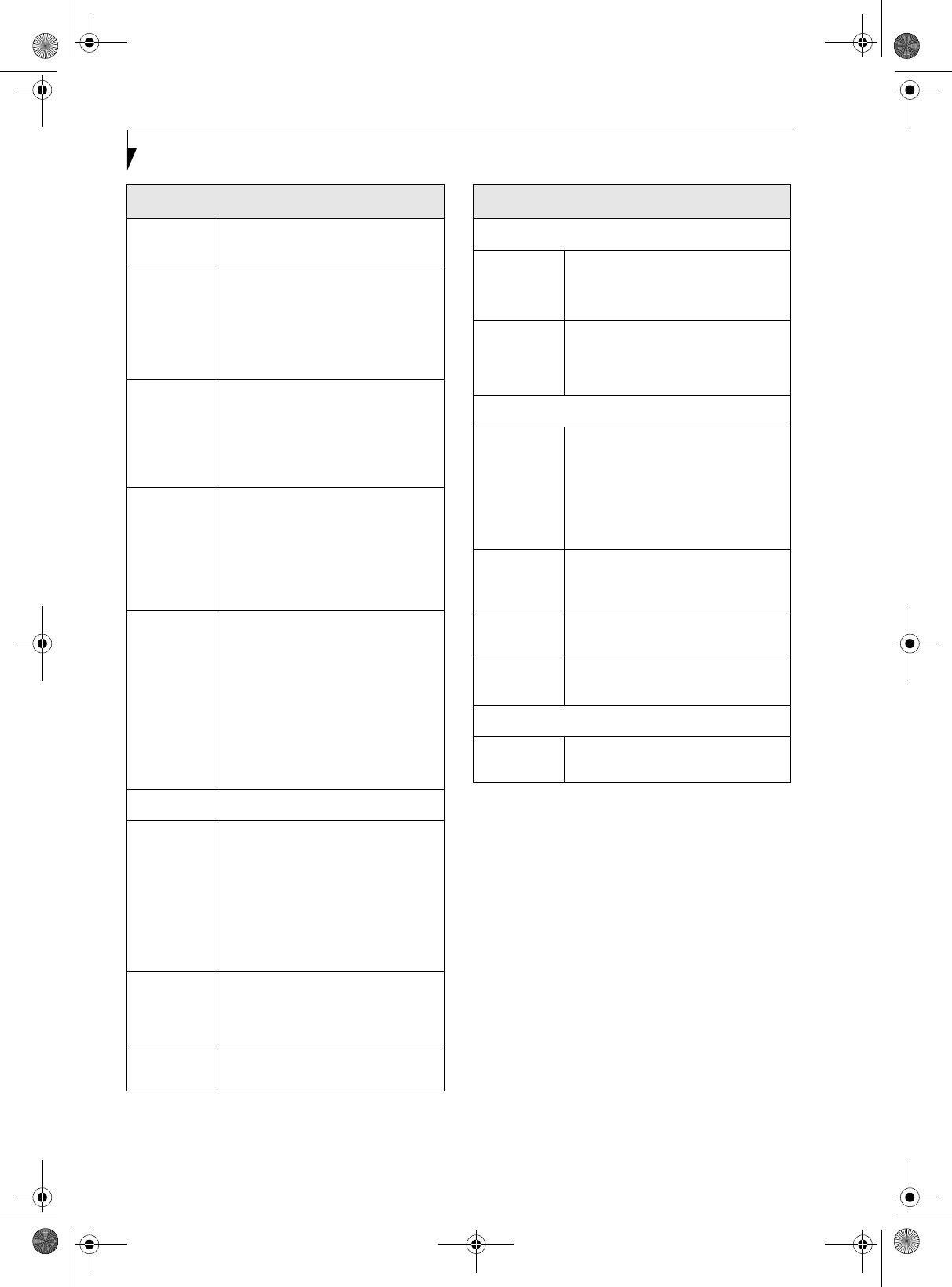
74
LifeBook T Series Tablet PC - Section Seven
Infrared • System IR Port
• IrDA version 1.1 (FIR, 4 Mbps)
User
Interface
support
• Keyboard
Pitch: 19 mm, Stroke: 3 mm
• TouchPad pointing device with
scroll button
• Active digitizer with pen input
• On-screen keyboard
Audio • RealTek ALC202 with 18-bit
stereo audio, full duplex
• Internal mono microphone and
speaker
• Mono microphone and stereo
headphone jacks
User
Controls
• Programmable Application
Buttons, each with primary and
secondary functions (default
applications: Microsoft Journal
and Calculator)
• Security button support
• Suspend/Resume button
Status
Indicators
(LCDs)
• Power
• Charge/DC-In
• Battery level
• HDD
• PC Card
•Caps Lock
•Num Lock
• Scroll Lock
• Security
Power Specifications
Main Battery • 6-cell
• Removable, Lithium ion
• 10.8 V @3600 mAh, 38.9 Wh
• Warm-swappable
•Recharge Time:
Approximately 3.2 hours
• Suspend Life: Minimum 3 days
Off State: Approximately 20 days
Bridge
Battery
• 6-cell NiMH, 35 mAh
• Life (with Suspend-to-RAM on
bridge battery only):
5 minutes from full charge
AC Adapter Autosensing 100 - 240V, supplying 16
VDC, with a current of 3.75 A
LifeBook T Series Tablet PC Specifications (Continued)
Environmental Specifications
Temperature Operating: 41o to 95o F (5o to 35o C)
Non-operating: 5o to 140o F
(-15o to 60o C)
Humidity Operating: 20 to 85% non-
condensing
Non-operating: 8 to 85% non-
condensing
Agency Approval Specifications
Emissions
• EN55022 (CISPR22) Class B
• FCC 15, Class B
• FCC 15C, 15.247
• ETSI EN 300-328
• ICES-003
• Canada RSS-210
Immunity
• EN55024 (1998)
• ETSI EN 301-489-17 V.1.1.1
(2000-9)
Safety • UL and cUL Listed, UL 60950
• TuV T-Mark, EN60950
Tele com • FCC Part 68
• IC CS-03
Additional Specifications
Operating
systems •Microsoft
Windows
XP Tablet PC Edition
LifeBook T Series Tablet PC Specifications (Continued)
T Series.book Page 74 Thursday, July 31, 2003 10:49 AM
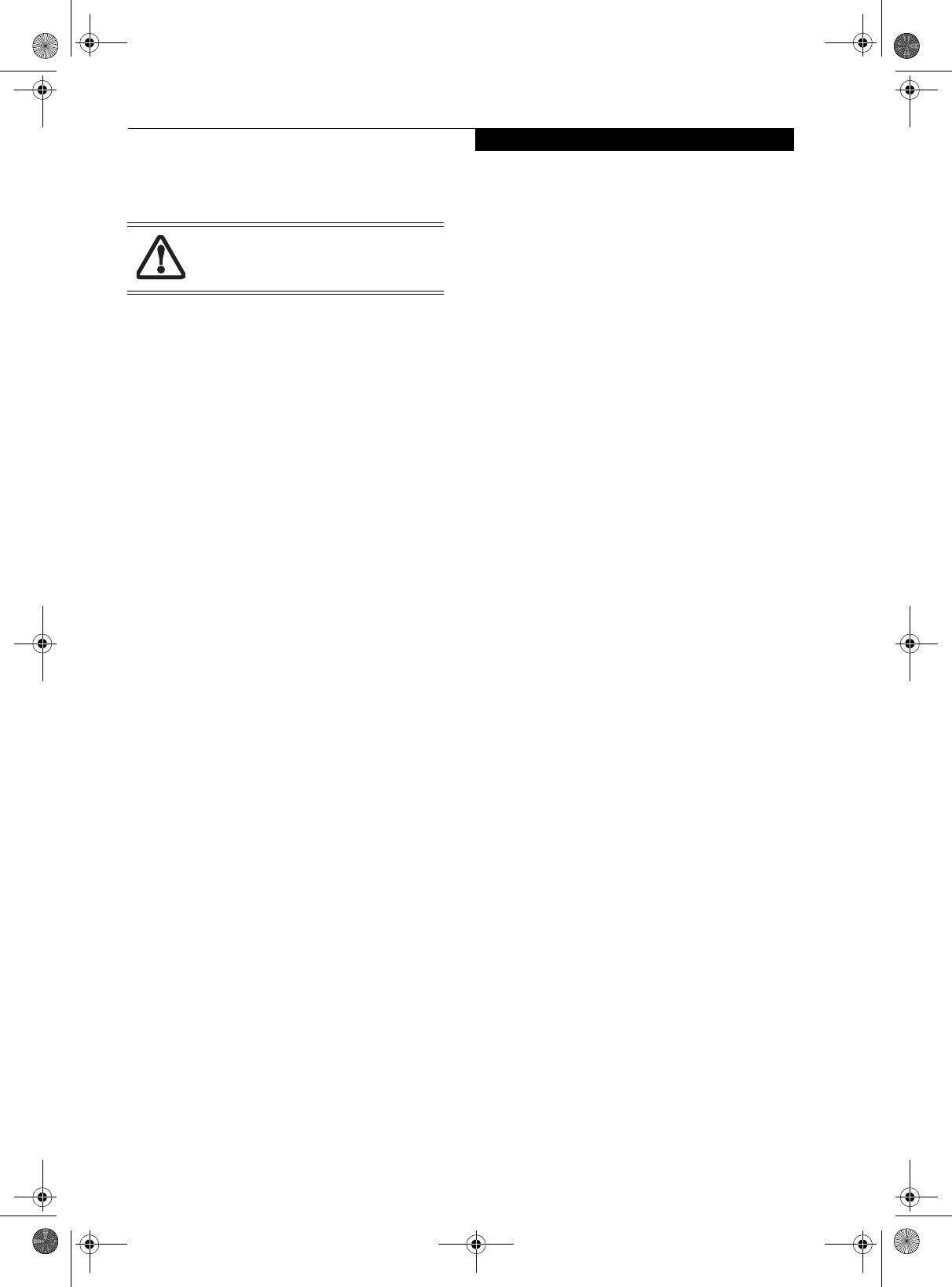
75
Regulatory Information
Regulatory Information
FCC NOTICES
Notice to Users of Radios and Television
These limits are designed to provide reasonable protec-
tion against harmful interference in a residential installa-
tion. This equipment generates, uses, and can radiate
radio frequency energy and, if not installed and used in
accordance with the instructions, may cause harmful
interference to radio communications. However, there is
no guarantee that interference will not occur in a partic-
ular installation. If this equipment does cause harmful
interference to radio or television reception, which can
be determined by turning the equipment off and on, the
user is encouraged to try to correct the interference by
one or more of the following measures:
nReorient or relocate the receiving antenna.
nIncrease the separation between the equipment and
receiver.
nConnect the equipment into an outlet that is on a
different circuit than the receiver.
nConsult the dealer or an experienced radio/TV
technician for help.
Shielded interconnect cables must be employed with this
equipment to ensure compliance with the pertinent RF
emission limits governing this device.
Notice to Users of the US Telephone Network
This equipment contains an internal modem (Fujitsu
Media Devices, MBH 7MD33) that complies with Part
68 of the FCC rules. On the bottom of this equipment is
a label that contains, among other information, the FCC
registration number and ringer equivalence number
(REN) for this equipment. If requested, this information
must be provided to the telephone company.
This equipment is designed to be connected to the tele-
phone network or premises wiring using a standard jack
type USOC RJ11C. A plug and jack used to connect this
equipment to the premises wiring and telephone
network must comply with the applicable FCC Part 68
rules and requirements adopted by the ACTA. A
compliant telephone cord and modular plug is provided
with this product. It is designed to be connected to a
compatible modular jack that is also compliant.
The ringer equivalent number (REN) of this equipment
is 0.0B as shown on the label. The REN is used to deter-
mine the number of devices that may be connected to a
telephone line. Excessive RENs on a telephone may
result in the devices not ringing in response to an
incoming call. In most but not all areas, the sum of
RENs should not exceed five (5.0). To be certain of the
number of devices that may be connected to a line, as
determined by the total RENs, contact the local tele-
phone company.
If this equipment causes harm to the telephone network,
the telephone company will notify you in advance that
temporary discontinuance of service may be required.
But if advance notice isn’t practical, the telephone
company will notify the customer as soon as possible.
Also, you will be advised of your right to file a complaint
with the FCC if you believe it is necessary.
The telephone company may make changes in its facili-
ties, equipment, operations or procedures that could
effect the operation of the equipment. If this happens
the telephone company will provide advance notice in
order for you to make necessary modifications to main-
tain uninterrupted service.
If trouble is experienced with this equipment, for repair
or warranty information, please refer to the manual or
contact Fujitsu PC Corporation, Customer Service. If
the equipment is causing harm to the telephone
network, the telephone company may request that you
disconnect the equipment until the problem is resolved.
The equipment cannot be used on public coin service
provided by the telephone company. Connection to
party line service is subject to state tariffs. (Contact the
state public utility commission, public service commis-
sion or corporation commission for information).
If your home has specially wired alarm equipment
connected to the telephone line, ensure the installation
of this computer does not disable your alarm equip-
ment. If you have any questions about what will disable
alarm equipment, consult your telephone company or a
qualified installer.
The Telephone Consumer Protection Act of 1991 makes
it unlawful for any person to use a computer or other
electronic device to send any message via a telephone fax
machine unless such message clearly contains in a
margin at the top or bottom of each transmitted page or
on the first page of the transmission, the date an time it
is sent and an identification of the business or other
entity, or other individual sending the message and the
telephone number of the sending machine or such busi-
ness, other entity, or individual.
Changes or modifications not expressly
approved by Fujitsu could void this user’s
authority to operate the equipment
T Series.book Page 75 Thursday, July 31, 2003 10:49 AM
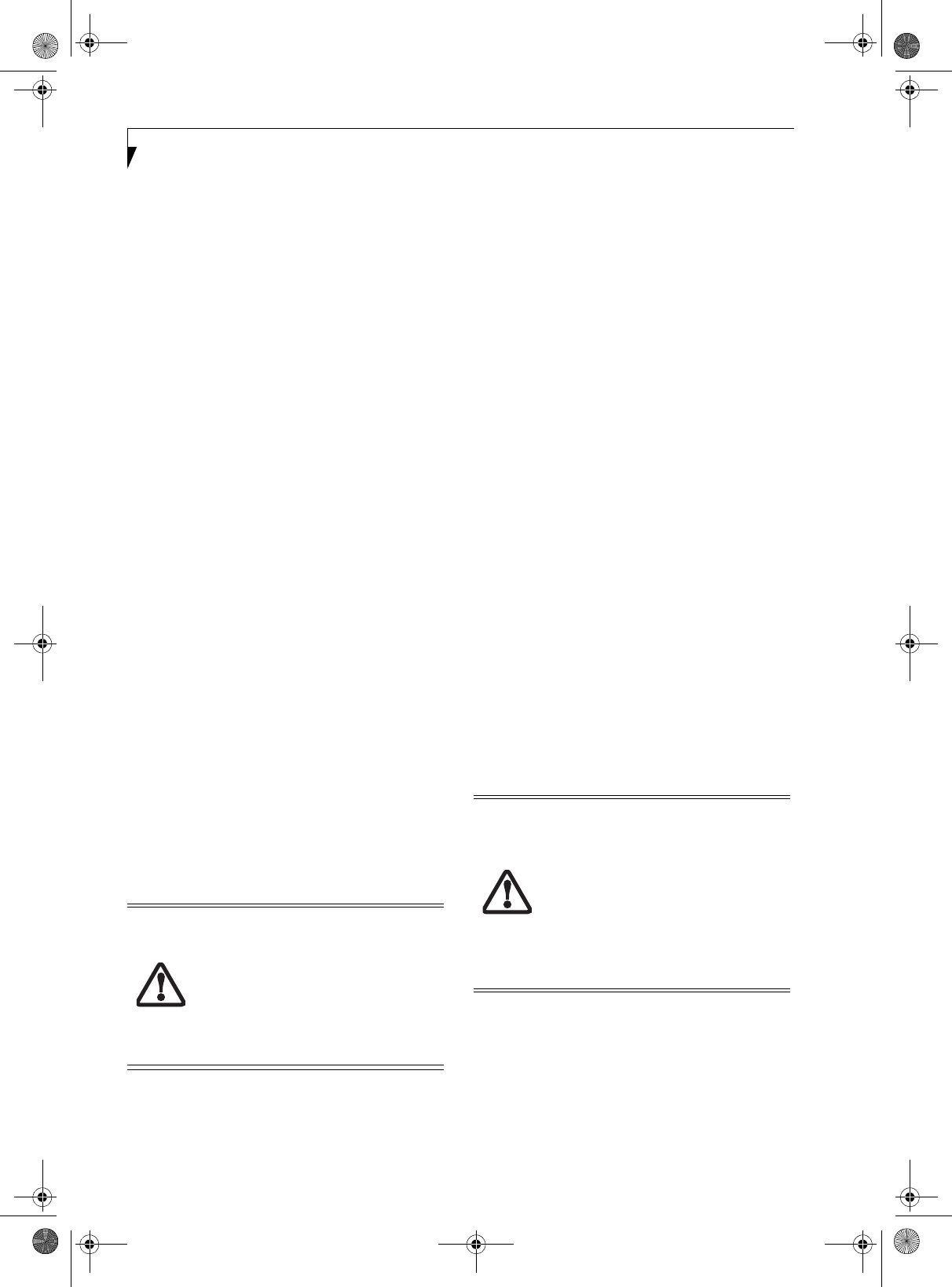
76
LifeBook T Series Tablet PC - Section Seven
DOC (INDUSTRY CANADA) NOTICES
Notice to Users of Radios and Television
This Class B digital apparatus meets all requirements of
Canadian Interference-Causing Equipment Regulations.
CET appareil numérique de la class B respecte toutes les
exigence du Réglement sur le matérial brouilleur du
Canada.
Notice to Users of the Canadian Telephone Network
NOTICE: This equipment (Fujitsu Media Devices
modem, MBH 7MD33) meets the applicable Industry
Canada Terminal Equipment Technical Specifications.
This is confirmed by the registration number. The
abbreviation, IC, before the registration number
(4061A-8687) signifies that registration was performed
based on a Declaration of Conformity indicating that
Industry Canada technical specifications were met. It
does not imply that Industry Canada approved the
equipment.
Before connecting this equipment to a telephone line the
user should ensure that it is permissible to connect this
equipment to the local telecommunication facilities. The
user should be aware that compliance with the certifica-
tion standards does not prevent service degradation in
some situations.
Repairs to telecommunication equipment should be
made by a Canadian authorized maintenance facility.
Any repairs or alterations not expressly approved by
Fujitsu or any equipment failures may give the telecom-
munication company cause to request the user to
disconnect the equipment from the telephone line.
NOTICE: The Ringer Equivalence Number (REN) for
this terminal equipment is 0.0. The REN assigned to
each terminal equipment provides an indication of the
maximum number of terminals allowed to be connected
to a telephone interface. The termination on an interface
may consist of any combination of devices subject only
to the requirement that the sum of the Ringer Equiva-
lence Numbers of all the devices does not exceed five.
Avis Aux Utilisateurs Du Réseau
Téléphonique Canadien
AVIS: Le présent matériel est conforme aux spécifica-
tions techniques d’Industrie Canada applicables au
matériel terminal. Cette conformité est confirmée par le
numéro d’enregistrement. Le sigle IC, placé devant le
numéro d’enregistrement (4061A-8687), signifie que
l’enregistrement s’est effectué conformément à une
déclaration de conformité et indique que les spécifica-
tions techniques d’Industrie Canada ont été respectées.
Il n’implique pas qu’Industrie Canada a approuvé le
matériel.
Avant de connecter cet équipement à une ligne télépho-
nique, l’utilisateur doit vérifier s’il est permis de
connecter cet équipement aux installations de télécom-
munications locales. L’utilisateur est averti que même la
conformité aux normes de certification ne peut dans
certains cas empêcher la dégradation du service.
Les réparations de l’équipement de télécommunications
doivent être eVectuées par un service de maintenance
agréé au Canada. Toute réparation ou modification, qui
n’est pas expressément approuvée par Fujitsu, ou toute
défaillance de l’équipement peut entraîner la compagnie
de télécommunications à exiger que l’utilisateur décon-
necte l’équipement de la ligne téléphonique.
AVIS: L’indice d’équivalence de la sonnerie (IES) du
présent matériel est de 0.0. L’IES assigné à chaque
dispositif terminal indique le nombre maximal de
terminaux qui peuvent être raccordés à une interface
téléphonique. La terminaison d’une interface peut
consister en une combinaison quelconque de dispositifs,
à la seule condition que la somme d’indices d’équiva-
lence de la sonnerie de tous les dispositifs n’excède pas 5.
For safety, users should ensure that the
electrical ground of the power utility, the
telephone lines and the metallic water
pipes are connected together. Users should
NOT attempt to make such connections
themselves but should contact the appro-
priate electric inspection authority or elec-
trician. This may be particularly important
in rural areas.
Pour assurer la sécurité, les utilisateurs
doivent vérifier que la prise de terre du ser-
vice d’électricité, les lignes télphoniques et
les conduites d’eau métalliques sont con-
nectées ensemble. Les utilisateurs NE
doivent PAS tenter d’établir ces connex-
ions eux-mêmes, mais doivent contacter
les services d’inspection d’installations
électriques appropriés ou un électricien.
Ceci peut être particulièrement important
en régions rurales.
T Series.book Page 76 Thursday, July 31, 2003 10:49 AM
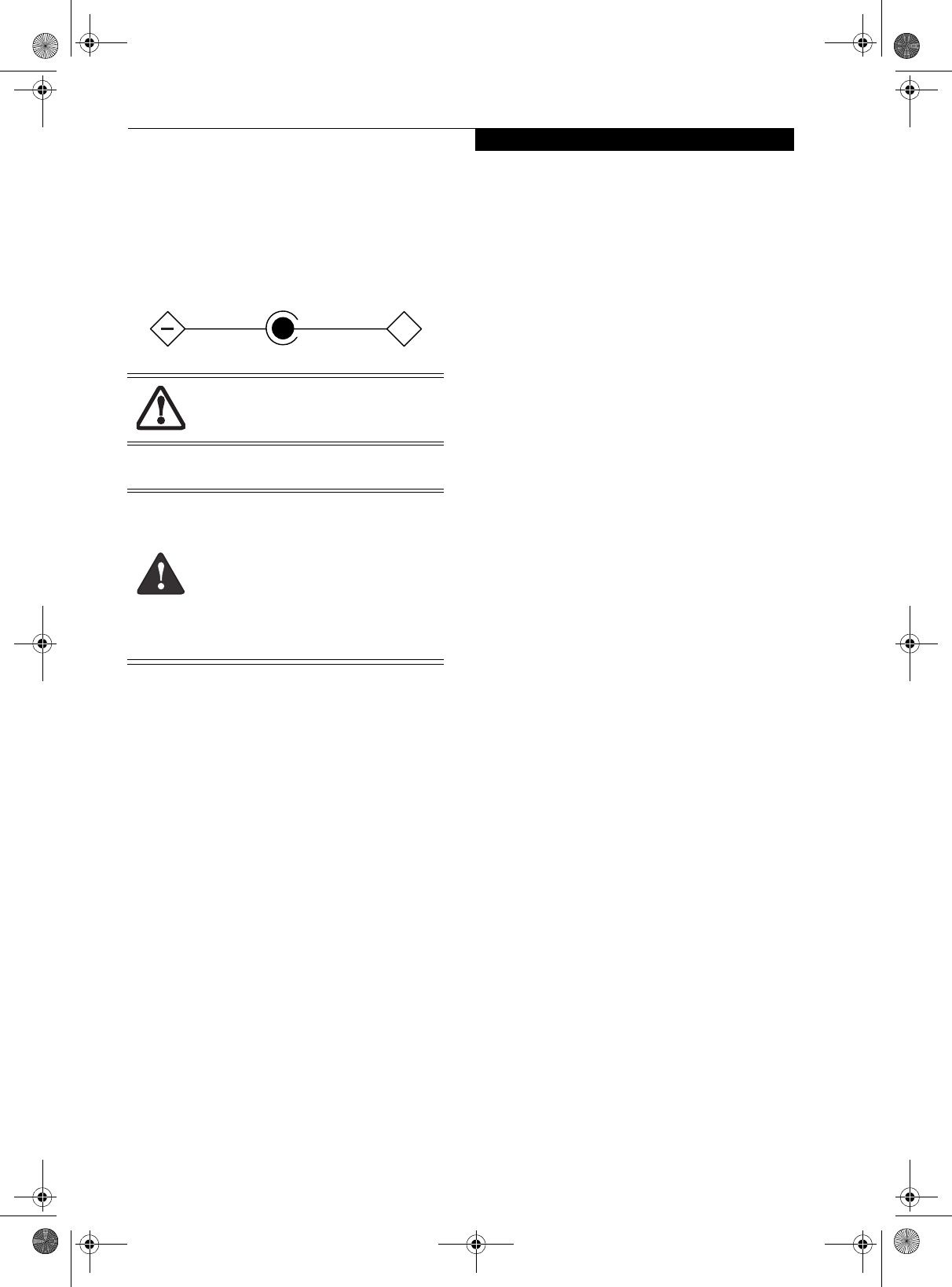
77
Regulatory Information
UL Notice
This unit requires an AC adapter to operate. Use only UL
Listed Class 2 Adapters with an output rating of 16 Vdc,
with a current of 3.75 A.
AC Adapter output polarity:
For Authorized Repair Technicians Only
The modem-to-telephone network
connection must be a line cord using a
minimum #26 AWG wire.
nFor continued protection against risk of
fire, replace only with the same type and
rating fuse.
nDanger of explosion if Lithium (clock)
battery is incorrectly replaced. Replace
only with the same or equivalent type
recommended by the manufacturer. Dis-
pose of used batteries according to the
manufacturer’s instruction.
+
T Series.book Page 77 Thursday, July 31, 2003 10:49 AM
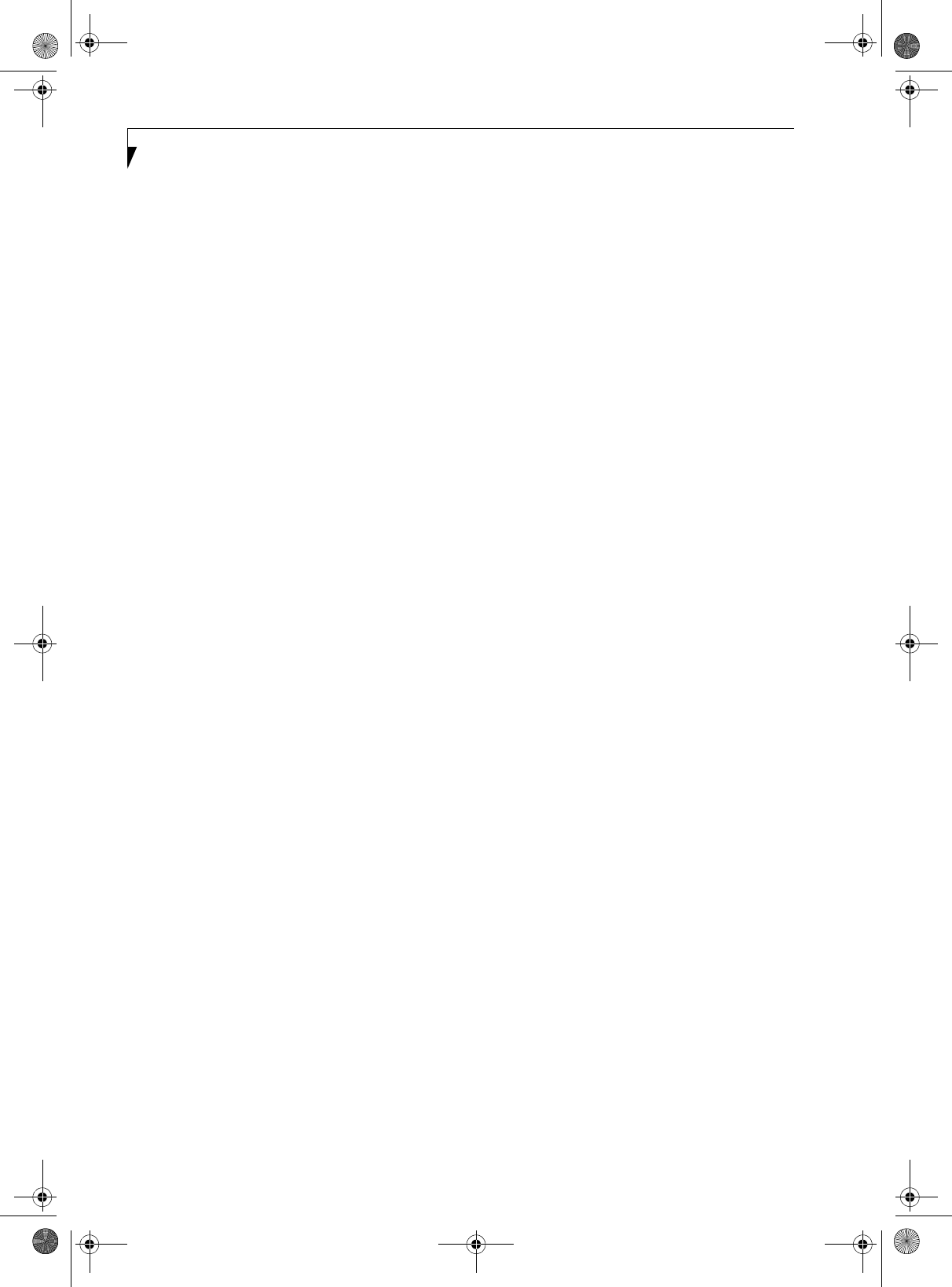
78
LifeBook T Series Tablet PC - Section Seven
T Series.book Page 78 Thursday, July 31, 2003 10:49 AM

79
8
Glossary
T Series.book Page 79 Thursday, July 31, 2003 10:49 AM
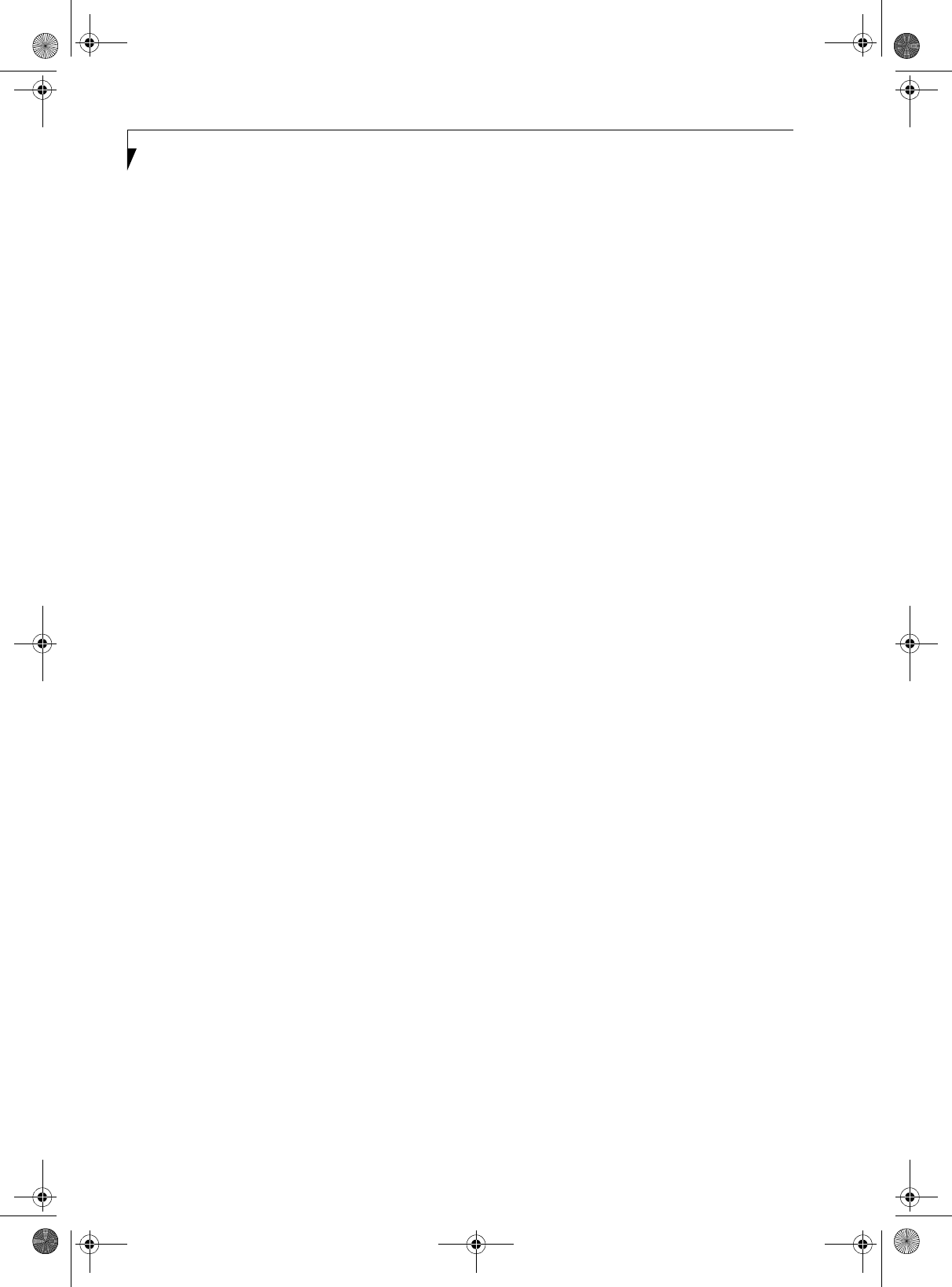
80
LifeBook T Series Tablet PC - Section Eight
T Series.book Page 80 Thursday, July 31, 2003 10:49 AM

81
Glossary
Glossary
AC Adapter
A device which converts the AC voltage from a wall
outlet to the DC voltage needed to power your Tablet
PC.
ACPI
Advanced Configuration and Power Interface
Active-Matrix Display
A type of technology for making flat-panel displays
which has a transistor or similar device for every pixel
on the screen.
AdHoc
A designation for wireless LAN network configuration.
It indicates a form of communication limited to those
personal computers which have wireless LAN function.
For details, refer to "Ad hoc connection" on page 90.
ADSL
Asymmetric Digital Subscriber Line
Technology for transporting high bit-rate services over
ordinary phone lines.
Auto/Airline Adapter
A device which converts the DC voltage from an auto-
mobile cigarette lighter or aircraft DC power outlet to
the DC voltage needed to power your Tablet PC.
BIOS
Basic Input-Output System. A program and set of
default parameters stored in ROM which tests and
operates your Tablet PC when you turn it on until it
loads your installed operating system from disk. Infor-
mation from the BIOS is transferred to the installed
operating system to provide it with information on the
configuration and status of the hardware.
Bit
An abbreviation for binary digit. A single piece of
information which is either a one (1) or a zero (0).
bps
An abbreviation for bits per second. Used to describe
data transfer rates.
Boot
To start-up a computer and load its operating system
from disk, ROM or other storage media into RAM.
Bus
An electrical circuit which passes data between the CPU
and the sub-assemblies inside your Tablet PC.
Byte
8 bits of parallel binary information.
Cache Memory
A block of memory built into the micro-processor
which is much faster to access than your system RAM
and used in specially structured ways to make your
overall data handling time faster.
CardBus
A faster, 32-bit version of the PC Card interface which
offers performance similar to the 32-bit PCI
architecture.
CD-ROM
Compact disk read only memory. This is a form of
digital data storage which is read optically with a laser
rather than a magnetic head. A typical CD-ROM can
contain about 600MB of data and is not subject to heads
crashing into the surface and destroying the data when
there is a failure nor to wear from reading.
Channel
The frequency band of wireless LAN to be used in
communications over wireless LAN or at the access
point.
CMOS RAM
Complementary metal oxide semiconductor random
access memory. This is a technology for manufacturing
random access memory which requires very low levels of
power to operate.
Command
An instruction which you give your operating system.
Example: run a particular application or format a floppy
disk.
Configuration
The combination of hardware and software that makes
up your system and how it is allocated for use.
CRT
Cathode Ray Tube. A display device which uses a beam
of electronic particles striking a luminescent screen. It
produces a visual image by varying the position and
intensity of the beam.
Data
The information a system stores and processes.
DC
Direct current. A voltage or current that does not
fluctuate periodically with time.
Default Value
A pre programmed value to be used if you fail to set
your own.
T Series.book Page 81 Thursday, July 31, 2003 10:49 AM
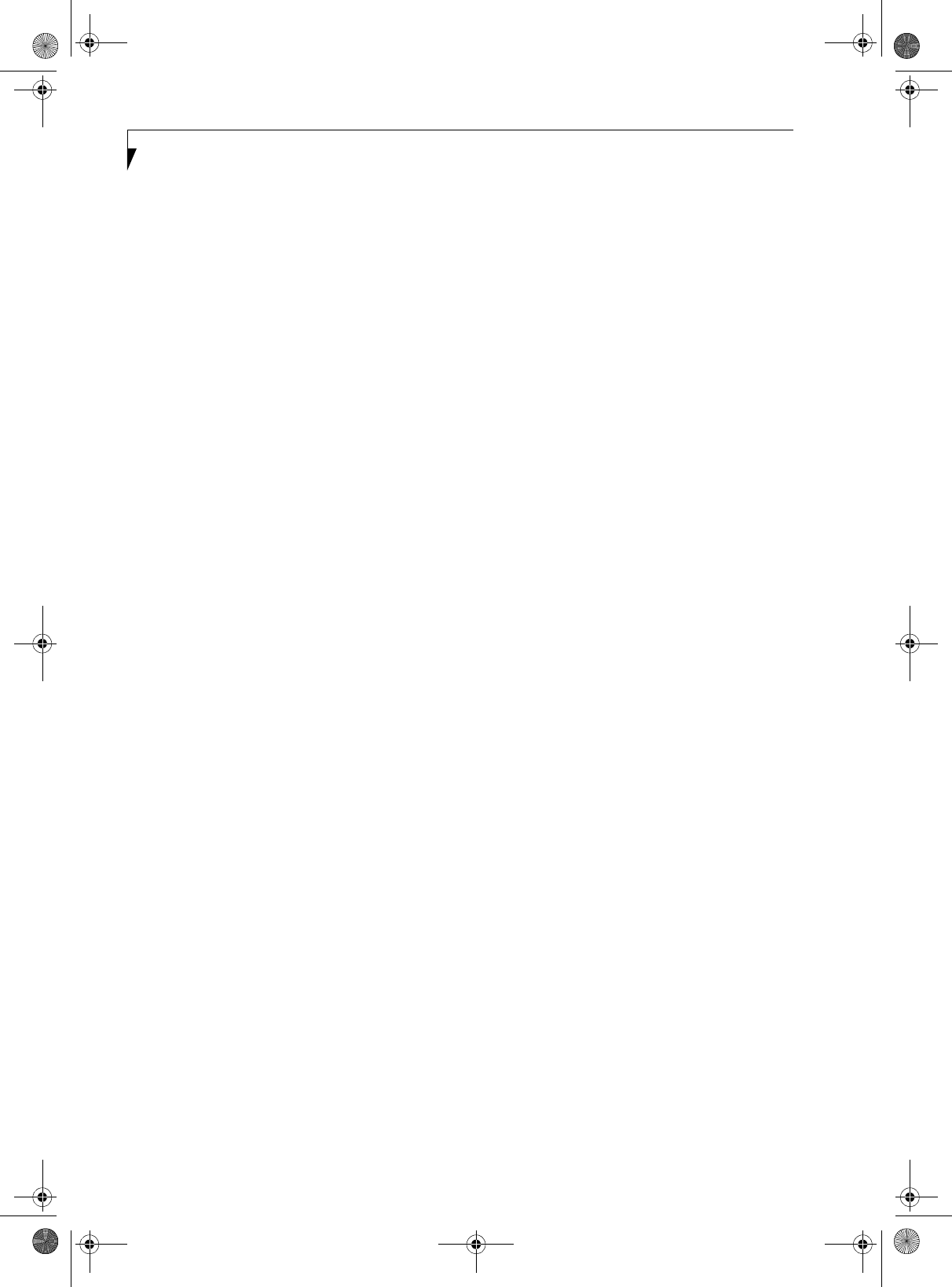
82
LifeBook T Series Tablet PC - Section Eight
DHCP
Dynamic Host Configuration Protocol
A protocol used for automatically fetching communica-
tion parameters such as IP addresses. The side which
assigns IP address is called DHCP server and the side
that is assigned it is called DHCP client.
DIMM
Dual-in-line memory module.
DISE
Drive Image Special Edition.
A utility that allows you to restore the original factory
image on your hard drive in the event of corruption or
accidental erasure of files or applications.
Disk
A spinning platter of magnetic data storage media. If the
platter is very stiff it is a hard drive, if it is highly flexible
it is a floppy disk, if it is a floppy disk in a hard housing
with a shutter it is commonly called a diskette.
Disk Drive
The hardware which spins the disk and has the heads
and control circuitry for reading and writing the data
on the disk.
Diskette
A floppy disk in a hard housing with a shutter.
DMA
Direct Memory Access
Special circuitry for memory to memory transfers of
data which do not require CPU action.
DMI
Desktop Management Interface
A standard that provides PC management applications
with a common method of locally or remotely querying
and configuring PC computer systems, hardware and
software components, and peripherals.
DNS
Domain Name System
A function that controls the correspondence of IP
addresses assigned to a computer with the name. Even
for those computers whose IP addresses are unknown, if
their names are known, it is possible to communicate
with them.
DOS
Disk Operating System (MS-DOS is a Microsoft Disk
Operating System).
Driver
A computer program which converts application and
operating system commands to external devices into the
exact form required by a specific brand and model of
device in order to produce the desired results from that
particular equipment.
ECP
Extended Capability Port. A set of standards for high
speed data communication and interconnection
between electronic devices.
Encryption Key (Network Key)
Key information used to encode data for data transfer.
This device uses the same encryption key to encode and
decode the data, and the identical encryption key is
required between the sender and receiver.
ESD
Electro-Static Discharge. The sudden discharge of elec-
tricity from a static charge which has built-up slowly.
Example: the shock you get from a doorknob on a dry
day or the sparks you get from brushing hair on a dry
day.
Extended Memory
All memory more than the 640KB recognized by
MS-DOS as system memory.
FCC
Federal Communication Commission.
Floppy Disk
A spinning platter of magnetic data storage media which
is highly flexible.
GB
Gigabyte.
Hard drive
A spinning platter of magnetic data storage media where
the platter is very stiff.
I/O
Input/Output. Data entering and leaving your Tablet PC
in electronic form.
I/O Port
The connector and associated control circuits for data
entering and leaving your Tablet PC in electronic form.
IDE
Intelligent Drive Electronics. A type of control interface
for a hard drive which is inside the hard drive unit.
T Series.book Page 82 Thursday, July 31, 2003 10:49 AM

83
Glossary
IEEE 1394
Industry standard that allows you to connect between
your Tablet PC and a peripheral device such as a digital
camera. Also known as "Firewire" or "iLINK".
IEEE802.11a
One of the wireless LAN standards prescribed by the 802
committee in charge of establishing standards of LAN
technology in IEEE (Institute of Electrical and Elec-
tronic Engineers). This standard allows communica-
tions at the maximum speed of 54 Mbps by using a 5
GHz band which can freely be used without radio
communication license.
IEEE802.11b
One of the wireless LAN standards prescribed by 802
committee in charge of establishing standards of LAN
technology in IEEE (Institute of Electrical and Elec-
tronic Engineers). It allows communications at the
maximum speed of 11 Mbps by a band of 2.4 GHz (ISM
band) which can freely be used without radio communi-
cation license.
IEEE802.11g
One of the wireless LAN standards prescribed by 802
committee in charge of establishing standards of LAN
technology in IEEE (Institute of Electrical and Elec-
tronic Engineers). It allows communications at the
maximum speed of 54 Mbps by a band of 2.4 GHz (ISM
band) which can freely be used without radio communi-
cation license.
Infrared
Light just beyond the red portion of the visible light
spectrum which is invisible to humans.
Infrastructure
A designation of Wireless LAN network configurations.
It indicates a form of communication using an Access
Point. For details, refer to "Infrastructure connection"
on page 90.
IP Address
An address used for computers to communicate in the
TCP/IP environment.
Current IPv4 (version 4) uses four values in the range
between 1 and 255. (Example: 192.168.100.123).
There are two types of IP address: global address and
private address.
The global address is an only address in the world. It is
controlled by JPNIC (Japan Network Information
Center). A private address is an only address in the
closed network.
IR
An abbreviation for infrared.
IrDA
Infrared Data Association. An organization which
produces standards for communication using infrared
as the carrier.
IRQ
Interrupt Request
An acronym for the hardware signal to the CPU that an
external event has occurred which needs to be
processed.
KB
Kilobyte.
LAN
Local Area Network
An interconnection of computers and peripherals
within a single limited geographic
location which can pass programs and data amongst
themselves.
LCD
Liquid Crystal Display
A type of display which makes images by controlling the
orientation of crystals in a crystalline liquid.
Lithium ion Battery
A type of rechargeable battery which has a high power-
time life for its size and is not subject to the memory
effect as Nickel Cadmium batteries.
LPT Port
Line Printer Port. A way of referring to parallel interface
ports because historically line printers were the first and
latter the most common device connected to parallel
ports.
MAC Address
Media Access Control Address
A unique physical address of a network card. For
Ethernet, the first three bytes are used as the vendor
code, controlled and assigned by IEEE. The remaining
three bytes are controlled by each vendor (preventing
overlap), therefore, every Ethernet card is given a unique
physical address in the world, being assigned with a
different address from other cards. For Ethernet, frames
are sent and received based on this address.
MB
Megabyte.
Megahertz
1,000,000 cycles per second.
T Series.book Page 83 Thursday, July 31, 2003 10:49 AM
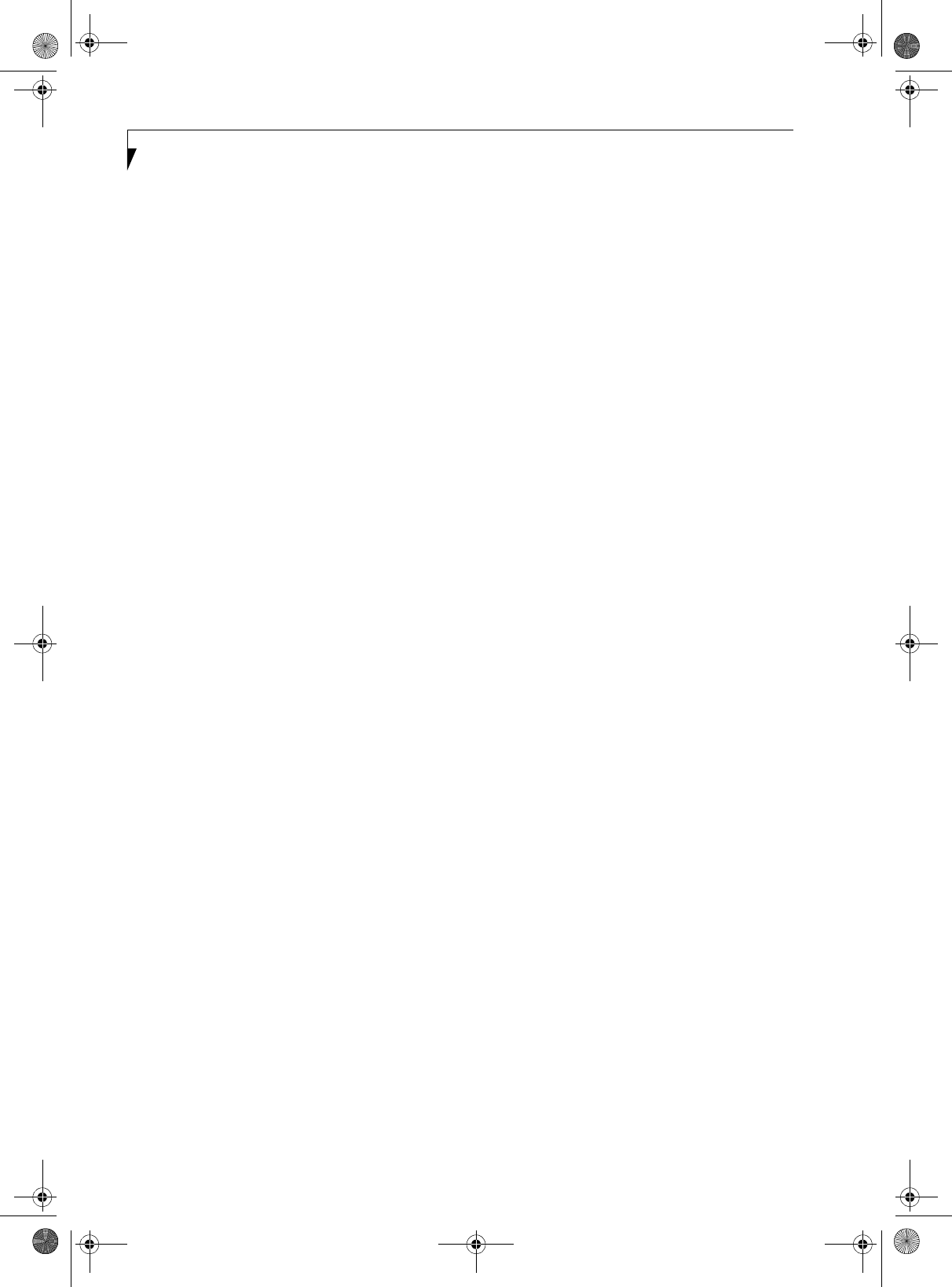
84
LifeBook T Series Tablet PC - Section Eight
Memory
A repository for data and applications which is readily
accessible to your Tablet PC’s CPU.
MHz
Megahertz.
MIDI
Musical Instrument Digital Interface. A standard
communication protocol for exchange of information
between computers and sound producers such
as synthesizers.
Modem
A contraction for MOdulator-DEModulator. The
equipment which connects a computer or other data
terminal to a communication line.
Monaural
A system using one channel to process sound from all
sources.
MPU-401
A standard for MIDI interfaces and connectors.
MTU
Maximum Transmission Unit
The maximum data size that can be transferred at a time
through the Internet or other networks. You can set a
smaller MTU size to obtain successful communication,
if you have difficulty transferring data due to the fact
that the maximum size is too large.
Network authentication
The method of authentication performed by wireless
LAN clients to connect with the access point. There are
two types: open system authentication and shared key
authentication. The type of authentication must be set
to each client and also coincide with the setting of access
point with which to communicate. Network authentica-
tion is sometimes called authentication mode.
Network key
Data that is used for encrypting data in data communi-
cation. The personal computer uses the same network
key both for data encryption and decryption, therefore,
it is necessary to set the same network key as the other
side of communication.
Network name (SSID: Security Set Identifier)
When a wireless LAN network is configured, grouping is
performed to avoid interference or data theft. This
grouping is performed with "Network name (SSID)". In
order to improve security, the network key is set
allowing no communication unless "Network name
(SSID)" coincides with the network key.
NTSC
National TV Standards Commission. The standard for
TV broadcast and reception for the USA.
Open system authentication
One of network authentication types for wireless LAN.
Since there is no check of network key upon authentica-
tion, clients can connect to the access point without
submitting correct network keys. However, in case of
actual communications, the same network key must be
set. Open system authentication is sometimes called
Open key authentication.
Operating System
A group of control programs that convert application
commands, including driver programs, into the exact
form required by a specific brand and model of micro-
processor in order to produce the desired results from
that particular equipment.
Partition
A block of space on a hard drive which is set aside and
made to appear to the operating system as if it were a
separate disk, and addressed by the operating system
accordingly.
PCI
Peripheral Component Interconnect
Self-configuring PC local bus. Designed by Intel, PCI has
gained wide acceptance as a standard bus design.
PCMCIA
PCMCIA is a trademark of the Personal Computer
Memory Card International Association. The Personal
Computer Memory Card International Association is an
organization that sets standards for add-in cards for
personal computers.
Peripheral Device
A piece of equipment which performs a specific
function associated with but not integral to a computer.
Examples: a printer, a modem, a CD-ROM.
Pitch (keyboard)
The distance between the centers of the letter keys of a
keyboard.
Pixel
The smallest element of a display, a dot of color on your
display screen. The more pixels per area the clearer your
image will appear.
POST
Power On Self Test. A program which is part of the BIOS
which checks the configuration and operating condition
of your hardware whenever power is applied to your
Tablet PC. Status and error messages may be displayed
T Series.book Page 84 Thursday, July 31, 2003 10:49 AM

85
Glossary
before the operating system is loaded. If the self test
detects failures that are so serious that operation can not
continue, the operating system will not be loaded.
PPPoE
Point to Point Protocol over Ethernet.
A protocol for Ethernet, using a Point-to-Point Protocol
(PPP), which is used for connection on the phone line.
Program
An integrated set of coded commands to your
computers telling your hardware what to do and how
and when to do it.
Protocol
Procedures and rules use to send and receive data
between computers.
- Method of sending and receiving data
- Process used to handle communication errors
Conditions required for communication are organized
in procedures for correct transfer of information.
RAM
Random Access Memory. A hardware component of
your Tablet PC that holds binary information (both
program and data) as long as it has the proper power
applied to it.
RAM Module
A printed circuit card with memory and associated
circuitry which allows the user to add additional
memory to the computer without special tools.
Reset
The act of reloading the operating system. A reset erases
all information stored in RAM.
Restart
See Reset.
Resume
To proceed after interruption. In your Tablet PC this
refers to returning to active operation after having been
in one of the suspension states.
ROM
Read Only Memory. A form of memory in which infor-
mation is stored by physically altering the material. Data
stored in this way can not be changed by your Tablet PC
and does not require power to maintain it.
SDRAM
Synchronous Dynamic Random Access Memory.
Serial Port
A connection to another device through which data is
transferred one bit at a time on a single wire with any
other wires only for control of the device not for transfer
of data.
Shared key authentication
One of the network authentication types for wireless
LAN. Upon authentication, the access point checks
whether the same network key is set to the client. If the
client uses a wrong network key or the network key itself
is not set, authentication is unsuccessful, allowing no
communications with the access point.
SMART
Self-Monitoring, Analysis and Reporting Technology
(SMART) is an emerging technology that provides near-
term failure predictions for hard drives. When SMART
is enabled the hard drive monitors pre-determined drive
attributes that are susceptible to degradation over time.
If a failure is likely to occur, SMART makes a status
report available so that the Tablet PC can prompt the
user to back up the data on the drive. Naturally not all
failures are predictable. SMART predictability is limited
to those attributes which the drive can self-monitor. In
those cases where SMART can give advance warning, a
considerable amount of precious data can be saved.
SRAM
Static random access memory. A specific technology of
making RAM which does not require periodic data
refreshing.
SSID
Service Set Identifier
Specifies which network you are joining. Some systems
allow you to specify any SSID as an option so you can
join any network.
Standby
To make inoperative for a period of time. Your Tablet PC
uses various suspension states to reduce power
consumption and prolong the charge of your battery.
Status Indicator
A display which reports the condition of some portion
of your hardware. On your Tablet PC this is an LCD
screen just above the keyboard.
Stereo (audio)
A system using two channels to process sound from two
different sources.
Subnet mask
TCP-IP network is controlled by being divided into
multiple smaller networks (subnets). IP address consists
of the subnet address and the address of each computer.
T Series.book Page 85 Thursday, July 31, 2003 10:49 AM
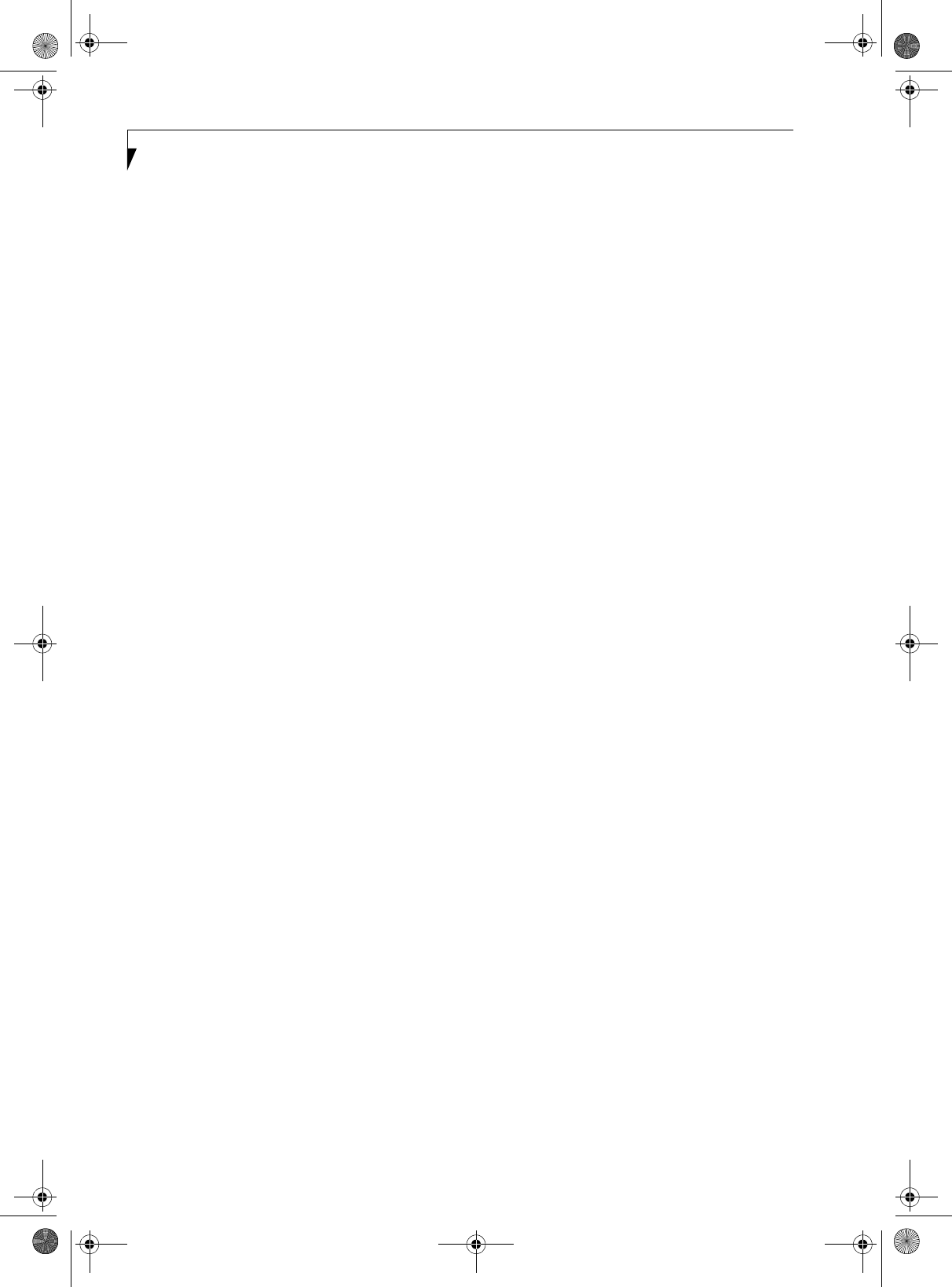
86
LifeBook T Series Tablet PC - Section Eight
Subnet mask defines how many bits of IP address
comprise the subnet address. The same value shall be set
among computers communicating with each other.
SVGA
Super VGA.
S-Video
Super Video. A component video system for driving a
TV or computer monitor.
System Clock
An oscillator of fixed precise frequency which synchro-
nizes the operation of the system and is counted to
provide time of day and date.
TCP/IP
Transmission Control Protocol/Internet Protocol.
A standard Internet protocol that is most widely used.
TFT
Thin Film Transistor – A technology for flat display
panels which uses a thin film matrix of transistors to
control each pixel of the display screen individually.
UL
Underwriters Laboratories – An independent organiza-
tion that tests and certifies the electrical safety of devices.
USB
Universal Serial Bus.
Standard that allows you to simultaneously connect up
to 127 USB devices such as game pads, pointing devices,
printers, and keyboards to your computer.
VGA
Video Graphics Array. A video display standard
originally introduced by IBM with the PS/2 series of
personal computers.
VRAM
Video Random Access Memory. A memory dedicated to
video display data and control.
WFM
Wired for Management is Intel’s broad-based initiative
to reduce the total cost of ownership (TCO) of business
computing without sacrificing power and flexibility.
Wi-Fi Compatible
Wi-Fi (Wireless Fidelity) Identifies that the product has
passed the interoperability test, supplied by the WECA
(Wireless Ethernet Compatibility Alliance), which guar-
antees the interoperability of wireless IEEE 802.11 LAN
products. For more information on the Wi-Fi standard,
go to the WECA website at: www.wirelessethernet.com.
WLAN
Wireless Local Area Network. A wireless interconnection
of computers and peripherals within a single limited
geographic location which can pass programs and data
amongst themselves.
Write Protect
Prevent alteration of the binary state of all bits in a
storage media. Example: all information on a device
such as a floppy diskette; a block of space in a storage
media such as a partition of a hard drive; a file or direc-
tory of floppy diskette or hard drive.
XGA
Extended VGA.
Zip Drive
A 100MB or 250MB read/write removable media disk
drive.
T Series.book Page 86 Thursday, July 31, 2003 10:49 AM

105
Index
Index
A
AC
adapter . . . . . . . . . . . . . . . . . . . . . . . . . . . . . . . . . 33, 81
indicator . . . . . . . . . . . . . . . . . . . . . . . . . . . . . . . . . . 15
plug adapters . . . . . . . . . . . . . . . . . . . . . . . . . . . . . . 67
ACPI . . . . . . . . . . . . . . . . . . . . . . . . . . . . . . . . . . . . . . . 81
Active-Matrix Display . . . . . . . . . . . . . . . . . . . . . . . . . 81
ADSL . . . . . . . . . . . . . . . . . . . . . . . . . . . . . . . . . . . . . . . 81
Anti-theft Lock Slot . . . . . . . . . . . . . . . . . . . . . . . . . . . 12
Auto/Airline Adapter . . . . . . . . . . . . . . . . . . . . . . .33, 81
B
Battery . . . . . . . . . . . . . . . . . . . . . . . . . . . . . . . . . . . . . . 41
alarm . . . . . . . . . . . . . . . . . . . . . . . . . . . . . . . . . . . . . 41
care . . . . . . . . . . . . . . . . . . . . . . . . . . . . . . . . . . . . . . 68
charging indicator . . . . . . . . . . . . . . . . . . . . . . . . . . 16
cold-swapping . . . . . . . . . . . . . . . . . . . . . . . . . . . . . 42
compartment . . . . . . . . . . . . . . . . . . . . . . . . . . . . . . 14
conserving power . . . . . . . . . . . . . . . . . . . . . . . . . . . 36
dead . . . . . . . . . . . . . . . . . . . . . . . . . . . . . . . . . . . . . .57
faulty . . . . . . . . . . . . . . . . . . . . . . . . . . . . . . . . . . . . . 57
increasing life . . . . . . . . . . . . . . . . . . . . . . . . . . . . . . 68
level indicators . . . . . . . . . . . . . . . . . . . . . . . . . . . . . 15
lithium ion battery . . . . . . . . . . . . . . . . . . . . . . .41, 83
low . . . . . . . . . . . . . . . . . . . . . . . . . . . . . . . . . . . . . . .41
problems . . . . . . . . . . . . . . . . . . . . . . . . . . . . . . .57, 58
recharging . . . . . . . . . . . . . . . . . . . . . . . . . . . . . . . . . 41
replacing . . . . . . . . . . . . . . . . . . . . . . . . . . . . . . . . . . 42
shorted . . . . . . . . . . . . . . . . . . . . . . . . . . . . . . . . . . . . 42
suspend mode . . . . . . . . . . . . . . . . . . . . . . . . . . . . . . 41
warm-swapping . . . . . . . . . . . . . . . . . . . . . . . . . . . . 42
Battery Release Latch . . . . . . . . . . . . . . . . . . . . . . . . . . . 9
BIOS . . . . . . . . . . . . . . . . . . . . . . . . . . . . . . . . . . . . . . . . 81
guide . . . . . . . . . . . . . . . . . . . . . . . . . . . . . . . . . . . . . 34
setup utility . . . . . . . . . . . . . . . . . . . . . . . . . . . . . . . . 34
Boot . . . . . . . . . . . . . . . . . . . . . . . . . . . . . . . . . . . . . . . . 81
Boot Sequence . . . . . . . . . . . . . . . . . . . . . . . . . . . . . . . . 34
Built-in Microphone . . . . . . . . . . . . . . . . . . . . . . . . . . 13
Button Icons . . . . . . . . . . . . . . . . . . . . . . . . . . . . . . . . .21
C
Cache Memory . . . . . . . . . . . . . . . . . . . . . . . . . . . . . . . 81
CapsLock Indicator . . . . . . . . . . . . . . . . . . . . . . . . . . . 16
CardBus . . . . . . . . . . . . . . . . . . . . . . . . . . . . . . . . . . . . . 81
CD-ROM . . . . . . . . . . . . . . . . . . . . . . . . . . . . . . . . . . . . 81
care . . . . . . . . . . . . . . . . . . . . . . . . . . . . . . . . . . . . . . 69
Changing Tablet PC Button Functions . . . . . . . . . . . 22
Channels . . . . . . . . . . . . . . . . . . . . . . . . . . . . . . . . . . . . 81
Closed Cover Switch . . . . . . . . . . . . . . . . . . . . . . . . . . 10
CMOS RAM . . . . . . . . . . . . . . . . . . . . . . . . . . . . . . . . . 81
Configuration Label . . . . . . . . . . . . . . . . . . . . . . . . . . . 14
Conventions used . . . . . . . . . . . . . . . . . . . . . . . . . . . . . . 3
CRT . . . . . . . . . . . . . . . . . . . . . . . . . . . . . . . . . . . . . . . .81
Cursor Keys . . . . . . . . . . . . . . . . . . . . . . . . . . . . . . . . . .20
D
DC in Connector . . . . . . . . . . . . . . . . . . . . . . . . . . . . . . 9
DC Output Cable . . . . . . . . . . . . . . . . . . . . . . . . . . . . . 33
DC Power Jack . . . . . . . . . . . . . . . . . . . . . . . . . . . . 13, 33
Default Value . . . . . . . . . . . . . . . . . . . . . . . . . . . . . . . . 81
Device Ports . . . . . . . . . . . . . . . . . . . . . . . . . . . . . . . . . 48
DIMM . . . . . . . . . . . . . . . . . . . . . . . . . . . . . . . . . . .43, 82
DISE . . . . . . . . . . . . . . . . . . . . . . . . . . . . . . . . . . . . . . . . 63
Display Panel . . . . . . . . . . . . . . . . . . . . . . . . . . . . . . . . 10
brightness . . . . . . . . . . . . . . . . . . . . . . . . . . . . . . . . . 18
opening . . . . . . . . . . . . . . . . . . . . . . . . . . . . . . . . . . . 17
problems . . . . . . . . . . . . . . . . . . . . . . . . . . . . . . . . . . 59
Display Panel Latch . . . . . . . . . . . . . . . . . . . . . . . . . . . 10
Display Timeout . . . . . . . . . . . . . . . . . . . . . . . . . . . . . . 37
DMA . . . . . . . . . . . . . . . . . . . . . . . . . . . . . . . . . . . . . . . 82
DMI . . . . . . . . . . . . . . . . . . . . . . . . . . . . . . . . . . . . . . . . 82
DNS . . . . . . . . . . . . . . . . . . . . . . . . . . . . . . . . . . . . . . . . 82
Docking Port . . . . . . . . . . . . . . . . . . . . . . . . . . . . . . . . .48
Drive Image Special Edition (DISE) . . . . . . . . . . . . . . 63
Drivers and Application Restore CD . . . . . . . . . . . . . 64
E
ECP . . . . . . . . . . . . . . . . . . . . . . . . . . . . . . . . . . . . . . . . 82
Encryption Key (Network Key) . . . . . . . . . . . . . . . . . 82
Enlarging the Backup Partition . . . . . . . . . . . . . . . . . . 64
Error Messages . . . . . . . . . . . . . . . . . . . . . . . . . . . . . . . 61
ESD . . . . . . . . . . . . . . . . . . . . . . . . . . . . . . . . . . . . . . . .82
Extended Memory . . . . . . . . . . . . . . . . . . . . . . . . . . . . 82
External Monitor Port . . . . . . . . . . . . . . . . . . . . . .13, 49
F
Floppy Disk
care . . . . . . . . . . . . . . . . . . . . . . . . . . . . . . . . . . . . . . 68
Function Key
F10 . . . . . . . . . . . . . . . . . . . . . . . . . . . . . . . . . . . . . . .20
F3 . . . . . . . . . . . . . . . . . . . . . . . . . . . . . . . . . . . . . . . . 20
T Series.book Page 105 Thursday, July 31, 2003 10:49 AM
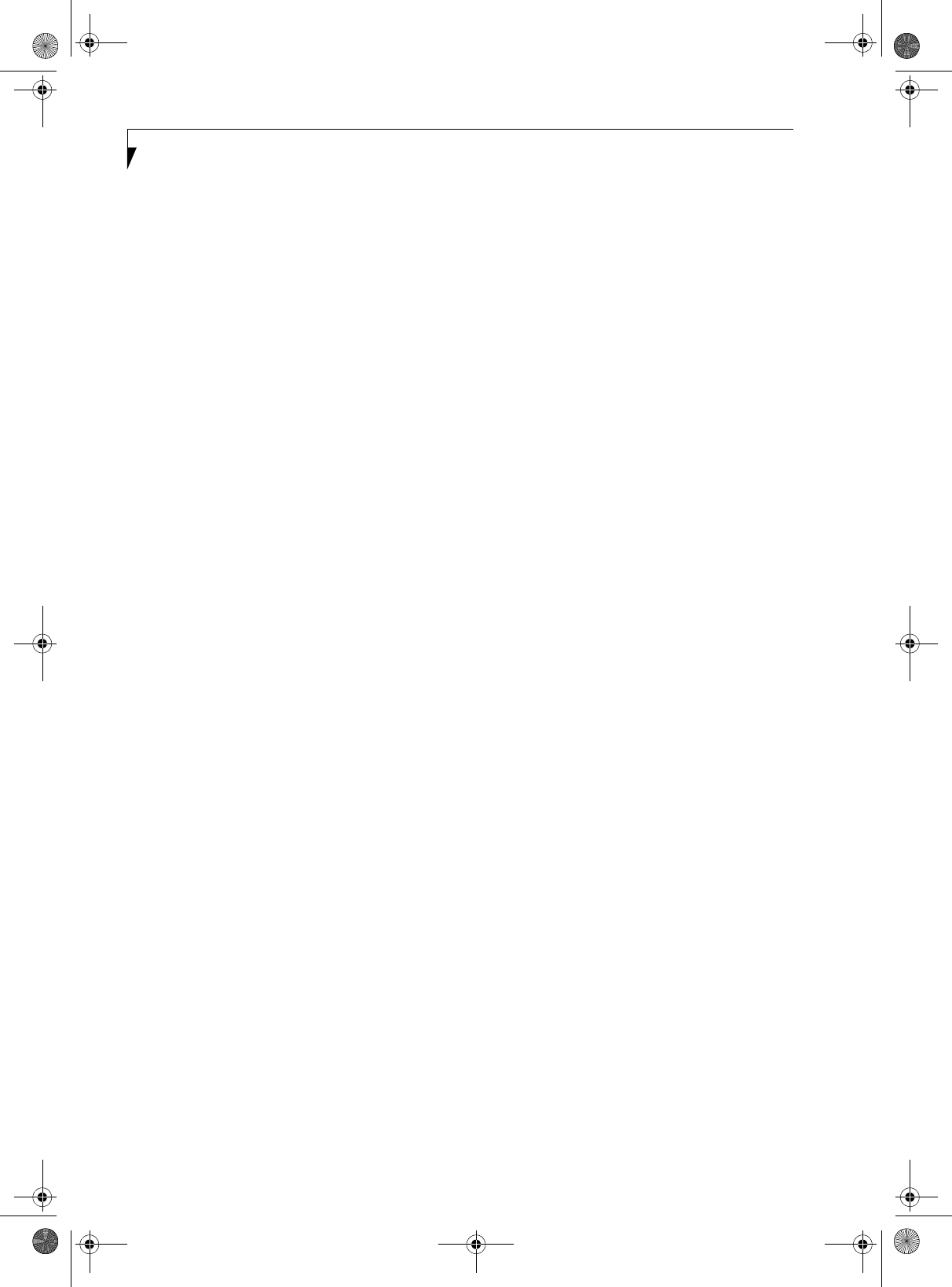
106
LifeBook T Series Tablet PC - Index
F4 . . . . . . . . . . . . . . . . . . . . . . . . . . . . . . . . . . . . . . . 20
F5 . . . . . . . . . . . . . . . . . . . . . . . . . . . . . . . . . . . . . . . 20
F6 . . . . . . . . . . . . . . . . . . . . . . . . . . . . . . . . . . . . . . . 20
F7 . . . . . . . . . . . . . . . . . . . . . . . . . . . . . . . . . . . . . . . 20
F8 . . . . . . . . . . . . . . . . . . . . . . . . . . . . . . . . . . . . . . . 20
F9 . . . . . . . . . . . . . . . . . . . . . . . . . . . . . . . . . . . . . . . 20
FN . . . . . . . . . . . . . . . . . . . . . . . . . . . . . . . . . . . . . . . 20
Fn . . . . . . . . . . . . . . . . . . . . . . . . . . . . . . . . . . . . . . . 20
H
Hard Disk Drive
access indicator . . . . . . . . . . . . . . . . . . . . . . . . . . . . 16
problems . . . . . . . . . . . . . . . . . . . . . . . . . . . . . . . . . 54
Hard Disk Timeout . . . . . . . . . . . . . . . . . . . . . . . . . . . 37
Headphone Jack . . . . . . . . . . . . . . . . . . . . . . . . 9, 11, 49
Hibernate Mode . . . . . . . . . . . . . . . . . . . . . . . . . . . . . 37
Hibernation Feature . . . . . . . . . . . . . . . . . . . . . . . . . . 37
I
IDE . . . . . . . . . . . . . . . . . . . . . . . . . . . . . . . . . . . . . . . . 82
IEEE 1394 . . . . . . . . . . . . . . . . . . . . . . . . . . . . . . . . . . . 83
Infrared Port . . . . . . . . . . . . . . . . . . . . . . . . . . . . . 13, 48
Internal LAN Jack . . . . . . . . . . . . . . . . . . . . . . . . . . . . 48
IrDA . . . . . . . . . . . . . . . . . . . . . . . . . . . . . . . . . . 9, 48, 83
IRQ . . . . . . . . . . . . . . . . . . . . . . . . . . . . . . . . . . . . . . . . 83
K
Keyboard . . . . . . . . . . . . . . . . . . . . . . . . . . . . . . . . 10, 19
cursor keys . . . . . . . . . . . . . . . . . . . . . . . . . . . . . . . . 19
numeric keypad . . . . . . . . . . . . . . . . . . . . . . . . . . . . 19
problems . . . . . . . . . . . . . . . . . . . . . . . . . . . . . . . . . 54
windows keys . . . . . . . . . . . . . . . . . . . . . . . . . . . . . . 19
L
LAN (RJ-45) Jack . . . . . . . . . . . . . . . . . . . . . . . . . . . . 13
LifeBook Security Application Panel
operating . . . . . . . . . . . . . . . . . . . . . . . . . . . . . . . . . 23
passwords . . . . . . . . . . . . . . . . . . . . . . . . . . . . . . . . . 22
uninstalling . . . . . . . . . . . . . . . . . . . . . . . . . . . . . . . 24
LifeBook Security/Tablet PC Buttons . . . . . . . . . 10, 21
LifeBook T Series Tablet PC specifications
additional . . . . . . . . . . . . . . . . . . . . . . . . . . . . . . . . . 74
agency approval . . . . . . . . . . . . . . . . . . . . . . . . . . . . 74
display specifications . . . . . . . . . . . . . . . . . . . . . . . 73
environmental . . . . . . . . . . . . . . . . . . . . . . . . . . . . . 74
physical specifications . . . . . . . . . . . . . . . . . . . . 73, 74
power . . . . . . . . . . . . . . . . . . . . . . . . . . . . . . . . . . . . 74
LifeBook Tablet PC
unpacking . . . . . . . . . . . . . . . . . . . . . . . . . . . . . . . . . 7
Local Area Network (LAN) . . . . . . . . . . . . . . . . . . . . . 9
M
Memory
capacity . . . . . . . . . . . . . . . . . . . . . . . . . . . . . . . . . . .44
compartment . . . . . . . . . . . . . . . . . . . . . . . . . . .14, 43
installing . . . . . . . . . . . . . . . . . . . . . . . . . . . . . . . . . .43
problems . . . . . . . . . . . . . . . . . . . . . . . . . . . . . . . . . .55
removing . . . . . . . . . . . . . . . . . . . . . . . . . . . . . . . . . .43
upgrade module . . . . . . . . . . . . . . . . . . . . . . . . . . . .43
Microphone Jack . . . . . . . . . . . . . . . . . . . . . . . . 9, 11, 49
Microprocessor . . . . . . . . . . . . . . . . . . . . . . . . . . . . . . .73
MIDI . . . . . . . . . . . . . . . . . . . . . . . . . . . . . . . . . . . . . . .84
Modem . . . . . . . . . . . . . . . . . . . . . . . . . . . . . . . . . . . .9, 12
Modem (RJ-11) Port . . . . . . . . . . . . . . . . . . . . . . .12, 48
Modem Result Codes . . . . . . . . . . . . . . . . . . . . . . . . . .62
Mouse
problems . . . . . . . . . . . . . . . . . . . . . . . . . . . . . . . . . .54
See Touchpad
MPU-401 . . . . . . . . . . . . . . . . . . . . . . . . . . . . . . . . . . . .84
N
NTSC . . . . . . . . . . . . . . . . . . . . . . . . . . . . . . . . . . . . . . .84
Numeric Keypad . . . . . . . . . . . . . . . . . . . . . . . . . . . . . .19
NumLk Indicator . . . . . . . . . . . . . . . . . . . . . . . . . . . . .16
O
optional accessories . . . . . . . . . . . . . . . . . . . . . . . . . . . .8
Additional Accessories . . . . . . . . . . . . . . . . . . . . . . . .8
additional accessories . . . . . . . . . . . . . . . . . . . . . . . . .8
carrying cases . . . . . . . . . . . . . . . . . . . . . . . . . . . . . . .8
docking options . . . . . . . . . . . . . . . . . . . . . . . . . . . . .8
memory . . . . . . . . . . . . . . . . . . . . . . . . . . . . . . . . . . . .8
power options . . . . . . . . . . . . . . . . . . . . . . . . . . . . . . .8
storage options . . . . . . . . . . . . . . . . . . . . . . . . . . . . . .8
P
Parallel Port . . . . . . . . . . . . . . . . . . . . . . . . . . . . . . . . . .84
PC Card
care . . . . . . . . . . . . . . . . . . . . . . . . . . . . . . . . . . . . . . .69
installing . . . . . . . . . . . . . . . . . . . . . . . . . . . . . . . . . .45
problems . . . . . . . . . . . . . . . . . . . . . . . . . . . . . . . . . .56
removing . . . . . . . . . . . . . . . . . . . . . . . . . . . . . . . . . .45
slot . . . . . . . . . . . . . . . . . . . . . . . . . . . . . . . . . . . . .9, 11
PCI . . . . . . . . . . . . . . . . . . . . . . . . . . . . . . . . . . . . . . . . .84
PCMCIA . . . . . . . . . . . . . . . . . . . . . . . . . . . . . . . . . . . .84
Pen. . . . . . . . . . . . . . . . . . . . . . . . . . . . . . . . . . . . . . . . . .10
calibrating the pen . . . . . . . . . . . . . . . . . . . . . . . . . .27
replacing the tip . . . . . . . . . . . . . . . . . . . . . . . . . . . .28
using the pen . . . . . . . . . . . . . . . . . . . . . . . . . . . . . . .27
Pen and Active Digitizer . . . . . . . . . . . . . . . . . . . . . . . .27
T Series.book Page 106 Thursday, July 31, 2003 10:49 AM

107
Index
Port Replicator . . . . . . . . . . . . . . . . . . . . . . . . . . . . . . . 46
attaching . . . . . . . . . . . . . . . . . . . . . . . . . . . . . . . . . . 47
connector . . . . . . . . . . . . . . . . . . . . . . . . . . . . . . . . . . 14
detaching . . . . . . . . . . . . . . . . . . . . . . . . . . . . . . . . . .47
problems . . . . . . . . . . . . . . . . . . . . . . . . . . . . . . . . . .54
POST . . . . . . . . . . . . . . . . . . . . . . . . . . . . . . . . . . . . . . . 84
Power
AC adapter . . . . . . . . . . . . . . . . . . . . . . . . . . . . . . . . 33
Auto/Airline adapter . . . . . . . . . . . . . . . . . . . . . . . .33
failure . . . . . . . . . . . . . . . . . . . . . . . . . . . . . . . . . 56, 57
indicator . . . . . . . . . . . . . . . . . . . . . . . . . . . . . . . . . . 15
management . . . . . . . . . . . . . . . . . . . . . . . . . . . . . . . 36
off . . . . . . . . . . . . . . . . . . . . . . . . . . . . . . . . . . . . . . . .38
on . . . . . . . . . . . . . . . . . . . . . . . . . . . . . . . . . . . . . . . . 34
problems . . . . . . . . . . . . . . . . . . . . . . . . . . . . . . . . . .58
sources . . . . . . . . . . . . . . . . . . . . . . . . . . . . . . . . . . . .33
Power Management . . . . . . . . . . . . . . . . . . . . . . . .36, 37
Power On Self Test . . . . . . . . . . . . . . . . . . . . . . . . . 34, 61
Preparation for wireless LAN connection . . . . . . . . . 93
R
Registration . . . . . . . . . . . . . . . . . . . . . . . . . . . . . . . . . .35
Re-Installing Individual Drivers and Applications . .64
Restarting the system . . . . . . . . . . . . . . . . . . . . . . . . . . 37
Restoring a Backup Image . . . . . . . . . . . . . . . . . . . . . . 64
Restoring Your Pre-installed Software . . . . . . . . . . . . 63
RJ-11 . . . . . . . . . . . . . . . . . . . . . . . . . . . . . . . . . . . . . . . 48
RJ-45 . . . . . . . . . . . . . . . . . . . . . . . . . . . . . . . . . . . . . 9, 48
Rotation Hinge . . . . . . . . . . . . . . . . . . . . . . . . . . . . . . . 10
S
ScrLk Indicator . . . . . . . . . . . . . . . . . . . . . . . . . . . . . . . 16
SDRAM . . . . . . . . . . . . . . . . . . . . . . . . . . . . . . . . . .14, 43
Security Indicator . . . . . . . . . . . . . . . . . . . . . . . . . . . . .16
Security Lock Slot . . . . . . . . . . . . . . . . . . . . . . . . . . . . . . 9
Serial Port . . . . . . . . . . . . . . . . . . . . . . . . . . . . . . . . . . .85
Setting Up LifeBook Security Panel . . . . . . . . . . . . . . 22
Shut Down . . . . . . . . . . . . . . . . . . . . . . . . . . . . . . . . . . 38
SMART . . . . . . . . . . . . . . . . . . . . . . . . . . . . . . . . . . . . .85
Smart Card Reader . . . . . . . . . . . . . . . . . . . . . . . . . . . . 45
Specifications . . . . . . . . . . . . . . . . . . . . . . . . . . . . . . . .73
SRAM . . . . . . . . . . . . . . . . . . . . . . . . . . . . . . . . . . . . . . 85
SSID . . . . . . . . . . . . . . . . . . . . . . . . . . . . . . . . . . . . . . . . 85
Standby Mode . . . . . . . . . . . . . . . . . . . . . . . . . . . . . . . . 37
Status Indicator Panel . . . . . . . . . . . . . . . . . . . . . . 10, 15
Suspend . . . . . . . . . . . . . . . . . . . . . . . . . . . . . . . . . .36, 85
Suspend/Resume Button . . . . . . . . . . . . . . . . . .9, 12, 36
S-Video . . . . . . . . . . . . . . . . . . . . . . . . . . . . . . . . . . . . . 86
T
Tablet Dock Port . . . . . . . . . . . . . . . . . . . . . . . . . . . . . . 9
Tablet PC
care . . . . . . . . . . . . . . . . . . . . . . . . . . . . . . . . . . . . . . 67
storing . . . . . . . . . . . . . . . . . . . . . . . . . . . . . . . . . . . . 67
traveling . . . . . . . . . . . . . . . . . . . . . . . . . . . . . . . . . . 67
TCP/IP . . . . . . . . . . . . . . . . . . . . . . . . . . . . . . . . . . . . . .86
Touch Screen
clicking . . . . . . . . . . . . . . . . . . . . . . . . . . . . . . . . . . . 28
double-clicking . . . . . . . . . . . . . . . . . . . . . . . . . . . . . 28
Touchpad
clicking . . . . . . . . . . . . . . . . . . . . . . . . . . . . . . . .10, 25
control adjustment . . . . . . . . . . . . . . . . . . . . . . . . . . 26
double-clicking . . . . . . . . . . . . . . . . . . . . . . . . . . . . . 25
dragging . . . . . . . . . . . . . . . . . . . . . . . . . . . . . . . . . . 26
Troubleshooting . . . . . . . . . . . . . . . . . . . . . . . . . . . . . . 53
battery . . . . . . . . . . . . . . . . . . . . . . . . . . . . . . . . . . . . 57
built-in Speakers . . . . . . . . . . . . . . . . . . . . . . . . . . . . 54
hard drive . . . . . . . . . . . . . . . . . . . . . . . . . . . . . . . . . 54
memory . . . . . . . . . . . . . . . . . . . . . . . . . . . . . . . . . . .55
mouse/keyboard . . . . . . . . . . . . . . . . . . . . . . . . . . . .54
PC Card . . . . . . . . . . . . . . . . . . . . . . . . . . . . . . . . . . .56
port replicator . . . . . . . . . . . . . . . . . . . . . . . . . . . . . . 54
ports . . . . . . . . . . . . . . . . . . . . . . . . . . . . . . . . . . . . . . 56
power . . . . . . . . . . . . . . . . . . . . . . . . . . . . . . . . . . . . . 56
video . . . . . . . . . . . . . . . . . . . . . . . . . . . . . . . . . . . . . 59
U
Universal Serial Bus Port . . . . . . . . . . . . . . . . . . . . . . . 48
USB . . . . . . . . . . . . . . . . . . . . . . . . . . . . . . . . . . . . . . . . 48
problems . . . . . . . . . . . . . . . . . . . . . . . . . . . . . . . . . . 56
USB Port . . . . . . . . . . . . . . . . . . . . . . . . . . . . . . . . . . 9, 13
Using the Active Digitizer . . . . . . . . . . . . . . . . . . . . . . 28
Using the System as a Tablet . . . . . . . . . . . . . . . . . . . . 17
V
Volume Control . . . . . . . . . . . . . . . . . . . . . . . . . . . . . . 29
W
Warm-swap . . . . . . . . . . . . . . . . . . . . . . . . . . . . . . . . . . 42
WFM . . . . . . . . . . . . . . . . . . . . . . . . . . . . . . . . . . . . . . . 86
Wi-Fi Compatible . . . . . . . . . . . . . . . . . . . . . . . . . . . . . 86
Windows
end user license agreement . . . . . . . . . . . . . . . . . . . 35
Windows keys . . . . . . . . . . . . . . . . . . . . . . . . . . . . . . . . 19
Application key . . . . . . . . . . . . . . . . . . . . . . . . . . . . . 19
Start key . . . . . . . . . . . . . . . . . . . . . . . . . . . . . . . . . . . 19
Wireless LAN
Ad Hoc Mode . . . . . . . . . . . . . . . . . . . . . . . . . . . . . . 90
before using the wireless LAN . . . . . . . . . . . . . . . . . 90
Broadcom wireless LAN . . . . . . . . . . . . . . . . . . . . . 90
T Series.book Page 107 Thursday, July 31, 2003 10:49 AM
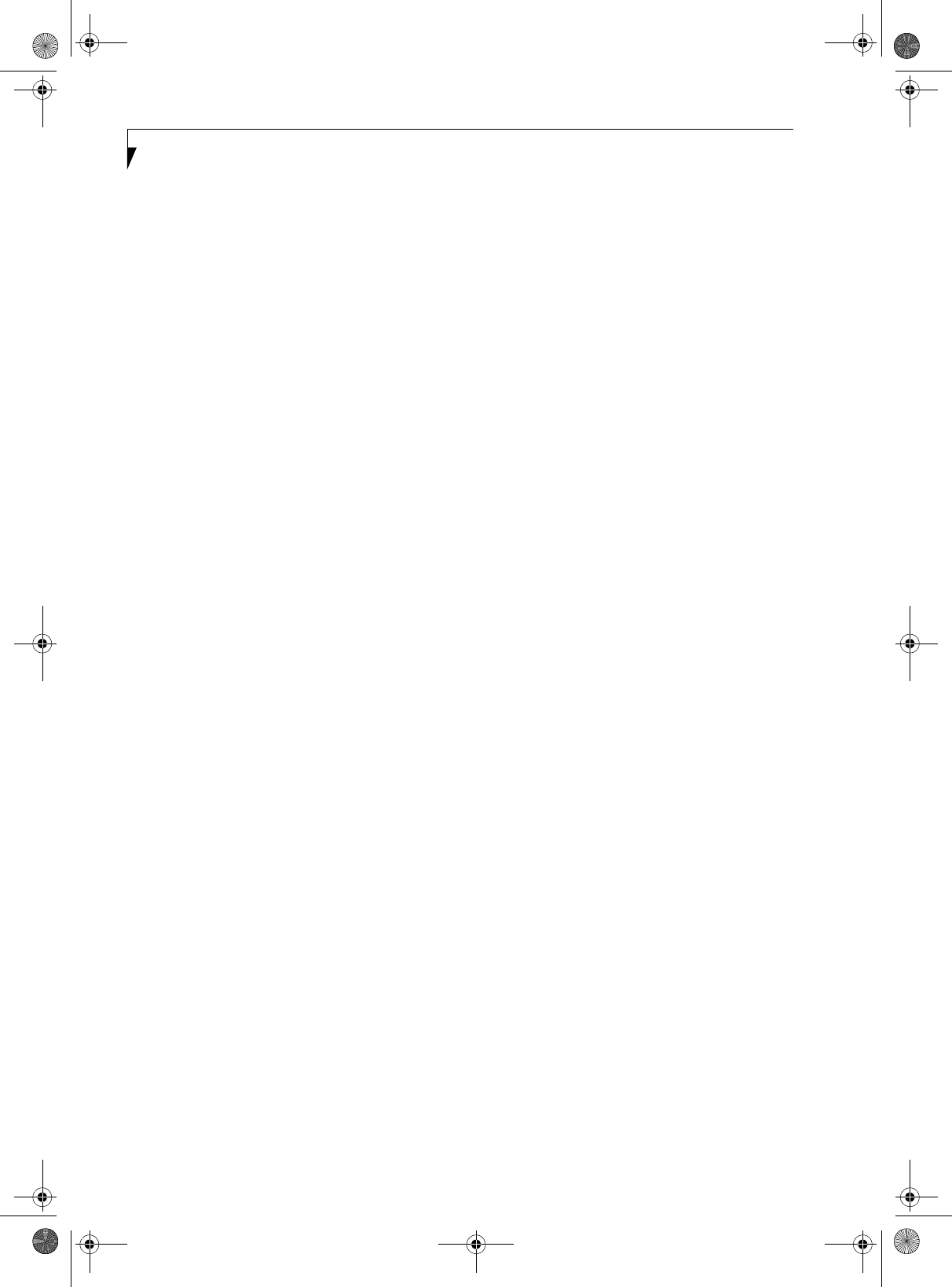
108
LifeBook T Series Tablet PC - Index
connection using Windows XP . . . . . . . . . . . . . . . 93
for better communications . . . . . . . . . . . . . . . . . . 91
Infrastructure Mode . . . . . . . . . . . . . . . . . . . . . . . . 90
Intel PROSet wireless LAN . . . . . . . . . . . . . . . . . . . 90
IP address information . . . . . . . . . . . . . . . . . . . . . 102
other settings . . . . . . . . . . . . . . . . . . . . . . . . . . . . . . 99
setting of power-saving function . . . . . . . . . . . . . . 99
specifications . . . . . . . . . . . . . . . . . . . . . . . . . . . . . 103
starting transmission . . . . . . . . . . . . . . . . . . . . . . . 92
stopping transmission . . . . . . . . . . . . . . . . . . . . . . 92
troubleshooting . . . . . . . . . . . . . . . . . . . . . . . . . . . 100
Wireless LAN On-Off Switch . . . . . . . . . . . . . . . . . 9, 13
WLAN . . . . . . . . . . . . . . . . . . . . . . . . . . . . . . . . . . . . . 86
T Series.book Page 108 Thursday, July 31, 2003 10:49 AM